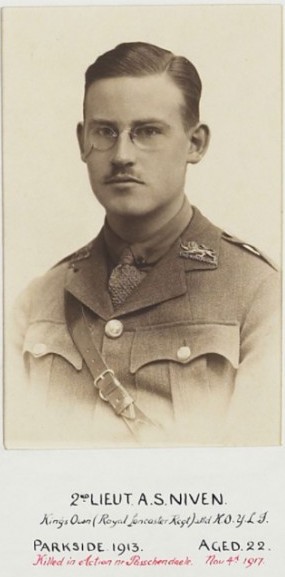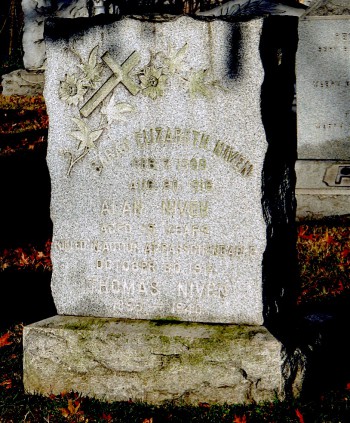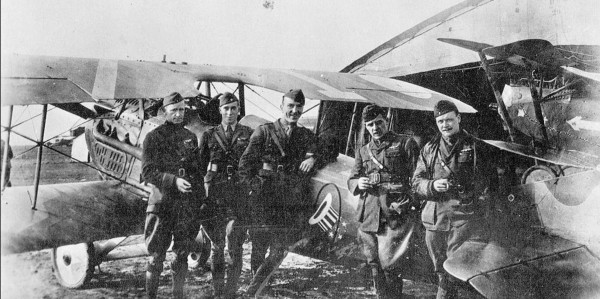Please see the INTRODUCTORY NOTE at the beginning of the companion document that contains the World War I biographies covering the first section of the alphabet.
WWI Bio Search
JACKSON, CHARLES WALTER (1885-1922). Second lieutenant, American Expeditionary Forces, Aero Squadron. Jackson was born in New York City. The 1910 census shows that he lived on Avenue N in Brooklyn with his widowed mother and two older sisters on Avenue N in Brooklyn; that census notes that his mother had twelve children, seven of whom were still alive.
As per his Military Abstract for World War I, Jackson lived at 117 Glenwood Road in Brooklyn at the time of his enlistment. After being stationed at Garden City, New York, he served overseas from October 31, 1917 through February 12, 1919. During his time overseas, he was appointed as a second lieutenant in the Aero Squadron as of November 2, 1918. His Military Abstract reports that he did not participate in any engagements and was not injured. He was discharged on February 17, 1919. Section 155. lot 23003.
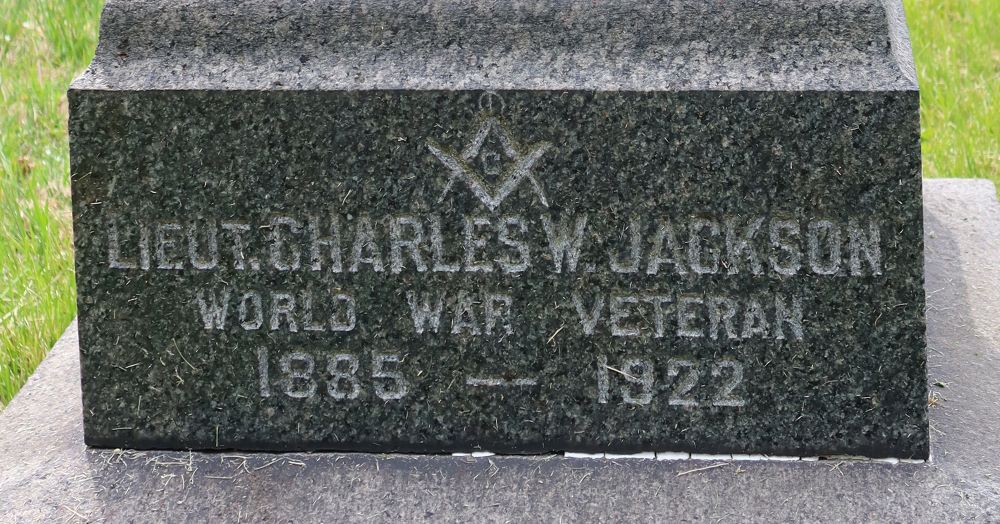
JACKSON, RAYMOND SPENCER (1890-1969). Private, United States Army. Jackson was born in New York City. His grandfather, Thomas H. Neville, who is buried in the same lot, served in the Civil War. The 1910 census reports that Jackson was living with his mother Lucy in a rented apartment on West 116th Street in Manhattan and was employed as a chemist. According to his Draft Registration Card filed in Manhattan on June 5, 1917, he was working as a chemist for the Tartar Chemical Company at 65 9th Street in Brooklyn and still living at 145 West 116th Street. Jackson was single at that time and sought an exemption because he was supporting his mother. He described himself was tall, of medium build, with blue eyes and brown hair. On May 16, 1918, Jackson married Maybelle Feld, a scant three months before his military service began. His military records show that he was inducted into the United States Army on August 9, 1918, and served stateside as a private for the duration of the war, receiving his honorable discharge upon demobilization on November 4, 1919.
The 1920 census shows that the Jacksons lived in a rental apartment at 419 Tompkins Avenue in Brooklyn and that he continued to be employed as a chemist. His World War II Registration Card, filed in 1942, shows that he was living at 772 Union Street, Apartment 10, in Brooklyn, and was working for the American Razor Company, located on 315 Jay Street in Brooklyn; at that time, he had no home telephone. Section 81, lot 13171.

JENKINS, HELEN HARTLEY (1860-1934). Philanthropist. Her grandfather, Robert Milham Hartley, was founder and secretary of the New York Association for Improving the Condition of the Poor and was a leader of American charity in the 19th century. Her father, Marcellus Hartley, founded Hartley House, a settlement house in New York City. In 1902, when her father died, she inherited his fortune and began her philanthropy. The next year she and her nephew gave a dormitory, Hartley Hall, to Columbia University. Soon thereafter she anonymously donated $350,000 for Philosophy Hall at Columbia, and also gave the funds to establish an electricity research laboratory in her father’s name. She financed the gates to Barnard College as a memorial to her daughter. A trustee of the Teachers College at Columbia 1907-1934, she funded the department of nursing and health there. She also endowed the School of Nursing at Memorial Hospital in Morristown, New Jersey.
Interested in tenement housing reform, Jenkins bought and remodeled buildings, built the Hartley Open Stair Tenement (1913), and financed one- and two-family houses in New York City. She also established the Slavonic Immigrant Home (1909) there. For her efforts to aid the Serbs during World War I, she was decorated by the Montenegrin and Serbian governments. She was also active in reform politics and prison reform. Her home hosted many of the educational, charitable, and civic committees on which she served. She was also president of the National Institute of Sciences (1923). Section 140, lot 23389.
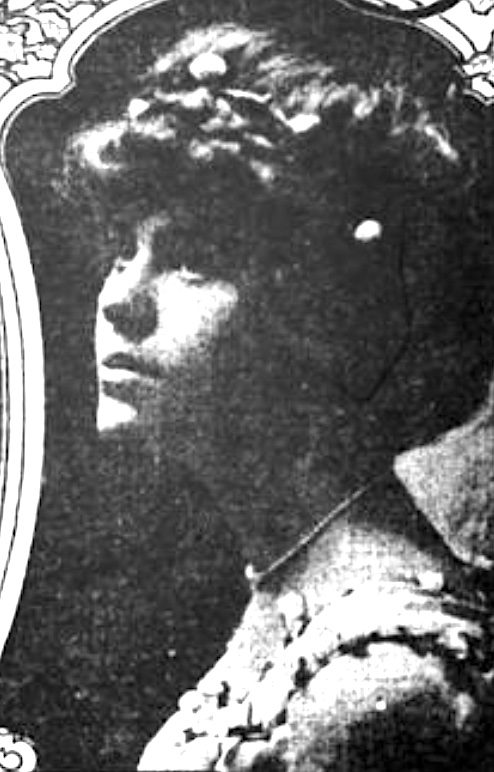
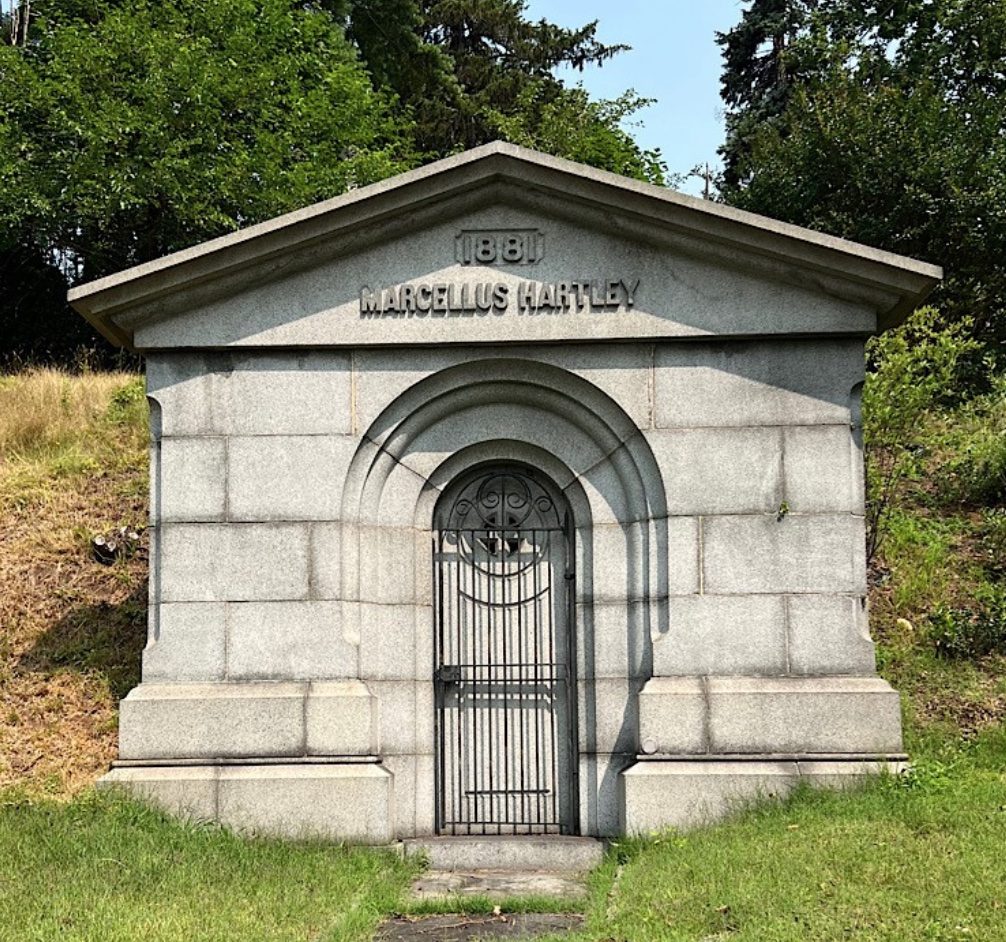
JENNINGS, IRVING EVERETT (or EVERITT) (1887-1918). Seaman second class, United States Navy. Born in Glen Cove, Long Island, Jennings filed his Draft Registration Card in Brooklyn on June 5, 1917. At that time, he was living on Greene Avenue and working as a clerk at L. E. Waterman Company at 191 Broadway in Manhattan. He noted that he was single and that his mother was dependent on him. He described himself as medium height and build with blue eyes and light hair.
As per his Abstract of World War I Military Service, Jennings enlisted at Brooklyn as a seaman second class on December 31, 1917; his home address was in Sea Cliff, Long Island. He was assigned to the Naval Training Camp at Pelham Bay Park, New York, where he served from January 9, 1918 through February 11, 1918, when he took sick. That same day, he was admitted to the Naval Hospital in Pelham Bay, New York, where he was diagnosed with enteritis, a bacterial inflammation of the intestine, and died the next day. Another record lists his cause of death as ptomaine poisoning. Section 172, lot 12455.
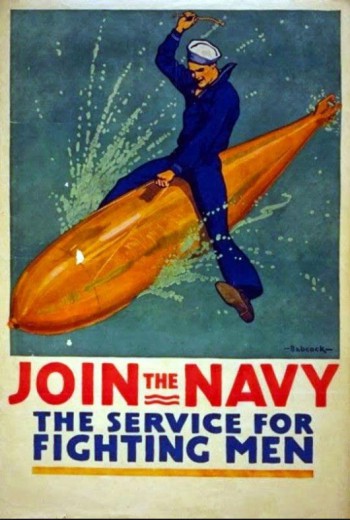
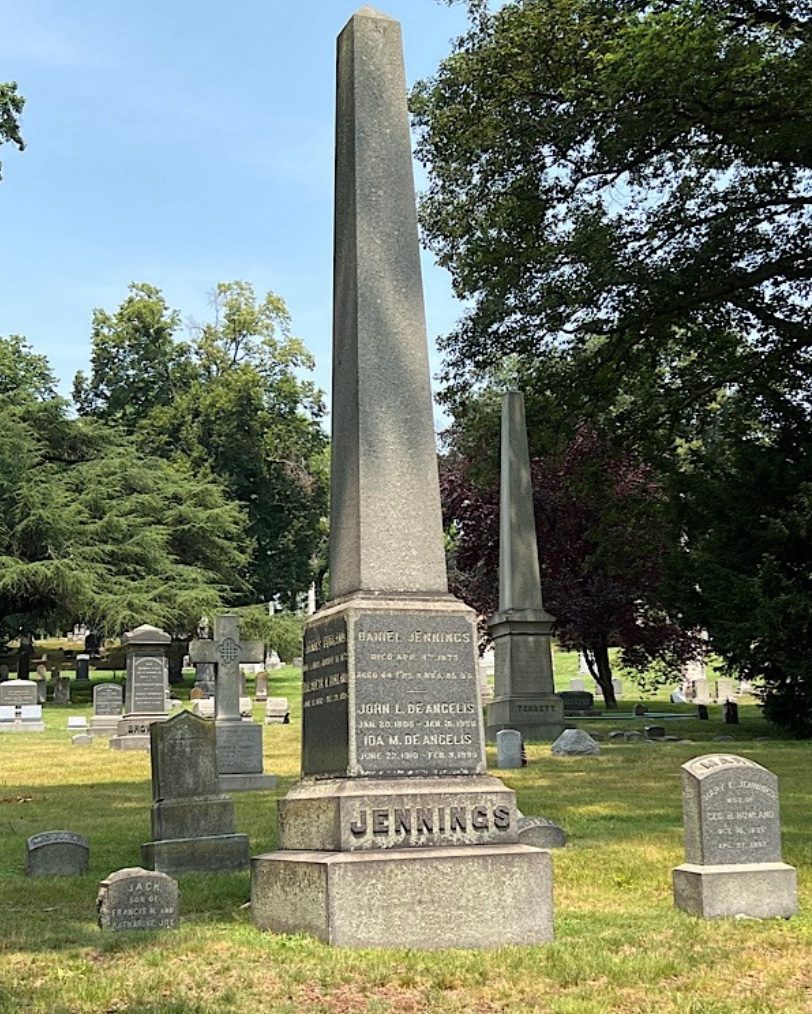
JOHNSON, GEORGE (1899-1918). Unknown military history. Johnson was killed in action in France on July 29, 1918. The details of his service are unknown. His last address was 364 83 Street, Brooklyn. After his remains were returned to the United States, he was re-interred on July 16, 1921. Section 124, lot 35823, grave 2.
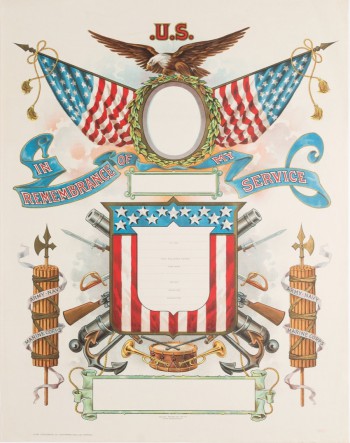
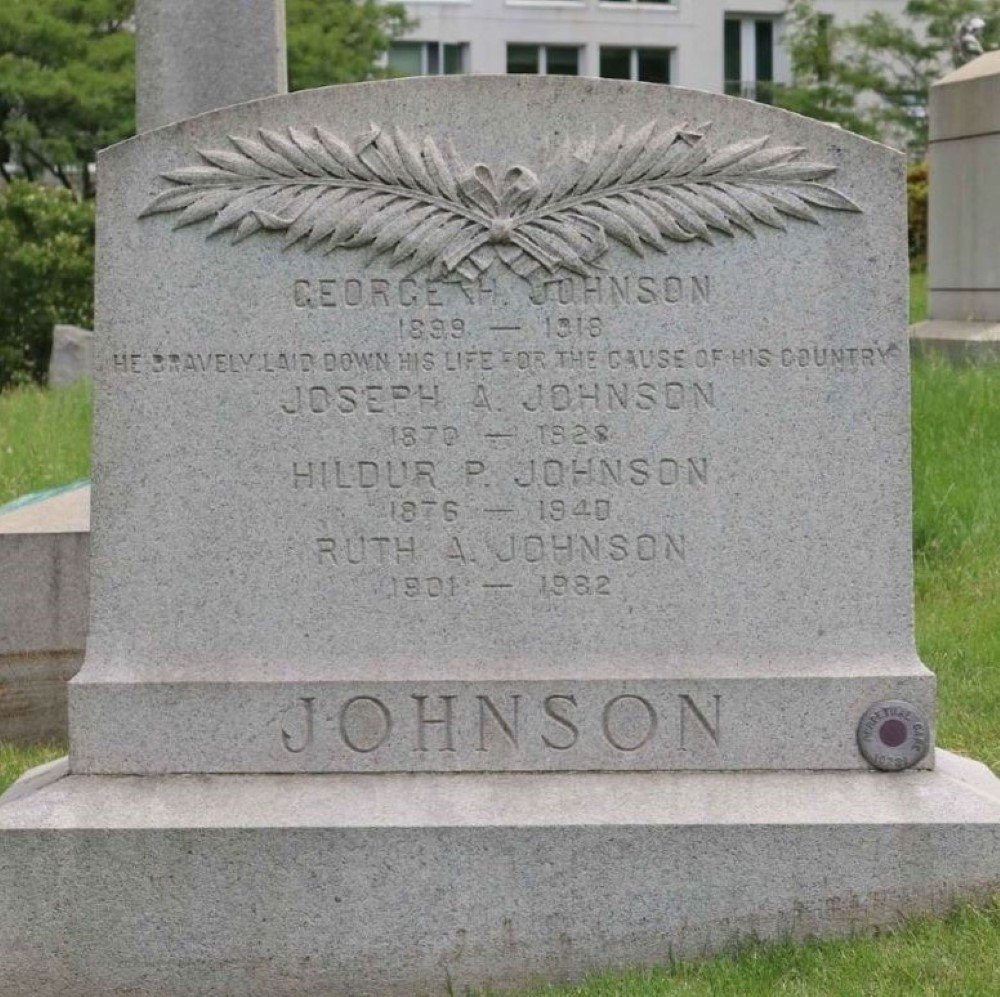
JONES, LORING PAUL (1897-1951). Lieutenant junior grade, United States Navy. Born in New York, Jones was living at 297 Ryerson Street in Brooklyn when he enrolled in the New York National Guard on April 23, 1917. His National Guard Service Card shows him assigned to the 4th Division, 2nd Battalion before being enrolled five days later as a seaman second class in the Navy at the Navy Recruiting Station in Brooklyn. From May 2, 1917 through November 27, 1917, Jones served aboard the USS Amphitrite, a monitor class ship assigned the twin duties of examining all non-naval ships entering and leaving New York Harbor and patrolling for enemy submarine activity. On June 13, 1917, during Jones’s tour, the steamship Manchuria collided with the Amphitrite in a thick fog. No one was seriously hurt, but the Manchuria had to be beached off Staten Island. On November 27, 1917, Jones, now a coxswain, was re-assigned to Section Base No. 69 in Brooklyn. On February 16, 1918, now a boatswain mate second class, Jones served aboard the USS Sub Chaser No. 86 for approximately six weeks. On April 1, he was transferred to the receiving barracks in New London, Connecticut, before being sent to the Naval Training Camp at Pelham Bay Park, New York, on April 3, where he completed his officer training on May 24 with the rank of boatswain first class; he was discharged to Headquarters of the 3rd Naval District in New York. On June 29, 1918, Jones was commissioned as an ensign in the United States Navy.
In 1919, Jones received his bachelor of arts degree from City College, apparently while still in naval service. The 1920 census reports that he was married and living on West 97th Street in Manhattan with his wife and mother. By the time of his honorable discharge on May 5, 1921, Jones was serving as a lieutenant aboard the USS Parrott DD318 out of San Diego, California. The 1930 census reports that Jones was married with two young children, lived on Orchard Street in Rockland, New York, owned a house worth $12,000, owned a radio set, was a World War veteran, and was employed as an electrical machinist. The 1940 census shows him to be married with three children, living in the same house that was now valued at $8,000, and working as a buyer for an electrical manufacturing company. It was noted that Jones had completed college and had earned $5,000 that year. He last lived in Piermont, New York. On February 8, 1856, Dolores Jones, his widow, applied for a government-issued marker with Christian emblem, citing her husband’s Naval service. Section 32, lot 7669, vault.
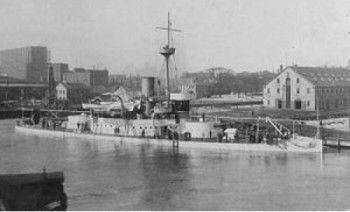

JORGENSEN, BJARNE MAURVITZ (or MORRIS) (1892-1953). Private first class, 48th Infantry, Company H, United States Army. A native of Mandal, Norway, Jorgensen’s birth year is unclear: his gravestone notes 1892 but he indicated his birth year as 1893 and 1894 on official documents. He immigrated to the United States in 1909 as per the 1930 census or 1913 as per the 1925 census.
According to Jorgensen’s World War I Draft Registration Card, filed on June 5, 1917, he was an “alien” of Norwegian citizenship who lived at 4923 Sixth Avenue in Brooklyn; he recorded his birth date as December 24, 1893. He noted that he was a lighter captain in the transportation industry on Whitehall Street and described himself as tall and stout with blue eyes and light hair. As per the application filed on his behalf for a government-issued headstone, which lists a birth year of 1892, he enlisted in the United States Army on May 21, 1918, and was assigned to Company H of the 48th Infantry. That unit was sent to France in July 1918 and returned to the United States in January 1919. He was honorably discharged on February 18, 1919.
The New York State census for 1925 and the federal census of 1930 report that Jorgensen lived in Brooklyn with his wife, Anna Marie (née Knudsen), and children and worked as a lighter (fireman) on a boat. The censuses note that he was a naturalized citizen as of 1917. However, there was an application for a Seaman’s Certificate of American Citizenship, filed by a Bjarne Jorgensen on September 11, 1930, that may or may not be the same veteran. The dates of birth and naturalization do not match the other documents. The Seaman’s Certificate notes that Jorgensen, who noted a birth date of November 15, 1890, became a naturalized citizen in on July 23, 1923, at the District Court in Brooklyn. The aforementioned certificate notes that Jorgensen last worked as a fireman on the USS Vinita and did not know his next assignment. He described himself as 5′ 6″ tall with blue eyes, blond hair, ruddy complexion and tattoo “dots.”
As per the records of the United States Evangelical Lutheran Church in America, a Bjarne Jorgensen, who was born on November 15, 1890, married Bertha Tobine Berg at Our Saviour’s Church in New York City on March 12, 1942; his online family tree only indicates his marriage to Anna Marie Knudsen. His World War II Draft Registration Card, filed in 1942, notes that he worked for Patterson Lighterage Company at 44 Whitehall Street in Manhattan; that document lists a birth date of December 24, 1894, and indicates June Rethoup, his daughter, as the person who would know his address. He died in Staten Island. On August 6, 1953, a week after his death, Alf M. Jorgensen, his son, of 174 Battery Avenue in Brooklyn, applied for a government-issued headstone, citing his father’s service in World War I. Section 129, lot 12807.
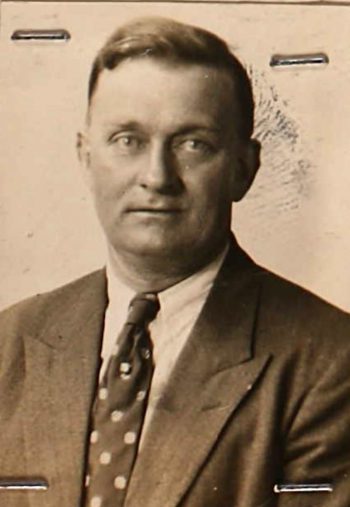
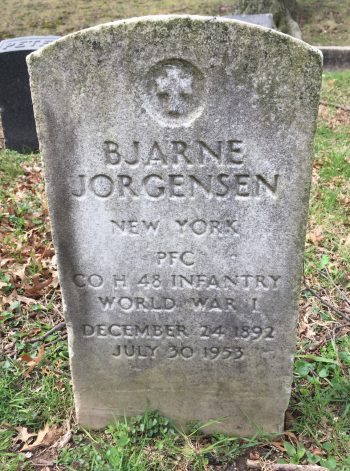
KAURIN (or KAWRIN), CHARLES L. (1895-1918). Private first class, 307th Infantry, Company B, American Expeditionary Forces, United States Army. A Brooklyn native, the New York State census of 1915 reports that he was living with his parents and brother in Brooklyn and working as a salesman. As per his Draft Registration Card of June 5, 1917, which recorded his name as “Kawrin,” he was unmarried, 5′ 7″ tall with blue eyes, light brown hair (not bald) and had no missing limbs. Kaurin was inducted as a private at Brooklyn on September 10, 1917, and rose to private first class on November 1. Kaurin served overseas beginning on April 7, 1918, at which time he was in Baccarat (Lorraine), France. He died in France from the grippe, an old-fashioned term for the flu, on July 24, 1918. His mother was notified of his death at his last home at 182 11th Street in Brooklyn. His body was returned to New York and he was interred in the family plot on November 6, 1921. Section 136, lot 35157, grave N3.
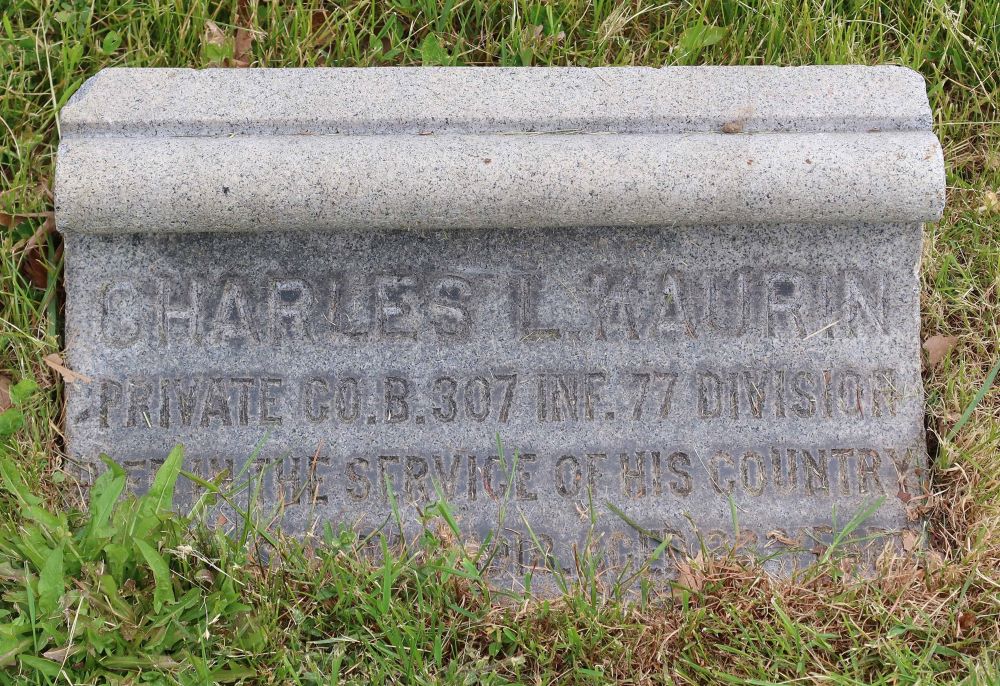
KAY, DOUGLAS LIVINGSTON (1899-1919). Corporal, United States Army, 705th Motor Transport Company, American Expeditionary Forces, United States Army. A native of Brooklyn, Kay enlisted in the Army in 1917 at Ft. Slocum, New York, and was sent overseas on January 8, 1818. Stationed with the 705th Motor Transport Company, he was promoted to corporal on January 21, 1918. Kay contracted bronchial pneumonia and died in France on February 3, 1919. His mother, Mrs. Winfred Davison, was notified of his death. His last residence was 81 Columbia Heights, Brooklyn. After his remains were returned to the United States, he was interred at Green-Wood on August 18, 1920. Section 137, lot 33420, grave 1.
KER, DAVID (1894–1918). First lieutenant, 1st Aero Squadron, American Expeditionary Forces, United States Air Service; corporal, 7th Infantry, New York State National Guard, Company K; 69th Infantry, Company L; 165th Infantry, Company L. Born in New Jersey, Ker attended Columbia University; its 1915 yearbook shows him to be a freshman, class of 1917, and a member of Alpha Delta Phi fraternity. On May 2, 1917, he joined the New York State National Guard and, on July 25, mustered into Company K of the 7th Infantry as a corporal. Ker was transferred to Company L of the 69th Infantry on August 16 and was subsequently transferred to Company L of the 165th Infantry. On September 3, 1917, he was detached and sent to Fort Sill, Oklahoma, for training as an aerial observer.
On January 4, 1918, Ker was commissioned a second lieutenant and was shipped overseas with the 1st Aero Squadron on January 9. The 1st Aero Squadron is the oldest U.S. military flying unit (formed in 1913) and the first to participate in military action. He was promoted to first lieutenant on March 14. The 1st Aero was stationed at Gengault Aerodrome near Toul, France, when the St. Mihiel offensive began in September 1918. That unit provided vital information to divisional commanders regarding front line configurations, spotting for artillery barrages, and photo reconnaissance behind enemy lines. It was during this offensive that Ker was killed on September 12, 1918. He was originally buried at Vie Ville en Hage. His last residence was 430 West 119 Street in New York City. After his remains were returned to the United States, he was re-interred on July 21, 1921. Section 27, lot 5127.

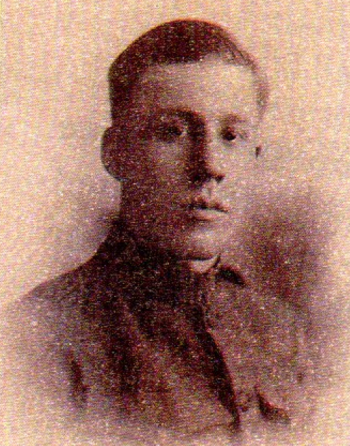
KETCHUM, ARCHIBALD (or ARCHIE) C. (1894-1920). Corporal, Headquarters Company, Battery F, 1st Field Artillery, New York State National Guard; 104th Field Artillery, 27th Infantry Division; American Expeditionary Forces, United States Army. Ketchum was born in Union Hill, New Jersey, although the information at Green-Wood mistakenly reports that he was born in Brooklyn. His family moved to Brooklyn while Ketchum was an infant and first lived on Lake Street. He was educated at P.S. 95 and P.S. 128 and graduated from Manual Training High School (today known as John Jay High School). At the time of the 1910 census, he was living on Lake Street with his parents and 18 year-old sister, was single, and worked as a stock clerk in an insurance office. His obituary in the Brooklyn Daily Eagle, which confirms his World War I service, notes that he worked for a short time with the Pennsylvania Fire Insurance Company.
According to his New York Abstract of National Guard Service in World War I, he enlisted as a private in the New York State National Guard and was assigned to Battery F, 1st Field Artillery, 27th Infantry Division, on May 8, 1917. On July 9, 1917, his unit was called into federal service and reorganized as the 104th Field Artillery. In the spring of 1918, the division trained at Camp Wadsworth near Spartanburg, South Carolina. He went overseas on June 30, 1918; his unit, part of the 27th Infantry Division, trained under British mentors in Picardy, France, and Flanders, Belgium. Ketchum was promoted to private first class on August 21, 1918, and was reassigned to Headquarters Company. The field artillery of the 27th Division participated in the Meuse-Argonne, Ypres-Lys and Somme Offensives and cracked the Hindenburg Line, forcing the Germans to retreat. On October 30, 1918, Ketchum was promoted to corporal. After the armistice on November 11, 1918, the 27th Division moved to the French seaport at Brest. On March 13, 1919, they returned to the United States. Shortly thereafter, Ketchum was given an honorable discharge on April 9. He was not injured during his service overseas.
The 1920 census reports that Ketchum lived on West 6th Street in Brooklyn with his parents, sister and brother-in-law and their child; at that time, he was a real estate buyer. He worked with his father in the real estate business in the Kings Highway section of Brooklyn. Active in the Republican Party, he was elected alderman from the 51st District. He attended only one meeting of the Board of Alderman before being stricken with influenza in January 1920, and dying three months later from the emphysema that resulted. As per an article about his funeral in the Brooklyn Daily Eagle on April 23, 1920, the service was conducted by members of his Masonic Lodge. In addition to relatives and friends, a delegation from Brooklyn Post #211 of the American Legion and the Quentin Roosevelt Veterans of Overseas War, of which he was a member, were in attendance as was a delegation of county committeemen headed by the leader of the Republican organization and the president of the Junior Republicans. After his funeral, his remains were placed in the receiving vault at Evergreens Cemetery, then brought to Green-Wood. He last lived at 1769 West 6th Street. At the time of his death, he had $1,100 of personal property and $400 in real estate. Ketchum was re-interred at Green-Wood Cemetery on June 17, 1920. The Archie Ketchum Post of the Veterans of Foreign Wars and Ketchum Square in Brooklyn (bordered by Kings Highway, West 9th Street, Quentin Road, and West 10th Street) were named in his honor. Section 129, lot 35595, grave 2.
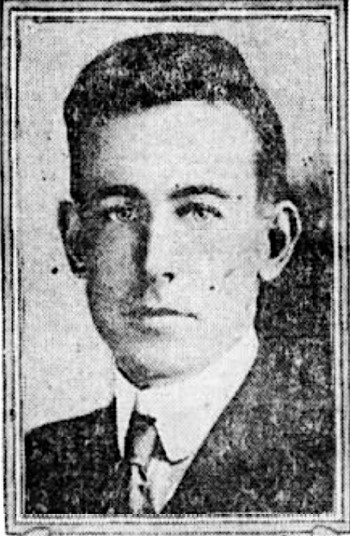
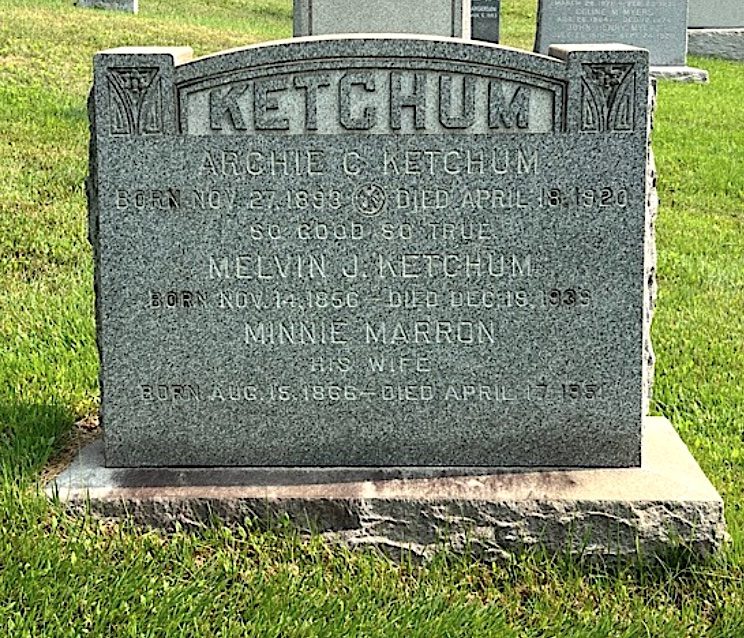
KHOURY, ELIAS JOHN (1891-1946). Fireman third class, United States Navy. Khoury was born in Damascus, Syria, and immigrated to the United States in 1907 with his brother Wadie, living principally in New York for the first 12½ years in this country. His passport application lists a naturalization date of December 13, 1914, at Cook County, Chicago.
Khoury’s Draft Registration Card, filed in Brooklyn on June 5, 1917, reports that he lived at 120 Dean Street in Brooklyn, was a naturalized citizen, was single, of Mongolian race, and worked as a salesman for Bordwill Brothers at 80 Washington Street in Manhattan. The accompanying Registrar’s Report describes him as medium height, stout with blue eyes and light hair. As per Carol Khoury, his grandniece, Khoury served as a fireman third class in the United States Navy during World War I. Firemen are responsible for safety and making maintenance repairs. The Department of Veterans Affairs lists his date of military service as September 26, 1919, possibly his discharge date.
When Khoury returned his passport to the American Consulate in Portugal, he enumerated his immigration and naturalization information. He was then a temporary resident in Funchal in Madeira, Portugal, with a legal residence in New York. He stated that he left New York on January 31, 1920, arriving in Portugal on February 12, on business for Mallouk Corporation located at 78-80 Greenwich Street in Manhattan. He reported that in addition to business travel, he had previously been outside the United States during his service in the Navy. He needed a new passport because he planned to be away from the U.S. for an additional five months for business in Portugal, the British Isles, Spain, France, Italy and Switzerland. That document, signed June 5, 1921, included an oath of allegiance to the United States.
On May 5, 1943, he wrote this letter from a Miami, Florida, address to his nephew, with a message in Arabic after the English text. His grandniece, Carol Khoury, states that her father saved this letter which was sent to Elias’s brother, Wadie:
My dear Johnny,
I have learned recently that soon you will be called to the service of Uncle Sam to lick our enemies. Well Johnny, I will tell you from my own experience in the first world war that in the beginning it might seem a little hard and you may feel homesick but I am sure it will not be long before you get used to the new life. We fought the first war believing to end all wars but we admit we failed to do so, now it is up to you and all the brave boys like you to do a better job this time and to beat the enemies so hard that they will never be able to rise again and start another war. When you accomplish this you will make the world a better place to live in and you and your children will live happy and in peace. I pray to almighty God that he will protect you wherever you go and bring you back home safe and victorious. I just want to remind you to write to your Father and Mother and to me as often as you can no matter where you are.
Your loving Uncle,
Elias
As per Carol Khoury, Elias Khoury never married nor had children. Section 128, lot 36787.
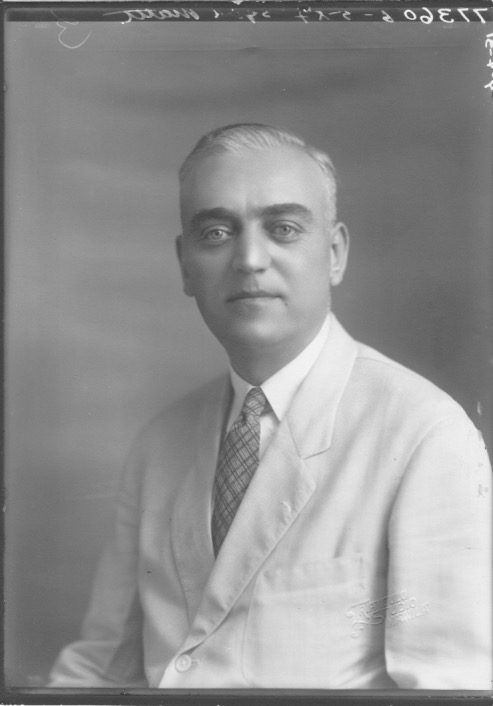
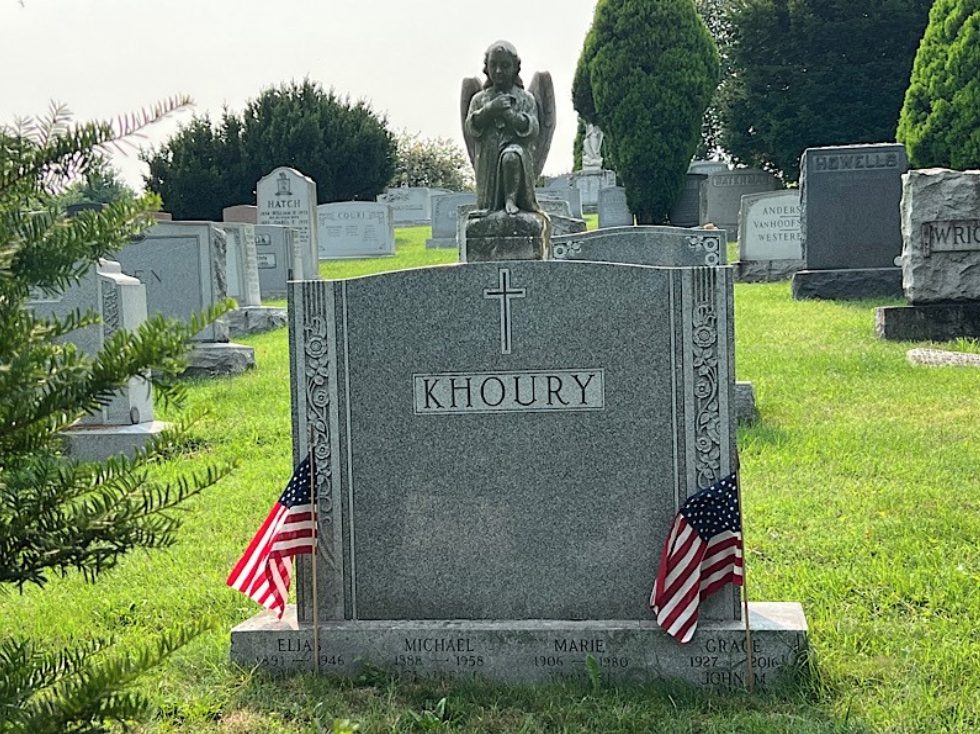
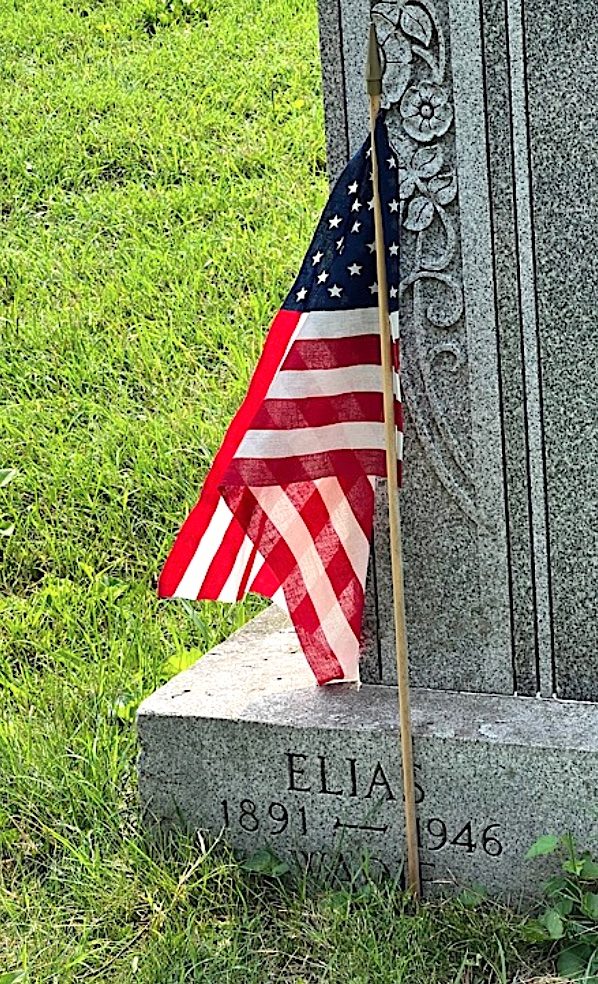
KHOURY, JACOB MICHAEL (1887-1960). Private, Camp Personnel Detachment, United States Army. Khoury was born in Bishmizzeen (Bishmizzine), Lebanon, and immigrated to the United States in October 1906, sailing from Byrouth, Syria, which is now Beirut, Lebanon. He became a naturalized United States citizen in 1914, at the Common Pleas Court in Hollidaysburg, Pennsylvania. In the 1915 New York City Directory, he is listed as a barber living in New York City. Khoury lived in Altoona, Pennsylvania, when he registered for the draft on June 5, 1917. His Draft Registration Card, which lists his birthplace as Bishmizzeen in Mt. Lebanon, Turkey, reports that he was single, medium height and stout with brown eyes and black hair. He was employed as a clerk for a private company and worked temporarily in Vicksburg, Mississippi; he also noted that his mother, sister and brother were dependent upon him for support. Khoury entered the United States Army on July 25, 1918, and was stationed at Camp Pike, Arkansas, in the Camp Personnel Detachment. He was honorably discharged on January 21, 1919. As per the application for a government-issued flat granite marker, he was awarded the victory medal.
In 1920, Khoury applied for a United States passport for the purpose of traveling to France, England, Cuba and Mexico as a salesman in the commercial export business. At that time, he lived at 263 Hicks Street in Brooklyn and planned to be abroad for one year; he stated his birthplace as Mt. Lebanon, Syria, Turkey. The 1930 census, which lists his birthplace as Syria, reports that he lived as a guest at the Hotel Keenan in Fort Wayne, Indiana, spoke Arabic and English, was a veteran of the World War, was married, and worked as a dry goods salesman. As a salesman he had lived in New Mexico, Pennsylvania, Mississippi and New York. The 1940 census, which also indicated his birthplace as Syria, reports that he was living at 8012 Third Avenue in Bay Ridge, Brooklyn, with his wife and two young children and employed as a salesman. At that time, he noted that he had completed eighth grade, paid $40 per month in rent and had earned $700 that year. His World War II Draft Registration Card of 1942 shows that he was about to begin a job as a government interpreter and still lived on Third Avenue in Brooklyn. He last lived at the Third Avenue address but died at the Veterans Hospital in Brooklyn. On May 23, 1960, three months after his death, his daughter Laila Nassr, who lived at 277 79th Street in Brooklyn, applied for a military headstone, citing her father’s World War I service in the Camp Personnel Detachment. Section 40, lot 38325, grave 767.
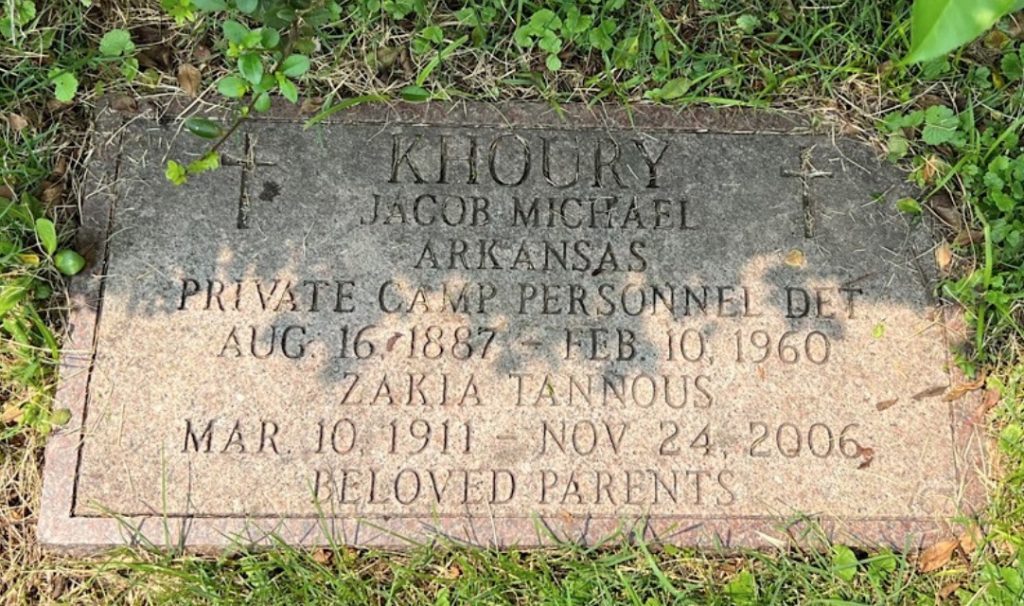
KIMBALL, STUART ENGLISH (1893-1950). Corporal, 361st Infantry, Machine Gun Company, American Expeditionary Forces, United States Army. Kimball was born in Massachusetts. The census of 1900 reports that he lived in Brookline, Massachusetts, with his parents, older brother and two servants. Kimball’s World War I Draft Registration Card, filed on June 5, 1917, states that he was a self-employed farmer in Hood River, Oregon, was single, of medium height and slender build, with brown hair and eyes. He enlisted at Hood River on April 29, 1918. His name appeared on the passenger list of the USS Karoa, departing from Brooklyn on July 6, 1918; that manifest lists his residence as Hood River, Oregon, and his rank as private in the Machine Gun Company of the 361st Infantry. As per his wife’s application for a government-issued granite marker for her husband, his unit was part of the 91st Division. As per his grandson, Stu Nembrotti, he received a Purple Heart for actions during a gas attack. Veterans Administration records indicate a discharge date of March 3, 1919. He was discharged at Camp Lewis, Washington.
The Brooklyn Daily Eagle reported on December 4, 1921, that on December 21 of that year, Dorothy Britton Longman and Kimball would be married at St. Bartholomew’s Church in Manhattan followed by a reception at the Hotel Gotham. The marriage was also featured on December 31, 1921, in the Brooklyn Life as a Manhattan wedding of great interest. That article described in detail the bride’s gown (pictured below), the members of the wedding party, and the attire of the bridesmaids and the mothers of the bride and groom. The couple planned to settle in Hood River, Oregon, where Kimball’s family resided.
However, as per the 1930 census, he was living at 345 East 57th Street in Manhattan with his wife, brother and a maid, owned a radio set, worked as a stock broker and was a veteran of the World War. The 1940 census indicates that he lived on East 57th Street with his wife and five-year-old daughter, paying $198 in rent, had completed four years of college, and was an unemployed broker. As per Kimball’s World War II Draft Registration Card, filed in 1942, he still lived at 345 East 57th Street, was self-employed, had a home telephone, and listed his wife as his next of kin. He died in Los Angeles, California. On March 29, 1951, Dorothy Kimball, who still lived at the East 57th Street address, applied for a government-issued granite marker to memorialize her husband’s service in World War I. Section 114, lot 37183.

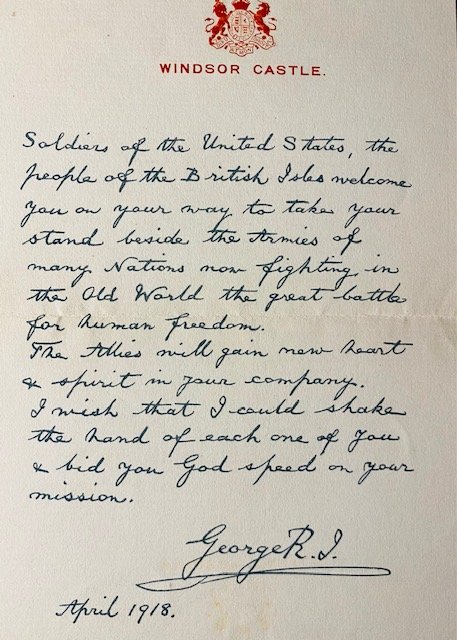
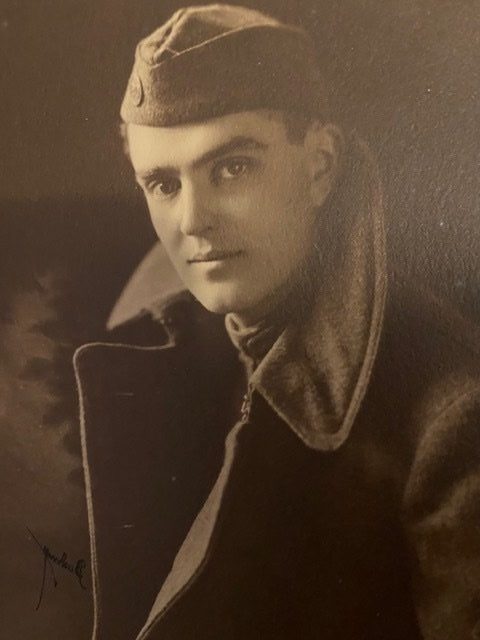

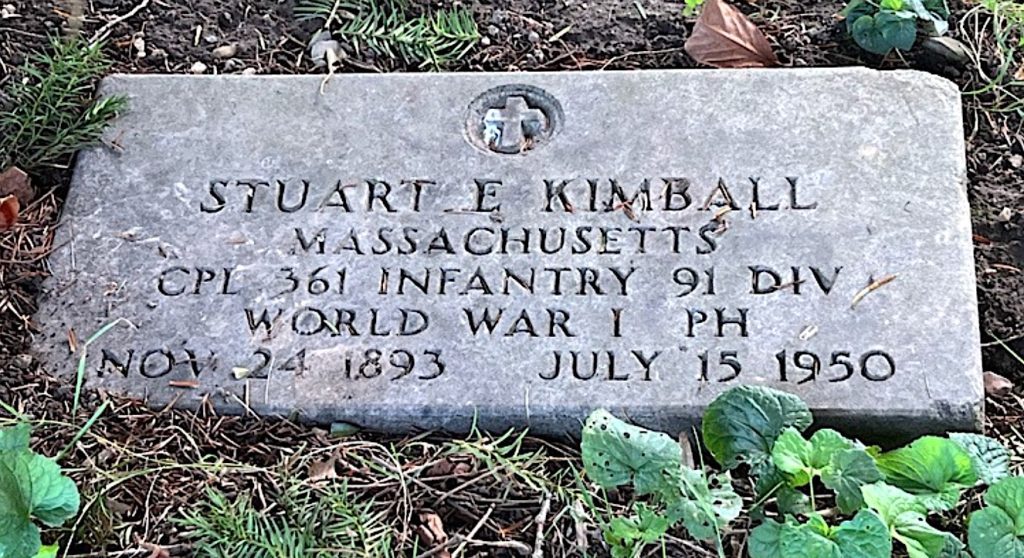
KIMBALL, THOMAS GLENTWORTH (1897-1960). Second lieutenant, Officer Reserve Corps; private, Central Officer’s Training School, 30th Company, United States Army. Kimball was born in Union, New Jersey. He registered for the draft on September 12, 1918, at which time he was a college student attending Williams College in Williamstown, Massachusetts. As per his Draft Registration Card, he described himself as medium height with blue eyes and dark hair. According to notations on the governmental headstone application for him, Kimball received his officer training as a private at the Central Officer’s Training School at Camp Lee, Virginia, as of October 1, 1918. Camp Lee was constructed in June of 1917, and over 60,000 enlisted men and officers were trained there. The notations also indicate that Kimball accepted his commission as a second lieutenant of infantry in the Officer Reserve Corps on January 15, 1919. His appointment was terminated and he received an honorable discharge on January 14, 1924. Kimball saw no active duty while serving in the Reserve Corps.
As per the 1920 census, Kimball was single, living at 12 Norwood Avenue in Summit, New Jersey, and working as a rating clerk for an insurance agency. The 1930 census lists him as a World War veteran who was married with two daughters, living in a rental on North Walnut Street in East Orange, New Jersey, having a radio set, and working as a fire insurance broker. The Summit New Jersey Directory for 1932 lists Kimball as a being in the insurance business. He last lived at 15a Locust Drive in Summit, New Jersey. On June 6, 1961, Irma Kimball, his widow, applied for a government-issued granite marker with no emblem, citing her husband’s Army service in World War I. Section 154, lot 32518, vault.

KIRSCHNER, JR., JOSEPH (1896-1918). Fireman third class, United States Navy. Born in Brooklyn, the 1910 United States census shows Kirschner to be single and living on East 2nd Street with his parents and two siblings. His Draft Registration Card of June 5, 1918, describes him to be of medium height with hazel eyes and light brown hair. On June 1, 1918, he entered the Navy and was assigned to the USS Granite State out of the Pelham Bay Park Naval Training Camp as a seaman second class. The USS Granite State served as a hospital ship in New York during the war. (Actor Humphrey Bogart also served on this ship during the war as a seaman first class.) In late August, Kirschner was promoted to fireman third class and, on October 3, he was admitted to the Naval Hospital in Pelham Bay, New York where he died of pneumonia on October 7. His last residence was 106 East 2nd Street in Brooklyn. Section 131, lot 35076, grave 3.
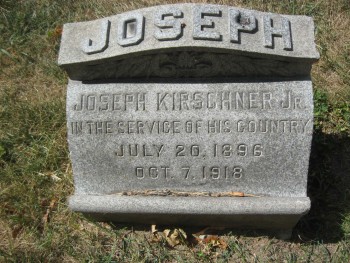
KLOTH, WILLIAM FREDERICK (1890-1918). Private first class, Motor Supply Trains, Company F, 5th Division, American Expeditionary Forces, United States Army. Kloth was born in Brooklyn. At the time of the 1900 census, he was living at 136 Bergen Street with his parents and four siblings. In 1910, he was living on Bedford Avenue in Brooklyn with his parents and siblings and working as a broker in the real estate industry. He was still living in Brooklyn when the 1915 New York State census was taken.
According to the Brooklyn Daily Eagle, Kloth was well-known in Flatbush as a member of social, fraternal and athletic organizations. The newspaper noted that he was associated with the Westwood Realty Company and other real estate companies in Flatbush, Brooklyn, for 10 years prior to his military service. Kloth’s Draft Registration Card, filed on June 5, 1917, shows that he lived at 1829 Caton Avenue in Brooklyn, was a real estate broker at the Westwood Realty Company at 685 Flatbush Avenue, and was single. He described himself as short, of medium build with grey eyes and brown hair.
As per his New York Abstract of World War I Military Service, he lived at 1581 East 14th Street in Brooklyn when he was inducted as a private at Fort Slocum, New York, on November 27, 1917. He was assigned to the Provisional Motor Truck Company #4 until December 21, 1917, at which time he was attached to Company F of the 5th Motor Supply Trains. Kloth underwent training at Camp Johnson in Jacksonville, Florida. He was promoted to private first class on May 20, 1918. Kloth was listed on the manifest of the USS Mt. Vernon, departing for Europe from Hoboken, New Jersey, on June 10, 1918. His address was listed as 1581 East 14th Street and his rank as private first class in the 5th Division Motor Supply Train. As per the Brooklyn Daily Eagle, the Mt. Vernon landed in France on July 18, and his unit, assigned to a defensive sector, took part in the fighting at St. Mihiel and the Meuse-Argonne. That article adds that although Kloth was offered an assignment to train as a commissioned officer, he declined and remained on the firing line.
Shortly after the end of World War I, he died when he was shot accidentally in France on November 17, 1918. His father, William Kloth who lived at the same address on East 14th Street, was notified of his death. After bodies were returned to the United States for burial, he was interred at Green-Wood on August 13, 1921. The Brooklyn Daily Eagle reported on Kloth’s funeral plans on August 12, 1921, detailed his personal and military achievements, and stated that he was survived by his parents, sister and three brothers. Section 204, lot 31465.
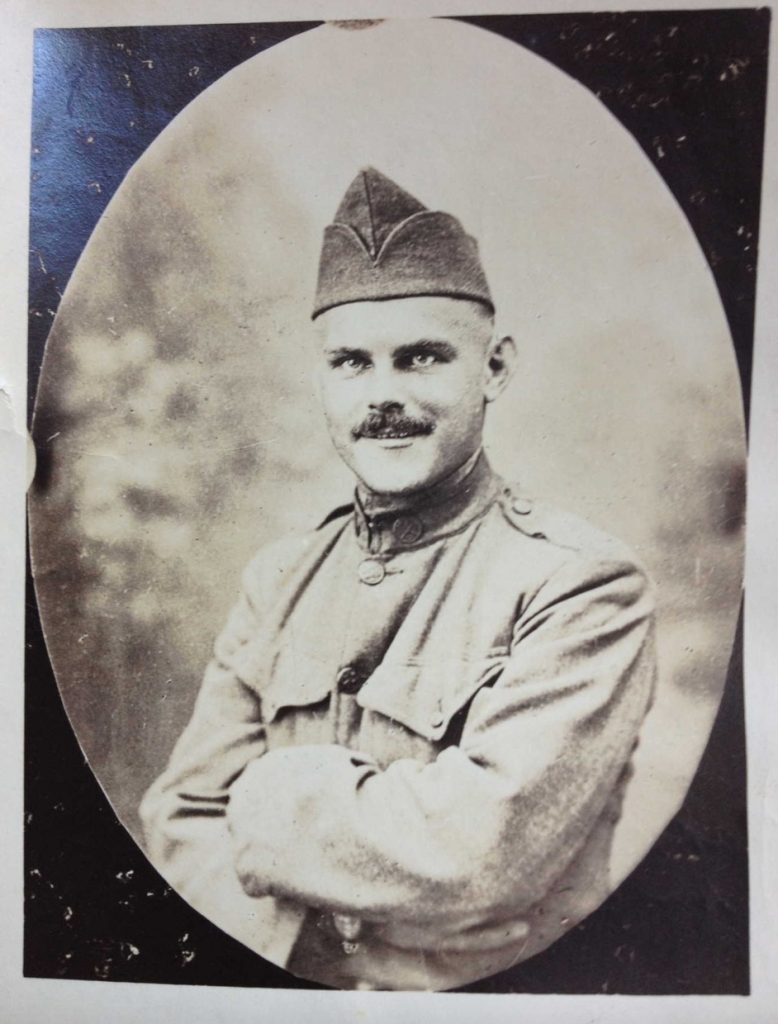
KNIGHT, FRANK HENRY (1876-1918). Captain, Medical Corps, United States Army. Knight was born in Brooklyn where his parents lived at 238 Bergen Street. The 1880 census reports that he lived with his parents and grandmother at 426 Carlton Avenue in Brooklyn. As per the Directory of Deceased American Physicians, 1804-1829, he obtained his medical license in New York in 1899 from Columbia University’s College of Physicians and Surgeons. The 1900 census reports that he was single, a physician, living with his parents and a servant at 406 Vanderbilt Avenue in Brooklyn.
His marriage to Lisette Lambert was featured in the January 11, 1912 edition of the Brooklyn Life. That article noted the upcoming wedding on February 6 at St. John’s Church with a reception at the home of the bride. The couple planned a dinner for the bridal party on February 4 at the Montauk Club. As per the 1910 census, he had been married to Lisette for eight years, owned his home at 59 Seventh Avenue in Brooklyn where he lived with his wife, six-year-old son and two servants, and was a physician in private practice. As of January 1911, the above named directory indicates that Dr. Knight was affiliated with the following Brooklyn facilities: St. John’s Hospital, Kings County Hospital, Swedish Hospital, Methodist Hospital, and Episcopal Hospital. The 1915 New York State census shows that he lived in Brooklyn with his wife, son and a servant and continued to work as a doctor.
As per Knight’s Abstract of World War I Military Service, he was a captain in the Medical Corps as of September 18, 1917. He was stationed in Philadelphia, Pennsylvania; Garden City, New York; Hoboken, New Jersey; New York City and was sent overseas to Portsmouth, England, on May 19, 1918. The abstract notes that he lived at 59 Seventh Avenue in Brooklyn, his wife was his emergency contact and that he participated in no engagements. That document states that Dr. Knight was affiliated with Base Hospital No. 33 in Portsmouth, England; the Physicians Directory indicated Base Hospital No. 23. He died in Portsmouth, England, on October 28, 1918; his death there was attributed to bronchial pneumonia. Knight was originally interred at the United States Military Cemetery, Magdalen Hill, in Winchester, England. His death at Army Hospital No. 33 was reported in the Brooklyn Daily Eagle on November 22, 1918. He was buried at Green-Wood on May 26, 1920. A plaque honoring Knight is on Columbia University’s Roll of Honor, noting his rank as captain in the United States Army Medical Corps. His remains were reinterred in the Lambert Mausoleum at Green-Wood in 1972. Section 6, lot 35236.
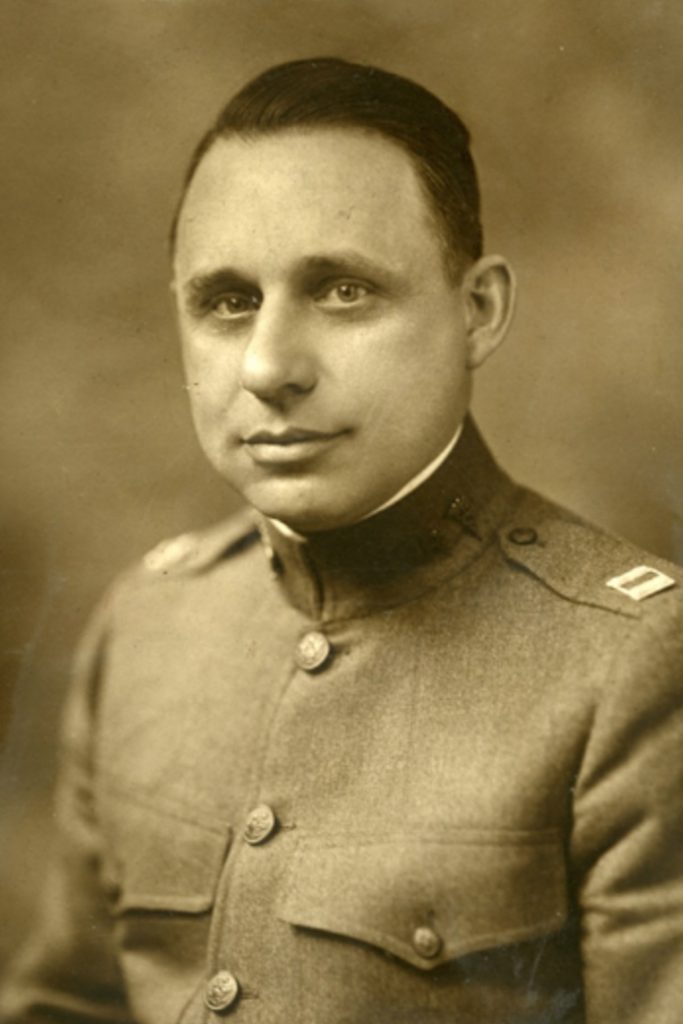
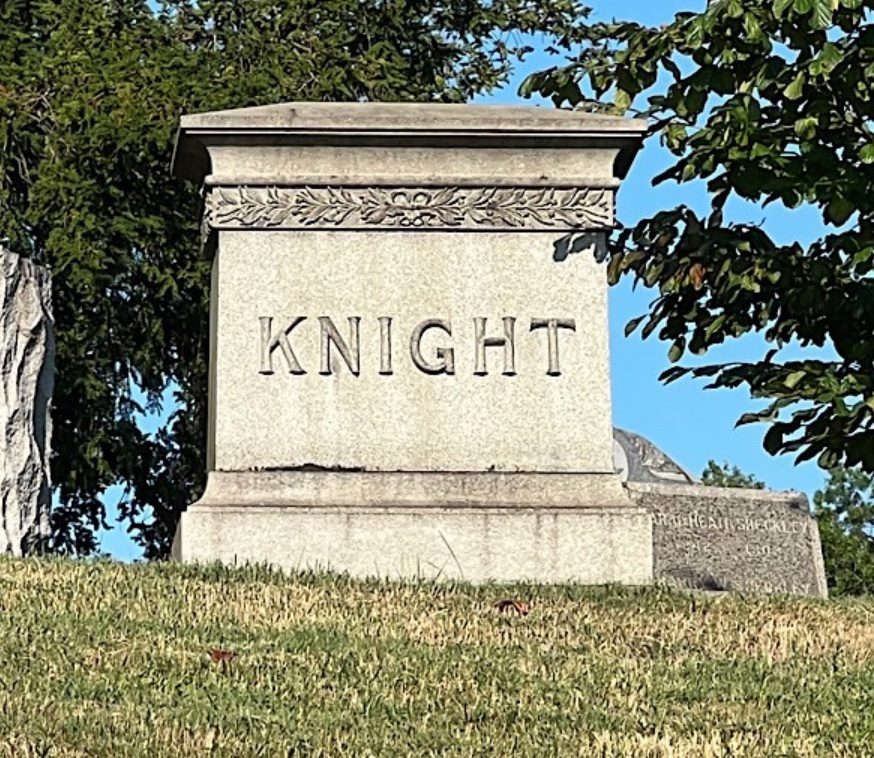
KNUDSON, THOMAS GRAHAM (1895-1918). Second class seaman, United States Navy Reserve. Knudson was born in Brooklyn. The 1900 census notes that he lived with his parents and siblings at 1340 Park Place in Brooklyn. Knudson’s World War I Draft Registration Card, filed in Brooklyn but undated, notes that he was a student at Cornell University who lived at 1412 Sterling Place in Brooklyn. He indicated that he had one year of college military training but was rejected by the Navy Reserve. He described himself as of medium height and build with blue eyes and light hair.
Although Knudson was rejected by the Navy Reserve as a student, his New York State Abstract of Military Service in World War I reports that he enlisted at the Federal Rendezvous at Brooklyn as a seaman second class on March 27, 1918. At that time, he still lived at 1412 Sterling Place in Brooklyn. He was stationed at Pelham Bay Park, New York from April 16, 1918 through October 10, 1918. As per the Record of United States Naval Deaths in World War I, he died of influenza at his home on October 10, 1918, at 331 East 26th Street in Brooklyn; however, his Military Abstract notes that he died at Pelham Bay Park. Section 205, lot 31751.

KOEHLER, CLARENCE HENRY (1894-1918). Private first class, 305th Infantry, Company C, American Expeditionary Forces, United States Army. Born in Brooklyn, the 1910 census shows that he lived on 18th Street in Brooklyn with his mother, Emma, and two siblings; at that time, he was a collector for an insurance company. Koehler’s Draft Registration Card indicates that he was single, tall, of medium build with gray eyes and brown hair. He reported that he was the sole support for his mother and that he worked as a clerk at 16 Exchange Place in Manhattan. Nevertheless, he was inducted as a private in the Army at Brooklyn on February 27, 1918, and was assigned to the 305th Infantry. Koehler went overseas on April 16, 1918. He was promoted to private first class on July 8, 1918, and was killed in action September 2 of that year. His mother was notified of his death. His last address was 220 18th Street, Brooklyn. After his remains were returned to the United States, Koehler was re-interred on May 28, 1921. Section 121, lot 23272, grave 3.
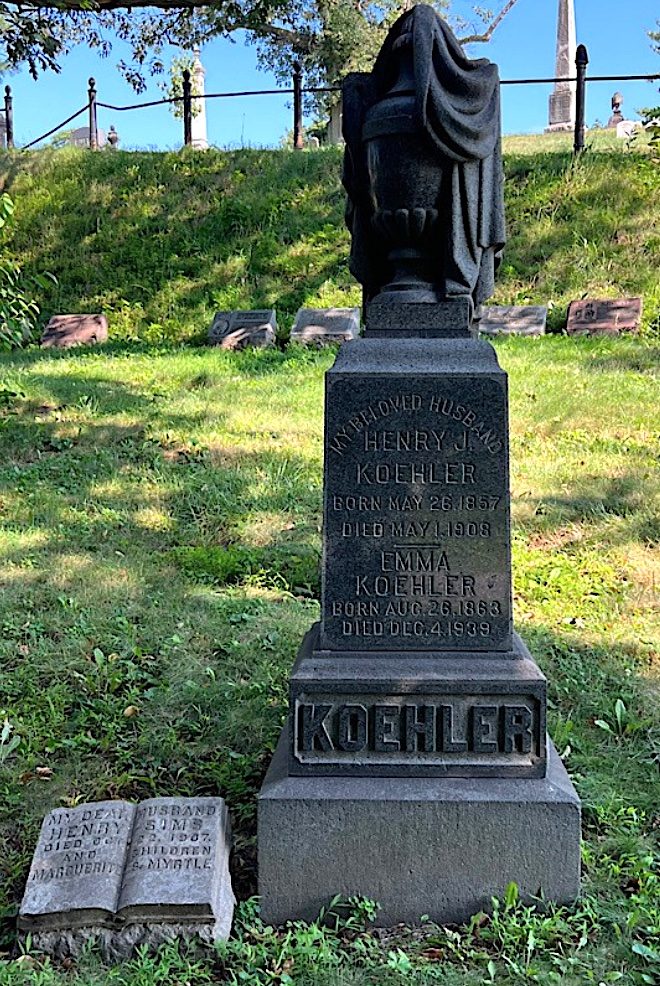
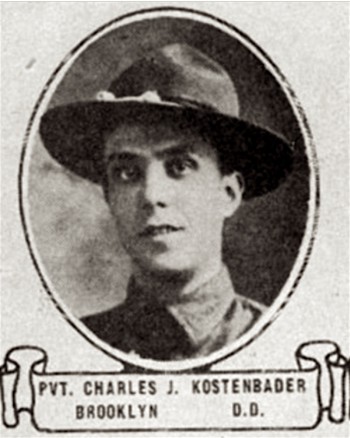
KOSTENBADER, CHARLES JOHN (1890-1918). Private, 152nd Depot Brigade; 322nd Infantry, Company B; 166th Infantry, Company B, 8th Battalion, American Expeditionary Forces, United States Army. Kostenbader was born in Brooklyn. According to the 1910 census, he worked as an upholsterer’s helper and lived in Brooklyn with his parents and sister. Prior to his military service, he worked as a baker’s helper at the Ward Baking Company located at Vanderbilt Avenue and Pacific Street. His Draft Registration Card describes him as single, tall, of slender build with grey eyes and brown hair. He noted that he had a navel rupture (umbilical hernia).
Kostenbader was inducted as a private at Brooklyn on May 28, 1918, and was assigned to the 152nd Depot Brigade. He was then assigned to Company B of the 322nd Infantry on July 19, 1918, and went overseas with them on July 31. Once in France, he was reassigned to Company B of the 166th Infantry on August 26, 1918. He saw action in St. Mihiel Sector, a town in the Meuse Department of northeastern France and at the Argonne Forest. Kostenbader contracted lobar pneumonia and was hospitalized at a military hospital in Vichy, France, where he died on October 25, 1918. His father, George Kostenbader, was notified of his death. He last lived at 520 45th Street in Brooklyn. His remains were returned to the United States in the spring of 1921. On June 4, 1921, he was buried with full military honors after a service at the Green-Wood Chapel conducted by the Reverend Otho F. Bartholow of Mount Vernon, New York. An article about his burial and military service appeared in the Brooklyn Daily Eagle on June 12, 1921. Section 4, lot 35365, grave 4.
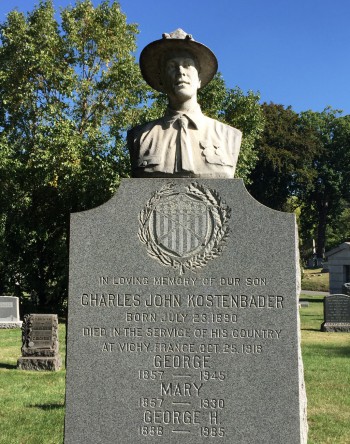
KUHLKE, JOHN REGINALD (1881-1928). Unknown soldier history. Kulke was born in Brooklyn. The 1900 census reports that he lived at 315 Clinton Street in Brooklyn with his parents, three younger siblings and a servant; at that time, he was a clerk in an office. He still lived with his parents and siblings in Brooklyn when the 1925 New York State census was tabulated. The 1910 census indicates that he lived with his aunt and uncle on Broadway in Manhattan, was single and worked as a bookkeeper for a commission house. As per his passport application of January 1910, he was an auditor who lived in New York City and planned to return to the United States in one year. He described himself as 5′ 10″ tall with grey-blue eyes, light hair, a Roman nose, high forehead, fair complexion, round chin, medium mound, and a slender face.
Not much is known about Kuhlke’s involvement in World War I. Although Veterans Administration records do not show an enlistment for him until 1920, that may be incorrect. Kuhlke’s name is mentioned in New Hampshire’s History Blog posted on September 24, 2018, in the feature New Hampshire WWI Military: Heroes of Chesterfield. That blog notes that during World War I, when there were about 750 residents in the community (including Spofford), about 20 volunteered for service; one died. On August 24, 1924, a monument to the soldiers who served from the area during wartime was installed by the Town Hall on Route 63. The monument was adorned with five plaques honoring those who served in the Civil War, World War I and other wars up to 1924.The name J. R. Kuhlke is among those listed as a WWI veteran; it is assumed by the blogger that only initials were used for the first names because everyone in the small town knew one another.
As per his death certificate, filed in Spofford, New Hampshire, Kuhlke was single, managed a hotel and died from pulmonary tuberculosis complicated by an infection. His obituary in the Brattleboro Informer noted that he managed a tavern at Spofford Lake where his parents were among the first New Yorkers to have been summer residents there. His sister, Florence Kuhlke, accompanied his body to New York for burial. Section 94, lot 36539.

LACK, HARRIET COLGATE ABBE (1890-1934). Headquarters Staff, Y.M.C.A. A Brooklyn native, the year of Lack’s birth is uncertain. Her passport application in 1917 notes with vagueness that she was born at 145 St. Mark’s Avenue in 1890?; the 1930 census, which indicates her marriage at age 25, suggests a birth year of 1895. The 1910 census reports that Harriet Abbe lived with her parents and siblings on Union Street in Brooklyn. In 1917, she applied for a passport as a secretary travelling to France and England for Y.M.C.A. (Young Men’s Christian Association) work; she was scheduled to board the Espagne, a French liner. At the bottom of her passport application, Ms. Abbe swore an oath of allegiance to the United States. As per her obituary in the Brooklyn Daily Eagle, she served with the Y.M.C.A. during the World War (World War I) and was stationed overseas in Paris and Orly in France and in Coblenz, Germany. She is listed as a member of the executive branch of the Headquarters Staff, Y.M.C.A., in Army of Occupation. In France, she met her husband, Frederick Lack; after returning to the United States, they married on April 12, 1920, in Manhattan.
Her obituary notes that the couple lived until 1922 in Peiping (now Beijing, China). The 1930 census indicates that Lack was married, and lived with her husband and daughter at 563A 3rd Street in Brooklyn. Lack was a member of the board of managers of the Brooklyn Training School for Young Girls and was a past officer of the New York Unit of the Women’s Overseas League. She died after a long illness. Section 53, lot 6325.
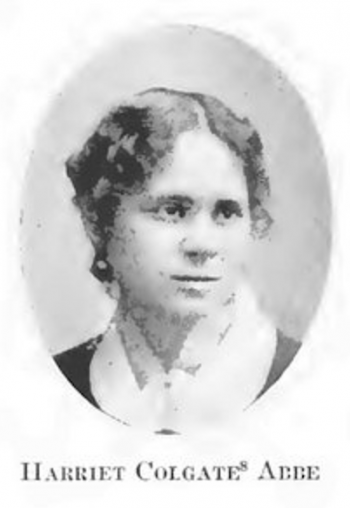
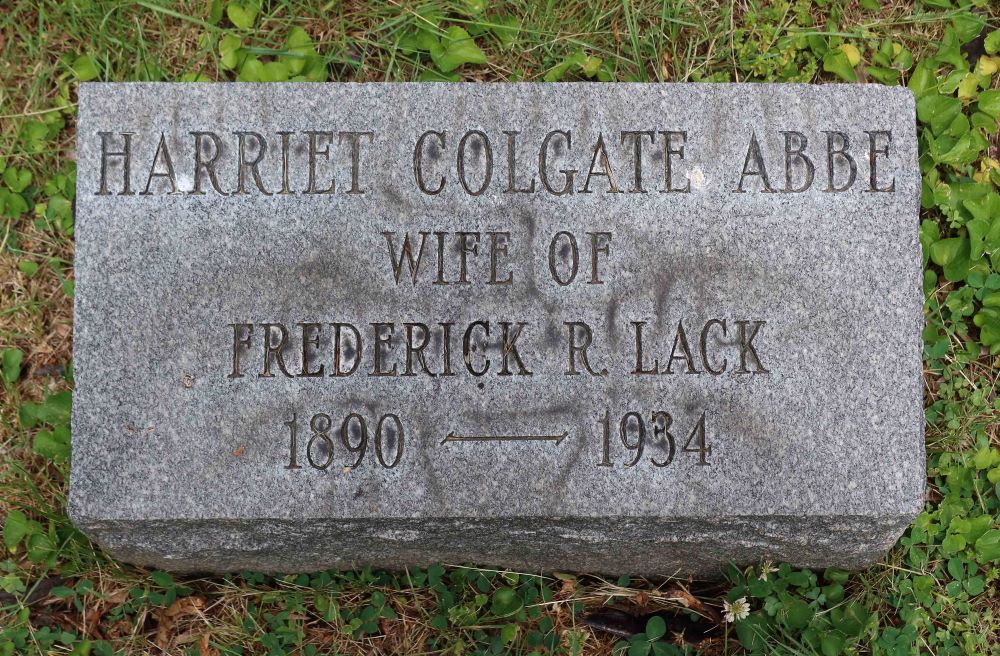
LAHEY, WILLIAM STEWART (1890-1918). Captain, 311th Infantry, Company B, 78th Division, American Expeditionary Forces, United States Army. Born and raised in Jersey City, New Jersey, Lahey attended Columbia University, class of 1917. On his Draft Registration Card, he listed his occupation as “former newspaperman” while noting that he was a candidate for commission since he had enlisted in Reserve Officers’ Training at Camp (ROTC) at Madison Barracks, New York. Described as tall and slender with greenish-brown eyes and brown hair, he trained with the 311th Infantry Regiment at Fort Dix, New Jersey. The 311th was subsequently assigned to the 78th Division. The 78th “Lightning” Division arrived in France in June-July, 1918, and saw heavy combat in the St. Mihiel, Meuse-Argonne, and Lorraine campaigns. The Meuse-Argonne campaign was the largest and bloodiest operation of the war for the American Expeditionary Forces. It was during the Meuse-Argonne offensive of September 26, 1918, that Lahey was severely wounded. He died of his wounds on October 31, 1918. His last residence was 20 Summit Avenue in Jersey City. His remains were returned home in September 1921, and were re-interred on September 14. Section 174, lot 20442.
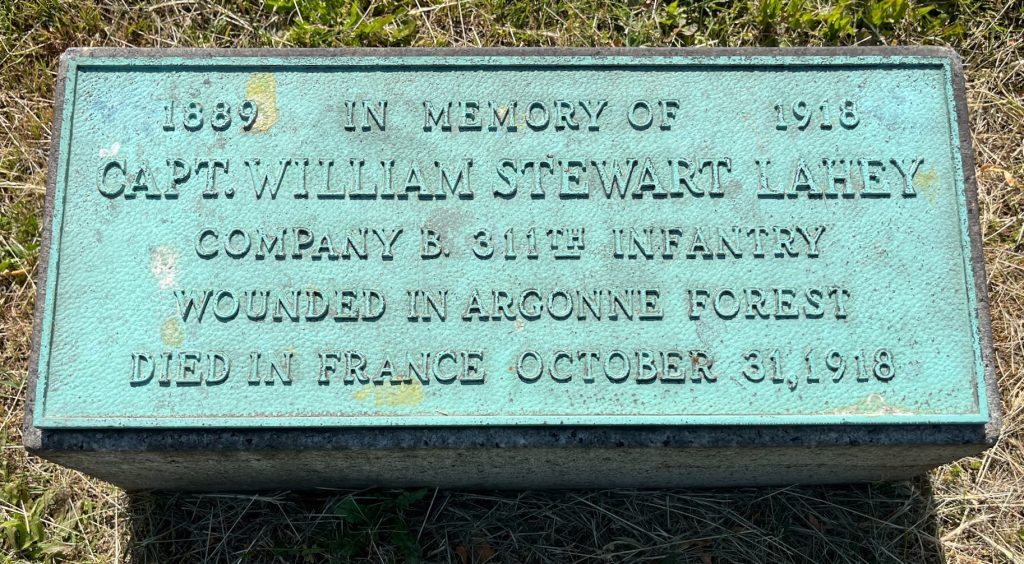
LAMBO, MICHAEL (1891–1918). Private, 305th Infantry, Company B, 77th Division, American Expeditionary Forces, United States Army. Lambo was born in Italy and immigrated to Brooklyn with his parents at age five. On February 27, 1918, he was inducted into the Army and assigned to Company B of the 305th Infantry Regiment of the 77th Division, which was organized at Camp Upton in Yaphank, Long Island, on August 25, 1917. Lambo shipped out to France on April 16, 1918. His division, the 77th, was engaged in combat for over 65 days in the Baccarat, Oise-Aisne, Aisne–Marne, and Meuse–Argonne campaigns. Lambo died on September 7, 1918, of wounds he received in action during the American advance towards the Aisne River. His last residence was 87 20th Street in Brooklyn. His remains were returned to Brooklyn in 1921 and were re-interred on July 13, 1921. Section 124, lot 35827, grave 1.
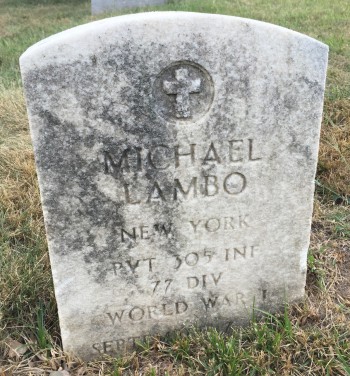
LANDON, EDWARD LEWIS (1891-1935). Private, 323rd Infantry, Company G, American Expeditionary Forces, United States Army. Landon was born in New York City. The 1900 census reports that he was attending school and living at 74 East 127th Street in Manhattan with his parents and younger sister. At the time of the 1910 census, he was single, lived on West 127th Street, and was employed as a transfer clerk for Guarantee Trust Company. The 1915 New York State census states that he was still living in New York City with his parents and sibling.
During World War I, Landon enlisted on May 29, 1918. At that time, he lived at 116 West 129th Street in Manhattan. As per his New York Abstract of World War I Military Service, Landon served overseas from July 31, 1918, through June 14, 1919. On July 31, 1918, he was listed on the manifest of the USS Empress of Asia, being transported to Europe as a private in Company G of the 323rd Infantry; his mother was listed as his next of kin. Landon left St. Nazaire, France, on June 3, 1919, aboard the USS Walter A. Luckenbach, a troop transport ship which brought him back to the United States. He was honorably discharged on June 21, 1919, upon demobilization of his unit. He was not disabled during his service. On November 6, 1926, he married Myrtle Klein in Manhattan. At the time of the 1930 census, he was living in the Bronx at 680 West 235th Street with her and two children aged one and two, had a radio set, was in the trucking industry, and was a veteran of the World War. As per his death certificate, he was an accountant. On March 21, 1935, five days after his death, Myrtle Landon of 3324 190th Street in Flushing, New York, applied for a government-issued headstone, citing her husband’s service in the World War. That document originally misspelled the last name as Landom; it was then crossed it out in red. Section 15, lot 4591.
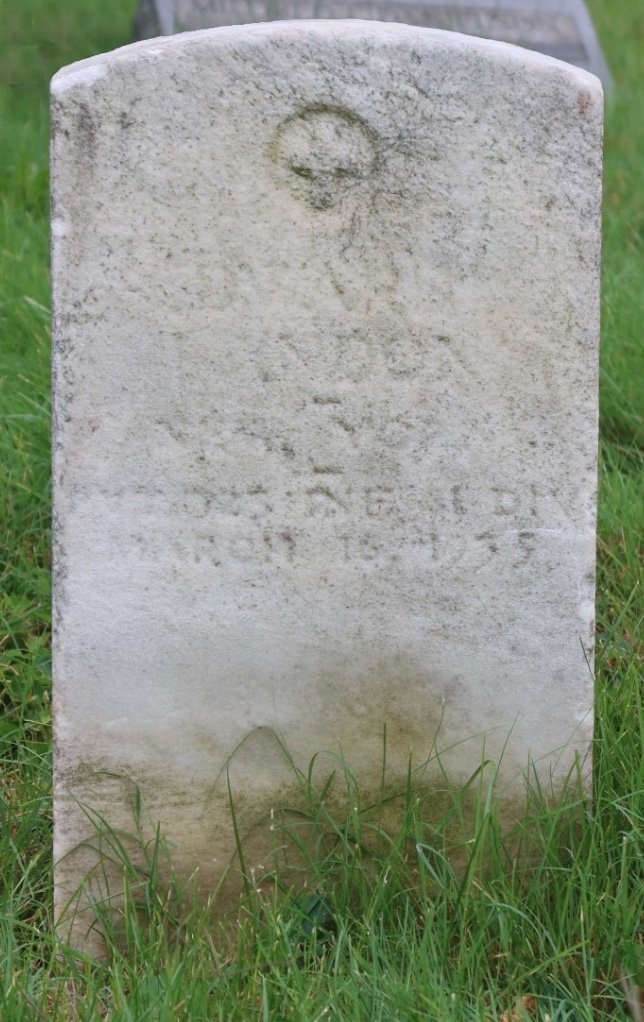
La PORTE (or LAPORTE, LAPORT), WARREN LEROY (1893 or 1894-1955). Private, 324th Aero Squadron, United States Air Service. A Brooklyn native, La Porte’s birth year is unclear: it is listed in birth records (as Warren Laport) and on his World War II Registration Card as 1893 but his Draft Registration Card for World War I and his application for a government-issued headstone both indicate 1894. The 1910 census shows that La Porte lived on Bushwick Avenue in Brooklyn with his parents and sibling; he worked for a contractor as an electrician’s helper. As per his Draft Registration Card, filed on June 5, 1917, La Porte described himself as tall, of medium build with brown eyes and black hair. He stated that he was married, had a wife who was dependent upon him for support, lived at 1198 Bedford Avenue in Brooklyn and worked as a watchman in Hunt’s Point in the Bronx. After enlisting on March 8, 1918, he was inducted into the United States Air Service at Brooklyn on May 18, and assigned to the 324th Aero Squadron. He was detached to the Carlstrom Field Flying School in Arcadia, Florida, a pilot training facility, until his honorable discharge upon demobilization on May 22, 1919. As per his service records, La Porte did not serve overseas and suffered no injuries.
The 1920 census reports that La Porte was single, lived with his parents and younger brother on Clifton Place in Brooklyn and was a chauffeur for a private family. In 1930, he married Myrtle Dudley in Brooklyn. According to the 1940 census, he was married, owned his house on Seeley Street in Brooklyn which was valued at $6,000, worked as an investigator but had not worked in 1939, and had completed the eighth grade. La Porte’s World War II Draft Registration Card, filed in 1942, notes that he was married, lived at 114 Seeley Street in Brooklyn, and worked for the Conlin Electric Company on Atlantic Avenue in Brooklyn. He last lived in Brooklyn. On March 30, 1956, Myrtle La Porte of 557 57th Street in Brooklyn, applied for a government-issued headstone with Christian emblem, citing her husband’s World War I service. Section 193, lot 31309.
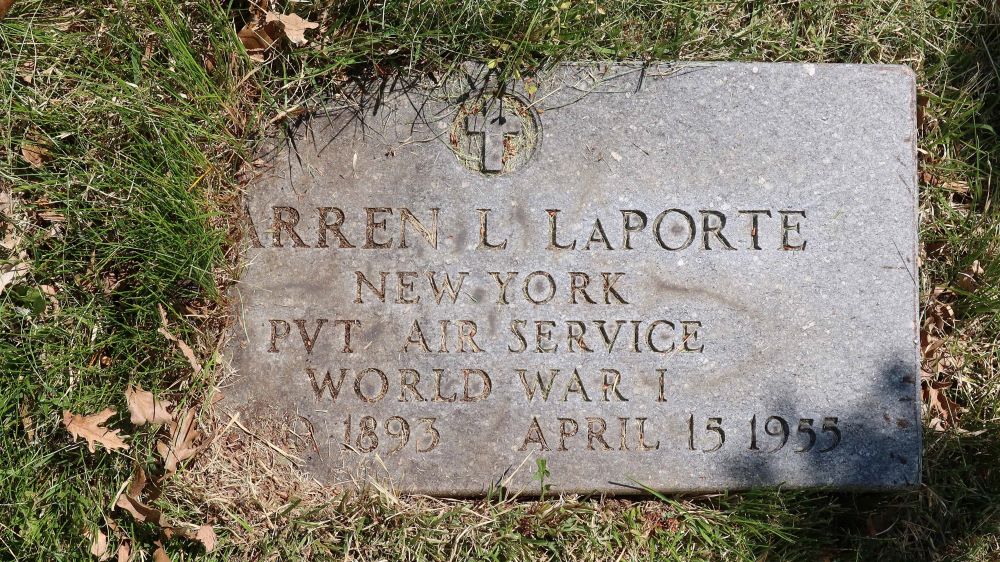
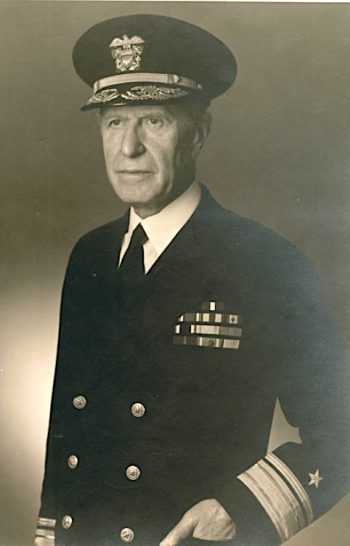
LEAHY, LAMAR RICHARD (1880-1958). Commander, United States Navy. Leahy was born in Buffalo, New York. His obituary in the International Hydrographic Review notes that he graduated from the United States Naval Academy at Annapolis, Maryland, in 1903, and became an ensign in 1905. As per the 1910 census, he was single and was a Naval officer aboard the USS California. Leahy was awarded the Navy Cross in 1919 for “distinguished service in the line of his profession as commanding officer of the USS Noma in an encounter with an enemy submarine on the night of the 28th November, 1917, in which the submarine was driven off and the convoy of storeships under escort of the Noma were saved from damage and possible destruction.”
On September 17, 1919, Leahy married Margery Hamilton Clinton. The 1920 census reports that he was married and was at sea in the United States Military and Naval Forces. Leahy became a captain in the Navy in 1926, and from 1928-1930, he commanded a squadron of 19 destroyers. From 1933-1935, he was the officer on the USS Texas. Leahy then was hydrographer of the United States Navy from 1935 through 1938, supervising the publication of a surveying manual and the compilation of short navigation tables. He was promoted to rear admiral in 1939. As per his obituary in the Seattle Daily Times, which noted his service in both World Wars, he became director of the International Hydrographic Bureau at Monte Carlo, Monaco, after retiring from the Navy, on a special leave, on August 30, 1939.
In light of the outbreak of World War II, he returned to active duty in 1941. As per an article in the Press and Sun-Bulletin of Binghamton, New York, on April 13, 1946, Leahy had decorations from four foreign governments for his war services: Order of the British Empire from Great Britain, the Cross of the Legion of Honor from France, Cross of Commander of the Order of the White Lion from Czechoslovakia for relief work after World War I, and an honor from the Netherlands. He briefly returned to the Hydrographic Bureau from February 19 through June 30, 1947. Leahy was a trustee of the Woods Hole Oceanographic Institute. His obituary in the New York Daily News, notes that Leahy served in the Navy for 36 years before his retirement in 1939, and acknowledged his Navy Cross award. He last lived at 910 Park Avenue in Manhattan. Section 181, lot 33356.
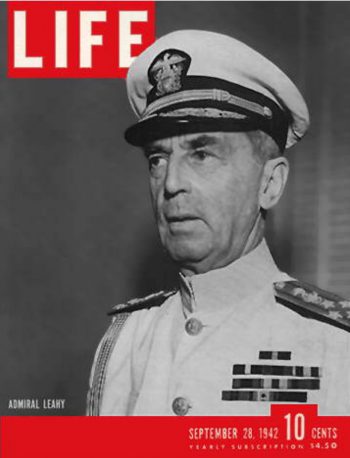

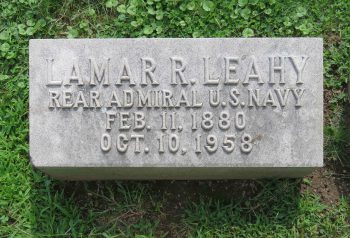
LEE, LAWRENCE SOU (1893-1955). Unknown military history. As per the 1910 census, Lee was born in China; his Draft Registration Card specifies Canton (now known as Guangzhou). That census reports that he immigrated to the United States in 1904, and lived with John and Nellie (Thatcher) Lee, his aunt and uncle, on 2nd Street in Brooklyn. Also in the household were William W. Lee, Lawrence’s brother, and Mary Brown, a servant. Lawrence spoke English, attended Manual Training High School (now John Jay Educational Campus) and could read and write.
On October 31, 1916, Lee and his future spouse Bessie M. You Toy obtained a marriage license; they were married in Manhattan on November 3. As per his grandson, Larry Lee, Bessie was a survivor of human labor trafficking. Her life was the subject of a dance performance titled “Light,” created and performed by San Francisco-based Lenora Lee Dance. The finale of the performance is when she and his grandfather met.
On June 5, 1917, Lee filed a Draft Registration Card in Rowe, Massachusetts, where he was a poultry farmer. He identified himself as a Chinese alien of the “yellow” race of medium height, slender build, with black hair and eyes. He noted that his wife was dependent on him for support. As per his grandson, his grandfather served at the end of World War I; Larry Lee’s father told him that Lee served in the United States. No other details about his military service are known.
Lee returned to Brooklyn after his service. In 1920, John Lee bequeathed the Miquel Atak Cigar factory to his nephew Lawrence. It employed many Chinese Americans making Cuban cigars. When it went out of business, Lawrence opened and ran Young’s Restaurant in Bay Ridge, Brooklyn, until his death. He died in Brooklyn, predeceased by his wife Bessie who died two months before him; they are interred together. Section C, lot 35591.
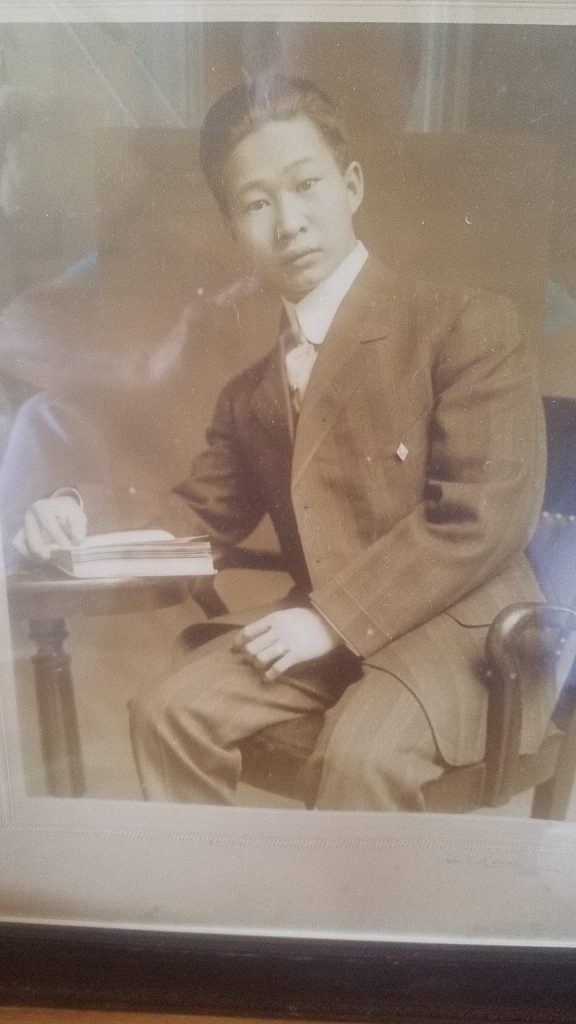
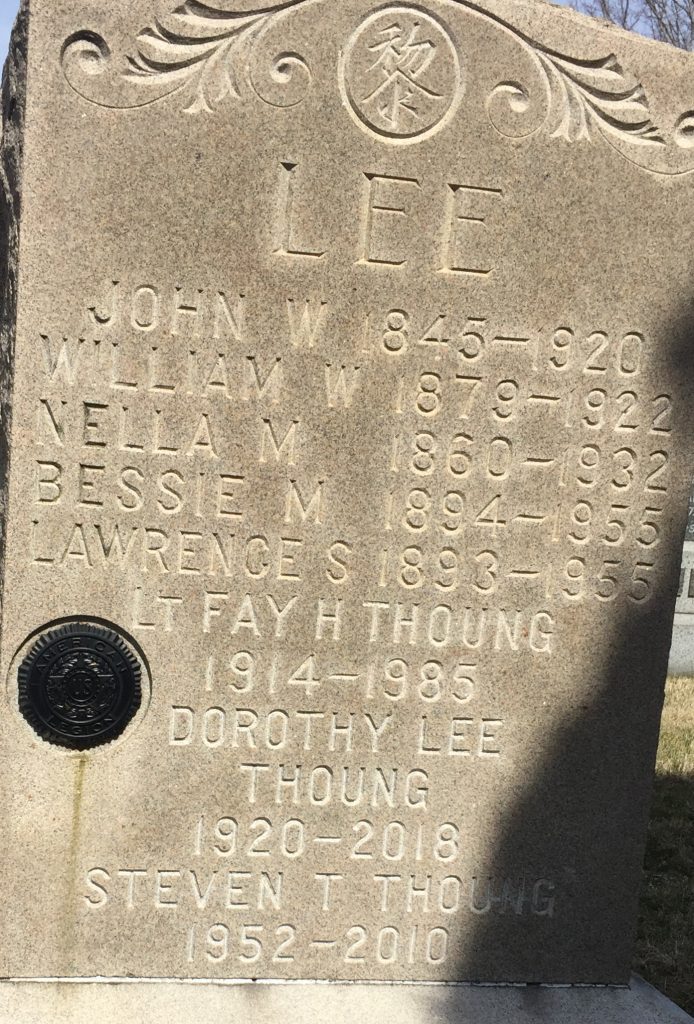
LEIGHTON, RAYMOND (or RAY) ROSCOE (1893-1976). Private, 23rd New York National Guard, Company G. Leighton was born in Brooklyn. The 1900 census, which lists an incorrect birth year, notes that he attended school and lived at 12 Hope Street in Brooklyn with his parents, older sister, older brother and a boarder. According to the 1910 census, he lived with his parents, older sister, a servant and four boarders on East Northport Street in Huntington, New York. He still lived with his parents in Huntington at the time of the 1915 New York State census.
Leighton’s New York State Abstract of World War I Military Service reports that he enlisted as a private at Brooklyn on June 26, 1916, and mustered into Company G of the 23rd New York National Guard on July 1. As per his Mexican Punitive Campaign Muster Roll for the New York National Guard, he was 5′ 10½” tall with brown eyes, dark hair, a dark complexion, was employed as a clerk and lived in East Northport, New York. That document notes Leighton’s promotion to private first class in October, service at regimental headquarters, and muster out with his company at Brooklyn on January 17, 1917. He was honorably discharged on July 28, 1917, on S.C.D., with a 25% disability (no reason stated).
As per his World War I Draft Registration Card filed in Babylon, New York, on June 6, 1918, he lived in East Northport, New York, and worked there in the garage business. He cited previous service as a private in the infantry at the Brooklyn Armory and the Mexican border. (Actual service in Mexico is not noted on the Mexican Punitive Campaign Muster Roll.) Leighton described himself as single, tall, of medium build with brown hair and eyes, and no disabilities. His World War I Abstract notes that he was not involved in any engagements of the war, was not wounded and did not serve overseas. Although inducted on July 22, 1918, he was discharged from Draft on July 25, 1918.
On December 24, 1921, he married Martha Atwell in Huntington, New York. The New York State census for 1925 reports that he and his wife lived with his parents in Huntington. At the time of the 1930 census, he lived in Huntington in his own home valued at $5,000, worked as a bookkeeper in the insurance industry, and was a World War veteran. As per the 1940 census, he owned his home, valued at $4,000, on Tenth Avenue in Huntington. He had completed three years of high school, worked as a traffic officer in 1939, and had earned $2,000. His World War II Draft Registration Card notes that Ray Leighton lived on Tenth Avenue in East Northport, New York, had a home telephone, and worked for the Police Department in the town of Huntington. He listed his wife, Martha, as his next of kin. Section 143, lot 26919.
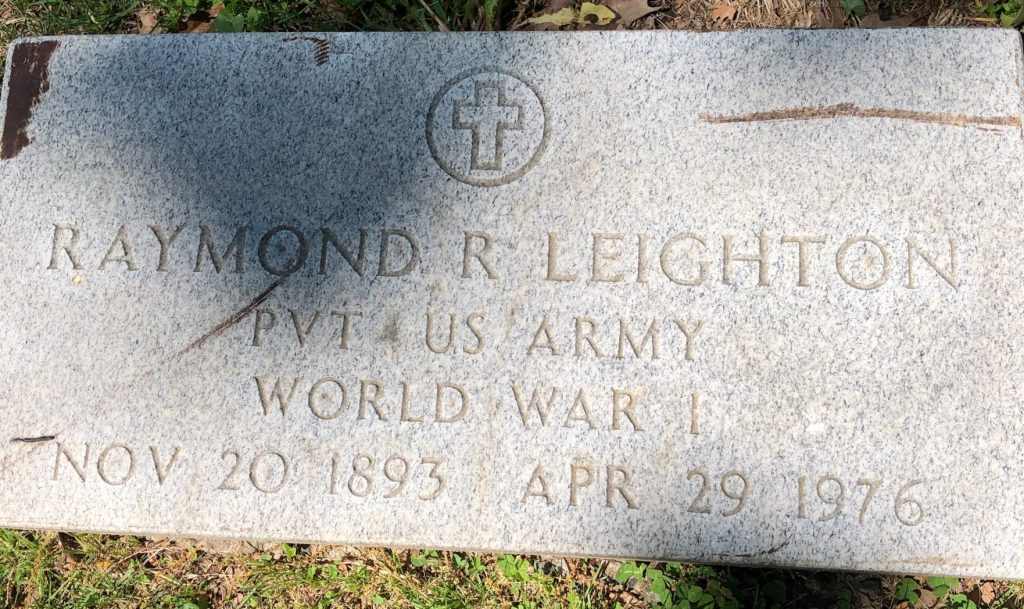
LEO, ERNEST (1887-1928). Boatswain’s mate first class, Naval Auxiliary Reserve, New York City. Leo was born in Landskrona, Sweden. He left Hamburg, Germany, on March 2, 1910, and arrived at Savannah, Georgia, on April 16, 1910. He filed his intention for naturalization in Brooklyn Supreme Court on November 15, 1912; he was not married at that time and noted that he spoke English. Leo, a seaman, then lived at 261 56th Street; his papers were finalized on February 23, 1917.
Leo’s World War I Draft Registration Card, filed on June 5, 1917, notes that he was a naturalized citizen who lived at 434 45th Street in Brooklyn and worked as a seaman for the United Fruit Company. He described himself as single, tall in stature, of medium build with blue eyes and red hair. Leo claimed as exemption from service citing his rejection by the Naval Reserves. On June 7, 1917, he filed an application for a Seaman’s Protection Certificate noting his naturalization, stating that he last served on the SS Zacapa from New York to Panama, and swearing his allegiance to the United States.
Despite an earlier rejection, Leo’s New York State Abstract of Military Service for World War I notes that served in the Naval Auxiliary Reserve of New York City from October 30, 1917 through November 11, 1918, as a first class boatswain’s mate. He then was placed on inactive duty on January 11, 1919 as a chief boatswain’s mate in the Naval Overseas Transportation Service for the 3rd Naval District of New York City.
On February 28, 1919, Leo filed an application for a Seaman’s Protection Certificate of United States citizenship. He noted his naturalization information, and stated that he was 5′ 10″ tall with a ruddy complexion, blond hair and blue eyes. Leo indicated that he had a tattoo of a sailor on his right forearm and a tattoo of ship flag on his left forearm. He indicated that he last served on the F.W. Barstow and that his next ship would be the SS Borinquen.
Leo applied for a passport in 1920 indicating that he and his wife would be sailing to Sweden from New York in December to settle the estate of his father who had died in November 1920; they planned to return within four months and would stop in England en route. He noted that he was an officer in the merchant marine.
At the time of the 1930 census, he lived at 317 95th Street in Brooklyn with his wife; he was listed as a naturalized citizen who was a mariner and a veteran of the World War. He last lived at 255 Senator Street in Brooklyn. Section 6, lot 33789.

LESSELS, WILLIAM VELSOR (or B.) (1874-1942). First lieutenant, 102nd Field Artillery Signal Corps, American Expeditionary Forces, United States Army. Lessels was born in Brooklyn. On September 26, 1904, he joined Company B of the Signal Corps, the first of his enlistments in that unit, which continued through February 23, 1915. The 1904 Brooklyn Directory reports that Lessels was a merchant at 377½ Jefferson Avenue who resided at 291 Stuyvesant Avenue; the 1912 Brooklyn Directory indicates that he lived at 66 Rugby Road and was in the insurance business. The 1915 New York State census states that Lessels was a clerk living with his mother in Brooklyn. Lessels re-enlisted in the 1st Battalion Signal Corps, 1st Aero Squadron, on March 1, 1915, and was discharged on March 23, 1916, but subsequently re-enlisted the next day and served in the New York State National Guard during the Mexican Punitive Campaign. A clerk at that time, he still lived on Rugby Road and was 5′ 5¾” tall with blue eyes, brown hair and a fair complexion; his mother was listed as his next of kin. Lessel’s military record for that conflict shows that he enlisted as a first class sergeant at Brooklyn on March 24, 1916, and was called to appear on June 19. He mustered into Company B of the 1st Battalion Signal Corps on July 3 as acting 1st sergeant; his unit was part of the 10th New York National Guard. He mustered out with his company at Brooklyn on December 23, 1916, and was officially discharged on June 29, 1917.
During World War I, Lessels was drafted into federal service on August 5, 1917, as a first lieutenant in the 102nd Signal Corps. As per his military records, he was stationed in New York, then in Camp Wadsworth, South Carolina. On January 7, 1918, he married Leigh Cooke in Brooklyn. On May 17, 1918, he was sent overseas to France where he participated in the Somme Offensive and the Battle of Ypres-Lys. He returned to the United States on the Harrisburg leaving Europe on November 15, 1918, and arriving in Hoboken, New Jersey. Lessels then was stationed in Newport News, Virginia, and Camp Meade, Maryland, before he was honorably discharged on February 1, 1919. His records indicate a transfer to the 223rd Signal Corps before his discharge but no date is given; he was not injured during his service. On July 2, 1924, he received the Conspicuous Service Cross for his service in the 102nd Field Signal Battalion.
As per the 1925 New York State census, Lessels lived in Hempstead, New York, with his wife and two young children and worked as an insurance clerk. The 1930 census notes that he lived at 27 Taft Avenue in Lynbrook, New York, in a house that he owned that was valued at $9,000. At that time, he indicated that he was an insurance supervisor, and was a veteran of the Mexican War and the World War. He died in Pinellas County, Florida. On April 26, 1942, Leigh Lessels, his widow who lived at 38 St. Paul’s Place in Brooklyn, applied for a government-issued headstone, citing her husband’s service in the Signal Corps. Section 161, lot 12483.
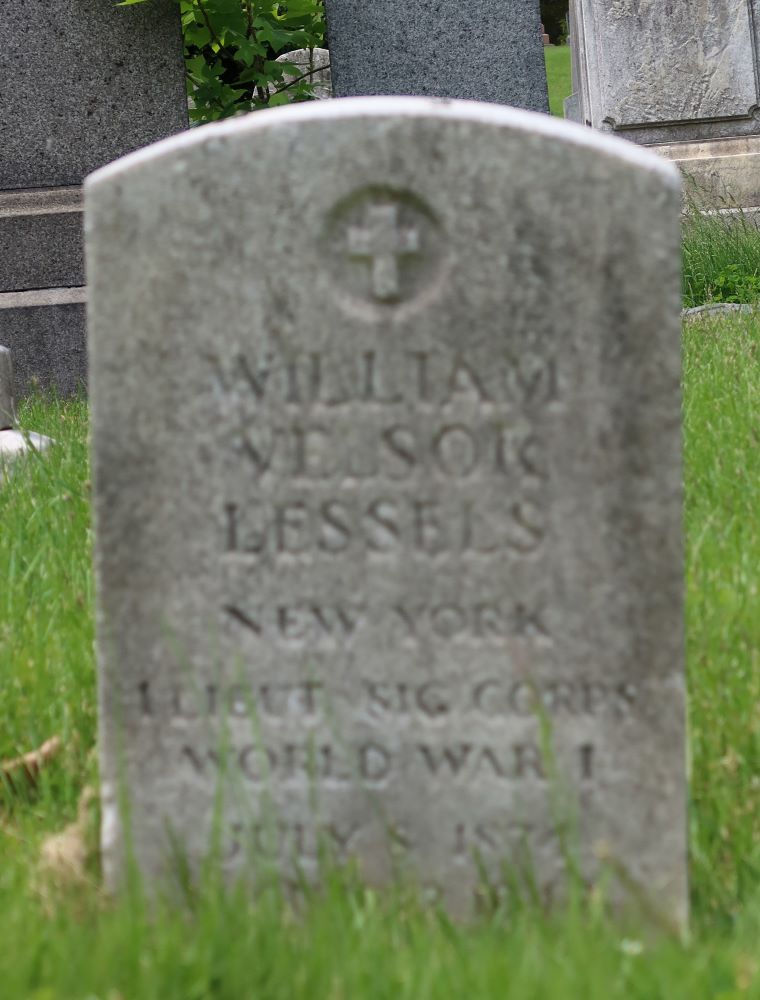
LIENECK, JR., PAUL (1896-1918). Corporal, 307th Infantry, Company H, American Expeditionary Forces, United States Army. A Brooklynite by birth, the 1910 census reports that Lieneck lived with his parents and siblings on 14th Street in Brooklyn. At the time of the 1915 New York State census, he lived with his father and siblings and worked as a clerk for a clock company. As per his Draft Registration Card, filed on June 5, 1917, he lived at 307 14th Street in Brooklyn, was single, and worked as a clerk on Pine Street in Manhattan. Lieneck described himself as tall and slender with blue eyes and brown hair. On December 7, 1917, he was inducted into the Army as a private and assigned to Company H of the 307th Infantry. His name appears on the manifest of the USS Justicia, a troop ship, leaving New York on April 7, 1918; he then lived at the same 14th Street address and listed his sister, Elsie Lieneck, as his next of kin.
Lieneck was promoted to corporal on April 16, 1918. He died in France in the Battle of Argonne Forest on August 27, 1918; apparently, his death was not confirmed at that time because he was listed as missing in action in the Brooklyn Daily Eagle on October 6, 1918. Elsie Lieneck was notified of his death. On April 26, 1921, when bodies could be returned to the United States for burial, his remains left Antwerp, Belgium, on the USS Wheaton, bound for Hoboken, New Jersey.
On June 2, 1921, Lieneck’s two sisters and three of his brothers wrote a letter to the Green-Wood Cemetery office, then at 170 Broadway in Manhattan, asking that the lot, purchased by their father, Paul Lieneck Sr., be opened for the interment of their brother whose body was in Hoboken. Their father had been living in Germany and could not be reached because he was on an extended vacation. The siblings indicated that their brother died in France during the late war and that it was impossible to get their father’s permission to open the lot; they attested that their father would have approved of their plea. As per the Brooklyn Daily Eagle on June 7, 1921, Lieneck was to be interred at Green-Wood the next day with military honors including a last volley and the sounding of “Taps”; he was survived by his father and five brothers and two sisters. Section 131, lot 33648.
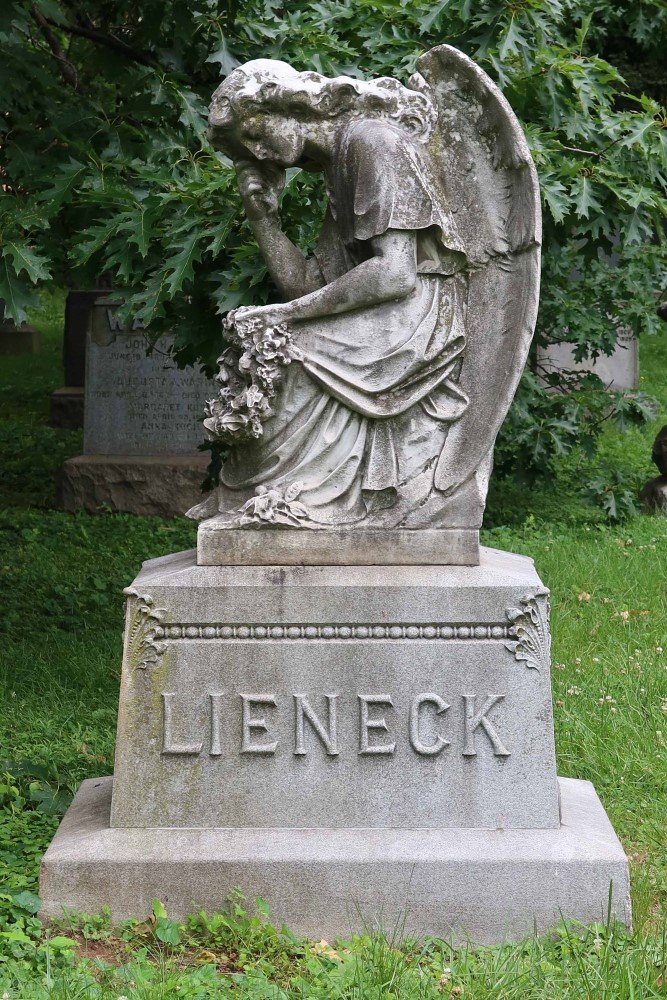
LOVELL (or LEVELL), JR., HERBERT ALEXANDER (1896-1950). Seaman, second class, Section Base 4; United States Naval Hospital, United States Navy. Born in Brooklyn on May 16, 1896, family records proudly trace his lineage to several of the Mayflower passengers. New York State Abstracts of World War I Military Service show that Lovell enlisted at the Navy Recruiting Station in New York City on April 30, 1917. At the time of his enlistment, he was living at 5 Park Avenue in Jamaica, Queens. He was assigned to Section Base 4 in Montauk, Long Island, from June 2, 1917 until September 18, 1918, as a seaman second class. During that assignment, he married Alice M. Wolff, whose lineage traced to early Dutch settlers in New York, on December 26, 1917. According to their newspaper marriage announcement, the couple was married at the home of the bride’s parents by the Reverend George Tilly of Jamaica; Lovell was listed as being stationed at Camp Upton in Yaphank, New York. From September 18 through September 29, 1918, Lovell was assigned to the Federal Rendezvous in Brooklyn, the site where recruits enlisted for duty in the Navy; thereafter, he was re-assigned to the United States Naval Hospital in New York where he served until Armistice Day, November 11, 1918. Lovell was honorably discharged on December 30, 1918.
As per the 1920 census, Lovell lived with his wife’s family in Jamaica, and worked as a clerk for a drug export company. The 1925 New York State census reports that he and his wife lived in Queens, New York, and that he was employed as a salesman. At the time of the 1930 census, Lovell, his wife, and their five-year-old son were renting a home in Queens, and owned a radio set; he was working as a department manager for a gas company and was listed as a veteran of the World War. The 1940 census indicates that the family was living in a rented home at 93 Gaynor Avenue in North Hempstead, Long Island; Lovell was employed as a salesman and office manager at that time; he noted that he had completed two years of high school and had earned $5,000 in 1939. His 1942 World War II Draft Registration Card shows him living at 78 Bourndale Road South in Manhasset, Long Island, owning a home telephone, and being self-employed at an office at 441 Lexington Avenue in New York City. As per his obituary, he last lived in Mattituck, Long Island; his funeral was conducted at the Walter B. Cooke Funeral Home in Brooklyn. Section 145, lot 23602.
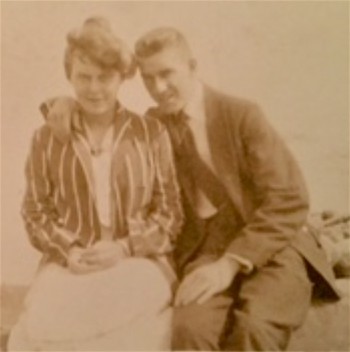
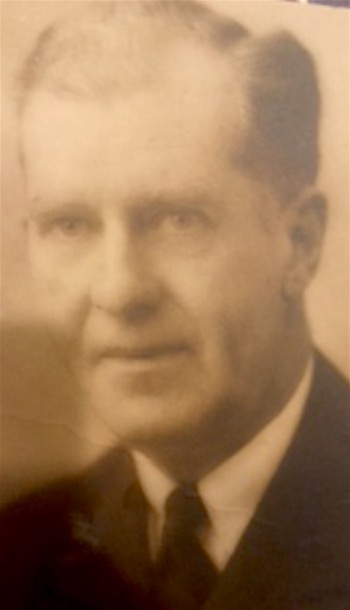
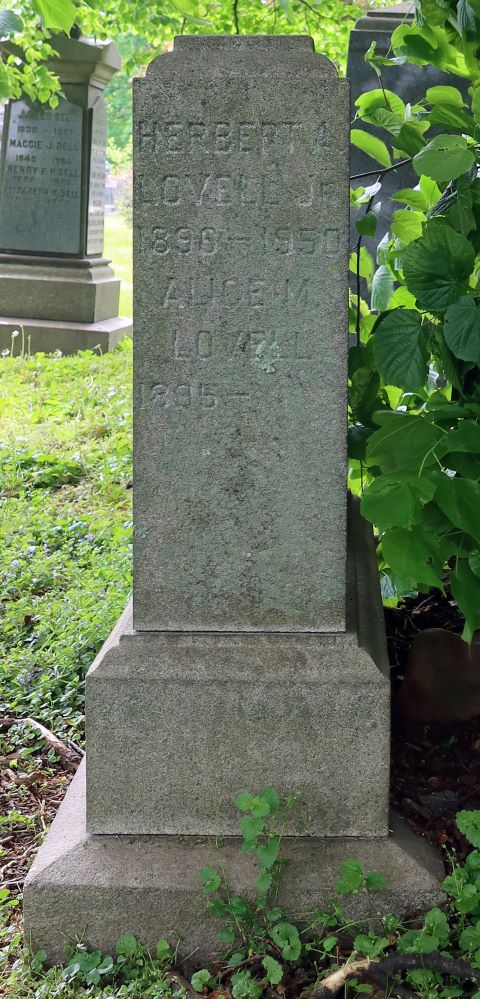
LOVENBERG (or LAVENBERG, LORENBERG), WALTER EVERDELL (1896-1955). Private, 4th Coastal Artillery, United States Marine Corps. Lovenberg was born in Essex County, New Jersey. His Draft Registration Card of June 5, 1917, notes that he lived at 26 Norwood Avenue in Summit, New Jersey, and was employed by the Trunk Line Association on Liberty Street in Manhattan. He described himself as slender, of medium height with blue eyes and dark brown hair. During World War I, he enlisted in the 4th Coastal Artillery Corps, United States Marine Corps, on July 5, 1918, and was discharged on September 11, 1919.
According to the census of 1920, Lovenberg had returned to his parents’ home in Madison, New Jersey, and worked as a railway clerk. He attended Cornell University in 1922 but left after one year. According to the 1930 census, he was single and living with his parents who had moved to 104 Woodland Avenue in Summit, New Jersey; that census indicated that he worked as a sales manager in the chemical industry and was a veteran of the World War. The 1940 census records that he was married and had a son who was born in 1935; the Lovenbergs were living in Delaware, New Jersey, and he was working as a manager on a farm. The 1940 census also notes that he had completed one year of college. As per his World War II Draft Registration Card of 1942, he was living on Old Creek Road in Sergeantsville, New Jersey; that document noted that he did not have a home telephone. On October 3, 1955, Charles Fischer of Flemington, New Jersey, applied for a government-issued headstone for Lovenberg, citing his World War I service. On that application, there was an asterisk next to “Medals” and a notation “over,” but there is no further information as to whether Lovenberg was awarded any medals. Section 167, lot 16842.



LUDWIG, KENNETH (1898-1919). Private, Student Army Training Corps. Kenneth Ludwig, who was born in Pawling, New York, was the brother of Lloyd (see) and Walter. By 1910, his family had moved to Brooklyn. He attended P.S. 103 and graduated from Manual Training High School (now John Jay High School). In his freshman year at Colgate University in Hamilton, New York, on September 12, 1918, on September 12, 1918, he registered for the draft and was activated in the Student Army Training Corps on October 1. At that time, he described himself as being 5′ 10 ½” tall with brown eyes and hair. His home address was 1358 49th Street in Brooklyn. On December 18, 1918, he was awarded an honorable discharge when his unit was demobilized after the armistice. While still a student at Colgate, in his junior year, he died of cerebro-spinal meningitis on February 24, 1919. In the Colgate Maroon, Professor I. D. Edie wrote the following:
Colgate men have been lifted from the daily levels to the lonely summits of life by a sudden profound grief. One of the nobles and strongest of their midst has been called to his death – Kenneth Ludwig.
To know Kenneth was to know a strong man. To know him intimately, heart to heart was to feel a quick, brave faith in the goodness of life. There was that in the spirit of Kenneth Ludwig which perpetually challenged his closest pals—something which revealed an unsearchable allurement in the clean, the stalwart, the timeless. To be heirs of this spirit is our great pride.
Services assisted by Dr. Elmer Burritt Bryan and Dr. John Frederick Vichert, dean of the Theological Faculty, Colgate, were held on February 26 at the Borough Park Baptist Church on 13th Avenue and 48th Street in Brooklyn where the Reverend W. W. Ludwig, Kenneth’s father, was the pastor. Kenneth was interred the next day. In his memory, his parents had the music room of the Iota Chapter of Colgate’s Theta Chi Fraternity beautifully decorated. Section 142, lot 24600, grave 4.
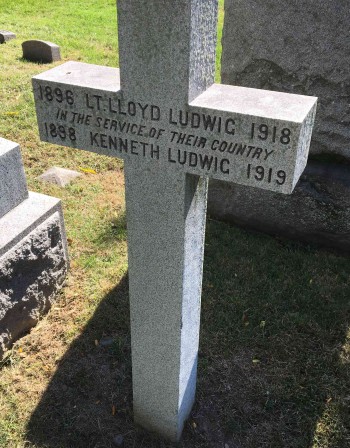
LUDWIG, LLOYD W. (1896-1918). Private first class, United States School of Military Aeronautics, American Expeditionary Forces, Air Service Signal Corps. Ludwig was born in Newark, New Jersey, and had two brothers, Kenneth (see) and Walter. According to the census of 1900, the family lived in Pawling, New York; the 1910 census indicates that the family had moved to Brooklyn and resided at 4810 14 Avenue. Ludwig graduated from P.S. 103, Manual Training High School (now John Jay High School) and Colgate University, class of 1917. His yearbook from Colgate indicates that he belonged to the Classical Club and was a member of the Junior Prom Committee.
As per the New York State Abstract of World War I Service, Lloyd Ludwig entered the Enlisted Reserve Corps as a private first class (cadet) on August 15, 1917, and was assigned to the U.S. School of Military Aeronautics. However, an article about his death in the Brooklyn Daily Eagle on March 4, 1918, notes that he first entered the First Officers’ Training Camp and was ordered to Madison Barracks. He then sought a transfer to the aviation section and was sent to Mineola, Long Island. The Brooklyn Daily Eagle reports that he was first scheduled to serve in Italy but was instead sent to England. He left for overseas duty on September 18, 1917, with the 28th Training Squadron, Air Service Signal Corps, American Expeditionary Forces (AEF), and was stationed at Castle Bromwich Airfield in Birmingham, England. On February 28, 1918, Ludwig was flying in his SE5A c5371 plane when the starboard upper-wing came off while his plane was in a spin; he was killed. Some family lore indicates that he was killed in a snow-storm but that is uncertain. It was reported in the Brooklyn Daily Eagle on November 11, 1920, after his remains were returned to the United States, that funeral services were to be held on Saturday, November 13 at the Borough Park Baptist Church where the Reverend William W. Ludwig, Lloyd’s father, was the former pastor.
It was written in a Theta Chi fraternity history at Colgate (1856-1927) edited by Robert Henderson Hoge:
Iota (chapter) is proud to have on the wall of its blue room a memorial tablet to the memory of Lloyd Ludwig, class of 1917, a brother of Kenneth and Walter Ludwig, members of the chapter. He was the first Colgate man to give his life in the Great War. As a memorial to their son Lloyd, the Reverend & Mrs. William W. Ludwig presented Iota with the sum of $500.00 to be expended on the house. One year later, when Kenneth died, the stricken parents desired to give the chapter some token in memory of Kenneth, too, and had the music room of Iota’s home, at that time, burlapped and beautifully decorated.
Section 142, lot 24600, grave 3.

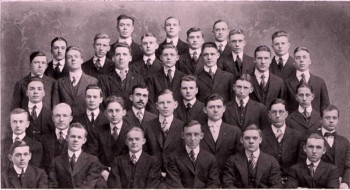

MAC CALLUM (or MACCALLUM), ARCHIE HAROLD (1890-1949). Sergeant first class, Graves Registration Service, Unit B, Quartermaster Corps; sergeant, Graves Registration Service, Unit 302; private, 307th Infantry, Company I, American Expeditionary Forces, United States Army. Mac Callum was born in New York City. The 1910 census reports that he was living in Mount Vernon, New York, with his parents and siblings and was working as a clerk at a lighting company. His Draft Registration Card of June 5, 1917, indicates that he was single, living at 145 North Terrace Avenue in Mount Vernon, and working as a clerk for the New York Central Railroad. He was described as tall, of medium build with blue eyes and brown hair. At his physical examination on August 21, 1917, he was diagnosed with flat feet.
Nevertheless, Mac Callum was inducted into the United States Army on September 28, 1917, and sent to Camp Upton in Yaphank, New York. Originally, he was assigned to Company I of the 307th Infantry until November 15, 1917, when he was transferred to the Graves Registration Service, Unit 302, and went overseas to France with them on February 8, 1918. The Graves Registration Service, established in August 1917, grew out of efforts used in the Spanish-American War to identify soldiers, handle their remains with care, and arrange for proper burial. By the time the United States entered World War I, all soldiers wore dog tags, aluminum disks that allowed for easy identification. In June of 1918, he was promoted to sergeant. On July 7, 1918, he transferred to Graves Registration Service, Unit B, with the Quartermaster Corps, which handled the care and temporary burial of fallen soldiers, and was promoted to sergeant first class on October 16, 1918. He remained with that unit until he returned to the United States on July 29, 1919. Because the Army lacked the assets to transfer the remains back to the United States, bodies were placed in temporary graves that France purchased for that purpose, hopefully away from combat area. Soldiers, like Mac Callum, used the dog tags and known physical characteristics to identify their comrades who died in battle; the success rate of 97% was very high. Grave markers were a simple cross or Star of David. After the World War, bodies were moved from more than 23,000 burial sites to 700 temporary cemeteries; families were then given the choice of having the body remain in France in an American cemetery or returned to the United States for burial in a government cemetery or private burial. Only with the third option was any cost involved; the family paid for the private burial plot. Mac Callum was honorably discharged on August 2, 1919, at Mitchell Field, Long Island. His World War I Service Data card indicates that he was also at Camp Mills in New York; that document indicates that he was an embalmer, most likely referring to his occupation in the military.
According to the 1930 census, Mac Callum was living on West Lincoln Avenue in Mount Vernon with his wife and mother, was a World War veteran, and worked as a cashier for the railroad. His 1942 World War II Draft Registration Card reports that he lived at 11 Park Avenue in Mount Vernon and worked for the Westchester Transit Authority (WTA) at the city yard in New Rochelle, New York. His last address was 11 Park Avenue, Mount Vernon. On September 21, 1949, about two weeks after his death, Mary Mac Callum, his widow, applied for a government-issued headstone with a Christian emblem, citing her husband’s service in the 307th Infantry, 77th Division, in World War I. Section 79, lot 10825.
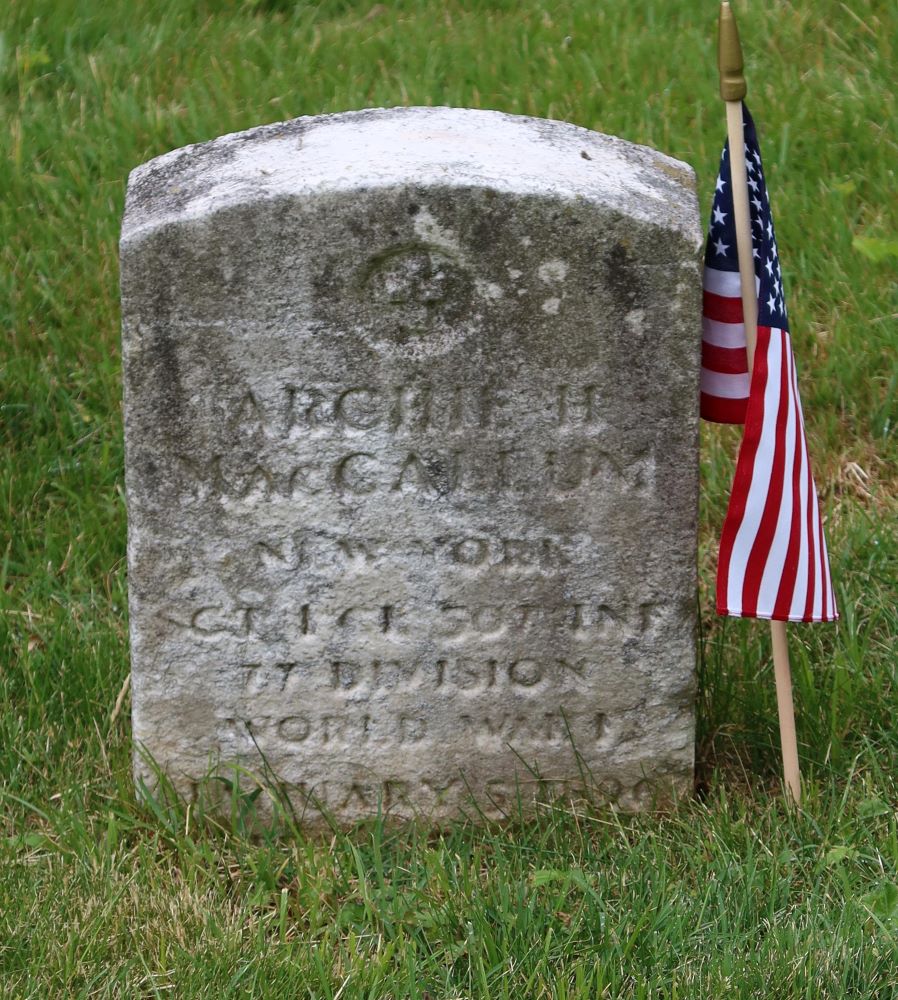
MARSHALL, HAROLD HOBAN (1895-1936). Seaman, United States Navy. Marshall was born in Hoboken, New Jersey, and had five siblings. The family moved to Boston, Massachusetts, by 1900 and, according to the 1910 census, lived at 231 Allston Street in Cambridge; Harold, 16, was an apprentice electrician. His Draft Registration Card of June 5, 1917, notes that he was living in Manhattan at 34 Morningside Avenue and working as a scale maker in New Rochelle, New York. On that form, he was described as of medium height and build with blue eyes and brown hair. Marshall claimed exemption based on unspecified work performed for the United States government. Nonetheless, he enlisted in the United States Navy on June 22, 1917, at New York City and remained home waiting for his orders. On August 1, he reported to Newport, Rhode Island, with the rank of apprentice seaman. He remained in Newport until September 5, was promoted to seaman second class, then reported to a receiving ship in Boston Harbor until November 21 during which time he was promoted to seaman. Subsequently, he was assigned to a receiving ship in Philadelphia just prior to going overseas on November 24 to Naval Base 18 at Iverness, Scotland. He sailed out of Iverness until the armistice was signed on November 11, 1918. On March 5, 1919, he was honorably discharged at a receiving ship in New York Harbor.
According to the 1930 census, Marshall was married one year, living with his wife on East 163rd Avenue in the Bronx, New York, did not own a radio set, was a veteran of the World War, and employed as a collector for an insurance company. He died in Manhattan. His last address was 1822 Bleecker Street in Ridgewood, Brooklyn. He died from nephritis. On February 18, 1937, Nelly Marshall, his widow, applied to the War Department for a government-issued headstone with Christian emblem, citing his Naval service as a seaman. Section 112, lot 14517.
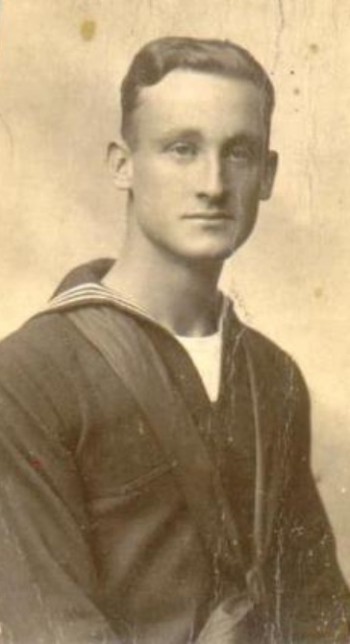
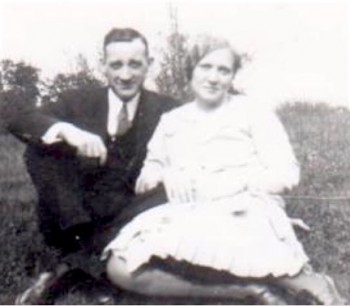
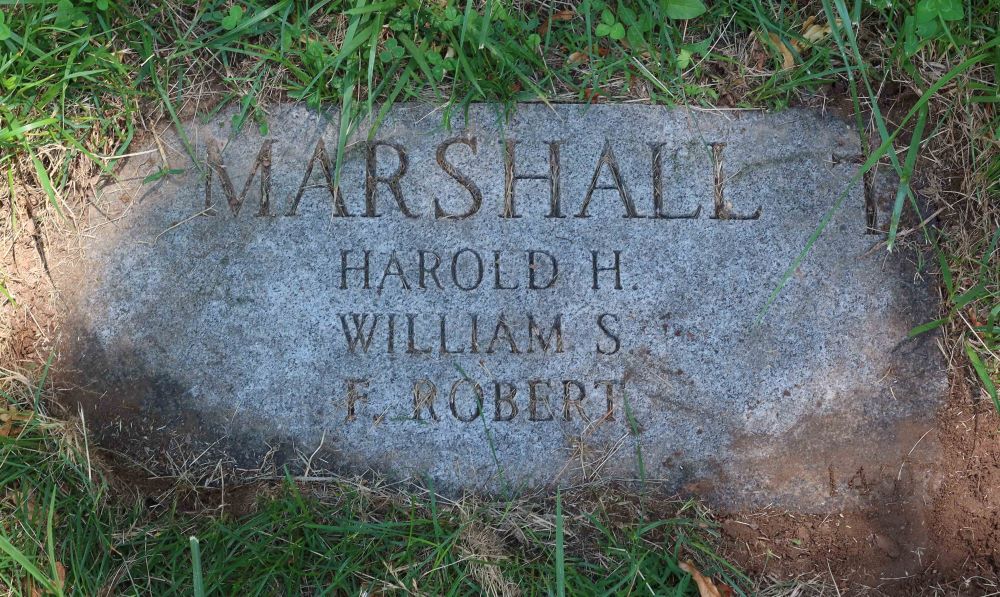
MARTELLA, AUSTIN BENEDICT (1894 or 1895-1955). Sergeant, United States Marine Corps. Although Martella’s birth record reports that he was born in 1895, his military record indicates 1894. Martella, a Brooklyn native, was a 1912 graduate of that borough’s Commercial High School. As per his New York Guard Service Card, he enlisted as a private in the 2nd Company of the Signal Corps on March 31, 1913, and was discharged on April 9, 1916. He lived in Brooklyn with his parents and sibling at the time of the 1915 New York State census. Martella served as a corporal with Company B the 1st Battalion Signal Corps, 1st Aero Company, during the Mexican Punitive Campaign. He re-enlisted at Brooklyn on April 10, 1916, and mustered in on July 3. As per his soldier record, he was single, lived at 379 East 7th Street in Brooklyn, and worked as a clerk; he was 5′ 7½” tall with blue eyes, brown hair, and a fair complexion. He was discharged with his company at Brooklyn on December 23, 1916, and officially discharged on May 18, 1917.
During World War I, Martella enlisted as a private on May 24, 1917, and mustered into the United States Marine Corps in June. He first served in Company K of the Recruit Depot at the Marine Barracks at the Navy Yard in Philadelphia, Pennsylvania. According to his military record, he was subsequently transferred to Virginia on July 26, 1917, returned to Philadelphia on August 13, was sent to Guantanamo on August 26, detached to Headquarters of the 7th Regiment on May 9, 1919, then to the 60th Company on May 26, and discharged on July 19, 1919, with a notation of “excellent character.” During his service, he was promoted to corporal on April 5, 1918, and again on January 14, 1919, and then to sergeant on April 1, 1919.
The 1920 census indicates that Martella was single, lived with his parents and sibling on East 7th Street in Brooklyn and worked as a buyer for a construction company. At the time of the 1930 census, he was married with two young children, and owned his house at 89 Hobart Avenue in Port Chester, New York, that was valued at $9,000. Martella noted that he had no radio set, worked as a salesman of building materials, and was a veteran of the World War. His World War II Registration Card, filed in 1942, notes that he still lived on Hobart Avenue in Port Chester and worked for Frank C. Mertz & Sons in that community. He died in Port Chester, New York. Shortly after his death, Florence Martella, his widow, requested a government-issued issued gravestone with a Christian emblem, citing her husband’s World War I service. Section 144, lot 25652.
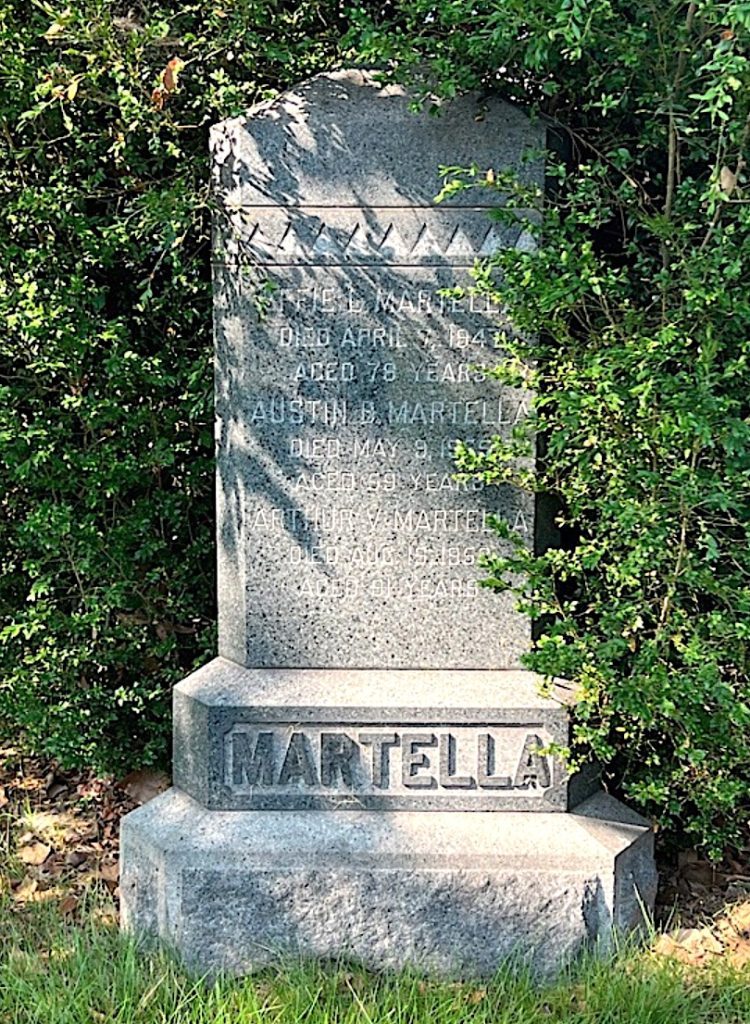
MATTSON, CHARLES WILLIAM (1898-1918). Sergeant, 106th Infantry, Company F, American Expeditionary Forces, United States Army; corporal, 14th Regiment, New York State National Guard, Company F. A Manhattanite by birth, Mattson enlisted on March 15, 1915, for three years, at the 14th Regiment Armory and mustered into the 14th on August 1, 1916, as a bugler. As per his abstract for the Mexican Punitive Campaign Muster Rolls, he was a bookkeeper by trade and was described as 5′ 7 ½” tall with a fair complexion, grey eyes and blond hair. He mustered out with his company on October 11, 1916.
During World War I, Mattson was promoted to private first class on June 22, 1917, to corporal on August 5, 1917, and was assigned to the 106th Infantry (a unit with strong support from the 14th Regiment) on October 15 of the same year. He was promoted to sergeant on March 7, 1918. Shortly afterward, on May 10, 1918, he went overseas. Mattson saw action at Viesstach Crosseny, Ypres in Belgium, Sallamont Farm and Malahoff Woods. He was killed in action by a gunshot wound on September 27, 1918, when his unit was engaged in the effort to dislodge the Germans from the Hindenburg Line, the German defensive position along their Western Front. His last address was 441 42nd Street, Brooklyn. His father, Charles Mattson, was notified of his death. On April 21, 1921, he was re-interred after his remains were returned to the United States. Section 124, lot 35309, grave 2.
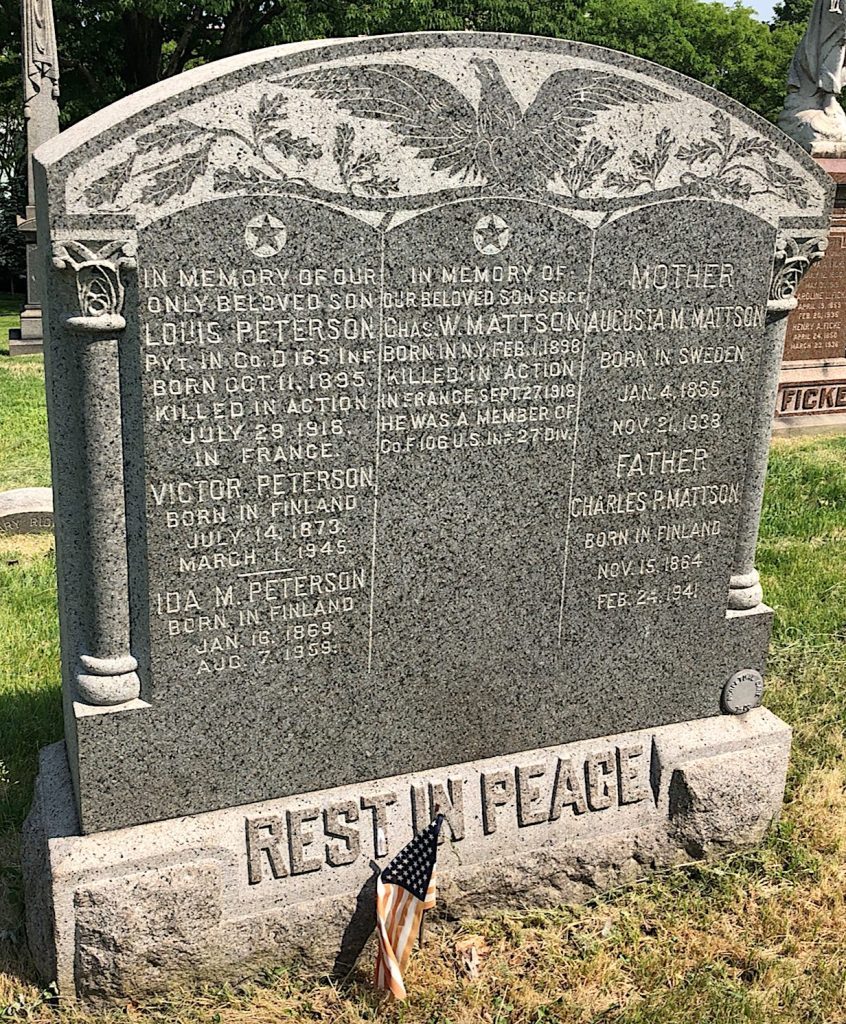
McCANN, ROBERT JOSEPH (1892-1949). Corporal, 305th Infantry, Company M, American Expeditionary Forces, United States Army. McCann was born in Brooklyn. As per his Draft Registration Card of June 5, 1917, he was living at 26 Debevoise Place in Brooklyn. He was described as tall with a medium build, blue eyes and dark hair and was working as a utility man for National City Bank at 350 Fulton Street. On December 5, 1917, he was inducted into the United States Army at Local Board 24 in Brooklyn. After training at Camp Upton in Yaphank, Long Island, he mustered into Company M of the 305th Infantry which was assigned to the 77th Infantry Division. McCann went overseas on April 16, 1918, and he was promoted to the rank of corporal on May 14. The 77th Infantry Division participated in the Battle of Chateau Thierry in July 1918. On August 16, he was slightly wounded in action and was awarded a purple heart. He returned to the United States on April 24, 1919, and was honorably discharged on May 9.
According to the census of 1920, McCann lived with his parents and worked as an electrician for the Edison Company. The 1930 census reports that he was single, lived with his mother and brother at 448 Hudson Avenue in Brooklyn, and was a veteran of the World War; he was still employed by the Edison Company. In 1942 he was living in Huntington, Long Island, and, in 1947, had moved to Brooklyn, where he last lived at 666 Ocean Avenue. On February 21, 1950, his sister, Alice Mc Cann, of 666 Ocean Avenue in Brooklyn, applied for a government-issued headstone with Christian emblem, citing Robert Mc Cann’s service in the 305th Infantry. Section 134, lot 37830.
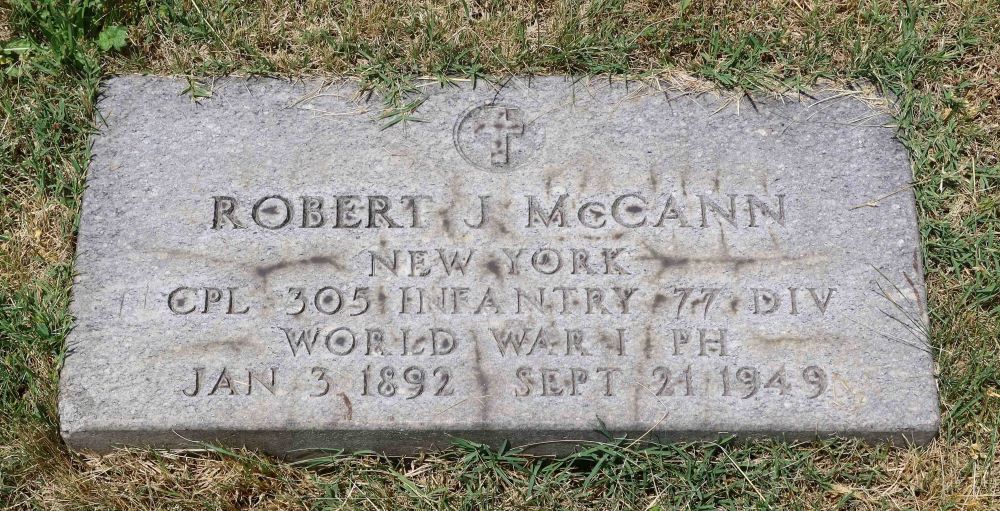
McCREERY (or MCREERY), FRANK PLATT (or PLANT) (1894-1918). First lieutenant, 19th Aero Squadron, Signal Corps, American Expeditionary Forces, United States Army Air Service. Frank was born in Flushing, Queens, to Samuel and Caroline (née Platt) McCreery. As per his biography on the Find A Grave website, his family was prominent in Flushing. The 1900 census, which records the family surname as Mccruary, notes that 6-year-old Frank was living at 448 Broadway in Queens with his parents and older brothers, Edward, age 17, and John, age 15. At the time of the 1905 New York state census, Frank Mccreary (sic) was living with his parents in Greenburgh in Westchester County. The 1910 census shows that the family was now living on West 80th Street in Manhattan. His obituary indicates that he was educated at the Princeton Preparatory School before entering Dartmouth College. His obituary notes that Frank left Dartmouth in his junior year and became a car salesman; he was employed by Chevrolet when he enlisted.
McCreery’s Enlistment Card shows that he lived in Port Washington, Long Island, and enlisted as a sergeant in the Signal Enlisted Reserve Corps at New York City on April 27, 1917. He was discharged on September 3, 1917, to accept a commission. His Abstract of World War I Military Service incorrectly records his middle name as Plant, rather than Platt. That document notes that he was called into active service as a first lieutenant in the Air Squadron Signal Corps on September 4, 1917, and trained in Fairfield and Dayton, Ohio (Wilbur Wright Field), and at Garden City, New York. He served in no active engagements and received no wounds in action. His overseas service was as of December 4, 1917 until his death.
As per the manifest of the USS Northland, Frank was a first lieutenant in the 19th Air squadron. He departed on that transport ship on December 4, 1917, from Philadelphia bound for France. At that time, his home address was 24 North Washington Street in Port Washington, Long Island, and his mother was listed as his next of kin. As per the Veterans Administration Master Index, 1917-1940, Frank Plant McCreery was a resident of Edgewood, Rhode Island, during his service.
He died on May 11, 1918, in a plane accident in France where he was testing aircraft. Another aircraft went off-course, swerved into his plane at 7,000 feet, causing Frank to fall to his death. One of his obituaries, headlined, “Long Island Aviator Killed in France,” reported that Frank wrote to his parents shortly before his death, “I’m tired of being behind the lines. I’d give anything for an assignment to a bombing ‘plane for service over the Hun lines.” That article and another in the New York Tribune note that Frank’s brother Edward said that his brother was upset that he was detailed to testing French planes which were turned over to the American service. Edward stated that Frank quickly mastered aviation and that after the 19th Squadron left for active service upon its arrival in France, Frank, who was placed in command of a flying company, was transferred to testing the planes. Although Edward did not serve in the World War, Frank’s other brother, John, was a machinist’s mate, second class, in the United States Navy.
The Brooklyn Daily Eagle reported on his death in an article on May 1, 1918, naming the five Brooklyn and Long Island men who either died or were injured in the World War; McCreery was listed as an accidental death. That article noted that Frank was an expert mechanic whose job was assembling airplanes, work he had done in England and France. It also mentioned that Frank’s grandfather, Samuel McCreery Sr., had six grandsons, five of whom had served their nation. Frank’s death in service was also announced in the New York Herald on June 1, 1918.
At the time of his death, the family lived in Port Washington, New York. A cenotaph honoring his memory is at Green-Wood. Other memorials honoring him are at Saint Mihiel American Cemetery at Thiaucourt-Regnieville, Departement de Meurthe-et-Moselle in Lorraine, France, where he was buried, Cemetery Plot A, Row 14, Grave 34; he is identified as a member of the Signal Corps in that cemetery.
On July 10, 1918, the town of Port Washington announced that a bronze memorial tablet would be erected to honor McCreery. On December 11, 1918, the Times Union reported on the unveiling of the memorial in Port Washington the day before. The ceremony included an address by the Reverend George C. Groves about McCreery’s life and character which was followed by the reading of several letters written by his men in the Aviation Corps attesting to the esteem in which he was held. A plane from Hazlehurst Field No. 2 flew over the crowd and a large bouquet of chrysanthemums was dropped by the aviators. The service concluded with the singing of “The Star-Spangled Banner.” Section 54, lot 7432.
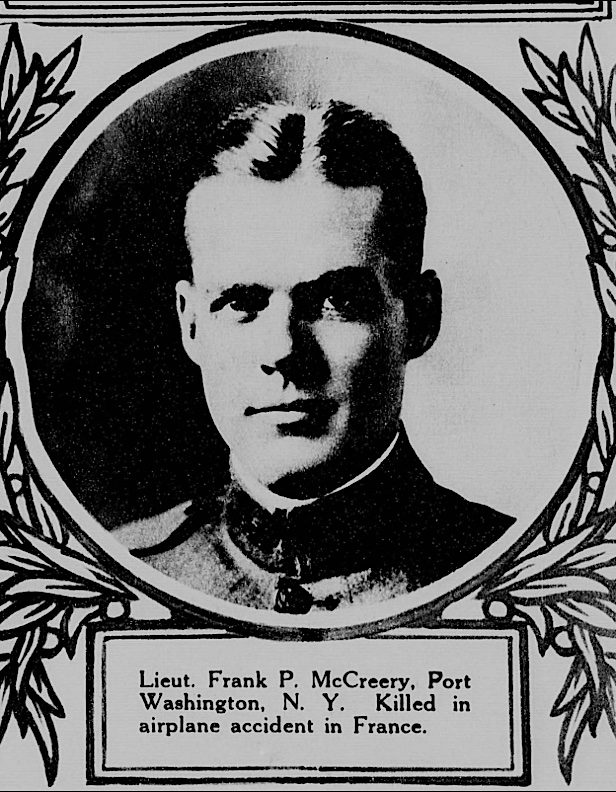
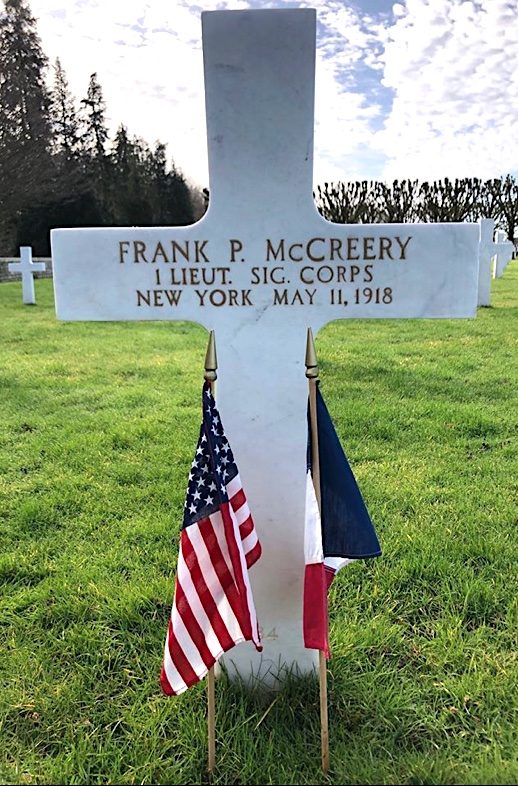

McDONALD, JR., AUSTIN JEROME (1893-1918). Corporal, 107th Infantry, American Expeditionary Forces, United States Army; private first class, 7th Regiment, New York State National Guard. Born in Manhattan, McDonald’s family lived on West 149th Street according to the 1910 census. On May 11, 1917, he enlisted in the 7th Regiment of the New York State National Guard and was promoted to private first class on June 19. On October 1 of that year he joined the 107th Infantry (a unit that had its roots in the 7th Regiment) and went overseas on May 10, 1918. On June 16, 1918, he was promoted to corporal and was killed in action on September 29, 1918, in a battle at the Hindenburg Line in Belgium, a heavily fortified German defense system. As per his New York State Abstract of National Guard Service in World War I, he also fought at Dickebusch in Belgium. His father, Austin J. McDonald, who lived with him at 150 West 91st Street in Manhattan, was notified of his death. Subsequently, when his remains were returned to the United States, he was re-interred on April 14, 1921. Section 129, lot 35269, grave 2.
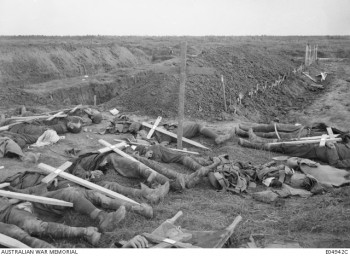

McDOUGALL, HOWARD H. (1895–1918). Sergeant, 106th Infantry, Company I, 27th Division, 53rd Brigade, American Expeditionary Forces, United States Army; corporal, 23rd New York State National Guard. Born on Jamaica Avenue on Long Island, McDougall joined the 23rd Infantry of the New York State National Guard in Brooklyn on January 24, 1916, as a private. On July 4, 1917, he was promoted to private first class and to corporal on May 2, 1918, just prior to shipping out to France on May 10. In the interim, the 23rd Infantry of the New York State National Guard was federalized as the 106th Infantry of the 27th Division. On July 25, 1918, the 27th was rotated to the front in relief of the British 6th Division. McDougall was promoted to sergeant on September 18. The 106th Infantry, along with the rest of the 27th Division, participated in the offensive of September 24–October 21, 1918, that breached the Hindenburg Line, a German defensive position along their Western Front. On October 1, 1918, Sergeant McDougall died of wounds sustained in action. His last residence was 1327 8th Avenue, Jamaica, Long Island. After his remains were returned to the United States, he was re-interred on April 10, 1921. Section 74, lot 11645.
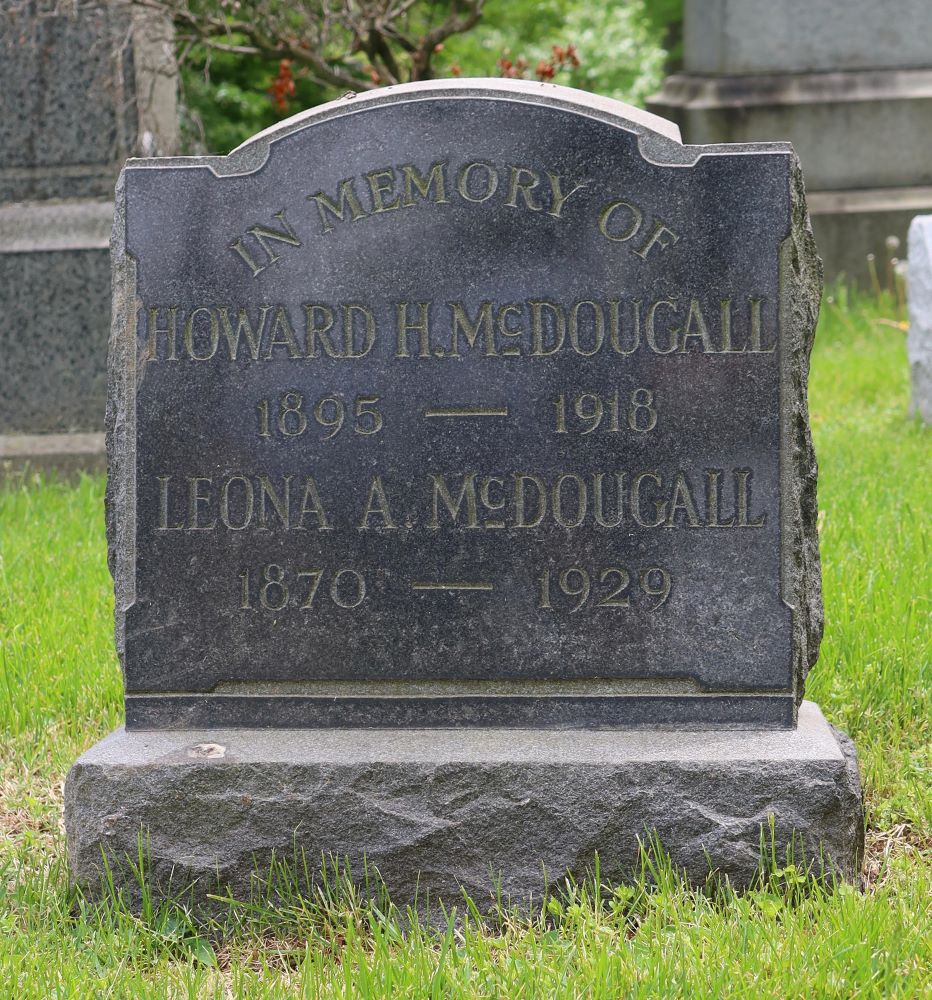
McELVERY, GEORGE ROWLEE (1895-1963). Private first class, 306th Infantry Regiment, 77th Infantry Division; 326th Infantry Regiment, Company D, 82nd Division, American Expeditionary Forces, United States Army. A Brooklynite by birth, McElvery was a high school graduate. On June 5, 1917, when he was 21 years old and living at 233 New York Avenue in Brooklyn, he registered for the draft. At the time, he was an instrument installer for the New York Telephone Company located in Brooklyn. On his Draft Registration Card, McElvery described himself as single, tall, of medium build with blue eyes and brown hair. On his application, he indicated that he may be exempt from a draft due to his work in the telephone service. However, he was inducted into the United States Army on September 23, 1917, assigned to the Supply Company of the 306th Infantry Regiment training at Camp Upton in Yaphank, Long Island, until June 17, 1918. He then was assigned to Company D of the 326th Infantry, which was incorporated into the 82nd Infantry on April 19, 1918, the same day that McElvery was promoted to private first class. The 82nd was made up of soldiers from every state in the union and became known as the “All American Division.”
Along with his unit, McElvery departed New York Harbor on April 29 aboard the troop ship Mauretania, heading for Europe. Upon their arrival at the French port of Le Havre, they were sent to the front lines, participating in action at the Marbache Defense Sector and the Saint-Mihiel Offensive. After the armistice on November 11, 1918, McElvery remained in France on occupation duty. On January 24, 1919, he sailed out of Brest, France, aboard the Vermont arriving in Newport News, Virginia. He was honorably discharged from the Army on March 11, 1919. As per his New York State Abstract of World War I Military Service, he was not wounded in the hostilities.
McElvery married Mildred A. Smith on August 14, 1922. According to the 1930 census, they were living at their own home, valued at $8,000, located at 1654 East 31st Street in Brooklyn and had two young sons; that census noted that he was a World War veteran. He had returned to his old job as an installer at the New York Telephone Company, located at 1101 Avenue R in Brooklyn. The census of 1940 notes that the family still lived at their home in Brooklyn, that he worked for the telephone company as a repairman, and he had earned $2,500 in 1939. His World War II Draft Registration Card from 1942 shows that he still lived at the same address, worked for the New York Telephone Company and had a home telephone. Section 12, lot 8339.
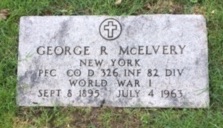
McGRATH, LAURA O. (1889-1918). Nurse, Army Reserve Nurse Corps. Born in Jersey City, New Jersey, McGrath moved with her family to Massachusetts when she was 21 years old and single. In her obituary of October 4, 1918, The Chicago Tribune reported that McGrath was a graduate nurse at the Methodist Episcopal Hospital in Brooklyn, New York, and died of pneumonia on October 3 while fighting the influenza epidemic at Camp Grant in Winnebago, Illinois. Camp Grant was established in July 1918, to serve as a training camp for the 86th Division. Her last residence was in East Northfield, Massachusetts. Section 147, lot 22297.
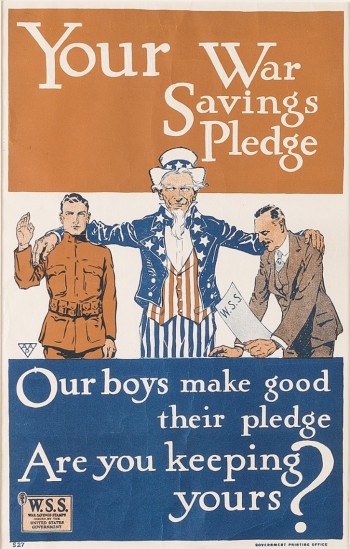
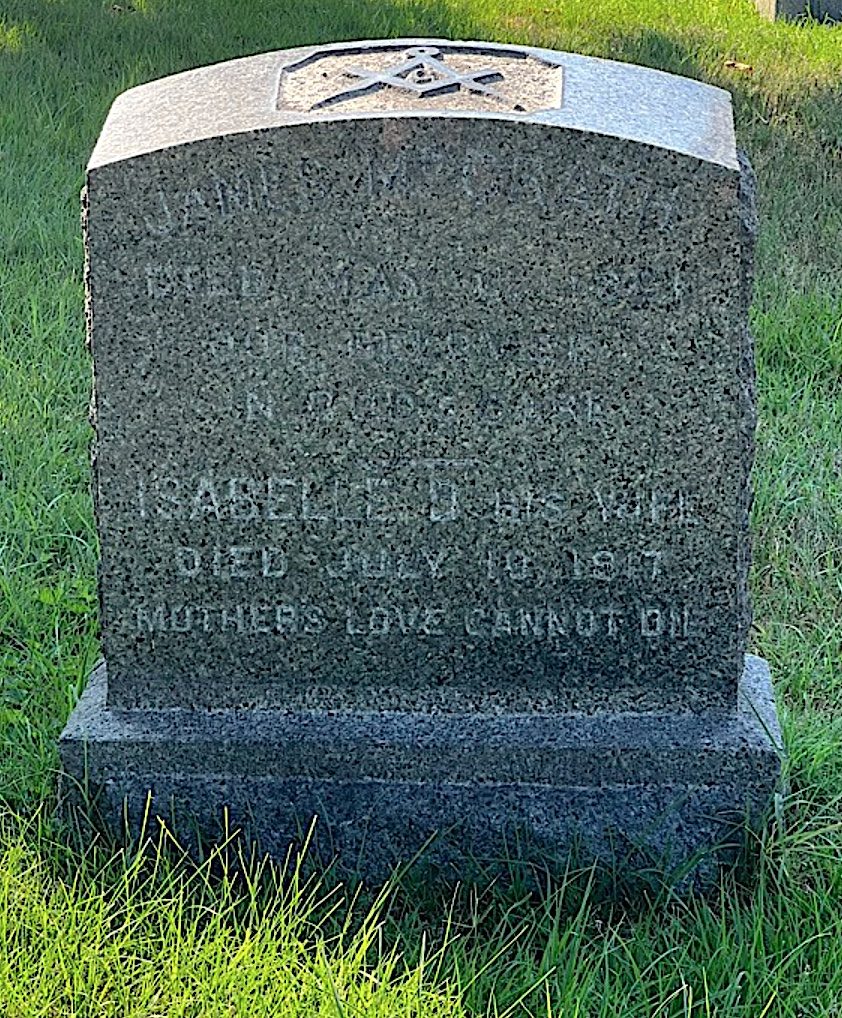
McINTIRE, MEYLERT ARMSTRONG (1896-1979). Yeoman first class, United States Navy. Born in Indianapolis, Indiana, the 1910 census indicates that McIntire’s family had moved from Philadelphia, Pennsylvania, where they lived in 1900, to Brooklyn. He joined the United States Naval Reserve on June 5, 1918, but there is no further military information available. His Draft Registration Card on that date reports that he was tall, of medium build, with blue eyes and light brown hair.
McIntire’s engagement to Dorothy McConnell was announced in the newspaper on December 20, 1919. The 1920 census reports that he lived at 1127 Avenue G (later called Glenwood Road) in Brooklyn, was single and worked as a clerk. After his marriage and the birth of a daughter, the family resided at 1127 Glenwood Road in Brooklyn. As per his Draft Registration for World War II, he worked for Radio Station WHN located at 1540 Broadway in Manhattan and still lived at 1127 Glenwood Road. He last lived in Cutchogue, Suffolk County. Section 206, lot 34468.
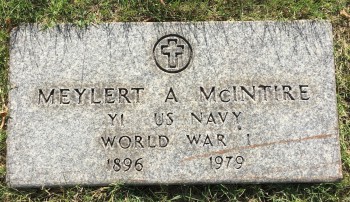
MEADOWS, ALBERT CLARENCE (1892-1938). Sergeant, Ordnance Corps; corporal, 326th Battalion-Tank C, Company A, 327th Battalion-Tank C, Company B; 326th Transportation Corps, Company B, United States Army; private, 1st Cavalry, Company L, New York State National Guard. Meadows was a native of Brooklyn. The New York City Directory for 1913 shows him as married, living in Brooklyn, and working as a conductor. He was a machinist when he enlisted in the New York State National Guard on June 19, 1916. His muster roll for the Mexican Punitive Campaign shows that he stood 5′ 10¾” tall with dark complexion, grey eyes, and black hair. In addition, the muster roll indicates that he had prior service in the 15th U.S. Cavalry from December 18, 1907 to December 19, 1910. Upon his enlistment, he became a private in Troop L of the 1st Cavalry and was sent to McAllen, Texas, from which he was discharged on July 29, 1916, as per Special Order 191 that was issued by the Southern Department Headquarters.
On February 19, 1918, Meadows enlisted in the Army at Fort Slocum, New York. His Word War I Military Abstract shows that he was initially assigned to Company A of the 326th Tank Battalion-Tank C until April 10, 1918, at which time he was transferred to Company B of the 327th Tank Battalion-Tank C. He was promoted to corporal on June 1, 1918, but reduced to private on June 21 just before he was re-assigned to the Ordnance Corps the next day. The Ordnance Corps was charged with the responsibility of supplying the Army with arms, equipment and ammunition and providing for the maintenance of arsenals and safe-keeping of ordnance; Sandy Hook was the testing ground from 1874-1919. Notations on his government headstone application indicate that the Ordnance Corps was located at the Sandy Hook Proving Grounds, New Jersey, and that he was a corporal in Company B of the 326th Transportation Corps. He was promoted to corporal on August 23, 1918, and to sergeant just before his honorable discharge on December 17, 1918. His last residence was 1731 East 35th Street in Brooklyn. On June 6, 1938, about six weeks after his death, Augusta Meadows, his widow, applied to the War Department for a government-issued headstone, citing her husband’s service in the 326th Transportation Corps in the Ordnance Detachment. Section 116, lot 15615, grave 342.
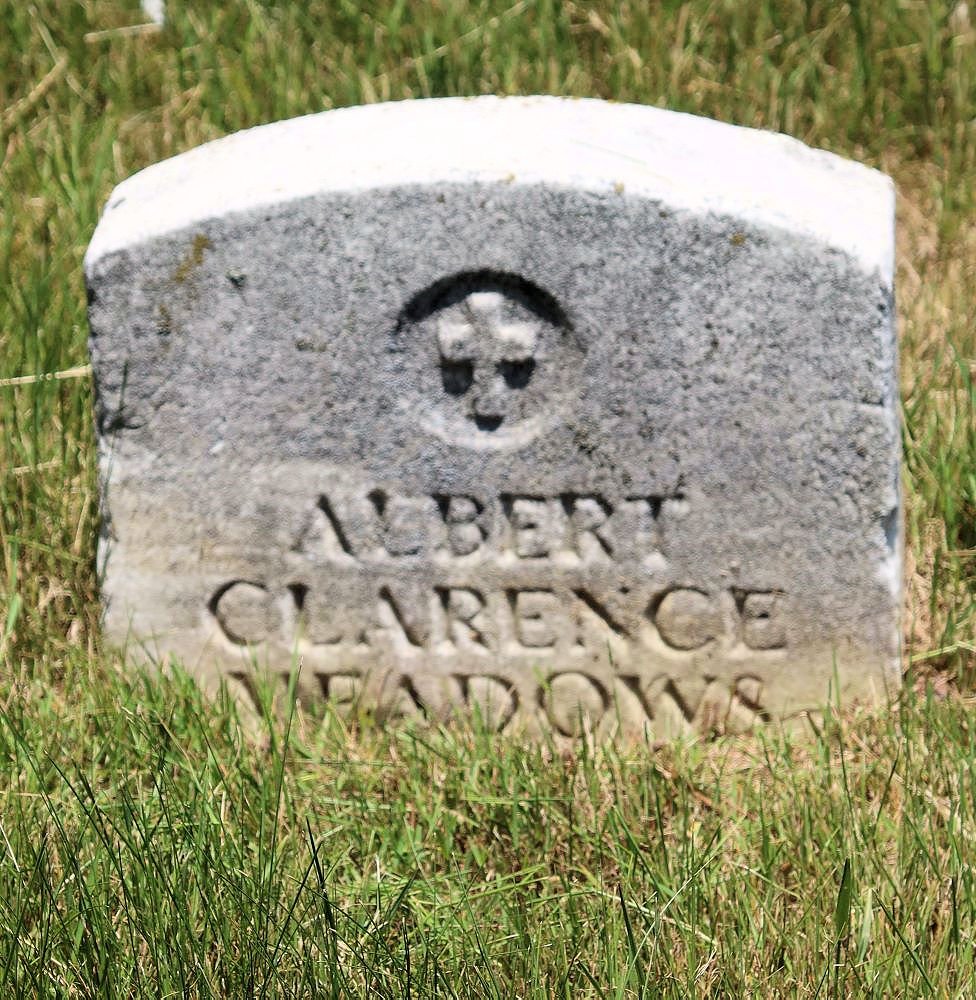
MEEKER, AMHERST WIGHT (1896-1918). Private first class, United States Ambulance Service, Sections 595 and 618; 107th Infantry, Company L, American Expeditionary Forces, United States Army. A Brooklyn native, Meeker lived in Hempstead, Long Island, at the time of the census of 1900; the family moved to Brooklyn as per the 1910 census. He completed his draft forms while still a student at Williams College in Williamstown, Massachusetts, on May 29, 1917. His Draft Registration Card notes that he was of medium build with grey eyes and brown hair. He claimed an exemption from the draft based on his service in the Medical Enlisted Reserve Corps. However, on June 7, 1917, he was drafted and assigned to Section 595, U.S. Army Ambulance Service. On February 28, 1918, he was moved to Section 618, U.S. Ambulance Service. Subsequently, on April 21, 1918, he was attached to Company L of the 107th Infantry (formerly the 7th New York State National Guard). Meeker was sent overseas to France with the 107th Infantry on May 7. Andrew R. Todd, a sergeant in Company L, wrote in his journal (original grammar and usage):
We arrived in France on Friday, May 25th at a place called Brest. We stayed in Brest for 2 days and on Sunday morning of the 26th we got on a train road for 2 days and landed in a place called Noyelles. We stayed there one day and left and walked to a town called Favieres. We got here 28 May and left on Monday June 17 we walked 22 miles and left there on June 20 for the front. In Noyelles we were greeted the first night with a few bombs.
The 107th was involved in the action at the Ypres Salient in Belgium and in the attacks on the German strong points at Mount Kemmel. After driving the Germans back, the 107th moved to the St. Quentin Canal tunnel along the Hindenburg Line on September 25. On September 28, 1918, Meeker was mortally wounded there; he died the next day. His father, Samuel Meeker, who lived with him at 1365 Dean Street in Brooklyn, was notified of his death. After a temporary burial in France, his remains were returned to the United States and he was re-interred on October 12, 1921. Section 204, lot 33795.
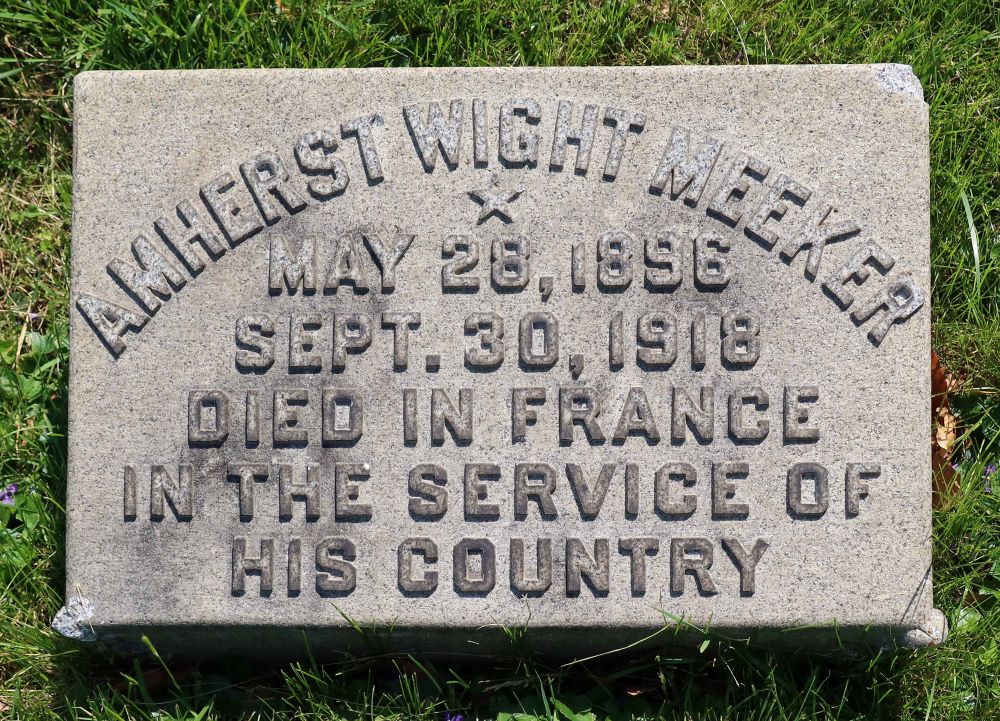
MEHRER, HARRY EVERETT (1873-1945). Second lieutenant, Quartermaster Corps, United States Army. Mehrer was born in Ellenville, New York. As per the application for his government-issued headstone, he accepted a commission as second lieutenant in the Quartermaster Corps on April 25, 1918; he lived at 8124 13th Avenue in Brooklyn when he entered service. The Quartermaster Corps is a logistics branch dedicated to sustaining the general supply of subsistence to provide combat power to the United States Army during peace and war. His soldier record shows that he was stationed in Hoboken, New Jersey, and at Brooklyn, did not serve overseas and was not wounded. He was honorably discharged on October 27, 1919.
The 1920 census shows that Mehrer still lived at 8124 13th Avenue in Brooklyn where he had a mortgage on his house, was married, and worked as a broker for an exporter. As per the 1925 New York State census, he still lived in Brooklyn and was a sales manager. According to his obituary in the Brooklyn Daily Eagle, Mehrer was a liquor salesman for the wholesale division of McKesson & Robbins Co. He was a member of the Newburgh, New York, Elks and American Legion. He died in the Bronx but last lived at 6735 Ridge Boulevard in Brooklyn. His funeral took place at the Schaefer Chapel on Fourth Avenue in Brooklyn. On October 4, 1945, Iantha Mehrer applied for a government-issued headstone, citing her husband’s service in the Quartermaster Corps. Section 102, lot 22554.
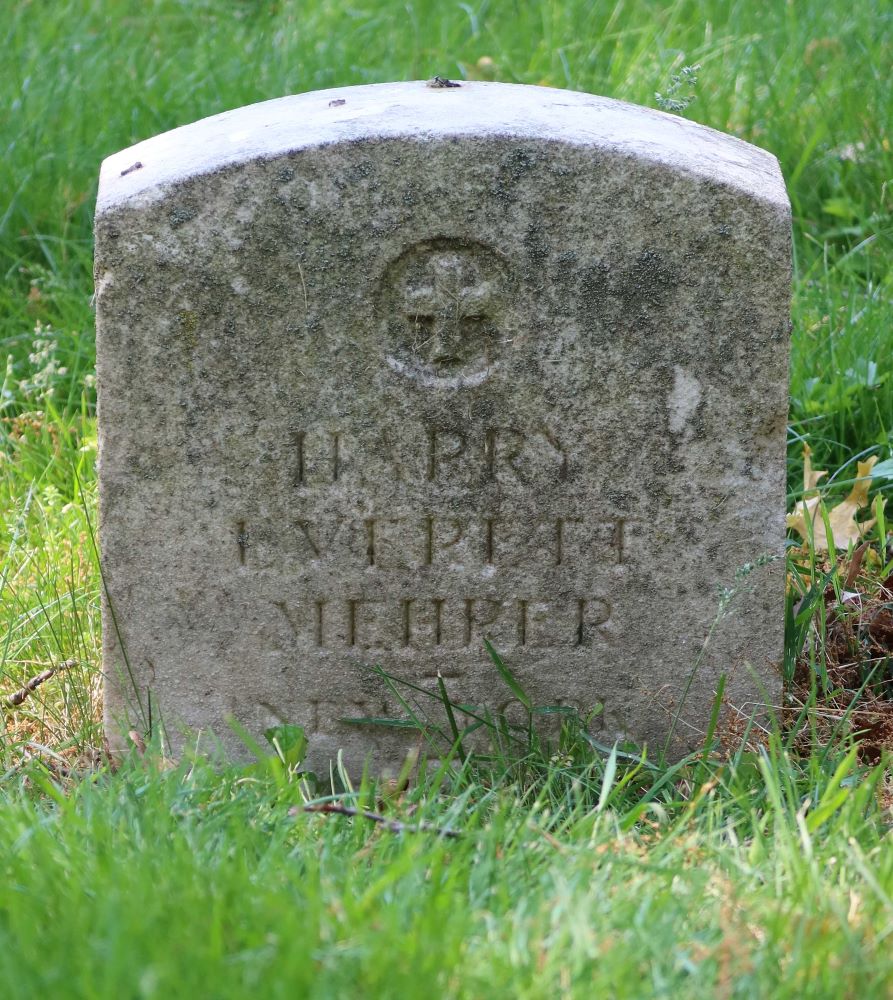
MELIUS (or MEILIUS), ESLEY VAN CLEVE (1893-1955). Corporal, 303rd Supply Train Company D; 312th Infantry, Company G, American Expeditionary Forces, United States Army. Born in Newark, New Jersey on February 11, 1893, Esley V.C. Melius was baptized on May 16, 1897, at St. John’s Church, also in Newark. According to Episcopal Diocese baptismal records, his father was Theodore Melius and his mother was Ida Van Cleve Melius. His mother’s obituary, in the March 5, 1951 Herald-News, notes that she was born in Irvington, New Jersey, and that her father, John Van Cleve, had been mayor of that town. Theodore Melius was an engineer and bridge builder, and the family was Episcopalian. The 1900 United States federal census shows Esley, at 7 years of age, living with his family – the family name was spelled “Meilius” in that census – at 10 Riverside Avenue in Newark. Other household members included Sarah A. Meilius, age 80; Theodore Meilius, age 47 and born in New York; Ida Meilius, age 39 and born in New Jersey; and Gertrude Baekack, age 22. Young Esley could speak, read, and write English.
At the time of the 1910 federal census, the family was still living on Riverside Avenue in Newark. Esley, at 17, was in school, and he and his parents were the only residents in the household. The New Jersey State census of 1915 shows the family living at 152 Riverside Avenue in Newark. Esley was working as a clerk and living with his mother, Ida. Theodore Melius died in 1911, according to Ida’s aforementioned obituary in The Herald-News.
Esley’s World War I draft registration card, signed on June 4, 1917, lists him as a single, natural-born citizen, not working due to ill health, and claiming exemption from the draft due to illness. He is described as tall, of medium build, with blue eyes, dark brown hair, and not bald. In spite of claiming a military exemption, United States Army Transport Service Arriving and Departing Passenger Lists, 1910-1939, show Esley as a corporal, departing Philadelphia, Pennsylvania on May 27, 1918, on the S.S. Mesaba, as part of Company D, 303rd Supply Train. He held the rank of private when he departed Brest, France on March 27, 1919, arriving in Hoboken, New Jersey on the S.S. Pueblo. The second document shows him married to Anna (likely Alma) Melius, age 24. His November 14, 1955 obituary in The Herald-News notes his service with Company G, 312th Infantry, in France.
The Marriage Index for New Jersey, 1901-2016, shows that Esley Melius married Alma E. Dickert in 1918 in New Jersey, while the 1920 federal census lists his spouse as Alma and the couple living on Riverside Avenue in Newark with Esley’s mother, Ida. Esley’s occupation is shown as an assembler in an electric factory and he is 26. In the 1928 Orange, New Jersey City Directory, Esley was listed as still working in the electrical industry but was living at 260 Union Avenue in Orange, New Jersey. By the 1940 federal census he had moved to a rented home at 883 Main Avenue in Clifton, Passaic, New Jersey, for which the monthly rental was $16. Esley, age 47, had completed four years of college and was a mechanical engineer in private industry, working 34 weeks in 1939 for $1,400. He was married and living with Louella Melius, age 34. It appears that his first wife Alma E. Melius passed away in 1925, according to Green-Wood’s records. She is interred with other Melius family members in Green-Wood. He then met and married Louella May Pommert in 1935, when both were involved with the Federal Theater Project. Esley was manager, according to Louella’s January 10, 1987 Marion Star obituary. Per the Marion Star and the Find A Grave website, she was born in Caledonia, Ohio, on August 27, 1905, to Charles and Cora Blue Pommert. She was a graduate of the Conservatory of Music at the University of Cincinnati.
Esley’s World War II draft registration card lists his address as 193 Hoffman Boulevard, East Orange, New Jersey. He was living with his wife, Mrs. Louella Melius, and worked at Eclipse Aviation Corporation, 545 North Arlington Avenue, East Orange, New Jersey.
In Esley’s mother’s obituary in the Herald-News, dated March 5, 1951, it was reported that he was a retired mechanical engineer at the time of her death, living in Rutherford, New Jersey, with one child and two grandchildren. The Herald-News reported that Esley died on November 12, 1955, in the Kingsbridge Veterans’ Hospital in New York City, after a long illness. At the time of his death, he was living at 208 Mortimer Avenue in Rutherford, New Jersey, having moved to that town nine years before. He was a mechanical engineer at the East Orange plant of Bendix Aviation Corporation, and a member of the VFW Post, American Legion, of Passaic and the Disabled American Veterans of Newark. His wife, listed as the former Louella Pommert, and his daughter, Mrs. Walter L. (Alma) Riter, of Long Beach, California, survived him. He had three grandchildren.
Louella May Melius’s obituary in The Marion Star states that she died on January 9, 1987, in Marion, Ohio. She was interred at New Caledonia Cemetery in Caledonia, Ohio. However, in addition to Esley Melius and his first wife, Alma, other Melius family members are interred in Green-Wood, including Esley’s parents. Section 74, lot 10574, Vault.
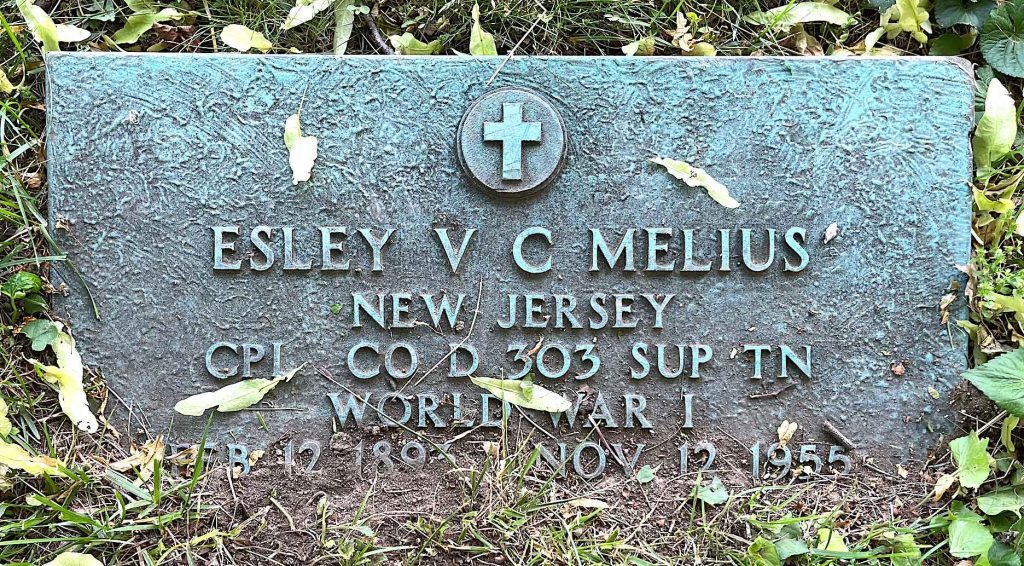
MEYER (or MYER), CLEMENS (or CLARENCE) ALEXANDER (1887-1940). Private first class, 180th Infantry, Machine Gun Company, American Expeditionary Forces, United States Army; private, 152nd Depot Brigade. A Brooklyn native, Meyer was living there with his parents and two brothers at the time of the 1900 census; his first name is incorrectly listed as Clarence on that document. At the time of the 1915 census, he was single, living with his parents and employed as a bank clerk. On April 2, 1918, Meyer was inducted into the Army and served in the 152nd Depot Brigade until April 21, when he was re-assigned to the 180th Infantry’s Machine Gun Company. Depot Brigades were organized to receive recruits, outfit them, assign them, and train them before shipping them out to France. According to the application for a government-issued headstone, his unit was assigned to the 27th Division. Meyer shipped out to France on May 10, 1918, was promoted to private first class on September 21, and returned home on March 6, 1919. He received his honorable discharge on March 31, 1919.
The 1920 census indicates that Meyer was living with his parents on Third Avenue in Brooklyn and was employed as a bookkeeper in the banking business. The 1930 census lists Meyer as married, living at 1087 Sterling Place in Brooklyn with his wife and two young daughters, and being employed as a bank clerk. That census notes that he owned his home that was valued at $12,000, had a radio set, and was a World War veteran. The 1940 census, which spelled his surname “Myers,” indicates that he still lived on Sterling Place, was widowed, had completed 8th grade, and worked as a clerk whose earnings for 1939 were $2,200. On April 20, 1942, Charlotte C. Torrens, his sister-in-law, applied for a government-issued headstone for Meyer, citing his service in the World War. (Service on application was incorrectly listed as 108th Infantry Machine Gun Company in contrast with the Military Abstract which lists 180th Infantry, Machine Gun Company.) Section 132, lot 33454, grave 1.
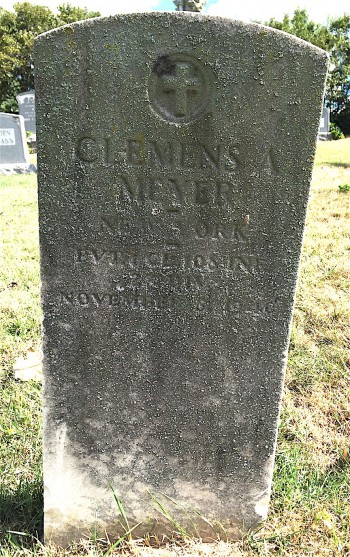
MEYERS, HENRY ALOYSIUS (1893-1979). Private, 152nd Depot Brigade, 1st Ordnance Department, American Expeditionary Forces, United States Army. Meyers was born in Brooklyn. The 1900 census reports that he was living at 630 President Street in Brooklyn with his parents and four siblings. On June 5, 1917, he filed his Draft Registration Card in Brooklyn. He noted that he was an insurance inspector for W. S. Fidelity and Guaranty Company at Grand Central Station in Manhattan, was single and had never served in the military. He described himself as tall, slender with brown eyes and hair. At that time, he lived at 217 West Street in Brooklyn.
As per his New York State Abstract of World War I Military Service, Meyers was inducted into the United States Army on June 24, 1918 at Brooklyn and was assigned to the 152nd Depot Brigade until August 26, 1918. He was then transferred to the Ordnance Department until his discharge. That document notes that he served overseas from October 6, 1918 until August 30, 1919. As per the manifest of the ship Cedric, Henry A. Meyers sailed overseas from New York City on October 6, 1918. He still lived at 217 West Street in Flatbush, Brooklyn, and listed his mother as next of kin. As per his great-nephew, Charles A. Gili, he served in France and was awarded the Victory Medal. That descendant notes that the ship that Henry was aboard while sailing the English Channel en route to France was struck by enemy fire and sunk; Meyers survived that attack and continued to the front. On August 19, 1919, he left Brest, France, aboard the USS Iowan and arrived in Brooklyn on August 30; he was listed as a private in Ordnance Company #78.He was honorably discharged on September 5, 1919, with 0% disability.
Meyers married Elvera (Elvira) Westerberg on May 7, 1928 in Brooklyn and their marriage is recorded by the Evangelical Lutheran Church; the couple had no children. According to the 1930 census, Meyers had married at age 34. That census reports that he was living with his wife on 72nd Street in Brooklyn in the Yale Franklyn Apartments, had a radio set, was working as an inspector and was a veteran of the World War. The 1940 census indicates that he was living with his wife at 1026 71st Street in Brooklyn and working as an investigator on his own account. Meyers reported that he had completed eighth grade and had earned $3,500 in 1939.
In 1942, Meyers filed his World War II Draft Registration Card. He was 48 years old, living at 475 9th Street in Brooklyn, had a home telephone and was employed by Connolly’s Union Printery at 152 East 121st Street in Manhattan. He listed his sister Agnes as his contact person. As per his relative, he also worked for the New York Insurance Company as an investigator. Meyers last lived in Brooklyn. Section 112, lot 38513, grave 2.


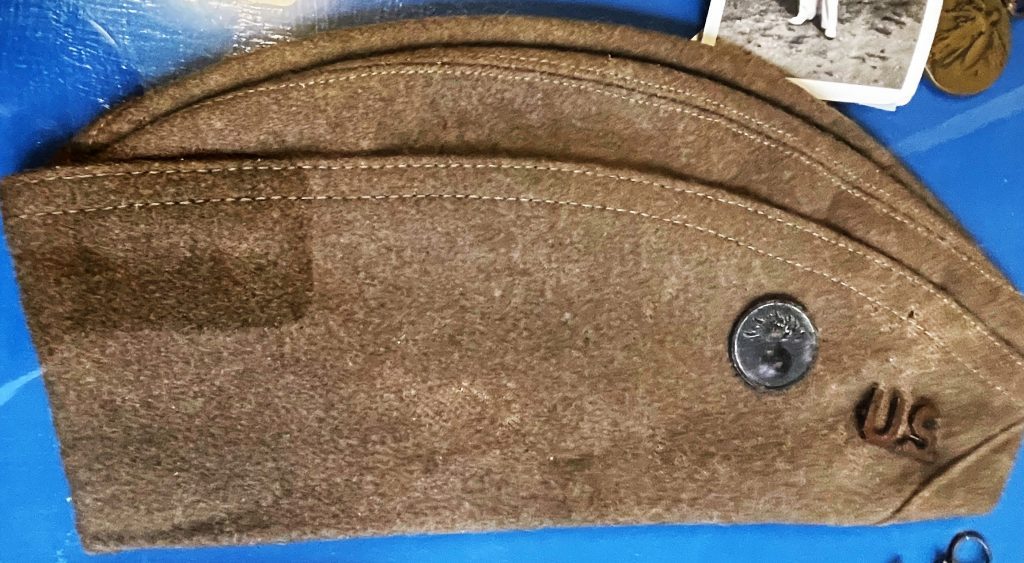
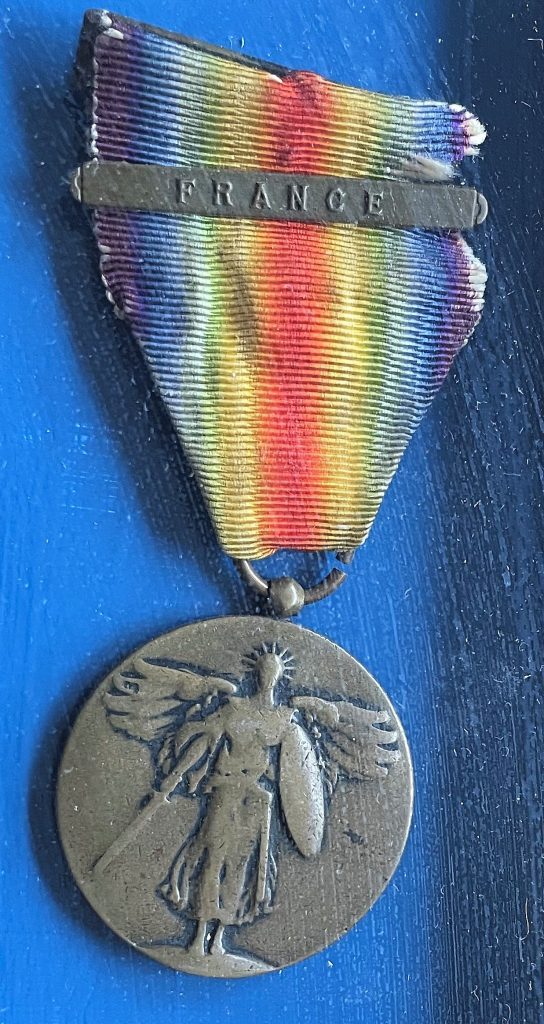
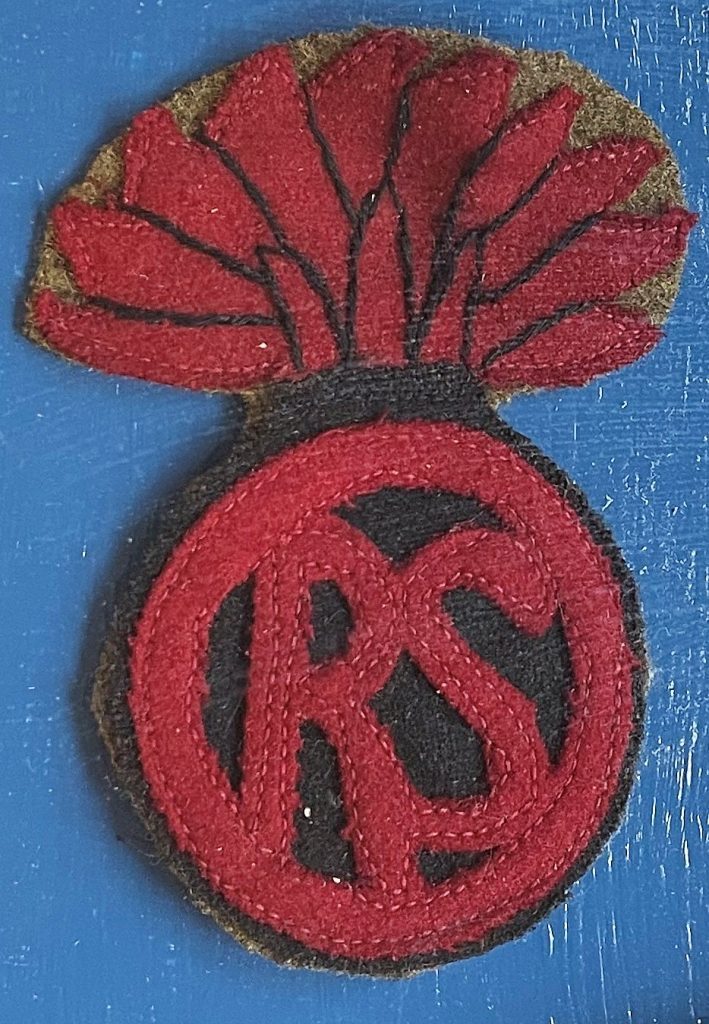
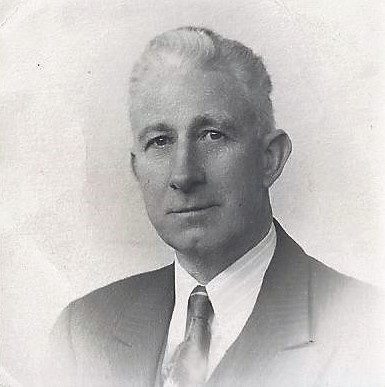
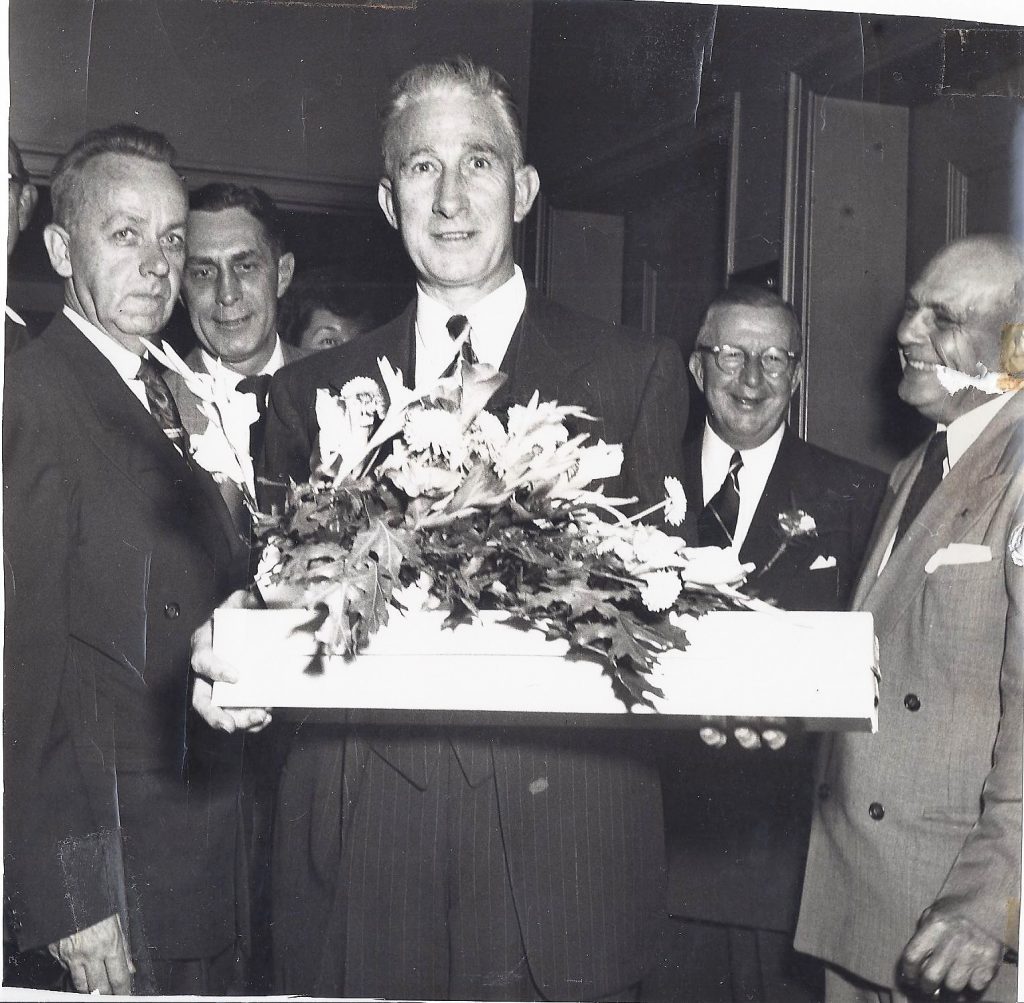
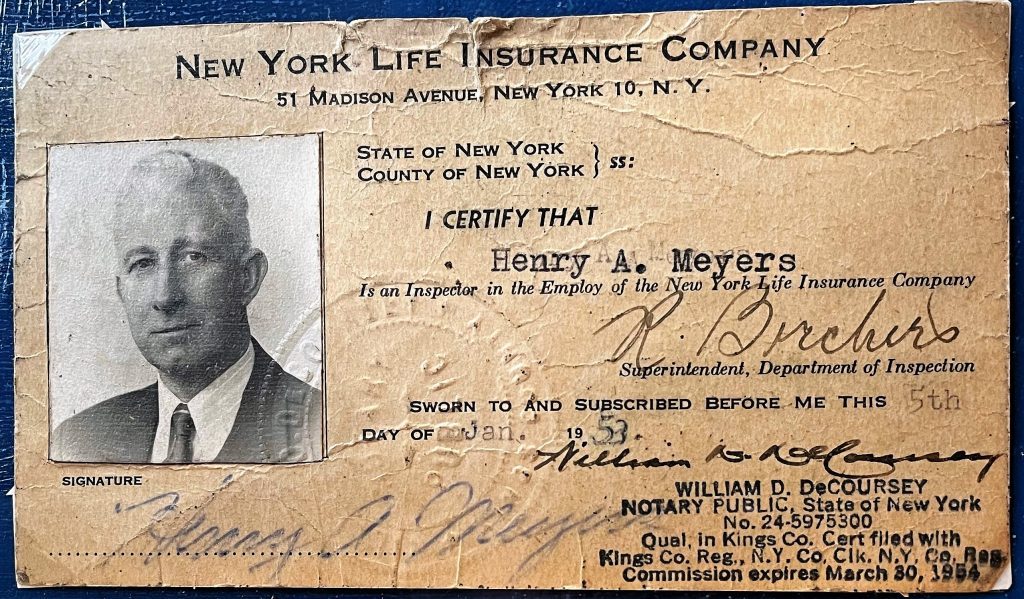
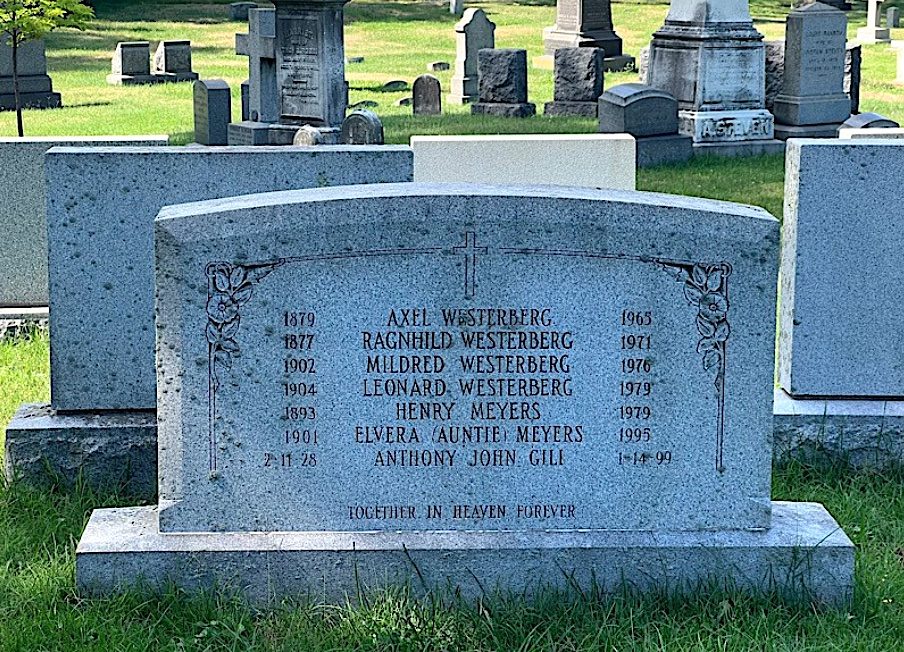
MIDDLETON, BENJAMIN PARKER (1873-1952). Lieutenant (temporary), United States Navy. Middleton was born in Brooklyn. On November 23, 1889, he enlisted in the United States Navy at New York City for five years. He was 5′ 2 3/8″ tall with a fair complexion, gray eyes and light brown hair. His Naval records indicate service aboard the USS Nashville during the Philippine Insurrection (1899-1902, after the Spanish-American War) and the China Relief Expedition, an effort undertaken to rescue United States citizens, Europeans and other foreign nationals in the last years of the Boxer Rebellion (1898-1901); no specific dates are indicated on Middleton’s record. At the time of the 1910 census, he lived with his wife of one year and baby son at 46 Friendship Street in Newport, Rhode Island, and listed his occupation as gunner in the Marines; he still lived in Newport and worked as a gunner in 1915.
As per his New York State Military Abstract for World War I, Middleton was appointed as an acting gunner in the United States Navy on August 1, 190o, and rose to chief gunner on August 1, 1907. He was assigned to electrical duty on the USS Kansas from December 9, 1915 through December 2, 1917. During that time, he was an ensign (temporary) as of July 1, 1917, and rose to lieutenant (jg) (temporary) as of October 15, 1917. His duty at the New York Navy Yard continued in connection with fitting the USS Canonicus and duty on board that vessel from December 3, 1917 through March 27, 1919. The Canonicus was part of the Mine Squadron after its arrival in Inverness, Scotland, on May 27, 1918; during that assignment, Middleton rose to lieutenant (temporary) on July 1, 1918.
Middleton was married at the time of the 1920 census and listed his home as “United States, Army and Navy Forces.” The 1930 census notes that he was single, lived in a rental in Brooklyn at 369 87th Street, had no home radio, and worked as a sea policeman in the United States Navy. He noted that he was a veteran of the Spanish-American and World Wars, the Philippine Insurrection and the Boxer Rebellion. The United States Navy and Marine Corps Registry for 1936 lists Middleton as a chief gunner stationed at 4414 Cayuga Avenue in the Bronx. Middleton’s gravestone notes his service in the Spanish-American War and in World War I; the life dates on his gravestone are not correct–they do not match his military records or the data from Green-Wood Cemetery’s database. Section 11, lot 4622.
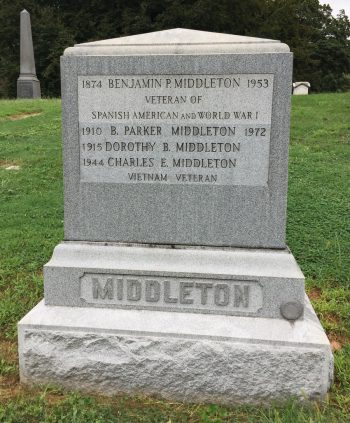
MILLER, JR., GEORGE NORTON (1888-1919). Second lieutenant, 361st Aero Squadron, 376th Aero Squadron, 360th Aero Squadron, American Expeditionary Forces, United States Army. Originally from Rhinebeck, New York, Miller graduated from Princeton University in 1910. The 1915 New York State census listed him as a banker, living with his parents, sister and a servant. Described in his military abstract as of medium height and build with brown eyes and dark brown hair, he enlisted on September 28, 1917, and trained at the U.S. Aviation School in San Antonio, Texas. On January 3, 1918, he was commissioned as a second lieutenant and went overseas on June 30, 1918, attached to the American Expeditionary Forces where he served with 361st, 376th and 360th Aero Squadrons (the designation for the first U.S. Army aviation units until the end of World War I). On March 27, 1919, he succumbed to bronchial pneumonia at Evacuation Hospital 19 and was buried at Stadts Friedhof in Trier, Germany. He last lived in Rhinebeck, New York. His father, George Miller of 811 Madison Avenue, was notified of his death. After his remains were returned to the United States, he was re-interred at Green-Wood on October 20, 1920. Section 20, lot 6125.
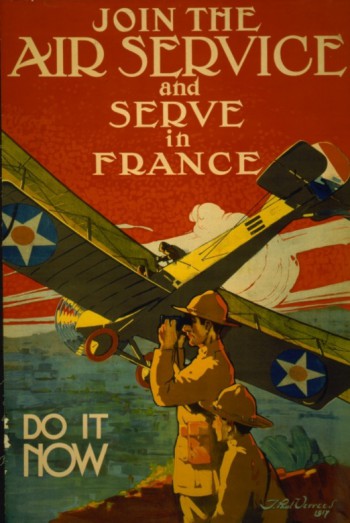
MINARDI, CARMINE (or CARMEN, HERMAN) (1894-1951). Wagoner, 304th Engineers, Company C, American Expeditionary Forces, United States Army. Minardi was born in Paludi, a village in the province of Cosenza, Italy, and immigrated to the United States from Naples on September 15, 1913. He enlisted in the United States Army on September 21, 1917. His 1922 Passport Application indicates that he became a naturalized citizen at Camp Meade, Maryland, on June 5, 1918. On July 9, 1918, he departed from Hoboken, New Jersey, en route to France as a private first class with Company C of the 304th Engineers. As per his Veteran’s Compensation Application to the State of Pennsylvania on April 4, 1934, Minardi cited his service in Company C of the 304th Engineers and noted that he fought in the Meuse-Argonne Offensive. On May 18, 1919, he departed from St. Nazaire, France, with the rank of wagoner, for Philadelphia, Pennsylvania, where he lived at 5923 Underhill Street. He was discharged from the Army on June 6, 1919.
According to the 1920 census, Minardi was single, lived on 44th Street in Brooklyn with his uncle and worked as a house helper; that census notes that he was a naturalized citizen. On September 14, 1920, he married Constanza (Constance) Gagliardi in Brooklyn. He was issued a passport on July 3, 1922, which listed a birth date of July 13, 1898; that information is not correct, his Army paperwork notes that he was born on July 13, 1894. Minardi’s passport application also indicated that he was married, worked as a laborer, lived in Brooklyn on 44th Street, and intended to visit relatives and travel to France, Switzerland, the British Isles, and Gibraltar. As per the New York City Voter List for 1924, he lived at 337 Grove Street in the 19th Election District. At the time of his aforementioned veteran’s application in 1934, he was married with three children and lived at 1231 37th Street in Brooklyn (just a few blocks from Green-Wood Cemetery). His World War II Draft Registration Card, filed in 1942, indicates that he was self-employed and still lived with his wife at the 37th Street address. On November 27, 1951, Constance Minardi, his widow, who lived at 1231 37th Street in Brooklyn and is interred with him, applied for a government-issued bronze marker with a Christian emblem citing her husband’s service in the 304th Engineers during World War I. Section 171, lot 38122, grave 1.
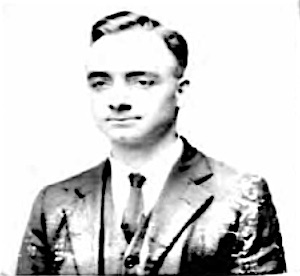

MITCHELL, CHARLES B. (1897-1937). Corporal, 9th Infantry, United States Army. The application for a government-issued headstone for Mitchell notes that he enlisted on June 5, 1917, and served as a corporal in Company D of the 9th Infantry, which was attached to the 2nd Division. He was honorably discharged on February 8, 1919. On December 21, 1937, eleven months after his death, William E. Mitchell, who lived at 380 Ocean Avenue in Jersey City, New Jersey, applied for a government-issue headstone with Christian emblem, citing Charles Mitchell’s service in World War I. Section 102, lot 9157.
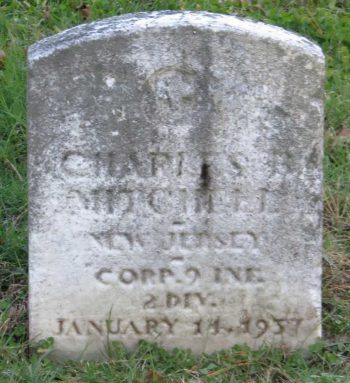
MOESCHEN, FRANCES W. (1893–1918). Nurse. A native of New York City, she was a Red Cross nurse in civilian life who was called into service on November 7, 1917, and assigned to Camp McClellen, Alabama. According to her World War I Military Service Abstract records, it appears that she was assigned to various army medical hospitals until her death in France on September 7, 1918, from pneumonia. Her last residence was 589 Third Avenue in New York City. Her body was returned to New York and re-interred on September 2, 1921. Section 138, lot 24881, grave R3.

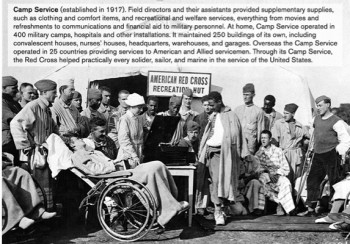
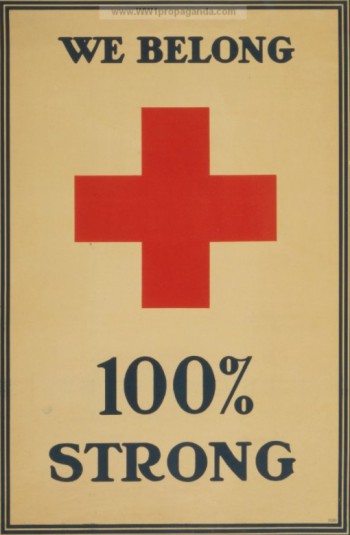
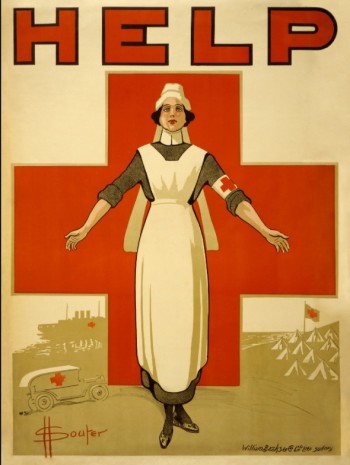
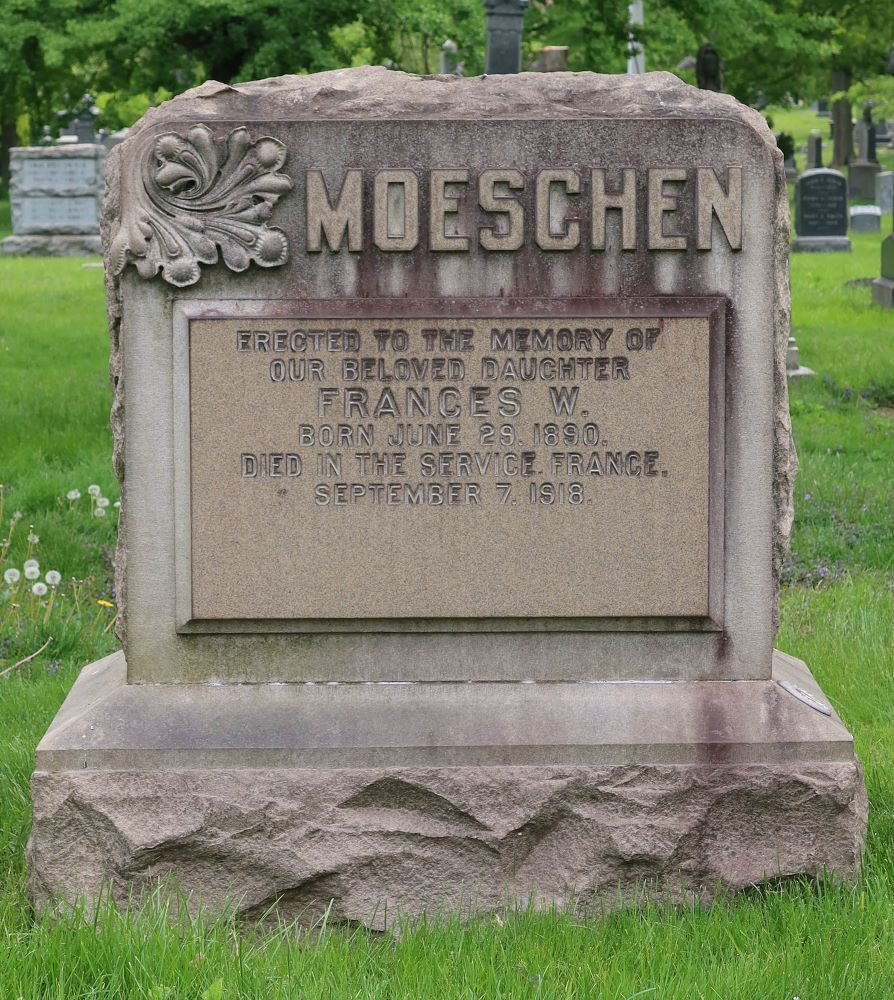
MONICO (or MONIER), ANTONIO (or ANTHONY) SALVATORE (1896-1947). Private first class, 2nd U.S. Cavalry, Troop I, American Expeditionary Forces, United States Army. Monico was born in New York City. He enlisted in the Army on April 11, 1914, at Fort Slocum, New York, and was assigned to Troop I of the 2nd Cavalry. His World War I Draft Registration Card of June 5, 1917, identifies him as tall and of medium build with blue eyes and light brown hair. At that time, he was a clerk for a telegraph company at 20 Broad Street and lived at 113 Mulberry Street in Manhattan; he claimed exemption from the draft but gave no explanation. He was listed as single on that document but other documentation indicated that he married Katherine Rockwell in Clinton, New York, on May 17, 1917. On January 12, 1918, he was promoted to private first class, and on March 22, 1918, Monico shipped out to France. Troop I saw action at the Aisne-Marne offensive between August 3 and August 6, 1918, and the Meuse-Argonne offensive between September 26 and November 11, 1918. He served in France until June 29, 1919. His Military Abstract notes that he was honorably discharged on December 15, 1919; the headstone application lists the date of discharge as June 4, 1920.
According to the 1920 census, Monico was a helper for the gas company and lived with his brother-in-law’s family on Jay Street in Brooklyn. The 1930 census shows him living on 59th Street in Brooklyn, and working as a clerk for a telegraph company. As per his World War II Draft Registration Card of 1942, he lived at 123 Baxter Street in Manhattan and worked for the Postal Telegraph at 20 Broad Street in Manhattan, the same company that was listed as his employer on his 1917 Draft Registration Card. His last residence was 725 4th Avenue in Brooklyn. On May 29, 1948, Katherine Monico, his widow, applied for a government-issued headstone with Christian emblem, citing her husband’s service in the 2nd Cavalry in World War I. Section 134, lot 37830, grave 270.
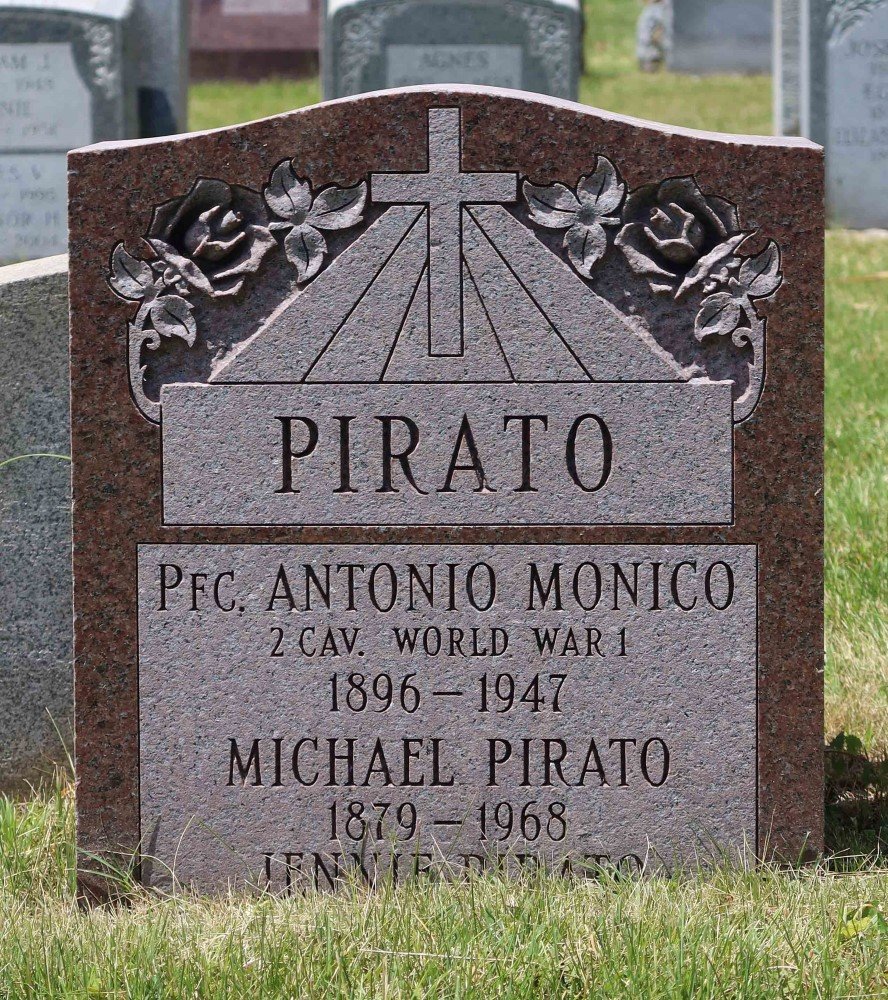
MONSEN, JOHN E. (1876-1933). Chief boatswain’s mate, United States Navy. The 1905 New York State census indicates that Monsen was married and living in Brooklyn with his wife and two young children. According to the application for a government-issued headstone, Monsen served in the United States Navy from October 31, 1917 until February 11, 1919, before being transferred to the Naval Reserve. He retired as a chief boatswain’s mate on November 18, 1927. During his active service, he served aboard the battleships USS New York, USS Utah, and USS Iowa; further details of his service are unknown. The USS New York was part of the United States Navy force sent to aid the British fleet in the North Sea towards the end of World War I. The USS Utah was stationed in Bantry Bay, Ireland, to protect convoys from the threat of German surface raiders. Both saw service after World War I as training ships and on patrol in international waters. The USS Iowa was antiquated and saw limited service during World War I. It served as a receiving ship at Philadelphia, Pennsylvania, for six months before it was sent to Hampton Roads, Virginia, as a training ship. It was decommissioned on March 21, 1919, and renamed Coastal Battleship No. 4 to be used for target practice. His last address was in Central Islip, Long Island. He died from stomach cancer. On April 14, 1934, Alexandra Monsen, his widow, applied for a government-issued headstone with a Christian emblem, citing her husband’s service in the United States Navy during the World War. Section 16, lot 14888, grave 144.
MORCH, EDWARD JOHN (1893-1966). Ensign, United States Navy. Morch was born in Brooklyn. As per the 1900 census, he lived with his parents and sister at 150 South 9th Street in Brooklyn. The 1915 New York State census and the 1910 federal census state that he still lived in Brooklyn with his parents and sister.
As per his New York State World War I Military Abstract, Morch served as a provisional ensign in the United States Navy. His address at the time of his enlistment at New York on May 7, 1917, was 313 Ocean Parkway in Brooklyn. He was placed on inactive duty on January 22, 1919.
The 1920 census reports that he was single, lived with his parents on Ocean Parkway in Brooklyn and worked as a stenographer. He lived with his parents and wife, Marion E. Egbert Morch, at the time of the 1925 New York State census; at that time, he was a salesman. The 1930 census reports that he was married for seven years, lived with his parents and daughter on Ocean Parkway in Brooklyn, was a World War veteran and worked as a manager in a printing plant. Morch was divorced in 1941 in Palm Beach, Florida. His World War II Draft Registration Form, filed in 1942, reports that he lived in Roslyn, Long Island, had a home telephone, worked for Wallace Press at 225 Broadway in Manhattan; he lists his wife as his next of kin. Section 149, lot 16080.
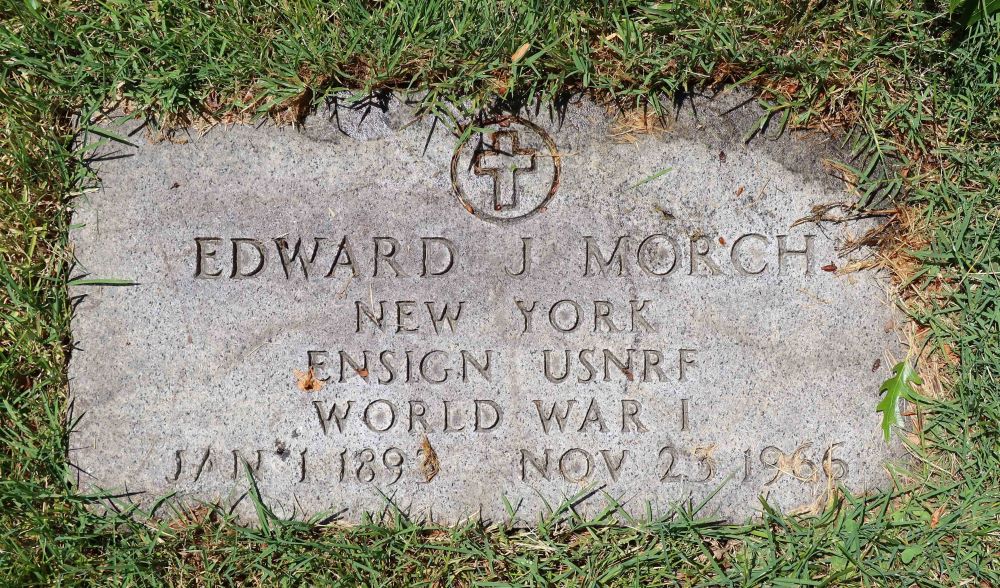
MORRISON, EDGAR LACY (1891-1931). Sergeant, Medical Division, United States Army Ambulance Service. Morrison was born in Brooklyn and was one of five children. The 1910 census states that he lived with his father and siblings in Brooklyn; he was employed as an office clerk. His Draft Registration Card of June 5, 1917, described him as single, short and slender with brown eyes and black hair. At that time, he worked for the Ford Motor Company in Long Island City, Queens, and claimed exemption from the draft because his father and sister were dependent upon him for support. Nonetheless, he enlisted in the United States Army Ambulance Service at Camp Crane in Allentown, Pennsylvania, on December 14, 1918. The camp was established to train ambulance drivers for deployment to Europe. Morrison, however, remained at Crane with the Medical Department, until he was honorably discharged on April 23, 1919.
As per the census of 1930, Morrison was married with three children, lived on 1434 East 13th Street in Brooklyn in a rental that was $55 per month, and could read and write. At that time, he was a manager in the auto industry and indicated that he was a veteran of the World War. He last lived at 1156 Park Place in Brooklyn. His death was attributed to heart disease. On April 13, 1931, about two months after his death, Gertrude Morrison, his widow, applied to the War Department for a government-issued headstone, citing her husband’s service in the Medical Department during the World War. Section 183, lot 18913.

MUNIER, ROLLAND COGER (1892-1966). Sergeant, 152nd Depot Brigade, Company 14, United States Army. Munier was born in Brooklyn. The 1900 census reports that he lived in Brooklyn with his mother, siblings and other family members. As per the 1910 census, he lived on Madison Street in Brooklyn with his mother, siblings and other family members, and was a clerk in the varnish industry. On December 3, 1911, the Brooklyn Daily Eagle reported that Munier hosted a masquerade dance at his home at 435 Greene Avenue on Thanksgiving Eve. The 1915 New York State census shows that he lived in Brooklyn with his mother and siblings.
Munier’s World War I Draft Registration Card, filed on June 5, 1917, lists 306 Stuyvesant Avenue in Brooklyn as his home address. He worked then as a salesman at 100 William Street in Manhattan. He described himself as single, of medium height and build with brown eyes and dark hair; he claimed a military exemption because he supported his mother. Nonetheless, as per his New York State World War I Military Abstract, he lived at the same address on Stuyvesant Avenue when he was inducted into the 152nd Depot Brigade on May 26, 1918. He rose to corporal on September 22, 1918, and to sergeant two months later on November 20. His service was at Camp Upton, New York. He was not wounded during his service nor did he serve overseas. Munier was discharged on May 6, 1919.
According to the 1925 New York State census, he lived in Brooklyn with his mother. The 1930 census records that he was single, lived with his mother at 123 Parkside Avenue in Brooklyn, was a varnish salesman, had a radio set and was a veteran of the World War. He married Mabel Griffith on May 6, 1930, in New York City; Munier was her third husband. The Brooklyn Daily Eagle reported on July 23, 1930, that Mabel Munier, Rolland’s wife, died at 1308 Taft Road in West Englewood, New Jersey; services were held at the Harry T. Pyle Mortuary at 1925 Church Avenue in Brooklyn.
He married Fannie Hoyt Phiefer Miller in New Jersey in 1935; in that year, he was living in River Edge, New Jersey. At the time of the 1940 census, he lived at 924 Hillside Avenue in River Edge, New Jersey, owned his home valued at $4,000, had earned $5,000 the previous year and had income from other sources. He lived with his mother, wife and two teenage children from his wife’s first marriage. His World War II Draft Registration Card, filed in 1942, notes that he lived at 929 Summit Avenue in River Edge, New Jersey, and listed his wife as his next of kin. He had a home telephone and worked for F. O. Pierce Company at 2-33 50th Avenue in Long Island City, New York. He last lived in River Edge, New Jersey, but died in Hackensack, New Jersey. On November 30, 1966, Fannie Munier, of 929 Summit Avenue in River Edge applied for a government-issued flat granite marker memorializing her husband’s service in World War I. Section 108, lot 1676.
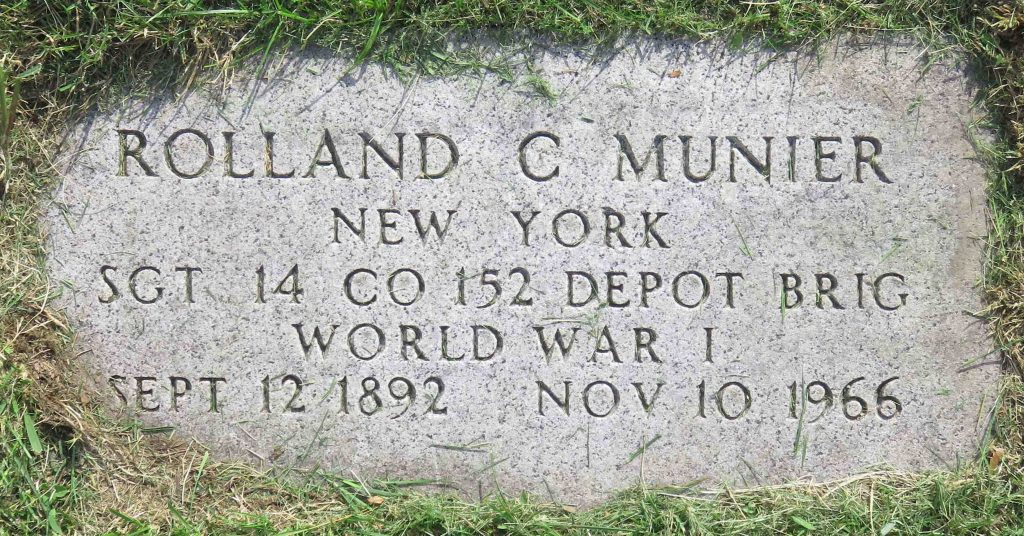
MUNSON, JR., EUGENE (1896-1918). Private first class, 307th Infantry, Machine Gun Company, American Expeditionary Forces, United States Army. Munson was born in Brooklyn. The 1910 census indicates that he had six siblings. As per his 1917 Draft Registration Card, he was single and lived at 1533 Nostrand Avenue in Brooklyn. He described himself as 5′ 11″ tall with a slender build. At that time, he was working as a motorman for the Brooklyn Rapid Transit located at 168 Montague Street. He was inducted into the 307th Infantry on September 22, 1917, and assigned to the Machine Gun Company. His unit was assigned to 154th Infantry Brigade of the 77th Division. Munson was sent overseas to France on April 7, 1918, and was promoted to private first class on April 16. On August 30, 1918, he was wounded and died in action during the Meuse-Argonne offensive, commanded by General John Pershing. His mother, Mrs. Eugene Munson, who lived with him at 1533 Nostrand Avenue, was notified of his death. After his remains were returned to the United States, Munson was re-interred on July 23, 1921. Section 126, lot 5047, grave 948.
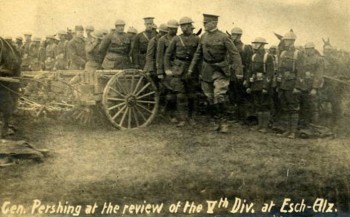
MUNSON (or MINSON), HERBERT MELVILLE (1890-1968). 1st class ship’s cook, United States Navy. A native of Whitestone, Queens, the 1910 federal census and the 1925 New York State census report that Munson was single, lived in Queens with his parents and siblings and worked as a butcher. According to his New York State Abstract of World War I Military Service, he enlisted at the New York Recruiting Station on June 5, 1917, and was assigned as a landsman for ship’s cook to the Training Station at Newport, Rhode Island. At that time, he lived at 81 10th Avenue in Whitestone, Queens. From September 29, 1917 through October 16, 1918, he was a 4th class ship’s cook on the USS Agamemnon. He then served as a 3rd class ship’s cook on the USS Ophir from October 16 through November 11, 1918; he was discharged with the rank of 2nd class ship’s cook. On July 14, 1919, he was discharged from the United States Navy at a receiving ship at New York City with the rank of 1st class ship’s cook.
As per the 1920 census, Munson was single, worked as a butcher and lived on Ziegler Avenue in Queens with his mother and other family members. On December 28, 1925, he married Virginia Hoagland in Queens. The 1930 census reports that he lived in a rental at 150-20 15th Drive in Queens with his wife and son, had a radio set, and was the owner of a meat market. The 1940 census reports that he lived at 142-43 Bayside Avenue in Queens, was married, had completed an eighth grade education, worked as a “house man” and had earned $420 in 1939. His World War II Draft Registration Card, filed in 1942, indicated that he worked at 44-27 Bell Boulevard in Queens; he then lived at 139-29 34th Road in Flushing, had no home telephone and listed his wife as his next of kin. He died in Hudson County, New York. Section 77, lot 6136.
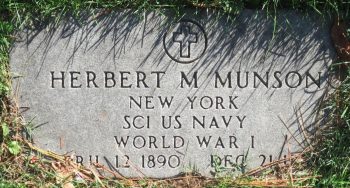
MURPHY, DOUGLAS LEVERIDGE (1897-1944). Private first class, 216th Military Police Company, United States Army. A Manhattan native, Murphy enlisted in the Army on April 4, 1917, served with the 216th Military Police Company, and was discharged on July 12, 1919. After his marriage in 1922, he lived in California and Connecticut before relocating to his last residence in Upper Montclair, New Jersey. On May 25, 1954, Mildred Wheeler, his older sister, applied for a government-issued granite marker with Christian emblem, citing Murphy’s service with the Military Police Corps. Section 25, lot 3362.
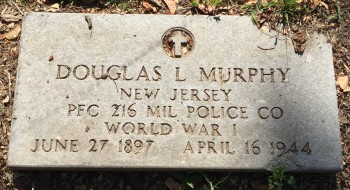
MURPHY, III, JOHN THOMAS (1897-1948). Gunner, 106th Infantry, Company G, American Expeditionary Forces, United States Army. Murphy was born in Brooklyn to Brooklyn-born parents, John Thomas and Frances née Hobby. Although many documents refer to him as John T. Murphy Jr., his online family tree uses the designation of John T. Murphy III. The 1915 New York State census identifies him as living in Brooklyn with his parents and two siblings; his father is listed as a builder and he is listed as a builder’s helper.
As per his New York State Abstract of World War I Military service, Murphy enlisted at Brooklyn on June 22, 1916, at age 18½ and initially served with Company G of the 14th New York State National Guard. He first served at the border with the 14th New York National Guard before his World War I service. He was promoted to corporal on July 27, 1917. His Abstract of National Guard Service shows that he re-enlisted at Spartanburg and was transferred to the 106th on October 16, 1917. His World War I Abstract notes that he served overseas from May 10, 1918 through March 6, 1919.
He was severely wounded in action on September 2, 1918; his online family tree reports that he lost his arm. On September 26, 1918, the Brooklyn Daily Eagle reported that Corporal John T. Murphy, a machine gunner in Company G of the 106th Regiment, “had his arm blown off in action” and is now recuperating at a base hospital. That article quoted Murphy as writing in a letter to his father prior to the incident, “This week we went over the top three days in succession and we made it worthwhile each time.” Murphy’s brother-in-law-law, Private George McNevin, was in Company A of the 106th Infantry. As per an article in the Brooklyn Daily Eagle on October 20, 1918, describing the aforementioned misfortune, Corporal Murphy of Company G of the 106th Infantry was injured on September 5, a date different from that on his online family tree. His parents were notified by telegram and from a letter that Murphy sent to his parents giving details of the injury. The Brooklyn Daily Eagle article noted that Murphy was hit in the shoulder and was recovering at the base hospital in Dartford, Kent. In addition, it confirms his service at the border with the 14th Regiment prior to his re-enlistment in World War I. Further, it states that he was in the carpentering and construction business with his father and was a member of the Rugby Congregational Church. At the time the article was published, Murphy lived at 474 East 52nd Street.
His abstract states that Murphy was discharged on April 8, 1919. The 1920 census reports that he was single, was living on Snyder Avenue in Brooklyn with his parents and younger brother, and was employed as a carpenter. As per his family tree, he was a carpenter. He was married to Catherine on July 8, 1921; the couple had a daughter, Doris, and a son who bore his name. According to the 1925 New York State census, he was living in Brooklyn with his wife and two young children. At the time of the 1930 census, he was living at 529 East 51st Street in Brooklyn with his wife and two children. He owned the home, valued at $8,000, had no radio set, worked as an inspector for the Board of Education, and was a veteran of the World War. The 1940 census reports that he owned his home at the aforementioned address, now valued at $2,800, where he was living with his wife and two teen-aged children. That census reports that he had completed two years of high school, worked as an inspector in a government job, had earned $2,820 in 1939, and had income from other sources. Murphy’s World War II Draft Registration Card, filed in 1942, reports that he lived at 529 East 51st Street in Brooklyn, had no home telephone, and worked at the New York City Board of Education at 110 Livingston Street in Brooklyn where he was an inspector for the Finance Department. Catherine Murphy was listed as his next of kin. On April 23, 1948, four days after his death, his widow applied for a government-issued headstone, citing John Murphy’s service in World War I. Section 18, lot 36477, grave 3.
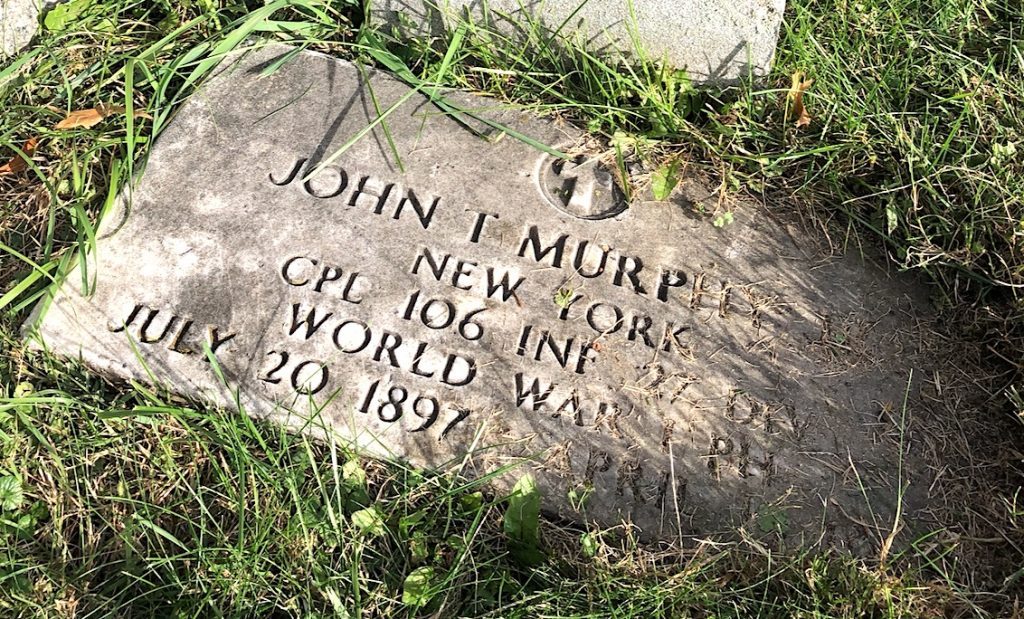
NEALE, II, JOHN HENRY (1896-1961). Field clerk, Adjutant General Department (AGD), United States Army. A native of Manhattan, Neale’s mother died when he was six and although his father remarried in 1913, the youngster was brought up by his paternal grandmother, Elizabeth Blunt Neale Aldridge. During World War I, he served as a field clerk in the Adjutant General’s Department. As per his discharge papers of December 3, 1917, from Camp Wadsworth in Spartanburg, South Carolina, he held the rank of sergeant in the National Guard.
After serving in World War I, he worked in the New York office of the Ellerman Lines, a British shipping company, and moved up to become the American Director of the company. His work involved travel across the Atlantic, conducting business in London and socializing with leaders of Parliament and Lloyds of London. A member f the Whitehall Club, he dined with Winston Churchill.
In 1923, he married Lillian Osborn Wick, a socialite who was educated at Brooklyn’s Packer Collegiate Institute. Their wedding took place at St. Bartholomew’s Episcopal Church in Manhattan. Lillian’s mother, née Ester “Essie” Louise Osborn, was the daughter of Henry Osborn, a prominent hotelier in Sheepshead Bay, Brooklyn, next to the racetrack there; Essie was active in social causes including women’s suffrage.
The Neales settled in Larchmont, New York, where they raised their two sons and where he was president of the Larchmont Yacht Club. At first, the family summered in Maine but later bought an estate in the Hamptons, in Sag Harbor, where he belonged to local yacht clubs and served as mayor. He and his wife spent winters at the Breakers Hotel in Palm Beach, Florida. Neale died at his estate in Sag Harbor; his wife managed the estate for another 30 years and hosted social events there. He is interred in the same lot as his son, John Neale III, who served in World War II. Section 45, lot 31351.

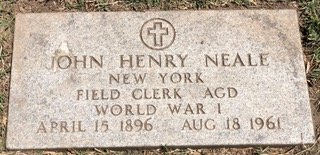
NEXSEN (or NAXSEN, PERSON), HAROLD (1886-1955). Lieutenant junior grade, assistant surgeon, 2nd Battalion, United States Navy. Born in Brooklyn, Nexsen went on to be a medical doctor. He was the brother of Randolph Nexsen (see). At age thirty, he enlisted in the United States Navy on July 10, 1916, with the rank of lieutenant junior grade and was assigned to the 2nd Battalion as an assistant surgeon. He was discharged on October 11, 1920.
As per the 1920 census, Nexsen was married, lived at 300 Lewes Street in Brooklyn, and continued to practice medicine. The New York State census of 1925 indicates that he was a physician and lived with his parents in Brooklyn. According to the passenger list for the ship President Pierce, he traveled from Yokohama, Japan, and arrived in Seattle, Washington, in September 1928. Both the 1930 census and his World War II Draft Registration Card of 1942 show Dr. Nexsen living with his wife at 98 Montague Street in Brooklyn and practicing medicine; the 1930 census notes that he was a veteran of the World War. According to his obituary in The New York Times, Nexsen died suddenly on December 7, 1955, at his then residence at the Hotel Bossert in Brooklyn. His funeral took place at the Fairchild Chapel at 951 Atlantic Avenue in Brooklyn. Section E, lot 36987.
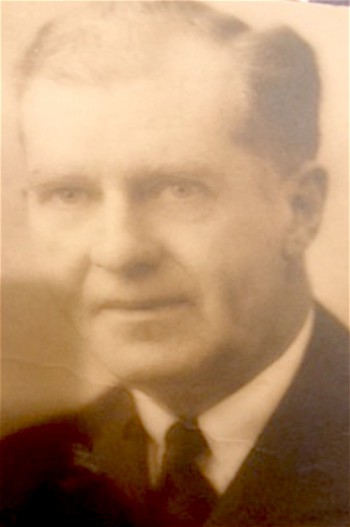
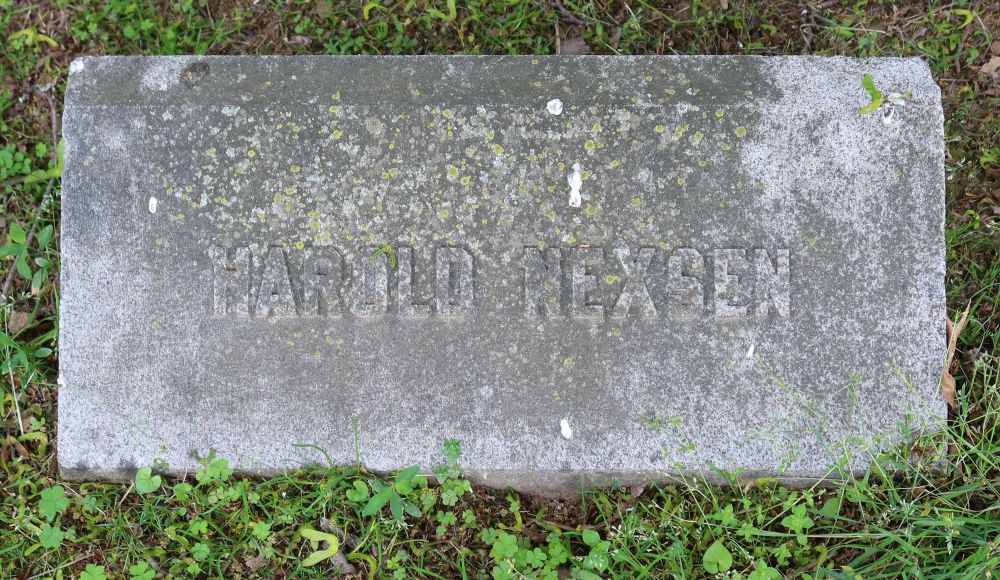
NEXSEN, RANDOLPH HALLIDAY (1882-1961). Lieutenant commander, United States Naval Reserve Force. Nexsen, who was born in Brooklyn and was the brother of Harold Nexsen (see), earned a college degree in engineering. He joined the New York State National Naval Reserve as a lieutenant junior grade (j.g.) on July 11, 1910, with the 2nd Battalion Headquarters as an engineer. On July 2, 1913, he was promoted to lieutenant, serving with the same unit. With the outbreak of World War I in Europe in 1914, the Secretary of the Navy, Josephus Daniels, and his assistant, Franklin Delano Roosevelt, launched a campaign to get funding for a United States Naval Reserve Force (USNRF) which was approved by Congress and created on March 3, 1915.
After the United States entered the World War in 1917, many of the Naval Reserve members served in the cockpits of biplanes hunting enemy U-boats but Nexsen was not one of those reservists. He transferred to the United States Naval Reserve Force as a lieutenant on July 22, 1917, and was stationed at the Naval Reserve Center in Louisville, Kentucky. He was promoted to lieutenant commander on September 21, 1918. Although one record states that he went on inactive duty on February 24, 1919, that is apparently incorrect. According to entries in the Navy and Marine Corps Official Registers of November 1918, January and March 1919, he was assigned to the USS DeKalb, a troop transport vessel. As per his descendant, Nexsen was awarded a World War I service medal that is inscribed, “Atlantic Fleet, Mine Sweeping.” His New York State Military Abstract for World War I states that he was living at the Army and Navy Club located at 18 Gramercy Park in Manhattan.
According to the 1920 census, Nexsen was married with an infant daughter and living on Caton Avenue in Brooklyn; at that time, Nexsen worked as an electrical engineer for the New York City sewer system. As per the records of the New York State Military Museum, he received a decoration from the New York State Naval Reserve in 1931 for 20 years of long and faithful service; he was listed as a lieutenant commander of the 2nd Battalion, Naval Militia. The 1940 census reports that the family was now living in an apartment house at 205 East 17th Street in Brooklyn and that Nexsen held the position of chief power engineer for the Public Service Gas Works; that document indicates that Nexsen had completed four years of college. As per his Draft Registration card for World War II, filed in 1942, Nexsen was employed by the New York State Department of Public Service located at 80 Centre Street in Manhattan, still lived on East 17th Street, and had a home telephone. He retired from the Naval Reserve on July 18, 1946. Section E, lot 36987.
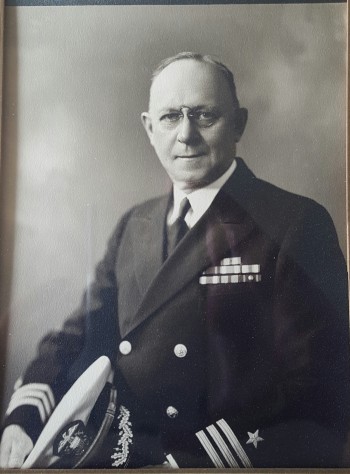
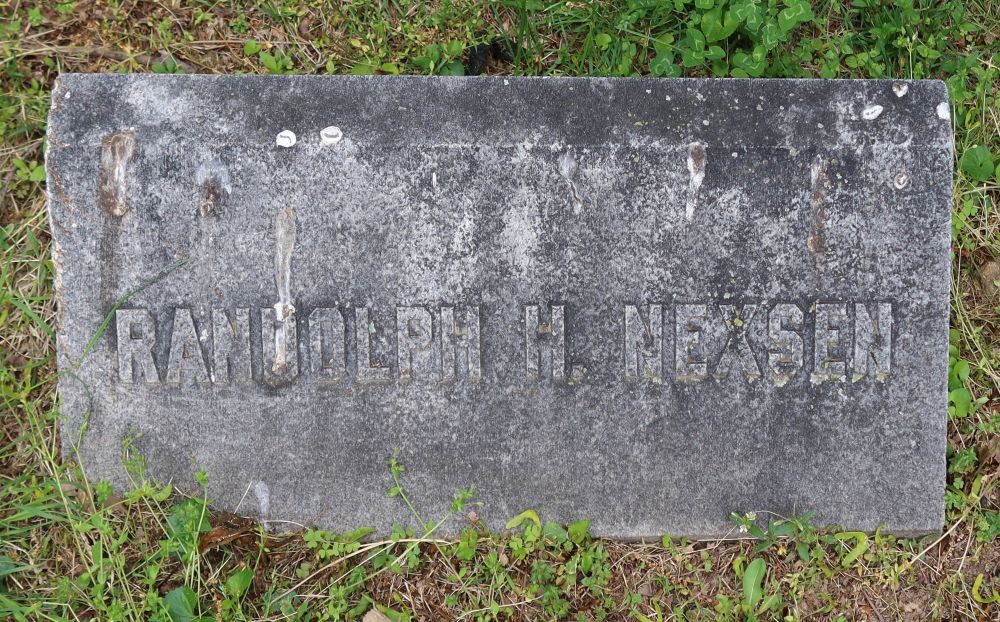
NICKERSON, WINFORD T. (1897-1918). Private, 102nd Field Signal Battalion, Company C, American Expeditionary Forces, United States Army. A Brooklyn native, Nickerson enlisted at Fort Slocum, New York, on November 16, 1917, and mustered immediately into Company C of the 102nd Field Signal Battalion. He was sent overseas on May 17, 1918 and served with his unit until his death in France on October 23, 1918. Nickerson succumbed to bronchial pneumonia. His mother, Minerva Nickerson, was notified of his death. His last residence was 203 Seventh Avenue in Brooklyn. His body was returned to the United States and re-interred on March 20, 1921. Section 181, lot 15139.
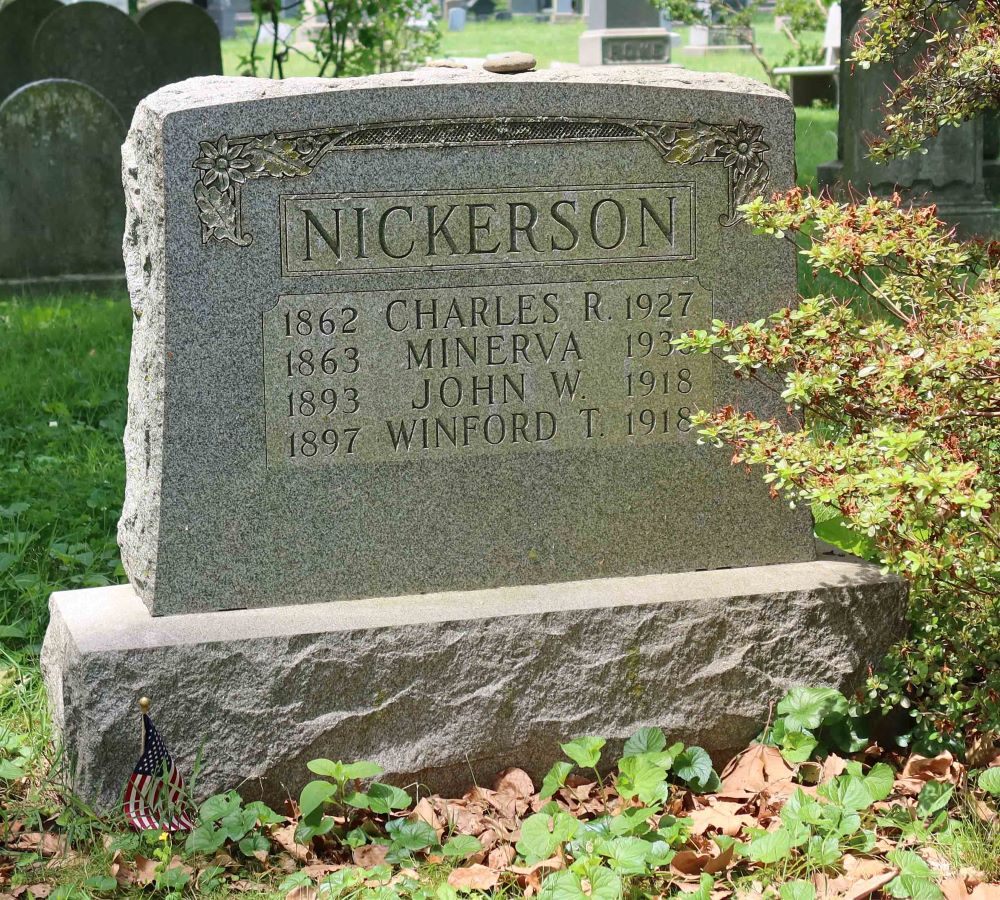
NICOLL, FANCHER (or FRANK) L. (1878-1918). Captain, 107th Infantry, Company L, 54th Brigade, 27th Division, American Expeditionary Forces, United States Army; 7th Regiment, New York State National Guard, Companies K and L. Born in Erie County, New York, Nicoll enlisted in Company K of the 7th Regiment, New York State National Guard, on March 21, 1900. On January 15, 1909, he was promoted to sergeant and, on May 20, was transferred to Company L where he was commissioned second lieutenant on December 30. He was promoted to captain on July 24, 1913, and served on the Mexican border from July to November 1916, during the early stages of the Pancho Villa Expedition.
On August 5, 1917, Nicoll’s regiment was inducted into federal service as the 107th Infantry, 27th Division, trained at Camp Wadsworth, South Carolina, and shipped out for France on May 9, 1918. After further training at Noyelles-sur-Somme, the 27th was sent in relief of the British 6th Army. Nicoll and his company were subsequently commended by the commanding general of the 27th Division for “…the gallantry and skill with which they repulsed the enemy” during a German raid on its position. Acting in conjunction with British, the 27th Division occupied a sector of the front in the vicinity of Ronssey, facing the great tunnel system of the Hindenburg Line, a German defensive position along their Western Front. On the morning of September 29, during the attack that broke the German line, Nicoll was killed after being shot in the forehead as he led his command. His remains were returned to the United States and he was re-interred on April 8, 1921. Section 141, lot 23547, grave 1.
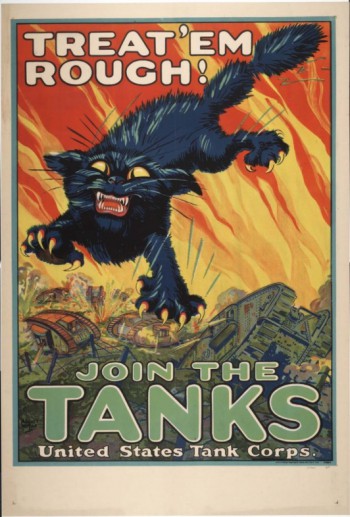
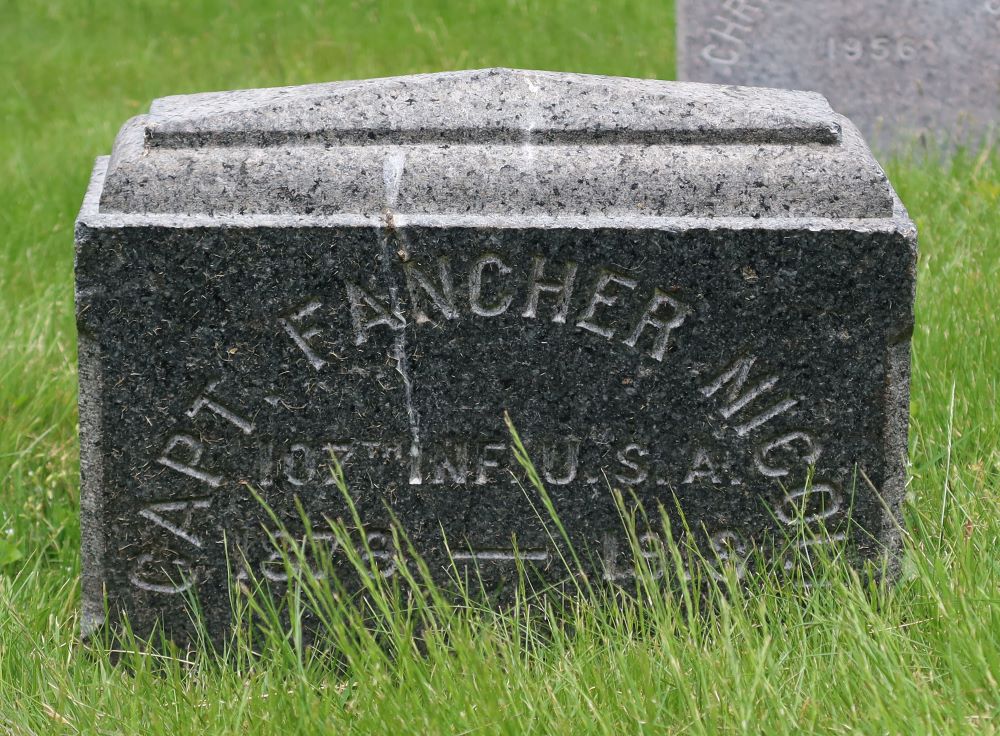
NIVEN, ALAN SCOTT (1895-1917). Second lieutenant, The King’s Own Royal Lancaster Regiment, 9th Service Battalion, King’s Own Yorkshire Light Infantry, British Army. Niven is not buried at Green-Wood; a cenotaph in his honor is placed in a relative’s plot. Niven was born and lived in London, England. Beginning in 1909, he was educated at New Beacon, Sevenoaks and Tonbridge in the Officers’ Training Corps (OTC). In 1913, he trained for one year with a firm of chartered accountants and then joined a firm of produce brokers in London. The head of the firm described him as “possessed of a singular charm of manner coupled with a diligent attention to his duties, he had endeared himself to us all.”
Shortly after the outbreak of the war, Niven applied for admission to a Public Schools Battalion of the Royal Fusiliers (a British regiment armed with light flintlock rifles) but was rejected for a defect in his eyesight. He went to an eye doctor for treatment and was soon accepted in the Artists Rifles OTC. After two months with this corps, he was transferred to an Officer Cadet Battalion and was commissioned a second lieutenant on August 29, 1917, in the King’s Own Royal Lancaster Regiment stationed near Harwich, England. On September 29, the regiment received orders for the front lines. On October 23, he was attached to the 9th Battalion of the King’s Own Yorkshire Light Infantry and was sent to the second Battle of Passchendaele in Belgium, which took place from October 26 through November 10, 1917.
There is a discrepancy as to the date of Niven’s death; the cenotaph is inscribed with the date of October 30, 1917, while other accounts give the date as November 4. One document reports that on November 4, he and another soldier were positioned in a dug-out in the trenches and were instantly killed by a direct hit from an enemy shell. A good friend wrote of Niven, “Personally we do not fear taking the plunge except for the sorrow it causes our dear ones. Alan held very strong views on this score, his only thought being for you at home in the event of what has happened taking place.” His company commander wrote, “He was not long in my Company, but during the short time he gained the admiration and respect of both officers and men alike: he was so keen and willing and did much to encourage the men during a most trying time in the line. Truly his duty to King and Country has been well done!” Niven’s older brother, G. G. Niven, fought within a mile of Alan as lieutenant with the London Scottish; G.G. suffered from the effects of a gas attack during that battle—ultimately costing him his life in 1922. Niven was buried in Tyne Cot Memorial Cemetery, Zonnebeke, Arrondissement leper, West Flanders (West Vlaanderen), Belgium. In his honor, relatives in the United States placed his name on a family tombstone at Green-Wood. Section 130, lot 34556.
NODYNE, FRANK LEWIS (1893-1918). Private, 3rd Provisional Battalion, 152nd Depot Brigade; 105th Infantry, Company D, American Expeditionary Forces, United States Army. A New York City native, he resided at 446 West 124th Street in Manhattan at the time of his induction on April 4, 1918. As per his New York State Abstract of World War I Military Service, he first served with the 3rd Provisional Battalion, 152nd Depot Brigade. He went overseas on May 17, 1918, and was transferred to the 105th Infantry, Company D, on an unstated date. In September, the unit moved forward in support of the 106th Infantry along “The Knoll.” They received massive German machine gun fire on September 29, 1918; Nodyne was killed in action that day.
Nodyne last lived at 2134 Eighth Avenue in Manhattan. His sister, Ida Nodyne, who lived at 124 8th Avenue in Manhattan, was notified of his death. Soon after his death, he was interred in France; after his remains were returned to the United States, he was re-interred on April 10, 1921. On October 24, 1940, his brother, Henry Nodyne, applied for a government-issued headstone, citing Frank Nodyne’s service in the 105th Infantry; the approval included a hand-written notation that he died in the line of duty. Section 145, lot 23976, grave 4.
![noyes.frank.photo[1]](https://gwc-14060.kxcdn.com/wp-content/uploads/2016/07/noyes.frank_.photo1_-350x517.jpg)
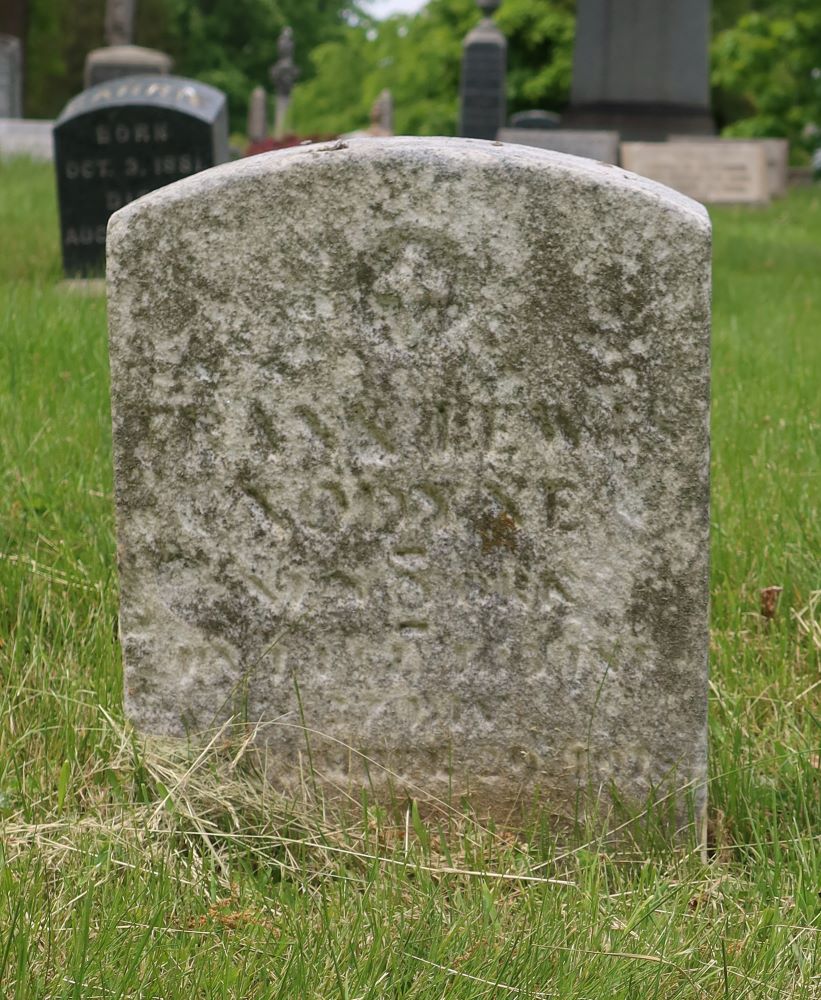
OLSEN (or OHLSEN), ARTHUR (or ARTUR) C. (1897–1922). Fireman 2nd class, United States Navy. A Brooklynite, Olsen, at age 17, went to the recruiting station in New York City and joined the Navy as an apprentice seaman on May 12, 1914. On April 6, 1917, as a fireman, 2nd class, he was assigned to the USS Hartford, only serving four days before being sent to Fort Lyon, Colorado, where the Navy had a sanitarium for sailors and marines suffering from tuberculosis. On January 12, 1918, he received a disability discharge. Subsequently, he was treated for tubercular condition at the Veterans’ Hospital at Fort Bayard, New Mexico, another research center for tuberculosis. He died there on November 30, 1922. His last residence was 11 50th Street in Brooklyn. Section 4, lot 36112, grave 3.
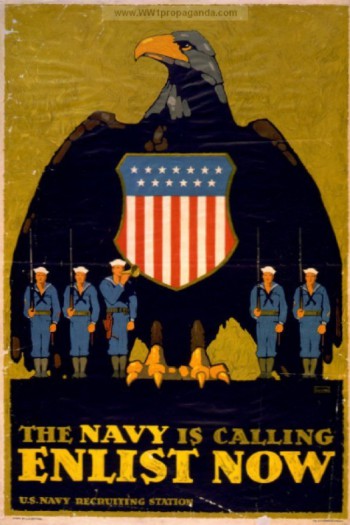
![nicoll.fancher[1]](https://gwc-14060.kxcdn.com/wp-content/uploads/2016/07/nicoll.fancher1-350x498.png)
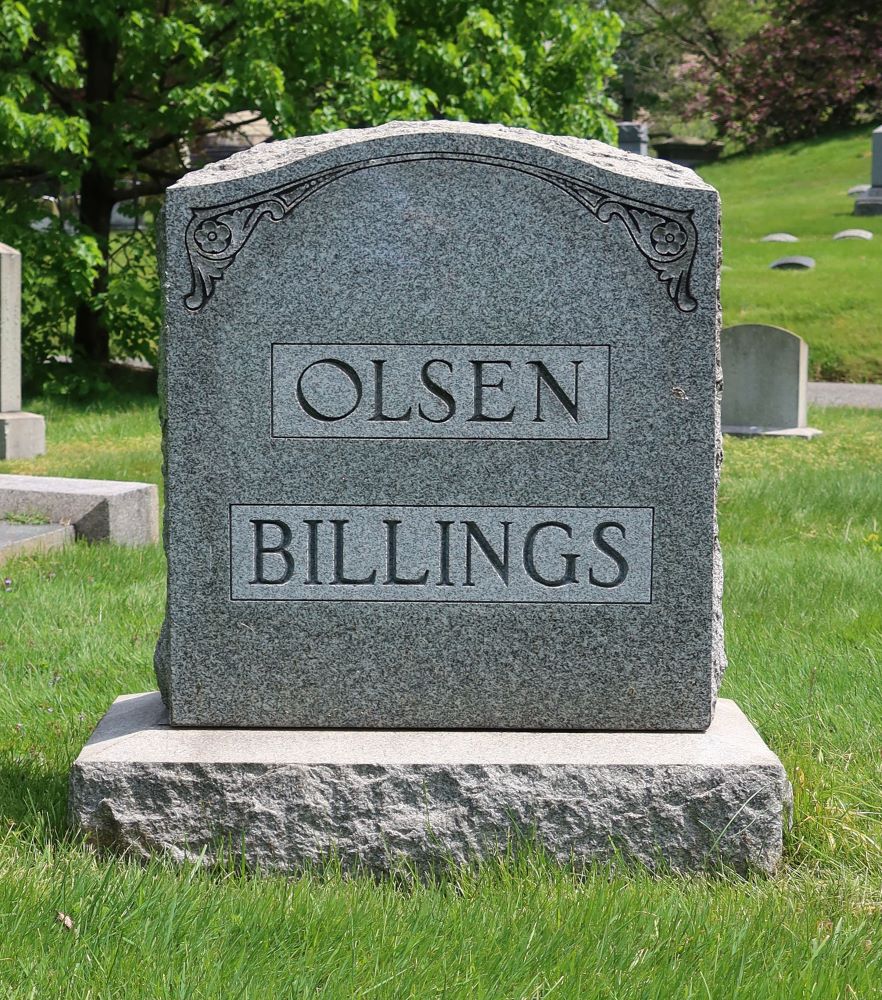
O’NEILL, THOMAS HENRY (1893-1954). Corporal, 5th Infantry, 17th Division, Company A, American Expeditionary Forces, United States Army. O’Neill was born in Elizabeth, New Jersey. According to the governmental headstone application, O’Neill enlisted in the Army on November 7, 1914, serving in Company A, 5th Infantry, achieving the rank of corporal. The 5th Infantry, known as the “Red Diamond Division,” was activated on December 11, 1917, and arrived in France in May of 1918. It initially trained with the French army, and saw action in August, pushing back German forces from its southern front and helping to reduce the St. Mihiel salient. In the process, it captured the town of Frapelle. It later fought in the Meuse-Argonne offensive, the largest battle fought by the United States Army in World War I. O’Neill received his honorable discharge on June 4, 1920, and returned home.
The 1920 census shows O’Neill married and living on East 140th Street in the Bronx with his wife and three young sons. He was employed as a chauffeur for an engine company. He last lived at 1406 George Street in Point Pleasant, New York. On November 15, 1954, Gertrude O’Neill, his widow, applied for a government-issued headstone with a Christian emblem, citing her husband’s World War I service. Section 118, lot 11458.
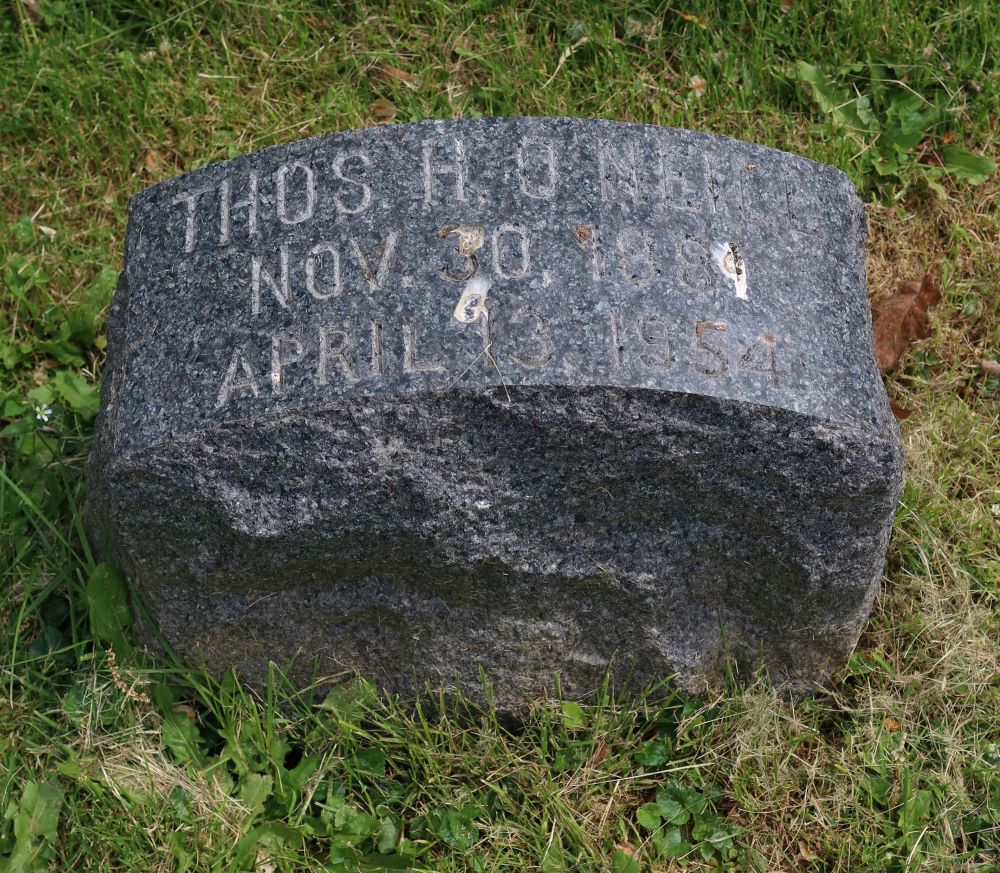
OSSWALT, JOHN HENRY. (1893-1918). Corporal, 111th Infantry, Company L, American Expeditionary Forces, United States Army; private, 152nd Depot Brigade, Company 6. Osswalt is not buried at Green-Wood; there is a cenotaph honoring his memory in his family’s lot. A native of New York City, his Draft Registration Card of June 5, 1917, reports that he was living at 420 Kosciusko Street in Brooklyn and working as a cashier. He was described as single, of medium height and build with gray eyes and light hair. Osswalt was inducted into the Army on April 1, 1918, and was assigned to the 6th Company of the 152nd Depot Brigade located at Camp Upton in Yaphank, New York. Depot Brigades were created to receive and organize recruits, provide them with uniforms, equipment and initial military training, and then send them overseas to fight on the front lines.
Osswalt went overseas on May 5, 1918, joining the American Expeditionary Force with Company L, 111th Infantry Regiment, which was assigned to the 28th Infantry Division. On August 17, 1918, he was promoted to the rank of corporal. His New York State Military Abstract of World War I Services notes that he was engaged in France at Fismette, Argonne Forest, Chateau-Thierry, Morchard Hill 204, Purgny, Ersudo. Foret-de-Fare. On October 2, 1918, Osswalt was killed in action at Argonne Wood. His mother, Anna Osswalt, was notified of his death. His brother, Oscar (see), also served in World War I. He was buried in the Meuse-Argonne American Cemetery, in Romagne, France (Plot F, Row 23, Grave 10). That cemetery contains the largest number of American military who died in Europe (14,246), most of whom lost their lives during the Meuse-Argonne Offensive. The cemetery consists of eight sections behind a large central reflection pool. Beyond the graves is a chapel which is decorated with stained glass windows depicting the American units’ insignias. Section 177, lot 15965.
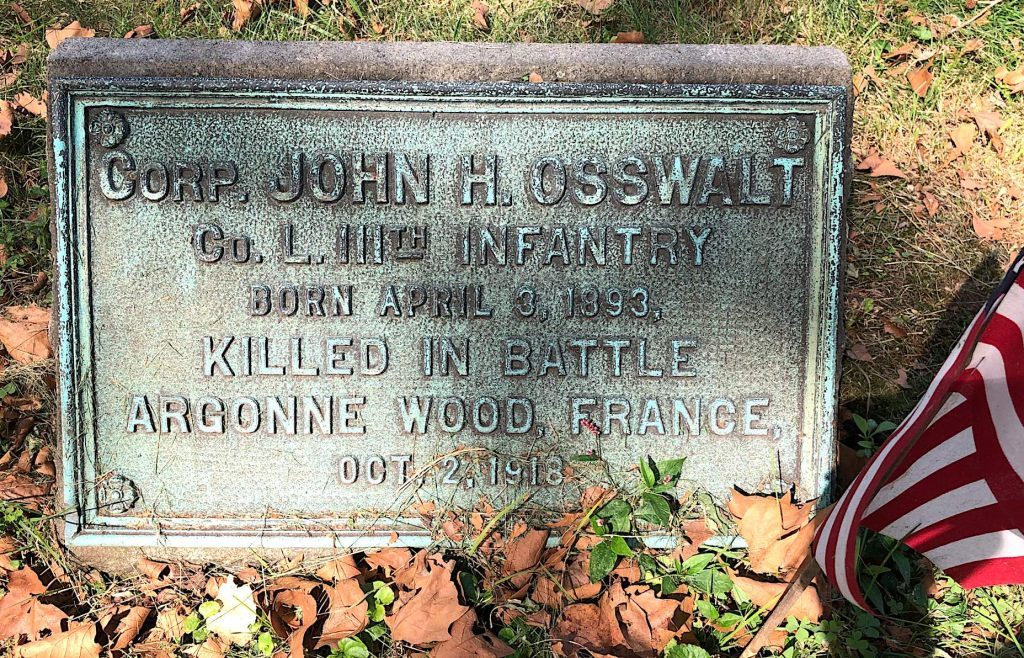

OSSWALT (or OSWALT, OSEWALT, OSWALDT), OSCAR HAROLD (1895-1932). Private, 13th Coast Defense, Company 8. Osswalt was born in New York. The 1900 census notes that he was living at 425 East 69th Street in Manhattan with his parents, Otto and Anna, who were both born in New York, and older brothers, John (see) and Robert. The 1905 New York State census, which spells the surname as “Oswalt,” indicates that Oscar was now living in Brooklyn with his family and with his paternal grandfather, John, and with his Uncle Louis and Aunt Helen. By the time of the 1910 census, the family was living on Kosciusko Street in Brooklyn and was comprised of his parents and two older brothers. The family continued to live in Brooklyn when the 1915 New York State census was tallied; that census spelled the surname as “Osewalt.”
Osswalt’s name is listed on the New York Abstract of National Guard Service in World War I, subtitled 13th Coast Defense. He enlisted as a private on May 17, 1916, mustered in on July 23, and was honorably discharged on March 26, 1918 to accept a commission. That document lists 420 Kosciusko Street as his address and October 28, 1896 as his birthday, a year younger than that appearing in other documents. His World War I Abstract verifies the above information and reports that he did not serve overseas and had no disability. According to the Veterans Administration Master Index, which records his name as Harold Oscar Osswalt, a military date of December 21, 1918, is given along with a residence in Hollis, New York. As per his son’s World War II biography, his father was a first lieutenant in World War I but details of that service are not known.
Oscar was married to Alice Mildred, who was one year younger than him. Marriage license records show that he married A. Mildred Farr on May 31, 1919, at Watervliet, New York. Although married at the time, the 1920 census, which recorded the family name as “Oswaldt,” shows him as single, living with his parents and brother Robert on Kosciusko Street; Oscar was then employed as a salesman in the advertising industry. His online family history on the Ancestry website reports that Oscar and his wife welcomed a son, John Farr Osswalt, in 1922, and a daughter, whose name and birth year are identified as “private.” However, although there is no mention of a daughter on census data, Osswalt’s obituary names the daughter as Alice Myldred. Oscar is listed on the 1924 Voting Lists as living at 9319 204th Street in Queens.
According to the 1930 census, the Osswalts and son John were living at 4 North Clover Drive in Great Neck Estates, Long Island. They had a radio set at the home they owned; that house was valued then at $45,000. He was identified as an investment banker and veteran of the World War. His name is on the manifest of the Governor Cobb, a ship that arrived in Key West, Florida, on February 13, 1930. As per his obituary in the Brooklyn Daily Eagle, he died at his Great Neck residence and was survived by his wife, son and daughter. His son John served in the Army Air Force during World War II and is buried in the same lot as his father. Section 177, lot 15965.
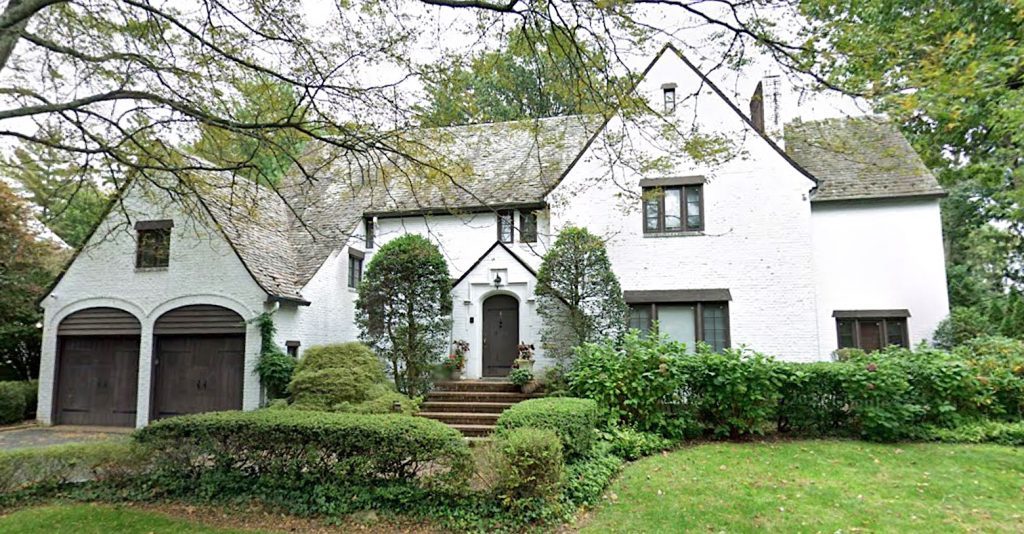
PEARSALL, WILLARD HALL (1895-1980). Second lieutenant, Sanitary Corps; private, Medical Supply Depot, United States Army. Pearsall was born in Albany, New York. At the time of the 1915 New York State census, he was a college student who lived with his parents and siblings in Albany. Pearsall’s World War I Draft Registration Card reports that he lived at 460 Hamilton Street in Albany, was a college student and was tall, of medium build with gray eyes and brown hair. He indicated that he had flat feet but could walk short distances. He claimed exemption from service noting that he was in the ROTC (Reserve Officers Training Corps) at Madison Barracks, New York. Nonetheless, he enlisted as a private on December 6, 1917, at Fort Jay on Governors Island, New York, and was assigned to the Medical Supply Depot in New York City. His World War I Veterans’ Service Data for New York notes that he also served at Camp Maude, Maryland, Washington, D.C., and Camp Greenleaf, Georgia. On October 30, 1918, he was promoted to second lieutenant in the Sanitary Corps and assigned to Evacuation Hospital #53 at Camp Greenleaf. Pearsall was discharged on December 23, 1918, at the Camp Greenleaf; his New York State Abstract of Military Service indicates that he was not wounded and did not serve overseas.
As per the 1920 census, Pearsall was single, lived on Hamilton Street in Albany, New York, with his mother and siblings and worked as a bond salesman. On April 9, 1921, he married Marilla C. Houghton Pratt in New York. The 1925 New York State census indicates that he was married with an infant, worked as a bank president and lived in Brooklyn with his family and mother-in-law. The 1930 census notes that he was married for nine years, lived with his wife, children and mother-in-law at 1907 East 17th Street in Brooklyn and was in the banking industry. He lived at the same address in 1940 with his family and was listed as an executive who had completed four years of college; the house, which he owned, was valued at $16,000 and his income for 1939 was $5,000. His World War II Draft Registration Card, filed in 1942, notes that he had a home telephone, still lived on East 17th Street with his wife, and worked for the Fulton Savings Bank. He last lived on Sagheanack Road in Bridgehampton, New York. Section 145, lot 32623.

PERRIN, FREDERICK (1881-1938). Sergeant, 309th Engineers, Company B; corporal, 7th Regiment Engineers, American Expeditionary Forces, United States Army. Perrin was born in Brooklyn. The application for his government-issued headstone and his Military Abstract for World War I indicate that he enlisted on June 6, 1917, at Fort Slocum, New York. At that time, he lived at 288 Tompkins Avenue in Brooklyn and was first assigned to the 7th Regiment Engineers. He was promoted to private first class on August 13, 1917, and to corporal on September 9, 1917, before he was assigned to Company B of the 309th Engineers on September 18, 1917. On September 9, 1918, he was sent overseas where he served until June 11, 1919. He was honorably discharged on June 24, 1919, having received no wounds or injuries during his service. At some point, he was promoted to sergeant.
Perrin’s obituary in the Brooklyn Daily Eagle, confirms his World War I service and notes that he also served in the Philippines. At the time of his death, he was a United States Customs guard. He last lived at 549 81st Street in Brooklyn; he was ill for the last three months of his life. Perrin was survived by three sisters and two brothers. On October 8, 1838, about two weeks after his death, his sister, Mary Perrin, of 549 81st Street in Brooklyn applied for a government-issued headstone, citing her brother’s service the 309th Engineers. Section 187, lot19918, grave 2.
PERROTTA (or PEROTTA), ANTONIO (1884-1963). Private, United States Army. Born in Campania, Italy, Perrotta sailed from Naples to New York at fifteen years of age, and arrived with five dollars. His father Luigi paid for his passage. Although the aforementioned information suggests that he came to the United States in 1899, the 1930 census reports that he immigrated in 1912. His daughter reports that in 1918, he became a United States citizen by virtue of serving in the Army, helping to test gas masks. The only other record of his service in World War I is an entry on the 1930 census.
On April 26, 1919, Perrotta married Louise Fusco, who was also an Italian immigrant and had become a United States citizen; the marriage took place in Brooklyn. Per the 1925 New York State census, the family was living at 353 17th Street in Brooklyn. Perrotta was thirty-three years old, worked as a cement laborer, and had been in the United States for ten years. His wife, Louise, was twenty-six and the couple had three children: Rose who was five years old and attended school, Charles who was three, and Mary two.
According to the 1930 census, the Perrotta family continued to live at the same address and owned their home which was valued at $8,500. They had five children now: Rose ten, Pasquale eight, Mary six, Francis four, and Rudolph who was over one year old. Rudolph later died at the age of three. The first three children attended school. That census shows that Perrotta was a laborer in a cement yard, was a naturalized citizen, owned a radio set and was a veteran of the World War.
The 1940 census reports that the Perrottas continued to live at 353 17th Street in Brooklyn with four daughters-Rose, Mary, Francis and Adelaide. That census, which also states that Perrotta was a naturalized citizen, reports that he had not worked the previous year; their house was then valued at $7,000.
According to his daughter Mary, he died in 1963, was exhumed and then buried in Green-Wood in 1965. On December 1, 1976, the Daily News published an obituary for Louise Perrotta, noting that Antonio was her late husband; Rose, Mary, Pasquale Francis and Adelaide survived her along with 12 grandchildren and 13 great-grandchildren. Section 128, lot 37333.
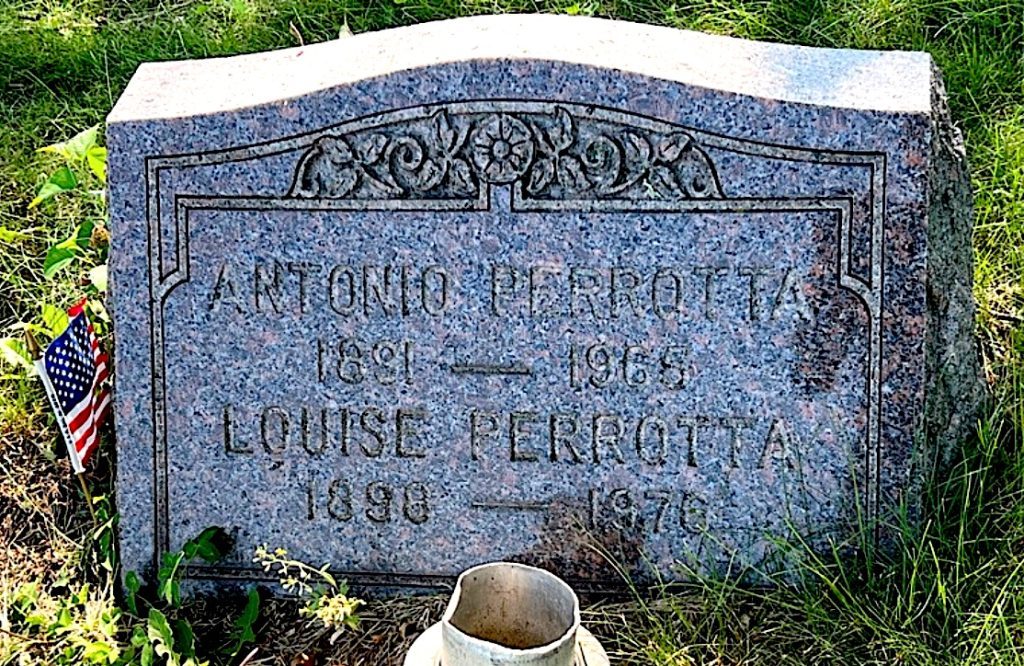
PETERMAN, HENRY EUGENE (1884-1940). Sergeant first class, 7th New York State National Guard, Company C; Quartermaster Corps, United States Army. A New York City native, Peterman’s New York State Abstract for Military Service notes that he lived at 29 Sutton Place in New York City when he enlisted as a private in the 7th Infantry, New York State National Guard, on February 25, 1916. Assigned to Company C, he was promoted to private first class on June 26, 1916, when he mustered in to take part in the Mexican Punitive Campaign. As per his soldier records, he was a draftsman who was 5′ 6¼” tall with brown hair and a light complexion; his father was listed as the next of kin. His unit was sent to McAllen, Texas, arriving there on July 2. He was awarded a New York State Mexican Border Service medal and a Federal Mexican Border Service medal for his participation in the Mexican Punitive Campaign. After his border service, he was transferred to the Quartermaster Corps at the Headquarters of the 7th New York on November 8, 1916. Peterman was promoted to sergeant on November 9, 1916, and to sergeant first class on March 9, 1917.
After his service at Headquarters ended on August 30, 1917, Peterman was transferred to the Sub-Depot, Quartermaster Corps, at Camp Wadsworth, South Carolina until December 15, 1917. He then concluded his service with the 28th Company Office Regiment’s Quartermaster Corps at Johnston, Florida. On September 12, 1918, he completed his World War I Draft Registration Card. As per that document, he was married, lived at 2719 Avenue D in Brooklyn, and worked as a shipping clerk. He described himself as short and stout with blue eyes and brown hair. On December 7, 1918, he was honorably discharged. He did not serve overseas nor receive any wounds during his service. As per the 1920 census, he was married, lived at 1203 Rogers Avenue in Brooklyn and worked as a stockman. The New York State census of 1925 indicates that the Petermans lived at the same address and had a young child. According to the 1930 census, he still rented the same dwelling, owned a radio set and worked as a clerk in the sewing machine business; that census notes that he had been married for 14 years. In 2018, his medals were offered at auction at eBay. Section C, lot 20716.

PETERSON, LOUIS T. (1895-1918). Private, 14th Infantry, New York State National Guard, Company F; 165th Infantry, Company D, American Expeditionary Forces, United States Army. A New Yorker by birth and a resident of Brooklyn, Peterson enlisted in the 14th Infantry of the New York State National Guard on May 28, 1917, was assigned to Company F, and mustered in on July 20. Peterson was transferred to Company D of the 165th Infantry on August 25, 1917. The 165th was assigned to the 27th Division. On October 26, 1917, he was shipped overseas and participated in the Champagne and Ourcq River campaigns. On July 29, 1918, Peterson was killed in action. He last lived at 341 41st Street in Brooklyn. Ida Peterson, his mother, was notified of his death. His remains were returned to the United States in 1921 and were re-interred on July 17, 1921. Section 124, lot 35309, grave 1.

PEVERELLY, AUGUSTUS OTTER (1892-1972). Sergeant first class, Signal Corps, American Expeditionary Forces, United States Army. Peverelly was born in Brooklyn. The 1900 census reports that he lived at 410 Myrtle Avenue in Brooklyn. At the time of the 1910 census, he lived with his parents on Lexington Avenue in Brooklyn and worked as a clerk in the linotype industry. The 1915 New York State census shows that he lived with his mother in Brooklyn and was a stenographer.
As per his Draft Registration Card, filed on June 5, 1917, Peverelly lived at 546 Monroe Street in Brooklyn, was single, and worked as a private secretary. He described himself as of medium height and build with brown eyes and brown hair. During World War I, he enlisted as a private at Camp Alfred in Vail, New Jersey, on May 11, 1918, and was assigned to the Signal Corps. On July 9, 1918, he departed from Hoboken, New Jersey, on the Orizaba with a detachment of stenographers, linemen and telegraphers; at that time, he lived at 358 Jefferson Avenue and listed Elizabeth Clarke, his aunt, as his next of kin. Peverelly rose to corporal on September 1, 1918, to sergeant on October 8, 1918, and to sergeant first class on March 1, 1919. He departed from Brest, France, on July 20, 1919, on the Aquitania, and arrived in New York City seven days later. He was honorably discharged five days after that.
As per the 1920 census, Peverelly was a lodger on Columbia Road in Washington, D.C., and worked as a secretary in the magazine industry. The 1925 New York State census indicates that he lived in Queens with his wife and two young children and worked as an office manager. His online family tree notes that he divorced his first wife, Anna Clarke, at some point between 1925 and 1930. His World War II Draft Registration Card, filed in 1942, shows that he lived at the Hotel Manitowoc in Manitowac, Wisconsin, and worked for the Aluminum Specialty Company there; his second wife, Dorothy Peverelly, was listed as his next of kin. He lived in East Poultney, Vermont, in the mid-1950s. He last lived in the Bronx. Section 188, lot 20270.


PHAIR, GEORGE H. (1892-1979). Yeoman, first class, United States Naval Reserve Force. Phair was born in St. George, Staten Island. As per New York State National Guard Service Card, Phair enlisted as a seaman in the United States Navy Reserve on April 9, 1917, and was assigned to the Second Battalion. His New York State Abstract of World War I Military Service notes that he first served as a seaman on the USS Gloucester until October 9, 1917, then served as a yeoman second class on the USS Wenonah until October 8, 1918. After a promotion to yeoman first class at the Naval Barracks No. 9, he was assigned to the USS Gibraltar for ten days, then returned to the USS Wenonah from October 28, 1918 through November 11, 1918. Phair then was on inactive duty as of April 16, 1919, and was discharged as a chief yeoman from the 3rd Naval Headquarters in Brooklyn on April 8, 1920.
Phair’s name appears as a United States citizen on the manifest of the USS Lancastria, sailing from LeHavre, France, on October 8, 1927, and arriving at New York City. As per the 1930 census, Phair was married, lived in a rental at 131-141 East 21st Street in Brooklyn, owned a radio set, worked as an inspector for the United States Treasury Department and was a veteran of the World War. The 1933 New York City Directory lists Phair as an inspector who lived at 33 Lenox Road in Brooklyn. His World War II Draft Registration Card, filed in 1942, notes that he lived at 47 Plaza Street in Brooklyn, had a home phone and worked for the United States Treasury Department at the United States Customs House in New York City; Maxwell Palmer (relationship unknown) is listed as the person who would always know his address. On January 26, 1943, he married Mary Matteson Gunsch in Bennington, Vermont. He died of heart disease at a hospital in Bennington, Vermont. Section 166, lot 27838.

PLUMB (or PLUM), ROLLIN (or ROLLINS) GILBERT (1896-1970). Second lieutenant, 351st Field Artillery, American Expeditionary Forces, United States Army. Plumb was born in Brooklyn. The 1910 federal census and the 1915 New York State census report that he lived on Polemus Place in Brooklyn with his parents and siblings and attended school. As per his New York State Abstract of World War I Military Service, he was called into active service on November 17, 1917, assigned as a second lieutenant to the 351st Field Artillery and sent to training camp at Plattsburg Barracks in New York, and then to Camp Meade, Maryland. On June 15, 1918, Plumb was listed on the manifest of the USS Leviathan, leaving Hoboken, New Jersey, as a second lieutenant in the 351st Field Artillery; his home address was 11 Polemus Place and his father was listed as the next of kin. His Military Abstract notes service in Lorraine, France. On February 6, 1919, Plumb departed from Brest, France, aboard the USS Louisville as a second lieutenant with Headquarters Company of the 351st Field Artillery; the ship arrived in New York City 10 days later. He was honorably discharged from Camp Mills, New York, on March 5, 1919.
The United States School Catalog for 1920 lists Plumb as a law major, Yale University class of 1917. As per the 1920 census, Plumb was still living with his parents and siblings on Polemus Street and attending school. On November 1, 1926, he married Cornelia Wyckoff in Brooklyn. The 1940 census shows that Plumb was married and living at 209 Lincoln Place in Brooklyn, was the vice president of a company, had earned $5,000 in 1939, and had income from other sources. Plumb’s World War II Draft Registration Card, filed in 1942, reports that he lived at 82 Craigmoor Road in West Hartford, Connecticut, had a home telephone and worked for the Eagle Lock Company in Litchfield, Connecticut. He last lived in West Hartford, Connecticut. Section 129, lot 36854.
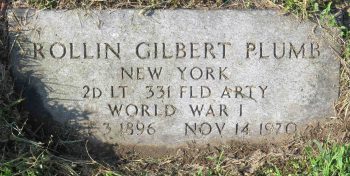
PUISHO (or PERISHO), JOSEPH (1895-1972). Rank unknown, United States Army. Puisho was born in Lithuania, immigrated to the United States in 1909, and became a naturalized citizen in 1918. Although the Social Security Death Index lists his birth year as 1892, his gravestone notes 1895. The details of his World War I service are not known. A plaque next to his gravestone is inscribed, “World War, US, 1917-1919”; in addition, his death was acknowledged by the United States Department of Veteran Affairs.
As per the 1920 census, he was single, lived on Wyllie Avenue in Harps Mill in Chattahoochee, Georgia, and was listed as a private in the United States Army. On November 28, 1921, he married Grace Lyle in Staten Island. At the time of the 1925 New York State census, he was living in Staten Island with his wife and daughter and worked as a station fireman. The 1930 census reports that Puisho lived with his wife and two daughters at 829 Delafield Avenue in Staten Island in a house that he owned that was valued at $8,300; he owned a radio set and was employed as a compressed air worker for the subway system. The 1940 census notes that he lived in a rental with his wife at 1474 Castleton Avenue in Staten Island, was a pipe fitter in tunnel construction, had completed 4th grade, and had earned $1,300 in 1939, when he worked 25 weeks. His World War II Draft Registration Card, filed in 1942, indicates that he lived with his wife at the same Castleton Avenue address; his employer was the George F. Flinn Corporation in New York City. Section 107, lot 10427.
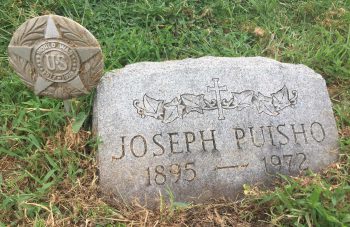
QUADRI (or QUARDI), JOSEPH (1897-1918). Wagoner, 14th New York State National Guard, Supply Company; private, 106th Infantry, American Expeditionary Forces, United States Army. A Brooklynite by birth, Quadri’s parents were both Italian immigrants. His father, Victor, was a stonecutter and his mother was a homemaker; Joseph had three siblings, Elizabeth, Andrew and Victor Jr. At the time of the 1915 New York State census, Joseph was a machinist’s apprentice and the family was living at 716 42nd Street in Brooklyn.
During World War I, Quadri enlisted as a wagoner with the 14th New York State National Guard on April 3, 1917, and was assigned to the Supply Company when he mustered in on July 23. On October 17, 1917, he was transferred as a wagoner to the Supply Company of the 106th Infantry, United States Army. His New York State Military Abstract indicates that he became a private on October 26 and then returned to the rank of wagoner on December 4, 1917. On January 15, 1918, he was transferred to Company A of the 106th Infantry as a wagoner and was sent overseas on May 10, 1918. He became a private on June 15, 1918. On October 9, 1918, he died in England as a result of wounds received in action during the Second Battle of the Somme. During that aforementioned battle, French and British troops had pushed the Germans back into German territory. Quadri’s division, the 27th, was absorbed into the 106th Infantry regiment, which was sent to reinforce British troops; both sides suffered many casualties. His father, Victor Quadri, was notified of his death. Sadly, his division was relieved on October 21, a few weeks after his death. He last lived at 716 42nd Street, Brooklyn.
After his body was returned to the United States, he was interred at Green-Wood on May 26, 1920. His monument is draped by a weeping willow tree and a female figure in mourning is kneeling over a portrait of a soldier in a doughboy uniform. The inscription on his stone reads, “He Bravely Gave His Life For The Cause Of His Country.” Section 124, lot 25575, grave 2.
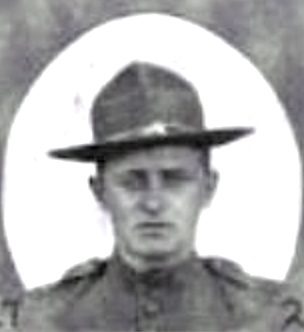


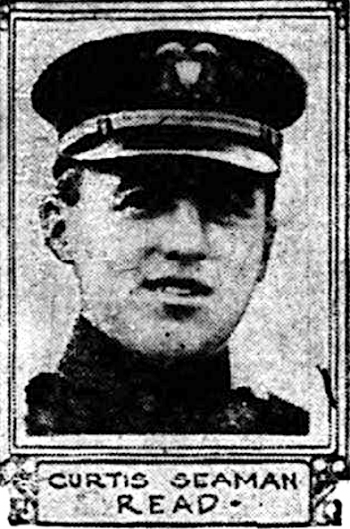
READ, CURTIS SEAMAN (or PEARMAN) (1895-1918). Ensign, United States Naval Aviation. Read is not buried at Green-Wood; a cenotaph honoring his memory is on the family’s plot. Read was born in Rye, New York. The 1900 census indicates that he lived at 4 East 62nd Street in Manhattan with his parents and siblings, including his brother Russell (see). William Augustus Read, his father, was prominent in Wall Street financial circles and was senior member of a banking firm that bore his name. Curtis Read was still living on East 62nd Street with his family at the time of the 1910 census. A member of the Yale class of 1918, his obituary notes that he had been an assistant manager of the football team, a member of Delta Kappa Epsilon fraternity, and had been “tapped” for membership in Skull and Bones, the exclusive society at Yale.
According to an article in Yale News by Amy Athey McDonald on August 17, 2014, Curtis (class of 1918) and Russell (class of 1920) joined the Yale Aero Club, in February 1917, after the United States broke ties with Germany; the club consisted of a group of well-heeled students who were interested in aviation and whose flight training was sponsored by Rodman Wanamaker, the department store magnate, who had just opened a flying school in Port Washington, Long Island. The Aero Club and the volunteer Coastal Patrol, first organized in 1916, subsequently became the First Yale Unit. As per his New York State Abstract for World War I Military Service, Read enlisted as an ensign on March 24, 1917, at New London, Connecticut; the Yale group was the Navy’s first air reserve squadron. The young pilots were called to active service on September 4, 1917, first to the Naval Operating Base at Hampton Roads, Virginia, and then to Palm Beach, Florida, for military training. The Yale group then returned to Huntington Bay, Long Island, where training was completed and deployment for overseas began.
During World War I, Curtis Read was an ensign in the United States Naval Aviation; his obituary notes that he was sent abroad in November 1917. On February 27, 1918, he died in Dunkirk (Dunkerque), France, and was buried there the next day. As per his obituary, he died in an air accident on the French front; the obituary, which acknowledged his daring while training at Palm Beach, surmised that the accident might have occurred on a search for submarines in the English Channel. That obituary confirms that Read was a member of the Yale class 1918 and was one of the first to volunteer for service in the Yale Hydro-Aeroplane unit; he was the first of the Yale Aero-Club to die in service abroad. The inscription on his cenotaph reads, “HE DIED TO MAKE THE WORLD BETTER FOR EVERYBODY.” Section 47, lot 12320.
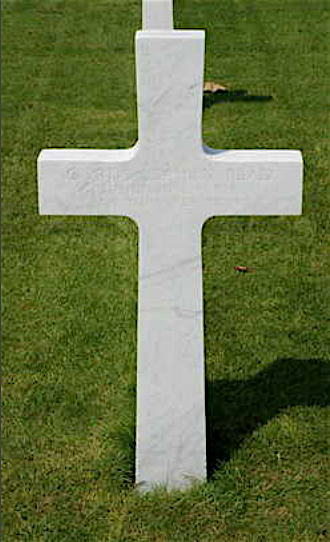

READ (or REID), NEWBURY FROST (or T.) (1887-1950). Seaman, 11th Regiment, United States Navy Reserve Force. The New York State census for 1915 reports that Read, a native of New York City, was married, lived in Manhattan and worked as a floor walker. As per his Abstract of World War I Military Service, he enlisted as a seaman at New York City on April 30, 1918, and was assigned to the Training Camp at Pelham Bay Park, New York; he lived at 200 West 56th Street in Manhattan at the time of his enlistment. Read was stationed at Pelham Bay from May 22 through October 30, 1918, and then was a patient at the Naval Hospital until November 11, 1918; records show that he was suffering from neurasthenia (physical and mental exhaustion). He was discharged at Pelham Bay Park on December 13, 1918.
The 1920 census shows that Read was married, lived on West 56th Street in Manhattan and was a real estate broker. As per his World War II Draft Registration Card, he lived at 57 West 52nd Street in Manhattan, had a home telephone, and worked at George R. Read & Company at 30 Nassau Street in Manhattan. He listed his contact person as Mrs. F. E. Storer (relationship unknown). On February 19, 1950, shortly after his death, Marie G. Read, his widow who lived at 277 Park Avenue in Manhattan, applied for a government-issued headstone, citing her husband’s service in the Navy Reserve Force during World War I. Section 47, lot 12330.
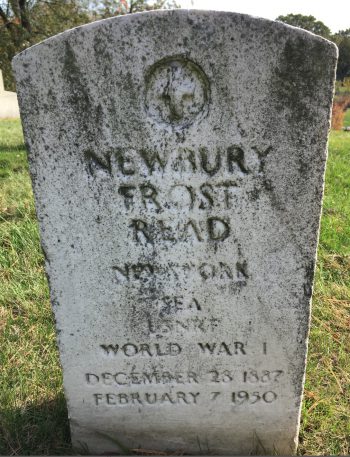
READ, RUSSELL BARLOW (or BARTON, R.B.) (1898-1931). Lieutenant, junior grade, United States Naval Aviation. Read was born in New York City; the 1920 census incorrectly states Massachusetts. According to the 1900 census, he lived at 4 East 62nd Street in Manhattan with his parents and siblings, including his brother Curtis (see). William Augustus Read, his father, was prominent in Wall Street financial circles, was senior member of a banking firm that bore his name, and was a director of many establishments in transportation, banking and insurance. As per the 1910 census, Read lived with his parents and siblings on East 62nd Street and attended school. At age 16, he attended Concord College in Concord, New Hampshire. According to an article in Yale News by Amy Athey McDonald on August 17, 2014, Russell (class of 1920) and Curtis (class of 1918) joined the Yale Aero Club in February 1917, after the United States broke ties with Germany; the club was comprised of a group of well-heeled students who were interested in aviation and whose training in flight was sponsored by Rodman Wanamaker, the department store magnate, who had just opened a flying school in Port Washington, Long Island. The Aero Club and the volunteer Coastal Patrol, first organized in 1916, subsequently became the First Yale Unit.
As per his New York State Abstract of World War I Military Service, Russell Read enlisted as an ensign at New London, Connecticut, with other members of the Yale Aero Club, on March 24, 1917. He was called to active duty in Naval Aviation at Hampton Roads, Virginia, on September 10, 1917. The prospective pilots were sent to Palm Beach, Florida, for military training, then returned to Huntington Bay, Long Island, where training was completed, and deployment for overseas began.
Russell Read served in France from December 1917 through May 1918; on June 1, 1918, he was promoted to lieutenant (provisional). Read then served in Italy from May 1918 through June 1919. His Military Abstract notes that he was awarded the Navy Cross for “distinguished and heroic service as a pilot of a seaplane engaged in patrolling the waters of the War Zone, escorting and protecting troops and cargo ships.” He was also awarded the War Cross by Italy. On January 21, 1919, he arrived in New York City aboard the Giuseppe Verdi which sailed from Genoa, Italy. After his release from active service in 1919, he was assigned to the Naval Air Station in Bay Shore, Long Island. Read was officially discharged in 1921 with the rank of lieutenant, junior grade.
The 1920 census reports that Read lived with his widowed mother and siblings on East 62nd Street in Manhattan, was single and was in school. When he applied for a passport in 1922, he was married to Hope Williams Read, lived at 145 East 52nd Street in Manhattan, and indicated that he was a law student; the couple planned to travel for pleasure and study to Europe aboard the Olympic as of June 3, 1922. After his divorce in 1928, he was a boarder on East 79th Street in Manhattan in 1930; the 1930 census reports that he was a hospital doctor and World War veteran. On September 27, 1931, he died, along with two others, in a crash of his private plane in Montgomery County, near Amsterdam, New York. His death was attributed to a crushed skull. Section 47, lot 12320.

REDMOND, JAMES MURRAY (or MURRAY JAMES) (1896-1938). Sergeant, 135th Machine Gun Battalion, American Expeditionary Forces, United States Army. A native of Pittsburgh, Pennsylvania, Redmond was a resident of Youngstown, Ohio, when he enlisted in the Ohio National Guard on June 30, 1914. As per Ohio Records of Soldiers in World War I, he served as a private in the 135th Machine Gun Battalion, was promoted to private first class on November 9, 1917, and to sergeant on April 1, 1918. Yakel was shipped overseas on June 15, 1918, as a part of the 37th Division and took part in the battles at Ypres-Lys and Meuse Argonne. He was detached to a Field Hospital from August 3 through August 31, 1918. After his overseas duty ended on March 25, 1919, he returned to the United States and was honorably discharged on April 9, 1919.
As per the 1920 census, Redmond was single, worked in an accounting office, and was a boarder in Brooklyn; that census states incorrectly that he was born in New York. Redmond is listed on the New York State Voting List for 1924 as living at 159 Madison Street in Brooklyn. The 1930 census, which lists him as Murray Redmond, indicates that he was married, lived at 127 68th Street in Brooklyn, owned a radio set, worked as a window dresser in the retail drug industry and was a veteran of the World War. In January of 1937, Redmond and his wife, Bessie, sailed on the Monarch of Bermuda; he was listed as Murray J. Redmond on the passenger manifest. Redmond died in Pittsburgh on September 10, 1938, where he was a display manager for the Liggett Drug Company. His death certificate, filed in Allegheny County, reported that Murray James Redmond, who lived at 2320 Potomac Avenue, was married and died from a coronary occlusion; that document states that his history of heart disease dated from January 10, 1938. According to his obituary in the Brooklyn Daily Eagle, American Legion services were scheduled for his burial at his family’s plot at Green-Wood. On October 20, 1938, a month after his death, Bessie Redmond, his widow who lived at 85 Gelston Avenue in Brooklyn, applied for a government-issued marker, citing her husband’s service in the 135th Machine Gun Battalion. Section 174, lot 21443, grave 5.
REEVE, JAMES BIRMINGHAM (1892-1944). Mess sergeant, 106th Infantry, Company G; American Expeditionary Forces, United States Army; corporal, 23rd Infantry, Company G, New York State National Guard. Born in Flatbush, Brooklyn, Reeve’s father died when he was four years old. He was educated in Brooklyn and completed the 8th grade. The censuses of 1900 and 1905 note that he lived with his mother, brother and grandfather. The 1910 census lists him as single and residing at 474 East 2nd Street, Brooklyn; at that time, he worked as a clerk at an insurance company. On December 14, 1914, he enlisted in the New York State National Guard and was assigned to Company G of the 23rd Infantry Regiment. His application described him as 5′ 5″ tall with blue eyes and black hair. He participated with his regiment in the Mexican Punitive Campaign as a private as of July 1, 1916, was promoted to corporal on November 20, 1916, and mustered out with his company at Brooklyn on January 17, 1917.
The application for Reeve’s government-issued headstone indicates that he was in federal service as of March 3, 1917. On April 18, 1917, he was promoted to mess sergeant. On May 10, 1918, his unit went overseas where it became Company G of the 106th Infantry, United States Army, assigned to the 27th Infantry Division. The unit saw action at the Ypres-Lys Offensive and the Second Somme Offensive. Reeve remained with his unit until they returned to the United States on June 7, 1919, and was honorably discharged on June 11.
The 1920 census indicates that Reeve was married and lived with his wife’s family on East 19th Street in Brooklyn. As per the census of 1930, the Reeves had moved to their own home at 11 Orchard Avenue in Emerson, New Jersey, which was valued at $10,500, and had three children. He noted that he owned a radio set, could read and write, was a World War veteran, and was working as a clerk for a railroad. The 1940 census reports that they still resided on Orchard Avenue; the value of the home was listed at $4,000. At that time, Reeve worked as a transfer agent and had earned $3,600 that year. His World War II Draft Registration Card of 1942 lists his employer as the Great Northern Railway Company, headquartered at 2 Wall Street, Manhattan, where he was working in the treasurer’s office. He died from tuberculosis. On October 22, 1945, his widow, Helen Reeve, who still resided at the Emerson Avenue address, applied for a government-issued headstone citing her husband’s service in the 106th Infantry during World War I. Section 67, lot 2191.
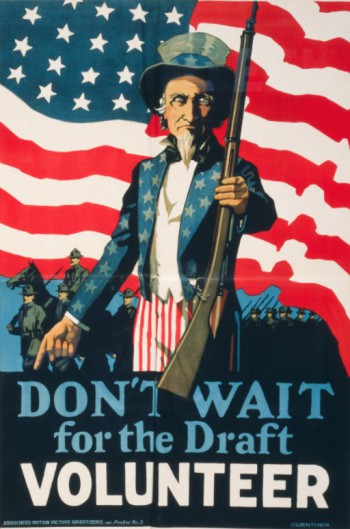

RICH, HENRY C. (1898-1918). Private, Quartermaster Corps, Recruit Education Center, United States Army. Born in New York City, the New York State census of 1915 shows Rich to be living in the Bronx with his stepparents and younger siblings. He was inducted into the Army on May 29, 1918, at Fort Slocum, New York, and assigned as a private to the Quartermasters Corps, Recruit Education Center. Rich was killed by lightning on June 14, 1918, apparently while in training at Camp Jackson in Florida. His remains were returned to New York and he was interred on June 22, 1918. His last residence was 6 Gouverneur Place in the Bronx. Section 207, lot 32609.

RICHARDS, PHILO HOTCHKISS (1887-1918). Private, 114th Infantry, Company F, American Expeditionary Forces, United States Army. A Brooklynite by birth, he lived there with his parents and siblings at the time of the 1910 census; at that time, he was employed as a clerk at a brokerage firm. According to his 1917 Draft Registration Card, he was of medium height, slender build, with brown hair and brown eyes; he was single and working as a clerk at the American Sugar Refinery Company offices at 117 Wall Street. Richards also reported that he had served as a private for five years with the New York State Militia. He was inducted into the Army on May 3, 1918, at Brooklyn, and was assigned to the 114th Infantry as a private. Richards was sent overseas on June 15, 1918, and died of pneumonia in France on October 7, 1918. His mother, Alice Richards, was notified of his death. His last address was 891 Sterling Place, Brooklyn. After his remains were returned to the United States, he was re-interred on May 27, 1921. Section 91, lot 8997, grave 1.
RICHMOND, HENRY C. (1898-1983). Gunner’s mate third class, United States Navy. The census of 1910 reports that Richmond, who was born in Manhattan, lived at 160 Maywood Avenue in Midland, New Jersey, with his parents and sibling and was in school. The 1915 New Jersey State census lists him at the same address and referred to his occupation as “scholar.” His Department of Veterans Affairs records indicate that he served in World War I; that record shows that Richmond enlisted on October 5, 1917, and was discharged on April 17, 1919. His gravestone confirms that he served in the United States Navy. Section 141, lot 27091.
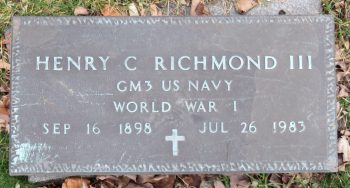
ROBERTS, CARLTON DEWOLF (1886–1918). Private, 3rd Company, 1st Provisional Recruiting Battalion, 152nd Department of Brigade, American Expeditionary Forces, United States Army. A native of Brooklyn, the 1915 New York State census lists him as single, a salesman, and living with his parents and siblings. Roberts registered for the draft on June 5, 1917, claiming exemption for ill health; nevertheless, he was drafted on November 3, 1917, at age 31. Roberts served in France and died on January 17, 1918, of wounds he sustained in the Battle of Villers-Tournelle. His last residence was 54 Bedford Avenue in Brooklyn. His body was returned to Brooklyn and he was interred on March 21, 1921. Section 194, lot 27564.

ROBERTS, ROYAL (or ROSEL) ROBINSON (1881-1937). Sergeant, 56th Artillery, Battery F, American Expeditionary Forces, United States Army. As per the records of the United States Dutch Reformed Church, Roberts was baptized at Prospect Hill Church in Manhattan on June 26, 1881, when he was four months old. His parents were Christopher H. Roberts and Anne Mary née Brice.
As per records of the Marine Corps, Roberts enlisted as a private on November 12, 1905 and mustered in the next month. His service in the Marine Corps terminated on December 11, 1909. The 1915 New York State census reports that he was living with his mother in Manhattan. He is listed on the manifest of the Mexico on April 29, 1911, as arriving in New York City from Havana, Cuba.
The Connecticut Military Census of 1917, filed in February of that year, was completed by Roberts for the City of Bridgeport. He noted that he resided at 843 Stratford Avenue, was a clerk, and was single with no dependents. He indicated prior military service for four years in the Marine Corps (first sergeant), two years in the Connecticut Militia (sergeant), and three years in the New York Militia. In his aforementioned service with the New York National Guard, he was with the 2nd Division, 1st Engineers as of September 22, 1903 and ended that service on January 12, 1906. In addition, he noted that he was a seaman. At that time, he was 70½” tall and 180 pounds, could handle a team of horses, did not drive a car and was a good swimmer.
Roberts, identified as a sergeant in the 56th Artillery, Battery F, is listed on the manifest of the USS Olympic sailing for Europe from New York City on March 28, 1918, as a part of the American Expeditionary Forces. He named his mother as the next of kin and gave his address as 100 Hamilton Place in New York City.
The State of Connecticut published a Military Service Questionnaire in 1919-1920 to honor those who served in World War I. Roberts verified his birth in New York City and noted that he was a voter and member of the Dutch Reformed Church. He stated that he belonged to the Imperial Order of Redmen, the Loyal Order of the Moose and the Sons of St. George. In addition to the two years in the Connecticut Militia that he reported in February 1917, he noted additional service from March 6, 1917 through August 4, 1918.
The 1920 census notes that Roberts was living as a boarder in Bridgeport Ward 6 in Fairfield, Connecticut. He was single and was employed as a cost clerk in the valves industry. The 1921 Mount Vernon Directory identifies him as a clerk. According to the 1925 New York State census, he was living with his mother in Mount Vernon, New York, and was single. At the time of the 1930 census, he was single and was living in the Bronx in a rental at 2415 Morris Avenue and owned a radio set. As per the 1930 Mount Vernon Directory, he was a superintendent living at 239 South 5th Avenue.
Roberts was awarded an R. & Bar (5) Medal on June 1, 1934, for his service as a master sergeant in the Headquarters Department of the 27th Division, New York National Guard. He served in the New York National Guard from December 12, 1920 through December 10, 1936, with periodic honorable discharges and simultaneous enlistments during that time. National Guard Records lists a date of death of October 11, 1937 for Roberts. His last assignment was in the 106th Infantry, 27th Division, Brooklyn Staff Army. He died from a fractured skull in Peekskill, New York, in an automobile accident. His last address was 319 Clark Avenue in Staten Island. His wife was Marian Elizabeth Roberts. Section 57, lot 3576.
ROBERTS, WALTER EDWARD (1892-1968). Rank unknown, Army Engineers, American Expeditionary Forces, United States Army. Roberts was born in Ruabon in Denbighshire, North Wales, Great Britain. As per his obituary in the Central New Jersey Home News [New Brunswick], he immigrated to the United States in 1913. His World War I Draft Registration Card, filed in Perth Amboy, New Jersey, on June 5, 1917, describes him as being of medium height and build with light blue eyes and brown hair. He recorded his name as W. Edward Roberts and noted that he lived at the YMCA on Jefferson Street in Perth Amboy. At that time, he was single, worked as a watchmaker for L.C. Stark in Perth Amboy and was in the process of applying for citizenship. As per his granddaughter, Brenda Roberts Caretta, he served in World War I. His obituary confirms his World War I service with Army Engineers in France.
In civilian life, he owned Roberts Jewelers in Perth Amboy for many years. Among the many organizations to which he belonged were the Freemasons, Benevolent and Protective Order of Elks, Post #45 of the American Legion, the Perth Amboy Rotary Club, Last Man Club of World War I, Retail Jewelers Association, and the Caldwell Consistory of the AASR (Ancient Accepted Scottish Rite) of Bloomsburg, Pennsylvania (a Freemasonry association). In addition, he had been at one time a trustee of the First Presbyterian Church of Perth Amboy.
Roberts’s World War II Draft Registration Card, filed in 1942, reports that he lived at 26 Market Street in Perth Amboy, had a home telephone and was self-employed at Roberts and Lieberman in his hometown. His wife was listed as his next of kin. According to his obituary, he last lived at 26 Market Street and died after a long illness. He was survived by his wife, Minnie, a son who bore his name, and two grandchildren. Two sisters also survived him, one who lived in England and the other who lived in Wales. His funeral was held at the Koyen Funeral Chapel in Perth Amboy. Section 163, lot 15963.
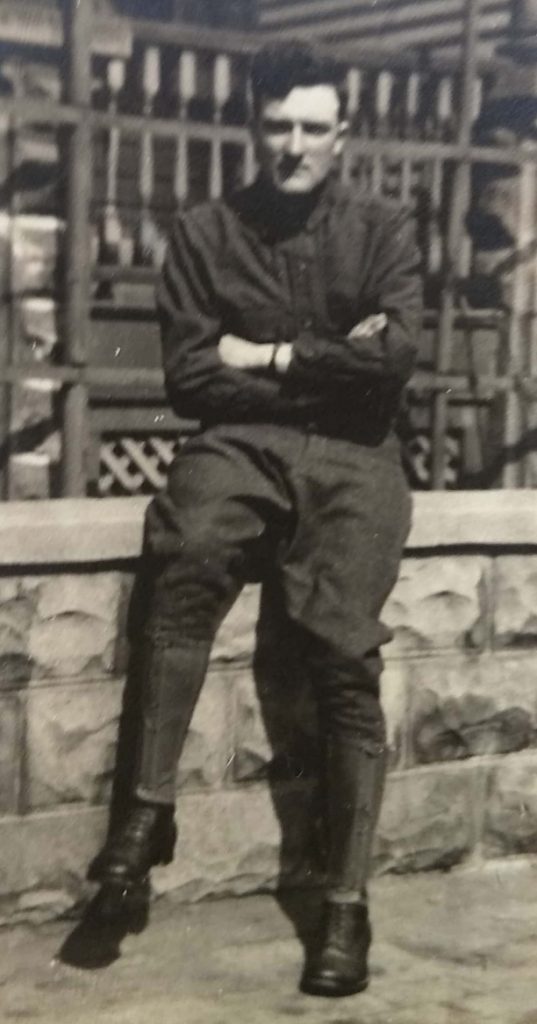
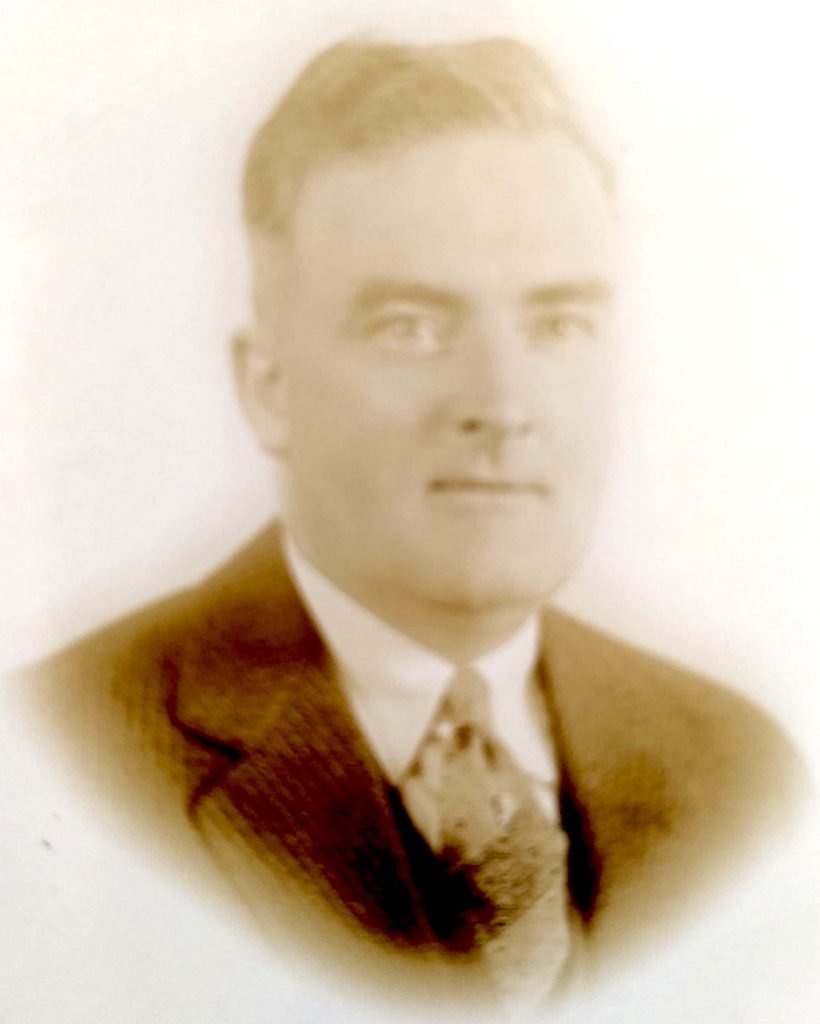
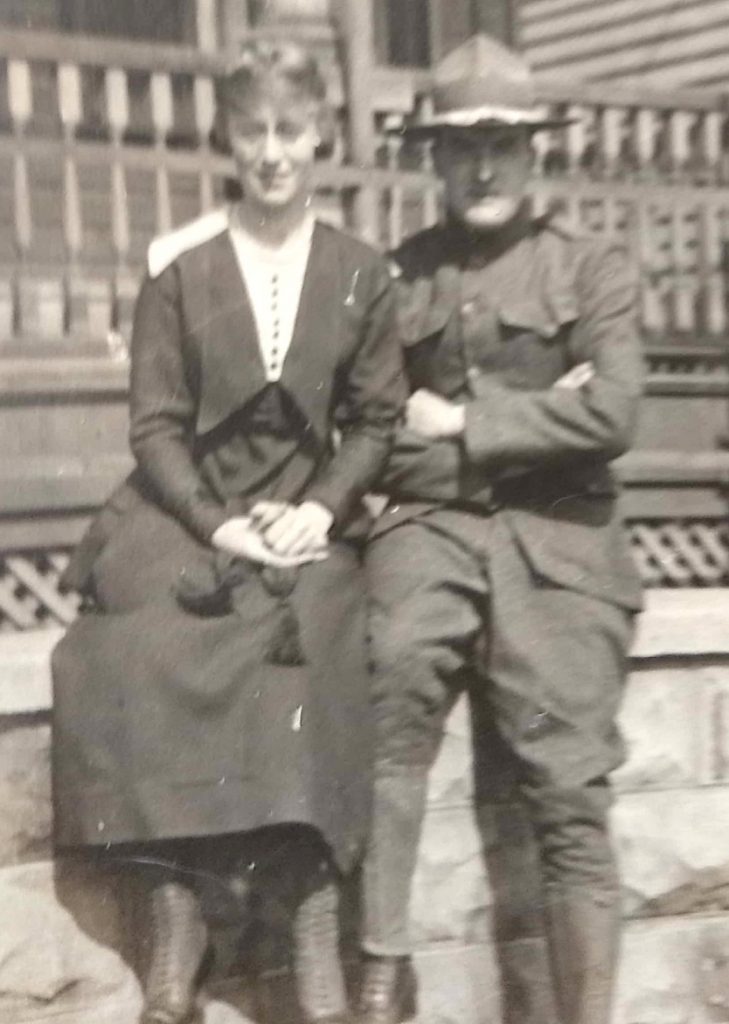


ROBERTSON, ALBERT (1894-1963). Fireman apprentice, United States Navy. Robertson was born in Brooklyn. The 1910 census reports that he lived with his parents and siblings on Douglass Street in Brooklyn and worked as an apprentice in a brick factory. The 1915 New York State census indicates that he lived in Brooklyn with his parents and siblings and worked as a shipping clerk. Robertson’s Draft Registration Card for World War I, filed on June 5, 1917, shows that he lived in Brooklyn, was single, and worked as a tinsmith. He described himself as tall, of medium build with blue eyes and light hair. Robertson’s gravestone shows his military service with the inscription of F2, United States Navy, World War I; that designation means fireman apprentice, second pay level. No other details are known.
As per the census of 1920, Robertson lived as a boarder on Hewes Street in Brooklyn and worked as a commercial salesman. The 1925 New York State census indicates that he was single and lived with his parents and siblings in Brooklyn. His World War II Draft Registration Card, filed in 1942, reports that he lived with his wife at 1345 Bushwick Avenue in Brooklyn and was employed by Ebinger’s Bakeries at 2290 Bedford Avenue in Brooklyn. He died at Evangelical Deaconess Hospital in Brooklyn. Section 68, lot 2301.
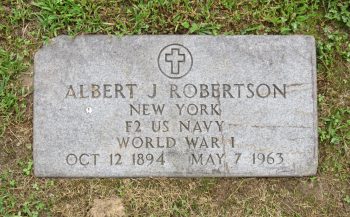
ROBINSON, EDWARD HERMAN (1893–1918). Second lieutenant, Headquarters Company, Camp Taylor, Kentucky, United States Army. A native of New York City, Robinson was a laborer in the brass works industry, according to the 1910 census. While serving in Headquarters Company at Camp Taylor, Kentucky, he succumbed to influenza on October 12, 1918. He last lived in Great Neck, New York. Section 70, lot 4020.
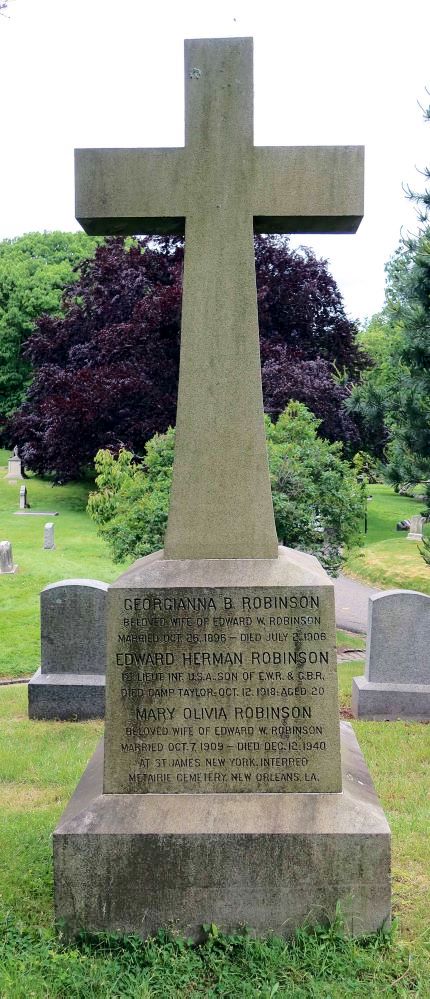
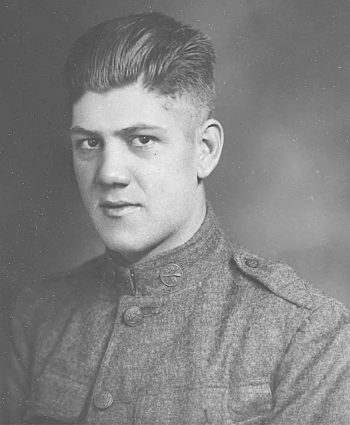
ROHRBACH, EDWARD PAUL (1895-1948). Private, 302nd Field Artillery, Battery D; 304th Infantry, Company B; Headquarters Troop, 3rd Army Corps, American Expeditionary Forces, United States Army. Rohrbach was a native of Manhattan. According to his Draft Registration Card, filed in Brooklyn on June 5, 1917, he lived at 1833 73rd Street and worked as a water inspector. On that document, he noted that his parents were dependent upon him for support and described himself as 5′ 9″ tall, of medium build with brown eyes and black hair. Rohrbach married Margaret Deinzer in Manhattan on March 5, 1918. As per his New York State Abstract of Military Service for World War I, he was inducted at Brooklyn as a private on April 28, 1918, first assigned to Battery D of the 302nd Field Artillery until June 4, 1918, and then assigned to Company B of the 304th Infantry. Rohrbach was shipped overseas on July 8, 1918, and transferred to the Headquarters Troop of the 3rd Army Corps on August 3, 1918. On May 18, 1919, he left Bordeaux, France, on the Santa Clara and arrived in Brooklyn on May 30; the passenger manifest notes “special discharge.” He was honorably discharged on June 4, 1919, upon demobilization of his unit; he suffered no wounds during his service.
At the time of the 1920 census, Rohrbach was married and lived with his in-laws in Manhattan at 450 West 50th Street; he was working as a salesman for the Electric Company. The 1940 census reports that he was married with one son, lived in a rental at 139 28th Street in North Bergen, New Jersey, had completed high school, worked as a clerk, and had earned $2,200 in 1939. Rohrbach’s World War II Registration Card, filed in 1942, indicates that he lived at 141 72nd Street in North Bergen, New Jersey, had a home telephone, was married and worked for the Electric Service Engineering Corporation at 1450 Broadway in New York City. He last lived in Teaneck, New Jersey. Section F, lot 18865.

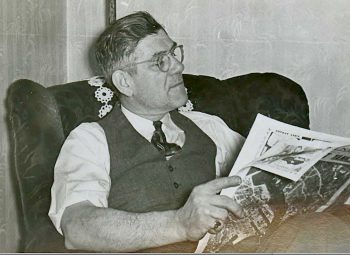
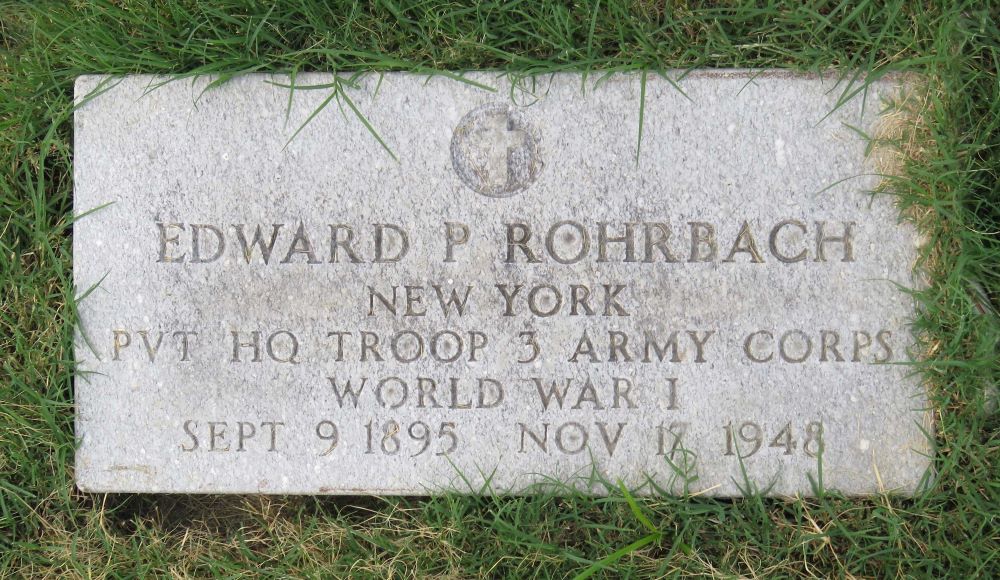
ROOSEVELT, JAMES ALFRED (1885-1919). Major, American Expeditionary Forces, United States Army. Roosevelt was born in New York and was a cousin of President Theodore Roosevelt. His obituary in the American Electric Railway Association periodical of July 1919 reports that he graduated from Harvard College in 1905, and then trained at electric companies in Boston, Tampa, and Seattle. Roosevelt then became general superintendent of the Third Avenue Railway Company in New York City. He next worked as manager of transportation at the British Columbia Electric Company, Ltd., of Vancouver, Canada, until 1913. Upon his return to New York, he partnered with an associate from British Columbia, and was a consulting engineer at the firm of Roosevelt & Thompson at 71 Broadway in Manhattan. His expertise was in electric transportation.
According to The Harvard Graduates magazine (Volume 27), Roosevelt was commissioned captain at the third Plattsburgh (New York) Camp on August 11, 1917, and went to Camp Upton on September 10. At the latter camp, he was put in command of C Company of the 302nd Ammunition Train, 77th Division, and was sent to France in April 1918. He was made supply officer of the 308th Infantry, 77th Division, on September 4, 1918. The Harvard Alumni Bulletin of September 26, 1919, notes that he was promoted to major on November 20, 1918, for gallantry in carrying ammunition to the front under heavy fire. On March 26, 1919, about two days before his scheduled return from service with the American Expeditionary Forces in France to New York, he took ill and died from spinal meningitis on board the transport USS Great Northern. His Harvard classmates remembered him as a loyal companion who had a host of friends. As per his obituary in the American Electric Railway Association, Roosevelt “was not only a successful railway operator and engineer but a brave and efficient soldier.” His service record indicates that he was awarded a silver star and that he served at Argonne. He last lived on Park Avenue in Manhattan. His uncle, W. Emblem Roosevelt, was notified of his death. Section 177, lot 24694.
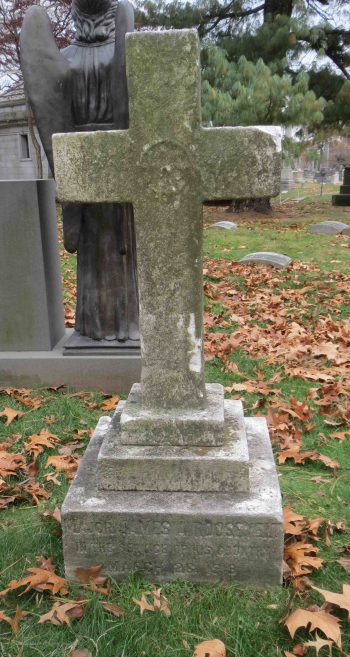
RUBERG, ARTHUR OLAF (1901-1918). Private, 14th New York State National Guard, Company F; 106th Infantry, American Expeditionary Forces, United States Army. Born in Brooklyn, Ruberg was baptized there at Our Savior’s Lutheran Church. During World War I, he mustered into the 14th New York State National Guard on July 21, 1917, and was fined for being AWOL from September 27 -29, 1917. Ruberg was sent overseas with the 106th Infantry on June 7, 1918. The 106th Infantry grew out of the 23rd New York Regiment and was strengthened by reinforcements from the 14th Regiment. On September 27, 1918, he was killed in action. Mrs. Elias Ruberg was notified of his death. His last address was 300 60th Street, Brooklyn. After his body was returned to the United States, he was re-interred at Green-Wood on April 8, 1922. Section 134, lot 29725, grave 624.
RUDERSHAUSEN (OR RUDENHAUSEN, RONSHAUSEN, RUDERSHAWSEN), GEORGE EDWARD (1894-1961). Machinist mate second class, United States Navy. Rudershausen was born in New York City. As per his Draft Registration Card, filed in New York City on June 5, 1917, he was single, worked as a roofer, and was of medium height and build with gray eyes and brown hair. He enlisted as a fireman third class on August 10, 1917, at the receiving ship at Philadelphia, Pennsylvania; at the time of his enlistment, he was living at 76 Barrow Street in Manhattan. He was assigned to the USS Minneapolis on August 29 and served on it until November 11, 1918, during which time he was promoted to fireman second class and then fireman first class. The application for his government-issued headstone indicates that he was awarded the Victory Medal for the Atlantic Fleet Clash. Rudershausen was honorably discharged on September 10, 1919, at New York City with the rank of second class machinist’s mate.
The census of 1920 reports that Ruderhausen was single, lived with his brother on Barrow Street in Manhattan and worked as a fireman in the building industry. The 1930 census indicates that he was married, lived at 471 Pascack Road in Ramapo, New York, had no home radio set, worked as a fireman for the Flintcote Company, and was a World War veteran. On June 7, 1961, Anne K. Bingham, his niece, applied for a government-issued headstone citing her uncle’s World War I service in the Navy. Section M, lot 21342.
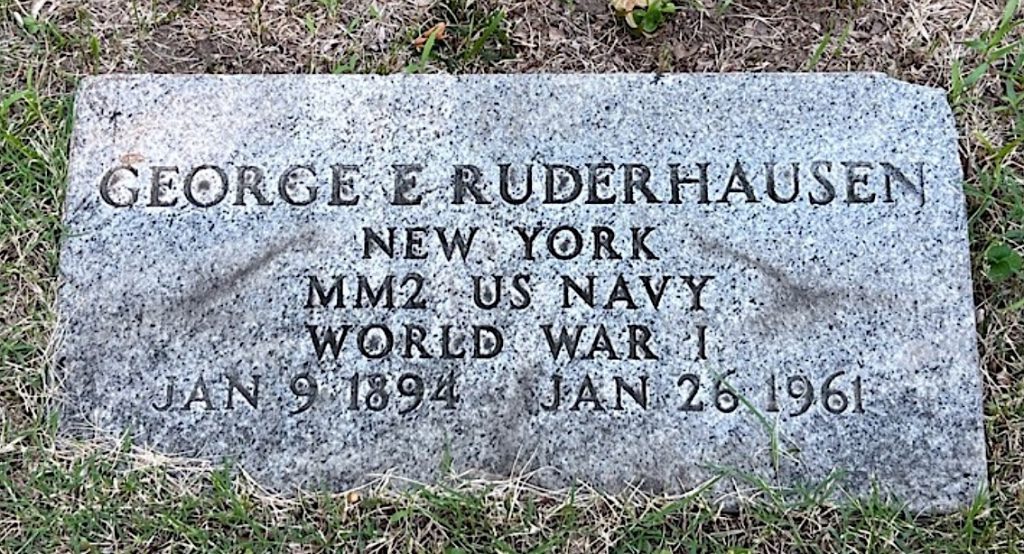
RUSCH, JR., FRED (1894-1924). Private, 302nd R.U.M.T. Corps, United States Army. A native of New York, the 1910 census indicates that Rusch lived with his parents and brother on Stockholm Street and was employed as a stenographer. As per the inscription on his gravestone, he served as a private in the 302nd R.U.M.T. Corps from January 4, 1918 to July 6, 1919. The 1920 census indicates that he lived with his parents and siblings on Eldert Lane in Brooklyn and worked as a dairyman His brother, William H. Rusch (see), also served in World War I. Section J, lot 34169.
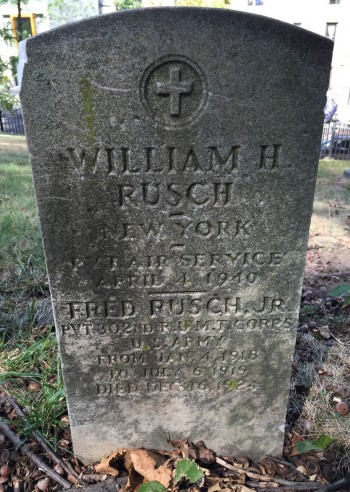
RUSCH, WILLIAM H. (1897-1940). Private, 59th Provisional Recruiting Squad, 64th Recruiting Squad, 109th Aero Squad, United States Army. A native of Brooklyn, William Rusch was the brother of Fred Rusch (see). During World War I, he enlisted as a private in the United States Army at Fort Slocum, New York, on December 27, 1917. As per his application for a government-issued headstone, he was assigned to the Flying School Detachment at Carlstrom Field, Florida. His soldier record indicates that before that assignment to the 109th Aero Squad on March 24, 1918, he was with the 59th Provisional Recruiting Squad until February 4, 1918, and then with the 64th Recruiting Squad. On June 18, 1918, he was listed as unassigned; he did not serve overseas. On June 17, 1919, he was honorably discharged.
The census of 1920 indicates that Rusch was single and was a boarder in Manhattan; at that time, he was a sorter at a dress house. He died in the Bronx. On June 22, 1940, Elizabeth Rusch, who lived at 1255 Yates Avenue in the Bronx, applied for a government-issued headstone, citing Rusch’s service in the World War. Section J, lot 34169, grave 3.

RUSHMORE, JAQUES (or JACQUES) CORTELYOU (1875-1949). Lieutenant, Medical Corps, United States Naval Reserve Force. Rushmore was born in Brooklyn. On his passport application of June 1, 1903, he described himself as 5′ 8″ tall with a high forehead, auburn hair, fair to florid complexion, long and thin face, brown eyes, Roman nose, oval chin, and medium mouth. According to the 1910 census, he was a physician with a general practice and lived with his parents at 477 Washington Avenue in Brooklyn. As per the New York Abstract of World War I Military Service, Rushmore was a lieutenant (junior grade) in the Military Reserve Corps as of August 10, 1916 through March 11, 1917. On March 12, 1917, he enrolled as a lieutenant in the Medical Corps of the United States Naval Reserve Force. On September 8, 1917, he entered the service, working at the Brooklyn Navy Yard at Navy Base Hospital Unit #1, part of the Navy’s 3rd district. This hospital was founded in 1830 and was one of the oldest Naval hospitals in the United States. He was stationed there for the remainder of his active duty. Rushmore went on inactive duty on February 3, 1919, and resigned from the Navy on March 3, 1920.
According to the 1920 census, Rushmore was listed as head of his household and lived with his two sisters; he had resumed his private medical practice. The 1930 census reports that he had been married five years, owned his house at 477 Washington Avenue which was valued at $40,000, was a doctor at his home address, and was a veteran of the World War. In 1930 the Rushmores traveled to Puerto Rico aboard the Falcon. The 1940 census reports that he and his wife lived at the same address; the value was noted as $18,000. That census noted that he had completed more than a college education. On April 25, 1950, Alice Rushmore, his widow, applied for a government-issued headstone, citing her husband’s service in the Naval Coast Defense Reserve. At that time she was living in Stormville, New York. Section 64, lot 2473.
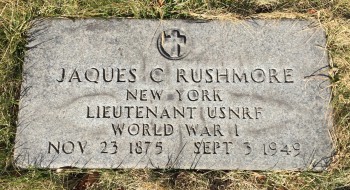
SANDS, RAY (or RAYMOND) (1893-1935). Private, 152nd Depot Brigade, Company 8; 303rd Infantry, Company H; 116th Infantry, Company K; 4th Engineers, Company D, American Expeditionary Forces, United States Army. A Brooklyn native, Sands resided at 77 18th Avenue in Long Island City, New York, when he filed his World War I Draft Registration Card on June 5, 1917. At that time, he worked as a guard and described himself as of medium height and build with blue eyes and brown hair. He was inducted as a private into the 152nd Depot Brigade, Company 8, on April 30, 1918. On May 19, he was assigned to Company H of the 303rd Infantry and was shipped overseas on July 7, 1918. Sands was transferred to the 116th Infantry on August 5, 1918, and then to Company D of the 4th Engineers on September 6. He was slightly injured on September 29, 1918, and ended his overseas duty on December 28, 1918. His soldier records indicate that he had a 10 percent disability when he was honorably discharged on February 13, 1919.
The 1920 census indicates that Sands lived on Cypress Avenue in Queens with his parents and sibling and worked as a clerk on the D Train; the 1925 New York State census reports that he was single and worked as a fireman. On November 23, 1927, Sands married Hannah Schubert in Manhattan. The 1930 census notes that he had been married three years, owned a house in Queens valued at $7,000, had a radio set, and worked as a fireman. On August 24, 1935, he died while in the line of duty as a New York City firefighter. On May 12, 1936, Emma Sands of 155-16 43rd Avenue in Flushing, New York, applied for a government-issued headstone with Christian emblem, citing her son’s service in the 4th Engineers. Section 58, lot 6883.

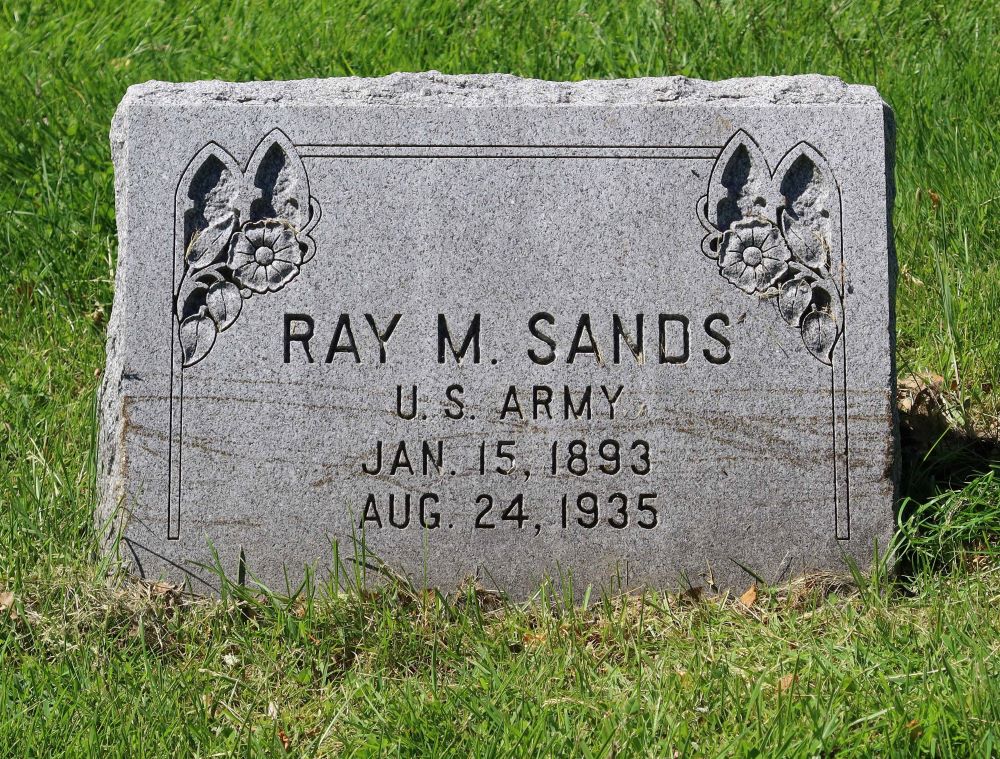
SARLO, WILLIAM (1895-1918). Private, 152nd Depot Brigade, Company 3; 310th Infantry, Company C, 78th Division, American Expeditionary Forces, United States Army. A native of Brooklyn, the 1915 New York State census lists Sarlo as a drug clerk living with his parents and siblings in Brooklyn. His Draft Registration Card of June 1917 indicates that he was a pharmacist of medium height and slender build with brown eyes and black hair. On April 1, 1918, Sarlo was inducted into the Army and assigned to Company 3 of the 152nd Depot Brigade until he was transferred to Company C of the 310th Infantry on April 16, 1918. The 310th Regiment was part of the 78th Infantry Division which was activated on August 23, 1917, at Camp Dix, New Jersey. On May 19, 1918, Sarlo shipped out to France, where his division fought in three major engagements: Meuse–Argonne, St. Mihiel and Lorraine. His New York State Abstract of World War I Service shows that he was engaged at the occupied outpost line near Thiaucourt, France. Sarlo died of wounds he received in action on September 19, 1918. His last residence was 426 35th Street in Brooklyn. His body was returned home in 1921 and was re-interred on July 14, 1921. Section 4, lot 35282, grave 2.
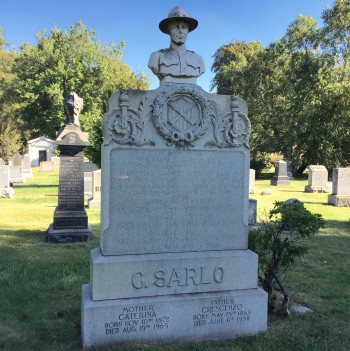
SCHENCK, VAN BRUNT (or VAN BUNT, VANBUMB, VAN BRENT) (1891-1933). Sergeant first class, 47th Aero Squadron, Enlisted Reserve Corps, United States Army. Born in Brooklyn, Schenck’s Draft Registration Card of June 5, 1917, shows him to be single, slender and of medium height with brown hair and blue eyes; at that time, he worked as a bookkeeper. On that card, he claimed an exemption, noting that he has been recommended for the Signal Reserve Corps as sergeant first class and was waiting to hear from Washington, D.C. At that time, he lived at 5515 Church Avenue in Brooklyn. According to Schenck’s World War I Military Abstract, he enlisted as a sergeant first class in the Enlisted Reserve Corps at Mineola, Long Island, on June 13, 1917, and was assigned to the Aero Squadron. He did not serve overseas, married on January 3, 1918, and received an honorable discharge with ten percent disability on April 10, 1919.
The 1920 census reports that Schenck was married and living on Maple Court in Brooklyn and working as an auto mechanic. The 1930 census shows him living with his wife on Avenue J in Brooklyn, where the rent was $68 per month, employed as an inspector in the auto industry; that document also notes that he owned a radio set, was a World War veteran, and could read and write. He last lived at 6 Winwood Court in Islip, New York; he died from septicaemia at South Side Hospital in Bayshore, New York. On October 29, 1933, three months after his death, Etta Schenck, his widow, applied to the War Department for a government-issued headstone, citing her husband’s service in the 47th Aero Squadron. Section 197, lot 30501.

SCHROEDER, THEODORE A. (1894-1918). Private, 2nd Battalion, 7th Company. 152ndDepot Brigade, United States Army. A native of Brooklyn, Schroeder’s Draft Registration Card of June 5, 1917, lists him as single, tall, of medium build, with blue eyes and brown hair. On July 24, 1918, he was inducted into the Army as a private and assigned to 7th Company, 2nd Battalion, 152nd Depot Brigade. While at Camp Upton on Long Island, New York, Schroeder contracted both influenza and pneumonia and passed away on October 2, 1918. His last residence was 397A Prospect Avenue in Brooklyn. Section C, lot 35970.
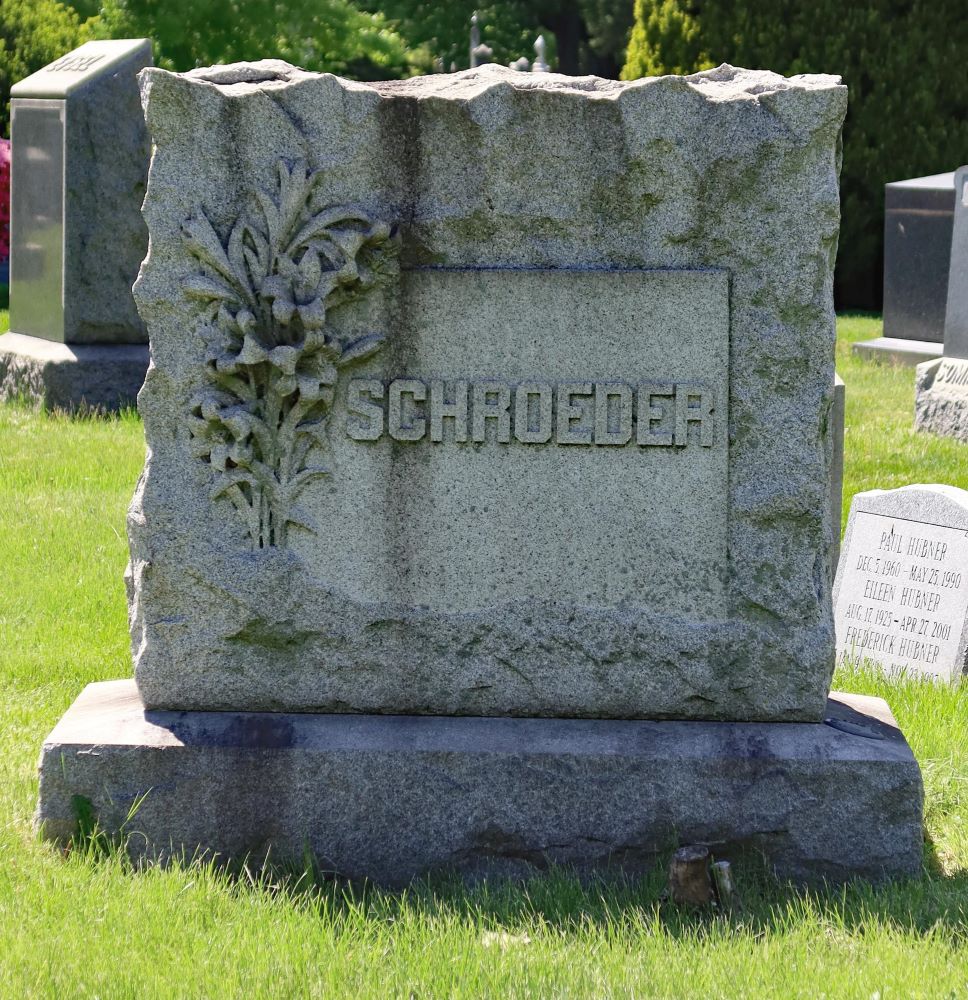
SCHULTES (or SCHULTZ), NICHOLAS (1895-1918). Corporal, 107th Infantry, Company I (formerly the 7th Regiment, New York State National Guard), American Expeditionary Forces, United States Army. Schultes was born in Brooklyn. As per his obituary in the Brooklyn Daily Eagle, his paternal grandfather, Sergeant John J. Schultes of the old 15th Regiment, and his maternal grandfather, Major A. Kline of the Confederate Army, fought on opposite sides during the Civil War. At the time of the census of 1900, which spelled the family surname as Schultz, he lived with parents and siblings at 391 Chester Street in Brooklyn. The 1910 census reports that he lived with his parents and siblings on Dasher Street in Brooklyn. As per the New York State census of 1915, he lived with his parents and siblings in Brooklyn and worked as a shipping clerk. His obituary notes that he was a graduate of P.S. 108 in Brooklyn and had attended the Brooklyn Evening High School for Men for five years; at the time of his enlistment, he was an adjuster in the shoe department of the Charles Williams Stores.
During World War I, Schultes enlisted as a private at New York City on May 11, 1917, and mustered into Company I of the 7th Regiment, New York National Guard on July 25. He was promoted to private first class on October 12, 1917, and sent for training to Spartanburg, South Carolina, where he mustered into the 107th Infantry (the new designation of the 7th Regiment); two months later, on December 14, he was promoted to corporal. His New York State Military Abstract reports that he was sick in the Base Hospital at Fort Wadsworth, South Carolina, from February 15 through February 19, 1918.
Schultes was shipped to France from Newport News, Virginia, aboard the Susquehanna on May 9, 1918; at that time, his address was 1984 East 9th Street in Brooklyn. The 107th was part of the 27th Division. Schultes died while fighting along the Hindenburg Line on September 29, 1918. His mother, Ida Schultes, died while he was in service.
He was at first interred in France. After his body was brought back, services commemorating his sacrifice were held in Brooklyn. An article on Schultes’s funeral in the Brooklyn Daily Eagle noted that he was buried with military honors at Green-Wood on April 3, 1921. Services were conducted by Reverend Carl Podin of the Seamen’s Institute, who had been the chaplain of his regiment. Comrades from his regiment were in attendance. Section 83, lot 2350.
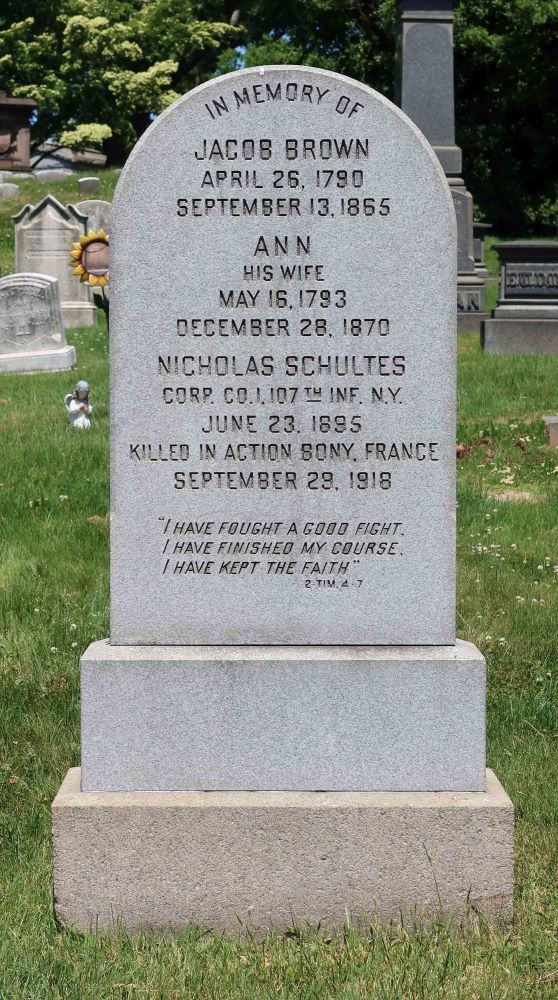
SCHULTZ, WILLIAM H. (1895-1918). Fireman third class, 6th Division, 2nd Battalion, United States Navy. Schultz was born and raised in Brooklyn. According to the New York State National Guard Service Cards, he enlisted in the 2nd Battalion, 6th Division, on July 7, 1917, and, on that same day, enrolled as a National Naval Volunteer (NNV). Subsequently, he was assigned as a fireman third class to the USS Mount Vernon, a troop ship that had previously been a German ocean liner. On September 5, 1918, while returning home from France with 1,450 troops and crew onboard, the Mount Vernon was attacked by the German submarine U82. One torpedo hit the Mount Vernon. Before it could do further damage, the U82 was driven off by U.S. destroyers escorting the troop ship. The damaged Mount Vernon, still afloat, returned to Brest, France, for repairs. Casualties were 36 killed and 13 wounded. Schultz died on that day of burns he sustained during the attack. His remains were interred on September 27, 1918. His last residence was 171 42nd Street in Brooklyn. Section 134, lot 29725, grave 235.
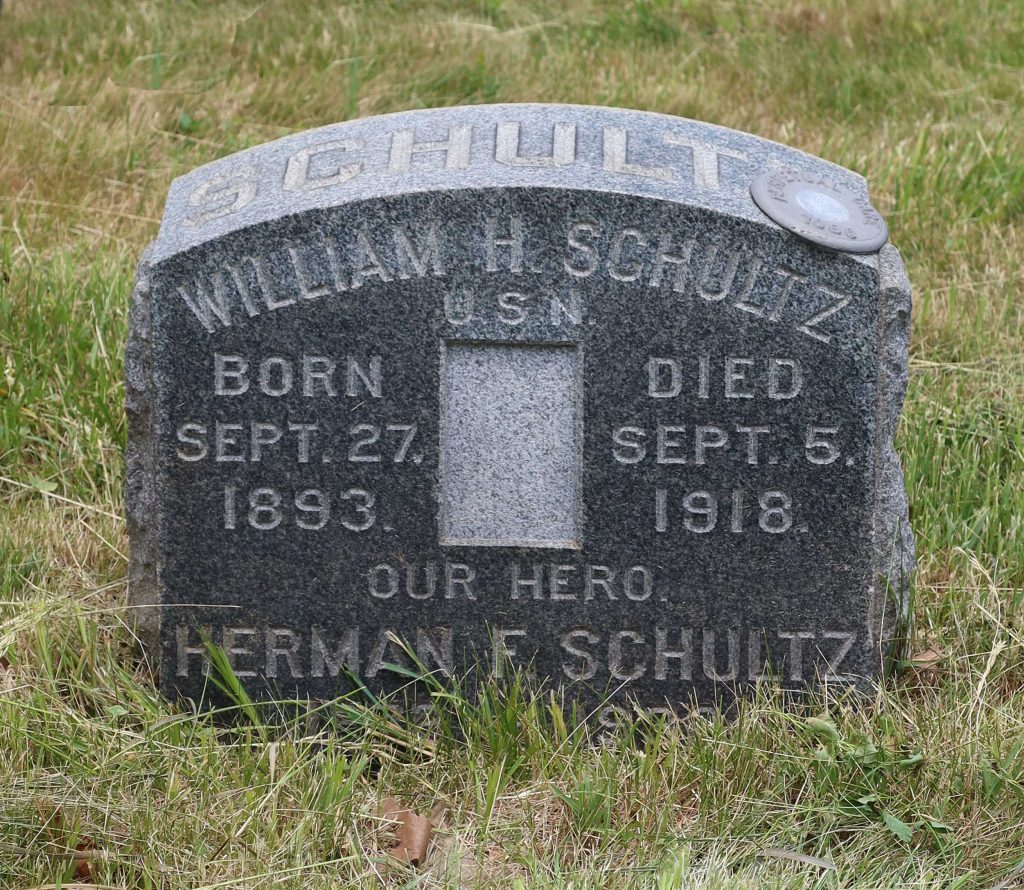
SCHUMACHER (or SCHUMAKER), JOHN FREDERIC (1883-1959). First lieutenant, 303rd Stevedore Regiment, Quartermaster Corps, American Expeditionary Forces, United States Army. Schumacher was born in Brooklyn. As per the 1910 census, he had been married for three years, lived in a rental on Putnam Street in Brooklyn, and worked as a clerk in a bank. At the time of his induction as a first lieutenant, quartermaster corps, on October 28, 1917, he resided at 39 Stephens Court in Brooklyn. He was assigned to the 303rd Stevedore Regiment, first at Newport News, Virginia. Subsequently, he was shipped overseas from December 4, 1917, through July 2, 1918, and returned to the United States at New Haven, Connecticut, where he was honorably discharged on January 26, 1920. His soldier record does not list any engagements and notes that he suffered no wounds but was 25% disabled at the time of his discharge.
The 1920 census indicates that Schumacher owned a house in Brooklyn, was married with one daughter, and worked as a manager in the insurance industry. At the time of the 1930 census, Schumacher lived with his wife and two daughters at 9 Glen Eagles Drive in Larchmont, New York, in a home that he owned that was valued at $28,000, and was president of a brokerage. The 1940 census reports that he was a high school graduate, lived in the same house in Larchmont, now valued at $18,000, and that he had earned $5,000 as a broker in 1939. His World War II Draft Registration Card, filed in 1942, notes that he lived in West Orange, New Jersey, and worked on Battery Place in Manhattan; his contact person lived in Albany, New York. On April 23, 1959, John C. Schumacher (relationship unknown) of 6 Longview Road in Livingston, New Jersey, applied for a government-issued granite marker citing John F. Schumacher’s service in World War I. Section 120, lot 2407.

SCHUYLER, JAMES EVERETT (1860 or 1883-1925). Major, 7th New York State National Guard; 14th New York State National Guard, United States Army. Schuyler was born in Brooklyn to a family with deep roots in New York. He had an active role in the 7th Regiment, New York State National Guard, following in the footsteps of his father, Jacob, and serving at one time, alongside four brothers. As per the Seventh Regiment Gazette in 1909, he was unanimously elected major of the second company (Company B), a tribute to his 31 years of service during which time he missed only one drill.
Initially, Schuyler was nominated for membership in the 7th Regiment by his brother on October 7, 1878, and enlisted in Company B, the same company of which his family was affiliated. He was appointed corporal on May 1, 1883, sergeant on December 6, 1886, and first sergeant on December 13, 1888. Schuyler was commissioned second lieutenant on October 15, 1891, and was commissioned captain on May 17, 1897. He was brevetted to major on March 18, 1904, in recognition of twenty-five years of meritorious service. His biography in the Seventh Regiment Gazette notes that Schuyler was a leader in both military maneuvers and was for twelve years the vice-president of the Seventh Regiment Athletic Association, anchor of the Company B tug-of-war team and member of the regimental tug-of-war team. Subsequent to his promotion to major, he served on the Mexican border from June 25 through December 2, 1916, as the senior battalion commander. At some point during his forty years of service in the 7th National Guard, he was a battalion commander of the 107th Infantry.
As per his New York State Military Record for World War I, Schuyler was drafted into federal service as a major of infantry from the National Guard on August 5, 1917; that document lists an incorrect birth year of 1883 for him. At that time, he lived at 1820 49th Street in Brooklyn. That document reports that he was assigned from the 7th National Guard and transferred to the 14th Infantry New York National Guard on October 1, 1917. Schuyler was assigned to New York City and then Camp Wadsworth, South Carolina. His obituary in the New York Times notes that he suffered from “cardiac weakness” while training at Spartanburg, South Carolina. Initially, Schuyler was discharged for physical disability on July 21, 1917, as per Special Order 184 but that was revoked on July 28 by Special Order 191. Ultimately, he was honorably discharged due to disability on December 30, 1917; his record shows that he did not serve overseas or suffer any wounds. He served during the remainder of World War I on the War Industries Board Housing Commission in Washington, D.C.
As per his obituary in The New York Times, Schuyler was a vice president of the 7th Regiment’s Veterans’ Association, president of the Veterans of Company B of the 7th Regiment, a past vice commander of the 107th Infantry Post of the American Legion and member of the War Veterans’ Society of the 7th Regiment. His funeral took place at the Central Presbyterian Church at Madison Avenue and 57th Street. A detachment from the 107th Infantry fired a volley and taps were sounded over his grave at Green-Wood. He last lived in Amityville, New York. Section 9, lot 14366.
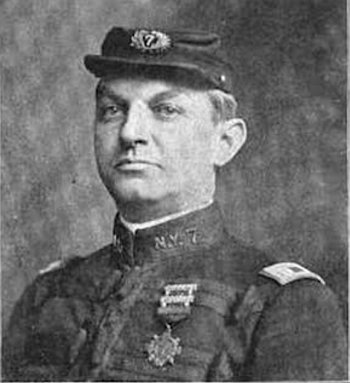
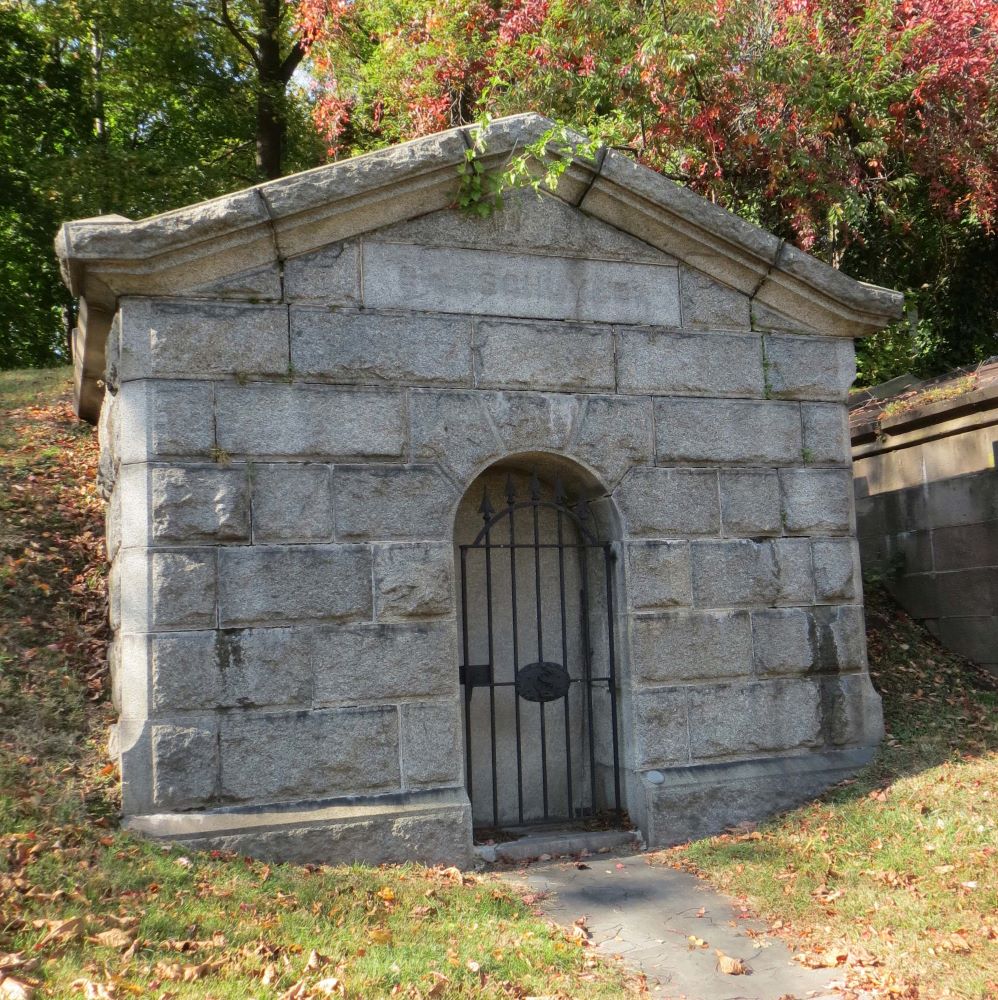
SCOTT, FREDERICK WALTER (1888-1957). Private first class, 108th Infantry, Company C; 147th Headquarters, United States Army. A Brooklynite by birth, Scott’s World War I Draft Registration Card, filed in Queens on June 5, 1917, notes that he was a salesman, single, tall and slender, with grey eyes and dark grey hair. He lived at 15 Wendom Street in Woodhaven, New York, when he was inducted into the United States Army as a private at Glendale, New York, on April 5, 1918. Scott’s soldier record indicates that he was assigned to Company C of the 108th Infantry, was promoted to private first class on July 26, 1918, and did not serve overseas. According to the application for his government-issued marker, as per Special Order #19, he was assigned to the 147th Headquarters in Charleston, South Carolina, at some point. Scott was honorably discharged on June 10, 1919.
The 1920 census reports that Scott was married, lived in a rental on St. Nicholas Avenue in Brooklyn, and worked as a hardware salesman. By the time of the 1930 census, he and his wife were living at 13 Browning Street in Baldwin, New York, in a house that he owned that was valued at $7,500, owned a radio set and was a clerk in a hardware firm. Scott’s World War II Draft Registration Card, filed in 1942, notes that he worked on Park Avenue in Manhattan, had no home telephone, was married, and still lived at 13 Browning Street in Baldwin. On October 8, 1957, Lawrena P. Scott (relationship unknown) of 547 Starks Place in Baldwin, New York, applied for a government-issued granite marker with Christian emblem, citing Frederick Scott’s service in World War I. Section 131, lot 32729.
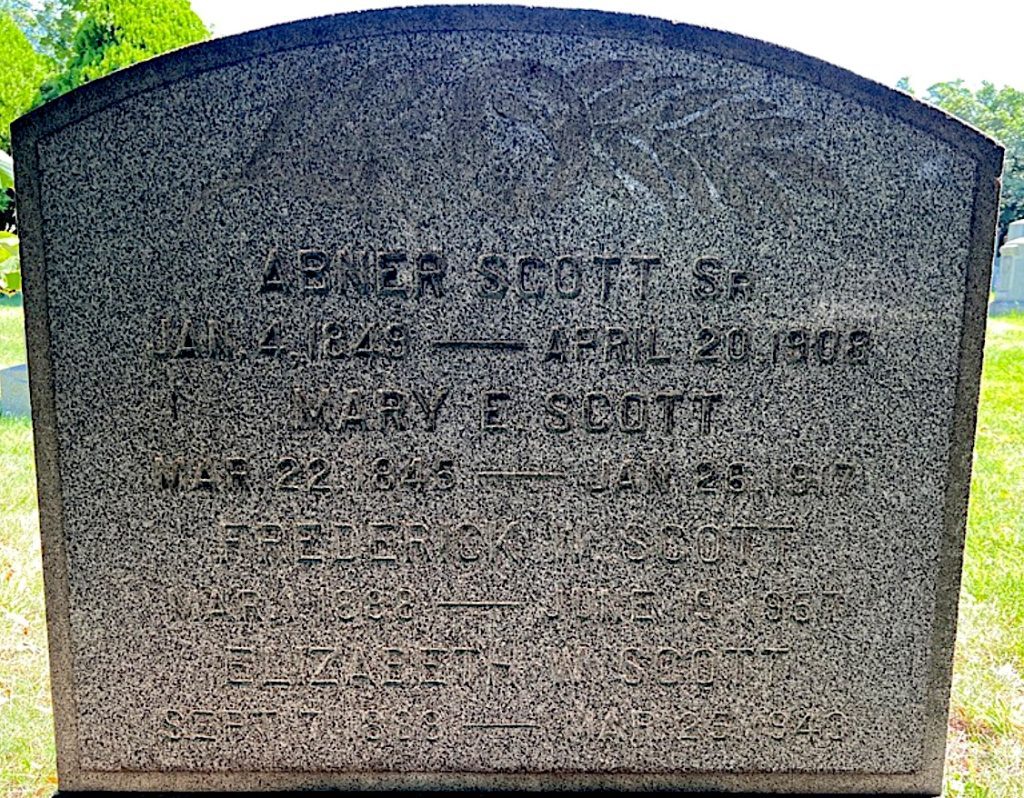
SEAVER, DREW (1897-1968). Private first class, 104th Machine Gun Battalion, 106th Machine Gun Battalion, United States Army. Born in Brooklyn, Seaver enlisted in the New York State National Guard on April 11, 1917. He was assigned to the 104th Machine Gun Battalion and then to the 106th Machine Gun Battalion (formerly a detachment of the 1st Cavalry, New York State National Guard) stationed successively at Kelly Field, Texas, and Waco, Texas. He was honorably discharged at Fort Crook, Nebraska, on November 27, 1918. Seaver last lived at 15 Maple Street in Blue Point, Suffolk County, New York. Section 207, lot 30989.
SHAW, EDWIN DONALD (1892-1977). First lieutenant, 153rd Depot Brigade, United States Army. Shaw was born in Passaic, New Jersey; his birth records and World War I records show a birth year of 1892. At the time of the 1910 census, he was living on 48th Street in Brooklyn with his parents and brother and working as a bookkeeper. The 1915 New York State census indicates that he lived in Brooklyn with his parents and brother and worked as a bank clerk. Shaw’s World War I Draft Registration Card, filed on June 5, 1917, in Bound Brook, New Jersey, where he lived, notes that he was of medium height and stout with blue eyes and light hair. He indicated that he was an assistant auditor at J. P. Morgan & Company at 23 Wall Street, had served five years in the Navy, and was partially responsible for the support of his mother; he did not claim an exemption from military service. As per his New York State Military Abstract for World War I, Shaw was called into active service as a first lieutenant on November 27, 1917, and assigned to the 153rd Depot Brigade. On December 4, 1917, less than a week after he was activated, he married Florence Johnson in Brooklyn. After being assigned to the military barracks in Plattsburg, New York, Shaw was sent to Camp Lee, Virginia. He was honorably discharged on December 15, 1918; he did not serve overseas.
The 1920 census reports that Shaw was living on 54th Street with his wife and working as a clerk in the banking industry. By 1935, Shaw had moved to New Rochelle in Westchester County, New York. The 1940 census reports that he was living at 25 Aberfoyle Road in New Rochelle with his wife and two children, worked as a department head, had completed 10th grade, and had earned $5,000 in 1939. According to his World War II Draft Registration Card, filed in 1942, which lists a birth year of 1893, Shaw still lived at the Aberfoyle Road address, had a home telephone, and still worked for J. P. Morgan & Company at 23 Wall Street in New York City; he listed his wife as next of kin. He last lived in Rye, New York. Section 131, lot 35128.
SHEERIN (or SHURIN), ARTHUR RANDOLPH (1893-1943). Sergeant, 308th Field Artillery, Headquarters Company, American Expeditionary Forces, United States Army. Sheerin was born in Philadelphia, Pennsylvania. As per his World War Draft Registration Card, filed in Morris County on June 5, 1917, he was single, lived in Brookside, New Jersey, and worked as a clerk for the Pennsylvania Railroad in Jersey City. He described himself as tall, of medium build with grey eyes and brown hair. He enlisted on September 20, 1917, and was assigned to the Headquarters Company of the 308th Field Artillery, which was part of the 78th Division. He was shipped overseas on the Cedric as a corporal on May 27, 1918; at that time, he resided in Brookside, New Jersey, and listed his father, James Sheerin, as his next of kin. On May 14, 1919, he left Marseille, France, with the rank of sergeant, for New York onboard the Pesaro, arriving on May 14; he listed his mother, Annie Sheerin, as his next of kin. He was discharged on May 26, 1919.
According to the 1920 census, Sheerin lived with his parents and siblings in Mendham, New Jersey, and worked as a clerk in a railroad office. His World War II Draft Registration Card, filed in 1942, notes that he lived with his wife at 33-23 74th Street in Jackson Heights, New York, had a home telephone and was unemployed. On May 26, 1943, Marian A. Sheerin, his widow, applied for a government-issued granite marker with a Christian emblem, citing her husband’s service in World War I. Section 101, lot 7498.
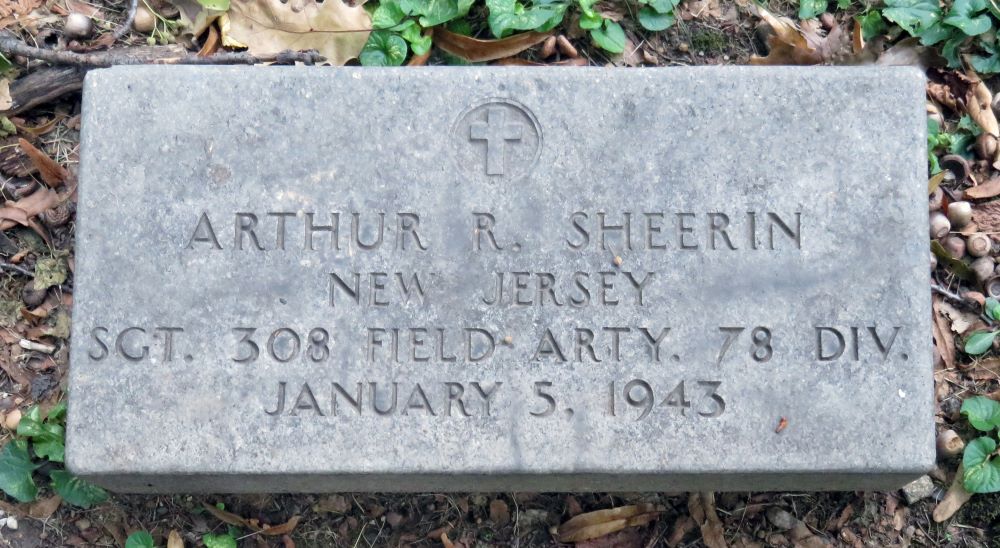
SHELDON, HENRY. (1874-1950). Major, 105th Machine Gun Battalion, 27th Division, 313th Cavalry, 70th Field Artillery Regiment, United States Army; captain, Machine Gun Troop, Squadron A, 1st Cavalry, New York State National Guard. Sheldon, who was born in Brooklyn, graduated from Cornell College, class of 1897, and Columbia Law School, class of 1898. He had a long history serving in the military before World War I. On November 26, 1900, he enlisted in Troop 2, Squadron A Cavalry of the New York State National Guard in New York City. As per his New York State Military Service Card, Sheldon was transferred to Troop 1 on December 10, and then to Troop 3 on January 6, 1902. He trained as an artificer (one skilled with artillery devices in the field) and assumed that rank in December of 1902. He was promoted to corporal on March 22, 1904. On February 17, 1905, he applied for a U.S. passport and described himself as 5′ 8½” tall with a high forehead, blue eyes, straight nose, medium-size mouth, pointed chin, fair complexion, light hair and a long and clean shaven face. He was promoted to the rank of sergeant in the National Guard on July 31, 1907. Sheldon was transferred to Headquarters on February 2, 1912, and assigned to Troop F of the 1st Cavalry on the same day. While in the 1st Cavalry, he was promoted to the rank of lieutenant on February 19, 1912, and to captain on June 11, 1912. On November 5, 1913, he transferred to the Machine Gun Troop, Squadron A, of the 1st Cavalry for service on the Mexican border and was stationed at Camp McAllen, Texas, with the New York division. He returned to New York and was mustered out of border service on December 28, 1916. His muster roll for the Mexican Punitive campaign indicates that he was a lawyer who listed his next of kin as his sister.
With the outbreak of World War 1, Sheldon re-enlisted as a captain on June 11, 1917, at New York City, and mustered in on August 4. He lived at 59 West 49th Street in New York City at that time. Sheldon was given the position of commander of Machine Gun Troop, Squadron A whereupon it was reorganized for the war as the 105th Machine Gun Battalion, 27th Infantry Division. He was promoted to major on August 4, 1917, and was eventually assigned to the 313th Cavalry, which reorganized into the 70th Field Artillery Regiment at Camp Knox, Kentucky. As per his World War I Military Abstract, the 313th Cavalry was stationed at Camp Wheeler, Georgia; Del Rio Texas; West Point Kentucky; and Camp Taylor, Kentucky. He saw no service overseas and was honorably discharged from the service on January 31, 1919. He then lived at 59 West 49th Street in Manhattan.
After the war, Sheldon practiced law. The New York State census of 1925 has Sheldon living in Rye, New York, with his wife and four-year-old son. By 1935, he was living in Greenwich, Connecticut. The census of 1940 reports that Sheldon was divorced and living with his son at 10 Mortimer Drive in Greenwich where he paid $75 per month in rent; he was employed as a broker and had earned $5,000 that year. That census indicates that he had completed four years of college. At the time of his death, he was divorced and had last lived at 39 Edgewater Street in Old Greenwich, Connecticut. The ex-members of Squadron A, which he joined in 1900, announced his death in an obituary in The New York Times. On October 14, 1950, less than two months after his father’s death, Henry T. Sheldon, of 5 Arnold Street, Old Greenwich, Connecticut, applied for a government-issued headstone with a Christian emblem, citing his father’s service as a major in World War I. Section 30, lot 8162.
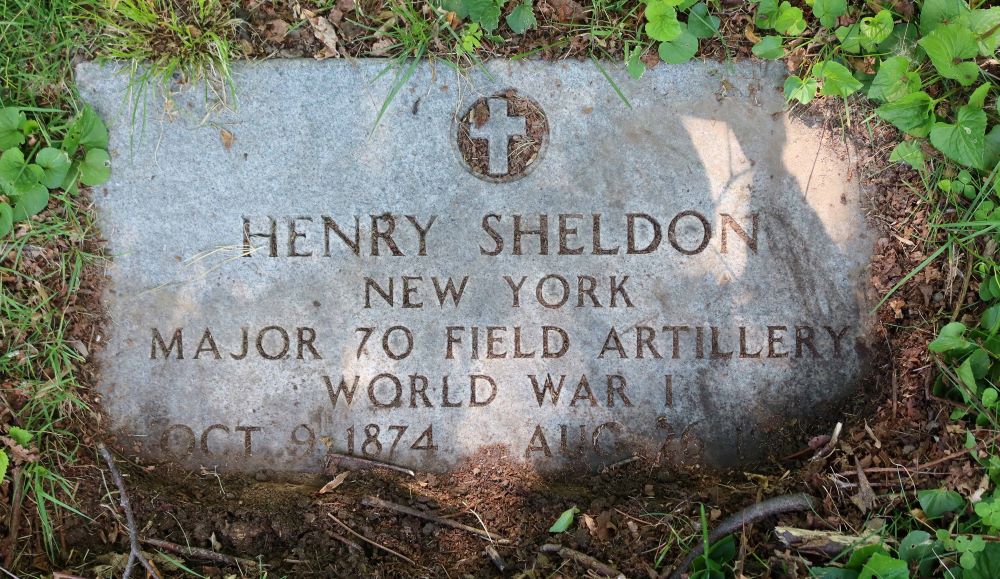
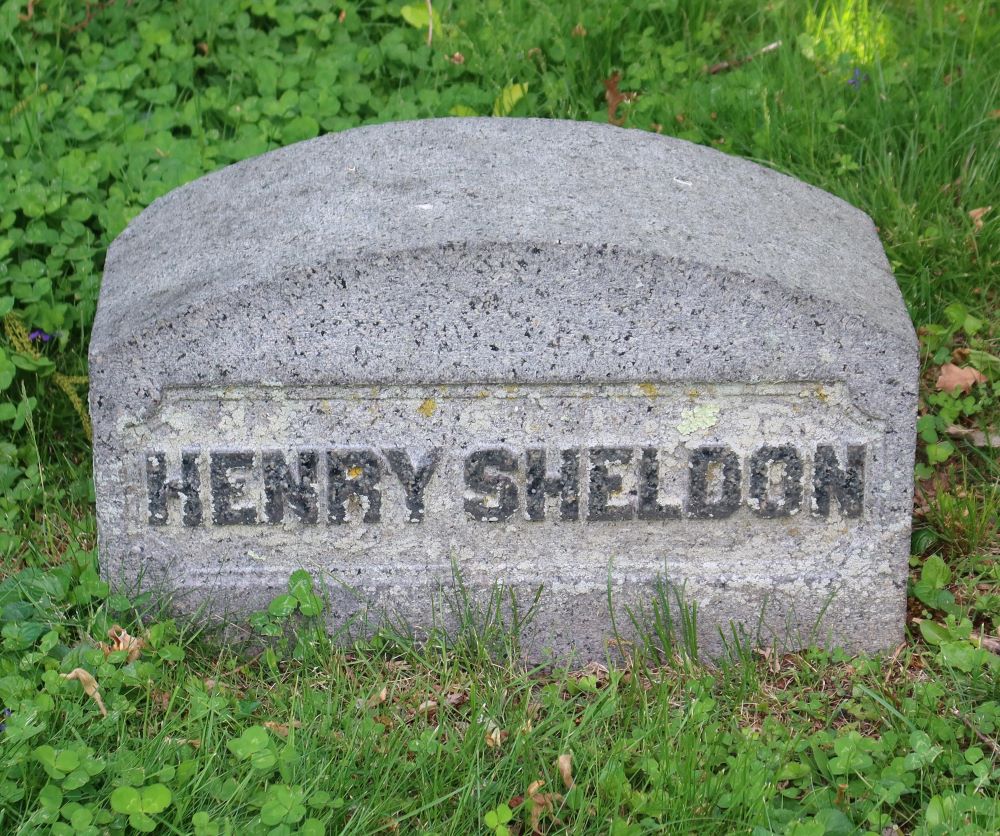
SHIELDS, ROYAL FRANCIS (1896-1960). Private first class, Headquarters Detachment, Machine Gun Training Center, United States Army. Shields was born in Manhattan. The 1910 census reports that he lived on Hughes Avenue in the Bronx with his parents and siblings. The New York City Directory for 1916 indicates that he lived at 2873 Briggs Avenue in the Bronx and was employed as a clerk. Shields was inducted into the United States Army as a private on May 26, 1918, was assigned to the Headquarters Detachment, Machine Gun Training Center at Camp Hancock, Georgia, was promoted to private first class on December 1, 1918, and was honorably discharged on February 5, 1919. He did not serve overseas.
As per the 1920 census, Shields lived with his father and siblings on Briggs Avenue and was a newspaper reporter. His World War II Draft Registration Card, filed in 1942, states that he lived at 2707 Briggs Avenue in the Bronx, had no home phone, and worked in Manhattan; he listed his sister, Alice Shields, at the same address, as his next of kin. He last lived in the Bronx. In March 1961, Florence Shields, his widow who lived at 682 St. Mary’s Street in the Bronx, applied for a government-issued marble headstone with no religious emblem, citing her husband’s World War I service. Section 171, lot 12857.

SHIELE, HAROLD WILLIAM (1895-1919). Corporal, 24th Engineers, Company F; 40th Engineers, American Expeditionary Forces, United States Army. Shiele was born in Manhattan. As per the 1900 census, four-year-old Harold was living at 1410 Madison Avenue in Manhattan with his parents, maternal grandparents and younger sister, Edith. The 1910 census records show that he was living at 455 South Seventh Avenue in Mount Vernon, New York, with his parents and sisters Edith, age 12, and Carrie, age 4. He was still single and living in Mount Vernon at the time of the 1915 New York State census.
As per his World War I Registration Card, he was still living at the same Mount Vernon address and was working as an architect at a firm at 15 East 40th Street in New York City. Schiele’s online family tree and Westchester soldier records note that he entered service at Fort Slocum, New York, on November 9, 1917. Schiele’s name is on the manifest of the USS America leaving from Hoboken, New Jersey, and bound for Europe on January 4, 1918; his rank is listed as private and his father is identified as his next of kin. His Abstract of World War I Service indicates that he first served in Company F of the 24th Engineers, then was detached to headquarters, and served with the 40th Engineers. A notation on that abstract reads “Camouflage to his death.” He was promoted to private first class on July 20, 1918, and to corporal on September 15, 1918.
He died in France on October 17, 1918, thirteen days after his 23rd birthday. His death was attributed to the influenza pandemic that was sweeping through Europe. After the war, his body was returned to the United States and he was buried at Green-Wood on January 29, 1922. Section 58, lot 1950.
SIEVERT, GUSTAV A. (1877-1922). Chief boatswain’s mate, United States Navy. Born in Brooklyn, Sievert was a laborer before joining the Navy as an apprentice 3rd class on August 2, 1894. Listed as 5′ 7″ tall with brown eyes and brown hair and a dark complexion, he went on to serve aboard the cruiser USS Montgomery in May 1898 during the Spanish-American War. The USS Montgomery patrolled the Eastern seaboard and the Caribbean and, in May 1898, joined the blockade of Havana, taking two Spanish ships as prizes and shelling Spanish forts. Apprentice 1st class Sievert received an honorable discharge on October 11, 1898, and re-enlisted December 20, 1898.
During World War I, Sievert served on the battleship USS Wyoming from April 6, 1917 to May 22, 1918, and was discharged on June 10, 1918. On June 27, he re-enlisted and served aboard the battleship Ohio as a chief boatswain’s mate until the war ended on November 11, 1918. On April 20. 1919, Sievert transferred to the Fleet Naval Reserve and went on inactive duty on June 19, 1919. His last residence was 221 15th Street in Brooklyn. He died of phthisis (consumption) at the Naval Hospital in Brooklyn. Section 16, lot 14888, grave 1011.


SIMPSON, THOMAS N. (1889-1926). Private, 153rd Depot Brigade, United States Army. Simpson was born in Puerto Plata, Santo Domingo; his father was born in Sag Harbor, New York. On July 25, 1918, he applied for an emergency passport at Havana, Cuba, stating that he bore a passport issued on January 26, 1917, for travel to Central America and Cuba and that he had been in Cuba as of December 1917, where he was a clerk at the United States Naval Station at Guantanamo. His military records indicate that he was inducted on August 29, 1918, and assigned to the 26th Company, Main Training Depot, Machine Gun Training Center at Camp Hancock until his discharge on January 25, 1919; he did not serve overseas. As per the application for a government-issued headstone, he was a private in the 153rd Depot Brigade.
In September 1920, he applied to renew his passport; that document noted that he was a native born citizen and that he was a commercial traveler who planned to sail to Cuba from New York on the United Fruit Company on September 25, 1920. According to the Report of the Death of an American Citizen, Simpson died from diphtheria at the Hospital Austriaco in Cartagena, Colombia, on October 3, 1926. It was noted on that document that he was interred at the Manga Cemetery in Cartagena, and that he could not be disinterred for eighteen months. His effects were taken by the American Consul there and his mother, Clementine Simpson of 210 West 109th Street in Manhattan, was notified of his death by the Department of State in a telegram. The New York Times also reported his death in Cartagena, Colombia. He was interred at Green-Wood on December 8, 1928. On March 5, 1930, Clementine Simpson applied for a government-issued headstone with Christian emblem for her son, citing his service in the 153rd Depot Brigade. Section 133, lot 16874.
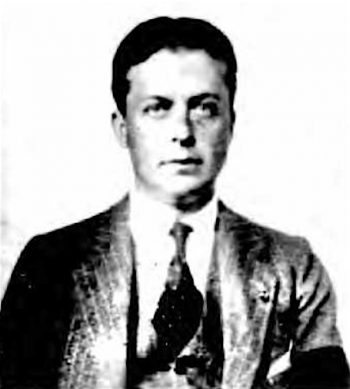
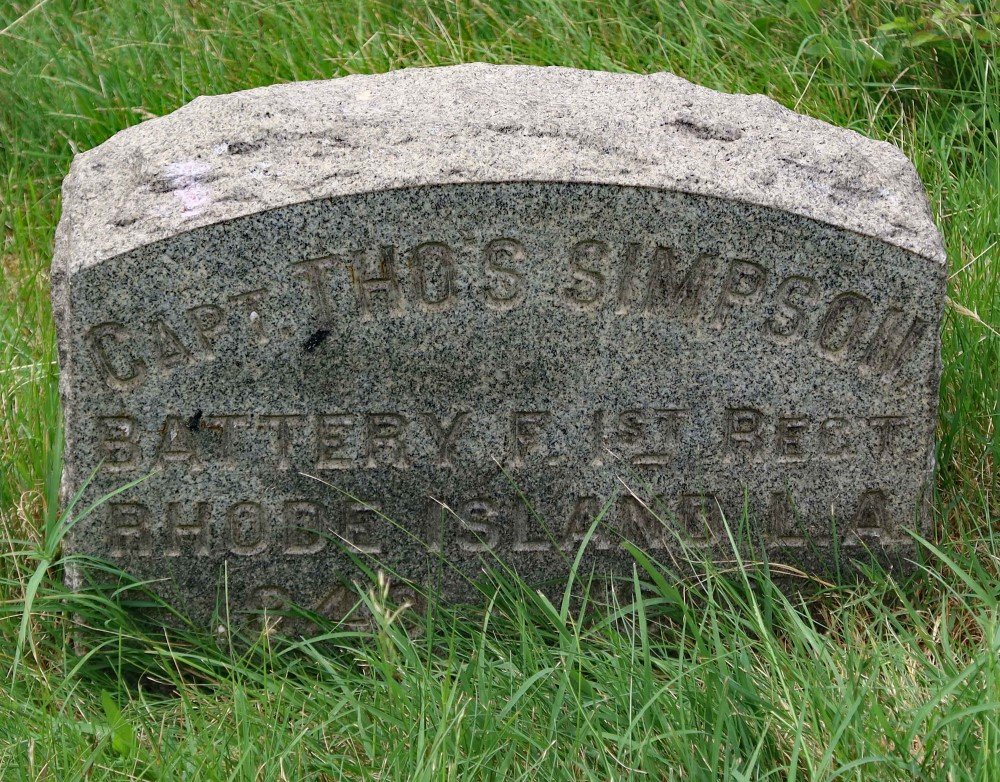
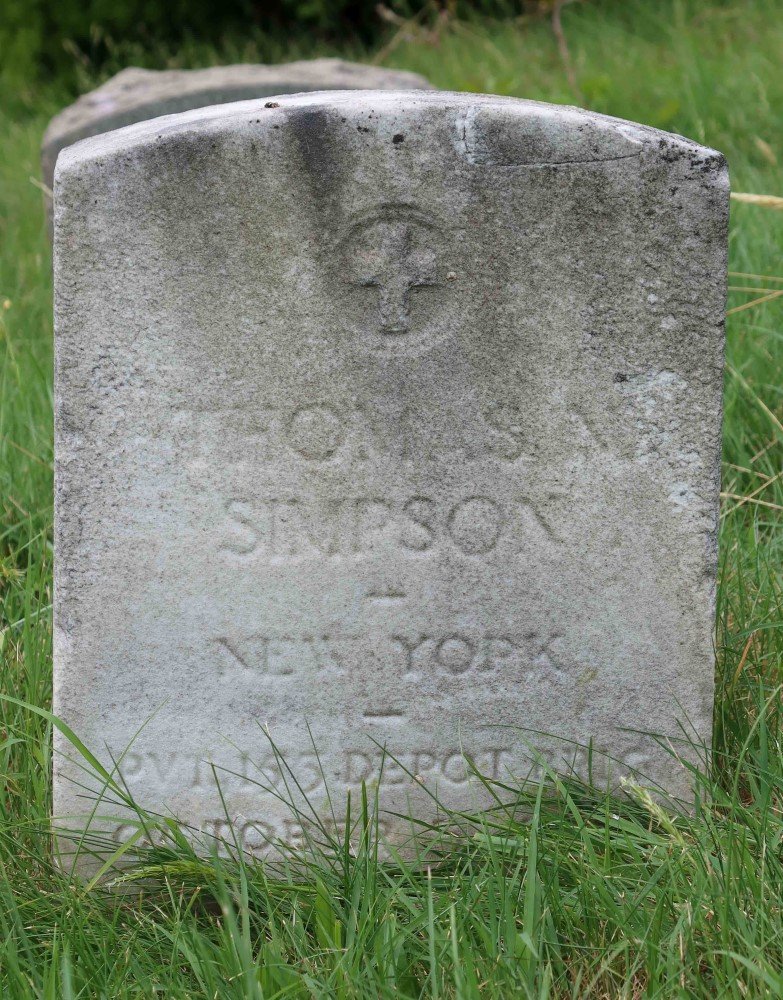
SLOAN, GEORGE GEMMELL (1887-1950). Sergeant and Army field clerk, Adjutant General’s Department, American Expeditionary Forces, United States Army. Sloan was born in Brooklyn. As per the application for his government-issued headstone, he first enlisted in the Army on May 16, 1917, and was discharged on May 1, 1918. His New York State Military Record for World War I shows that he enlisted as a sergeant on May 2, 1918, and was appointed as an Army field clerk in the ADG (Adjutant General’s Department); his application for a headstone notes that he was a disciplinary barracks guard. Sloan served at Governor’s Island in New York Harbor before he was sent abroad. On June 30, 1918, he departed for Europe on the President Grant from Hoboken, New Jersey; he then lived at 157 68th Street in Brooklyn and listed his mother, Elizabeth Sloan, as his next of kin. He departed on the Mongolia from St. Nazaire, France, on February 23, 1919, and arrived in Hoboken on March 7, 1919; he was listed as suffering from acute bronchitis. Sloan was honorably discharged on May 16, 1919; no engagements are listed on his service record and no injuries are noted.
The 1930 census notes that he lived with his parents at 562 78th Street in Brooklyn, was a real estate broker and a veteran. His World War II Draft Registration Card reports that he lived at 565 80th Street in Brooklyn, worked at 44 Court Street in Brooklyn (no occupation listed) and was married to Laura Sloan. On May 11, 1950, five months after his death, Laura Sloan, who is interred with him, applied for a government-issued headstone with Christian emblem, citing her husband’s service as a sergeant and a disciplinary barracks guard. Section 171, lot 38062.

SMINCK, DONALD STUART (1895-1937). Sergeant, 153rd Depot Brigade, Company C; 311th Infantry, Company A, 78th Division, American Expeditionary Forces, United States Army. A native of Plainfield, New Jersey, the 1900 census reports that Sminck was living there with his parents and two younger sisters. In 1915, he was a student at the International Young Men’s Christian Association College in Springfield, Massachusetts. As per his Draft Registration Card of June 5, 1917, he described himself as single, of medium height and build, with blue eyes and brown hair; at that time, he was employed as an inspector for the Howe Rubber Company and lived at 838 Front Street in Plainfield. The application for a government-issued headstone notes that he enlisted on September 21, 1917, and was a sergeant in Company C of the 153rd Depot Brigade and in Company A of the 311th Infantry. The 311th was part of the 78th Division, which was activated on August 23, 1917, at Camp Dix, New Jersey. The 78th, known as the “Lightning Division,” participated in three major campaigns: Meuse-Argonne, St. Mihiel, and Lorraine. It was demobilized in June, 1919, and suffered over 7,000 casualties during the war. Sminck received his honorable discharge on January 15, 1919.
According to the Plainfield City Directory for 1924, Sminck was employed as a clerk and still lived at 838 Front Street. The 1930 census reports that he was living at the New Jersey State Hospital for the Insane where he was a store keeper; he is also listed as a veteran of the World War. He last lived at 838 Front Street in Plainfield. Sminck died at New Jersey State Hospital in Greystone Park from testicular cancer. On April 7, 1938, William G. McDowell, Administrator, of 152 North Avenue in Plainfield, applied for a government-issued headstone with Christian emblem, citing Sminck’s World War service. Section 103, lot 7621.
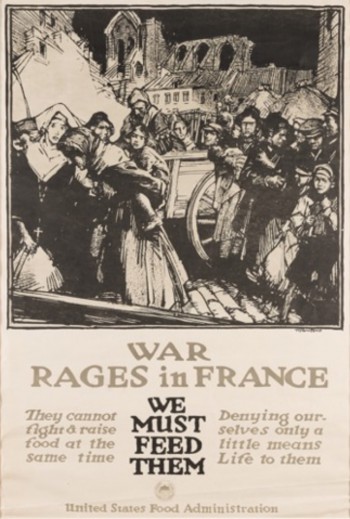
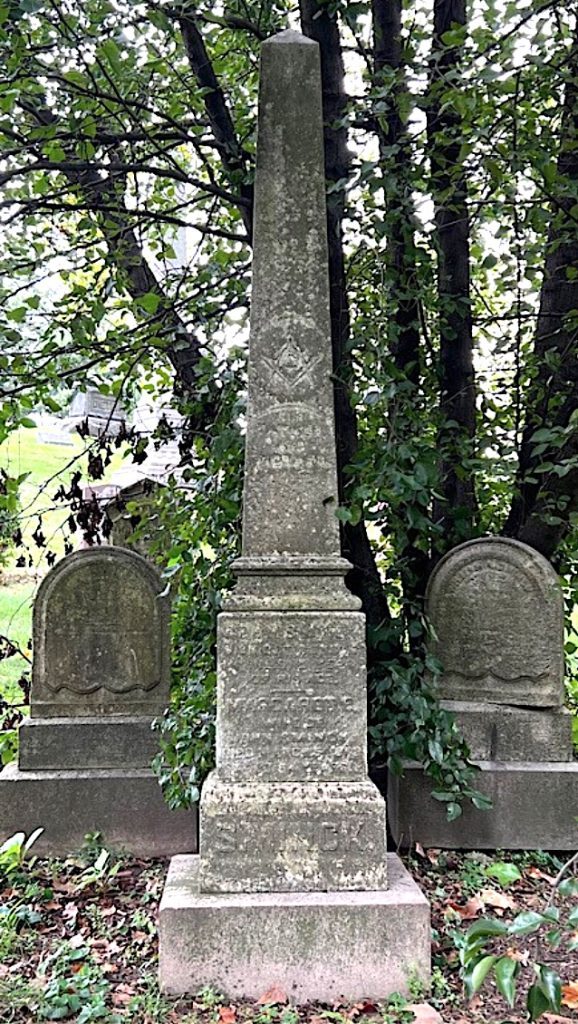
SMITH, GEORGE VINCENT (1888-1971). Corporal, 57th Artillery, Battery B and Headquarters Company, American Expeditionary Forces, United States Army. A New York City native, the 1900 census shows that Smith lived on 32nd Street in Manhattan with his parents and siblings and attended school; he still lived with his parents and siblings at the time of the 1905 New York State census. The census of 1910 reports that he was single, lived on 120th Street in Manhattan with his parents and siblings and worked as a wagon driver. According to his New York State Abstract of National Guard Service for World War I, Smith enlisted as a private on July 24, 1917, and was assigned to the 9th Regiment of the Civilian Defense Corps (CDC), 19th Company. At that time, he lived at 1829 Lexington Avenue in Manhattan. He was promoted to private first class on October 4, 1917, to corporal on January 11, 1918, and transferred to Battery B of the 57th Artillery. Smith was sent overseas as of May 10, 1918, and transferred to Headquarters Company of the 57th on July 24, 1918, where he served until January 14, 1919. Upon his return to the United States, Smith was honorably discharged on January 22, 1919, upon demobilization of his unit.
As per the 1930 census, Smith lived in a rental with his wife and three children at 1349 East 142nd Street in the Bronx, had been married for ten years, owned a radio set, was a veteran of the World War and worked as a chauffeur for a taxi company. He lived in a rental at 418 East 138th Street in the Bronx with his wife and children at the time of the 1940 census, had completed eighth grade, had been unemployed as a chauffeur for 102 weeks but had income from other sources. As per his World War II Registration Card, filed in 1942, he lived with his wife at 414 East 138th Street in the Bronx and worked at the Brooklyn Navy Yard. Section 41, lot 7323.

SMITH, HALLIDAY SPENCER (1887-1918). YMCA field secretary. A native of New York City, although one record says East Orange, New Jersey, the 1910 census reports that Smith was living with his family, including a sibling, in Orangetown, New York, and was working as a clerk in a bond house. On December 1, 1917, he sailed on the Espagne to work as a field secretary for the Young Men’s Christian Association (YMCA) in France. The YMCA administered to the spiritual and morale-boosting needs of the military continuing work that it began overseas during the Spanish-American War. (The YMCA previously did work with the military during the Civil War.) Services that are now institutionalized in the armed forces such as canteens, post exchanges, recreation, religious services and entertainment, were part of the tasks performed by the YMCA during World War I. Both the cause and date of Smith’s death are unclear. According to records at the University of Massachusetts at Amherst, he was killed in action near Baccarat, France, on May 26, 1918. However, the cemetery ledger records his death in France as an accident with the date of death as June 27, 1918. He last lived in Nyack, New York. He was re-interred at Green-Wood on April 4, 1922. Section 97, lot 227.
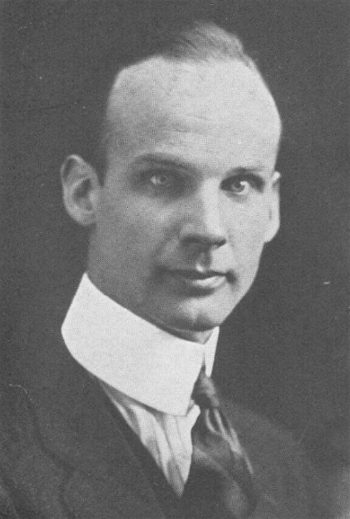
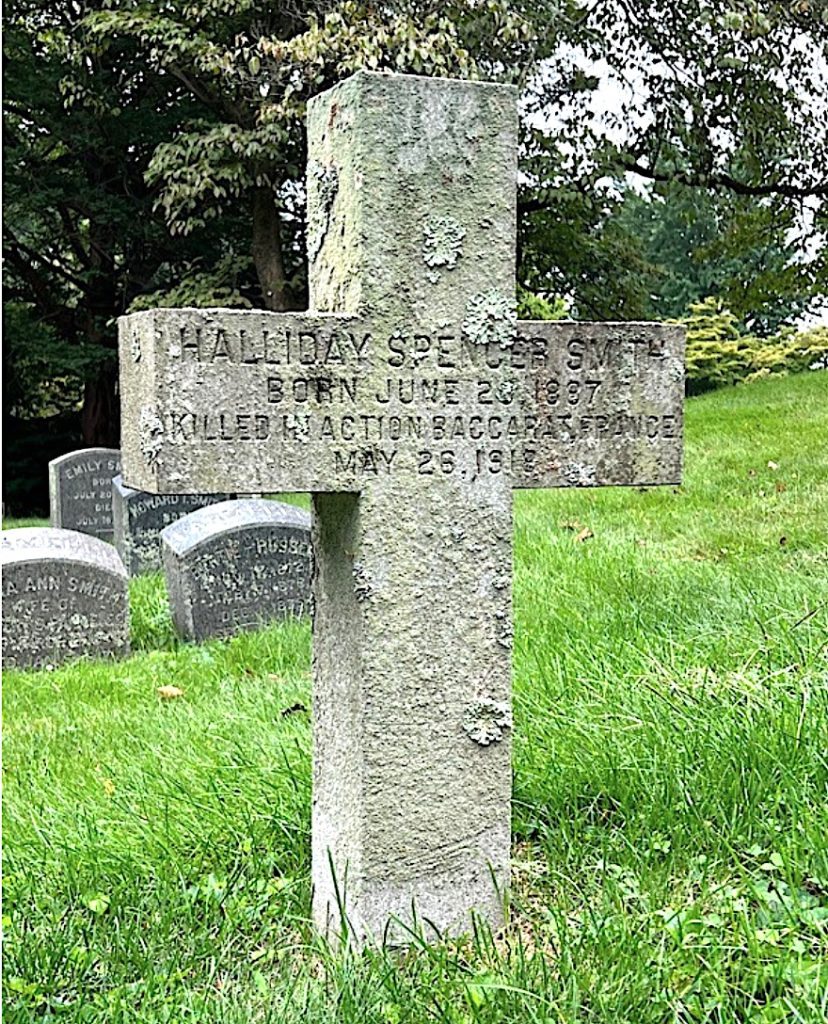
SMYTH, WALTER WILLIAM (1891-1918). First lieutenant, 94th Aeronautic Squadron, American Expeditionary Forces, Air Service Signal C. Born in Manhattan, Smyth resided at 149 East 38th Street. In his passport application filed on May 17, 1917, he stated that he was a student who was going to France as an ambulance driver for the Americans. He sailed overseas on the ship Chicago two days later. On August 15, 1917, he enlisted into the military at the Enlisted Reserve Corps in Paris, France. Smyth accepted a commission as a first lieutenant on December 11, 1917, and was assigned to the 94th Aero Squadron, Signal Company C, American Expeditionary Forces. His unit was engaged in battle in the Fismes Section of the Marne Department in the Champagne-Ardennes region. He was killed in aerial combat in Chevy, France, on August 17, 1918. His mother, Magdalene Smyth, who resided at 372 Lexington Avenue in Manhattan and where he last lived, was notified of his death. After his remains were returned to the United States, Smyth was buried on June 5, 1921. Section 145, lot 23777, grave 4.
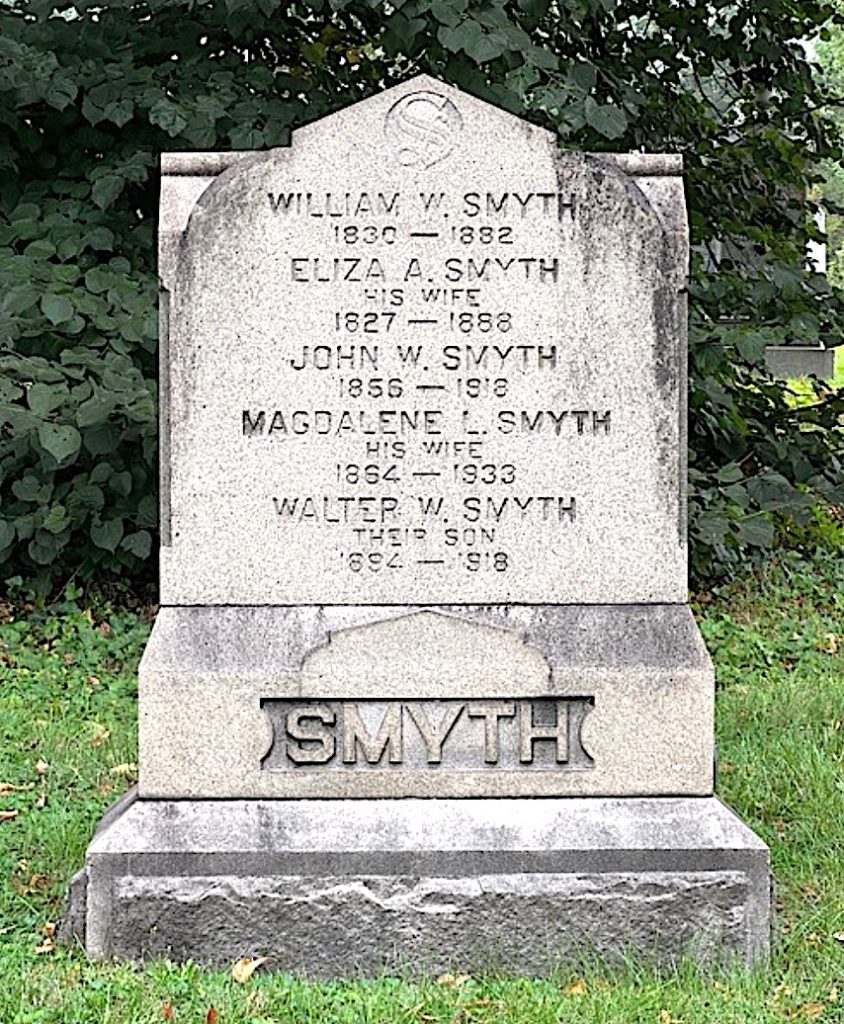
SNYDER, JR., WILLIAM JAMES (1900-1958). Private, United States Army. A native of Saratoga Springs, the New York Census of 1915 reports that the Snyder family was living in Schenectady, New York. When he registered for the draft on September 12, 1918, he was a student at Union College in Schenectady; he described himself as tall, slender with blue eyes and brown hair. His address at that time was 10 Division Avenue in Schenectady. He was in the Student Army Training Company at Union College when he was inducted at Schenectady on October 2, 1918, and sent to Camp Lee, Virginia. He was honorably discharged on January 15, 1918.
In 1925, Snyder was a resident at the United States Veterans Hospital in Franklin, New York. He last lived at 1 Parade Place in Brooklyn. Although his tombstone reads that he was born in 1896, all records indicate that he was born in 1900. Section 107, lot 176.

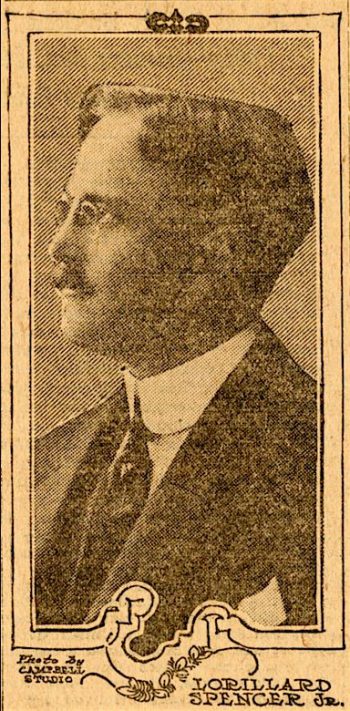
SPENCER, III, LORILLARD SUYDAM (1883-1939). Major, 369th Infantry, American Expeditionary Forces, United States Army. A native of Manhattan, Spencer bore the name of his father and grandfather; the 1910 census incorrectly lists his birthplace as Rhode Island. He was educated at preparatory schools in New York City and at St. Paul’s School in Concord, New Hampshire, and attended Columbia University before entering the business world. In 1905, he married his first wife, Mary R. Sands, a union that later ended in divorce on grounds of neglect to provide; the couple had one son. Although serving with the New York Cavalry at the time of the 1910 census, it reports that he lived with his wife, Mary, and son at 90 Rhode Island Avenue in Newport in a house that he owned; he was listed as self-employed. Among the first businesses Spencer had connections with were the Pederson Manufacturing Company (1907-1910); Colorado Fruit Products Company (1913-1914); Somma Shops (of which he was president from 1913-1925); Astral Window Company (of which he was president from 1913-1929); and the Panama Engineering Company (of which he was president from 1913-1914).
Concomitant with his interest in business was his interest in the military. Spencer enlisted on June 1, 1904, and served in Squadron A, Troop 2, of the New York Cavalry until 1912. He was then commissioned as a second lieutenant in Coast Artillery on July 1, 1912, and assigned to the 8th Coast Artillery of New York City. Spencer was promoted to first lieutenant on January 2, 1913, captain on April 16, 1915, and major on June 26, 1916. His obituary in The New York Times notes that for a time he was the military secretary to the governor of New York.
During World War I, Spencer enlisted as a major on July 15, 1917, and was first assigned to the 15th New York Infantry in August 1917, which was reorganized into the 369th Infantry, 93rd Division, and assigned to the 4th French Army. He lived at 71 East 82nd Street in Manhattan at the time of his enlistment. He was first assigned to Camp Whitman in New York and then Camp Merritt in New Jersey before he was shipped overseas on December 12, 1917. As per his soldier record, he served in France in the Battles of Champagne-Marne and Aisne-Marne. A battalion commander, he was severely wounded in action on September 26, 1918, near Ripon, France, during the Meusse-Argonne offensive, and later received the Distinguished Service Cross on October 22, 1921, for his action there. The aforementioned award noted, “For extraordinary heroism in action in the Champagne sector, France, September 26, 1918. Commanding a battalion which was in action for the first time, Major Spencer inspired his men by his own coolness and courage under intense machine gun fire. He continually exposed himself without regard for personal safety until he was wounded six times.” Spencer’s overseas duty ended on November 17, 1918, when he returned to the United States; he was discharged from service on October 18, 1919, at which time he was 20% disabled.
As per an article in The New York Times, Spencer divorced his first wife after he returned home from the World War and was in the aviation business. On December 6, 1922, he married his second wife, Katherine Emmons Force, whose sister was the widow of Colonel John Jacob Astor; the couple had four children. For his World War I service, Spencer was also awarded the Cross of the Legion of Honor for “extraordinary heroism in action,” the Purple Heart, and the Croix de Guerre, with a silver and gilt star. Spencer joined the Legion of Valor of the Army and Navy in 1924, and was elected junior vice commander of that organization. He was placed on the Emergency Officers’ Retired List on June 28, 1928, and remained on that list until his death.
As per Spencer’s obituary in The New York Times, which confirmed his service in the New York National Guard and in the American Expeditionary Forces, he had been an official of airplane corporations. The obituary noted that Spencer’s interest in transportation dated to 1898 when he was one of the first owners of a Ford automobile in which passengers on the front and rear seats sat back to back. From 1921-1923, he was president of the Wittemann Aircraft Corporation, and then became president of Atlantic Aircraft Corporation. During his tenure with the latter corporation, he oversaw the takeover of one of the companies constituting the General Aviation Corporation. In 1925, he became associated with business and finance leaders who advocated commercial aviation. At that time, he became a member of the board of directors of the Colonial Air Transport, Inc., serving alongside such luminaries as William A. Rockefeller, Henry P. Davidson and Cornelius Vanderbilt Whitney. That board pushed for the merger of Colonial Air and Eastern Air Transport Lines to serve cities on the North Atlantic seaboard. In 1927, Spencer was chairman of a landing fields committee of the New York Board of Trade and Transportation. He also headed Fokker Aircraft Corporation in 1927-1928. In 1929, he was among the organizers and was the first president of Aviation, Inc., an association devoted to training student pilots and the manufacture and distribution of airplanes.
According to the 1930 census, Spencer lived in a rental at 1020 Fifth Avenue in Manhattan with his wife and three young children, owned a radio set, was an executive in the finance industry, and had served in the World War. Devoted to welfare organizations, his was a founder of the Boys Scouts of America and big supporter of that organization. In addition, he was a member of the board of managers of the American Society for the Prevention of Cruelty to Animals and a trustee of the French Institute in the United States. He also supported the Moro Educational Foundation and supported an industrial and agricultural school on Jolo, an island in the Philippines; his wife, an active director of that institution, was injured there in 1932 when a typhoon struck and buried her in debris when the school building collapsed. He died at Chastellux, his home in Newport, Rhode Island. His death was attributed to the after-effects of a stroke that he suffered at Bailey’s Beach, Rhode Island in 1934; he had undergone treatment at the Naval Hospital in Rhode Island and at his home. Spencer’s funeral took place at St. George’s Church at Stuyvesant Square in Manhattan. On January 12, 1940, Katherine Force Spencer, his widow, applied for a government-issued headstone with Christian emblem, citing her husband’s World War service. Section 18, lot 14582.
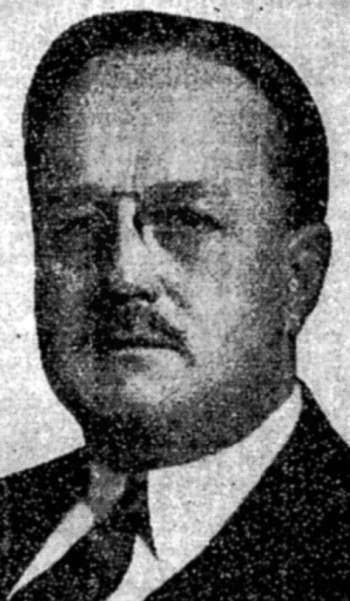
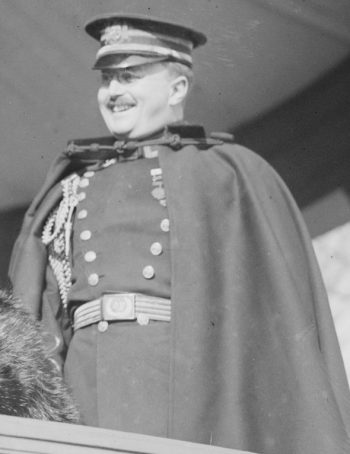
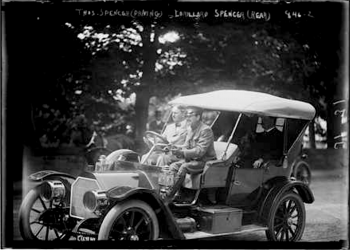
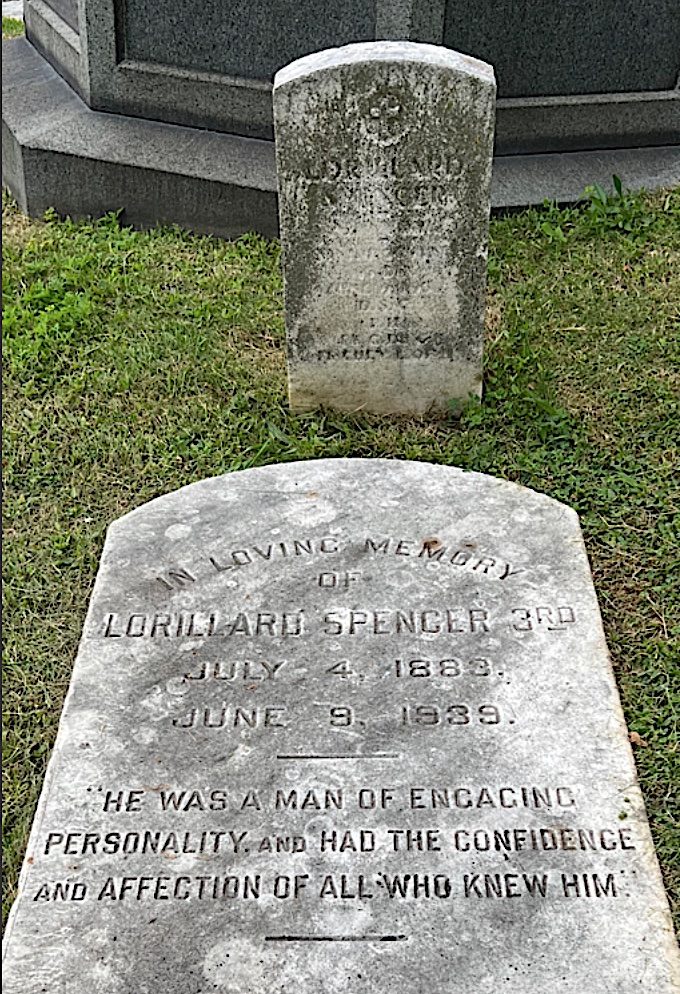
SQUIRES, WALTER (1896-1931). Private first class, 302nd Engineers, Headquarters Company, United States Army. Squires was born in Brooklyn. As per the 1900 census, he lived at 1143 Hancock Street with his parents and siblings. His World War I Draft Registration Card, filed on June 5, 1917, indicates that he was single, lived at 88 Railroad Avenue in Brooklyn and worked as a salesman. He described himself as tall, of medium build with brown eyes. On September 30, 1917, he was inducted into the United States Army as a private. He was assigned to the Headquarters Company of the 302nd Engineers. On November 24, 1917, he married Lillian McKay, his first wife, in Brooklyn. Squires served overseas from March 30, 1918 through February 11, 1919. After returning to the United States, he was honorably discharged on April 16, 1919; he incurred no wounds during his service. On April 7, 1932, Kate Squires, his widow who lived at 825 54th Street in Brooklyn, applied for a government-issued headstone, citing Walter Squire’s service in the World War. Section 86, lot 1899.
STAATS, FRANK DOUGLAS (or DUGLASS) (1894-1964). Private first class, 306th Field Signal Battalion, Companies C and B, American Expeditionary Forces, United States Army. Born in New York, Staats lived at 442 East 84th Street in Manhattan when he filed his Draft Registration Card on June 5, 1917. As per that card, he was a wireman for New York Edison and described himself as 5′ 9″ tall with a medium build, brown eyes and brown hair. Staats was inducted as a private at New York on January 24, 1918, assigned to Company C of the 306th Field Signal Battalion and was transferred to Company B the next month, on February 26. He was sent overseas on July 3, 1918, promoted to private first class on September 16, 1918, and returned from his overseas duty on June 22, 1919. Staats soon was discharged after the demobilization of his unit on July 1, 1919. As per his Military Abstract, he suffered no wounds or injuries during his service.
As per the 1920 census, Staats was single and lived with his parents on East 88th Street in Manhattan; at that time, he worked as an installer for the Telephone Company. The 1925 New York State census reports that he was married, lived in Brooklyn and worked as an electrician. The 1940 census reports that he was married with one child, and lived at 882 55th Street in Brooklyn in a house that he owned that was worth $10,500. He still worked as an installer, had completed an eighth grade education, and had earned $1,611 the previous year. His Draft Registration Card for World War II indicates that he still lived on 55th Street, had a home telephone, and worked for Duplex Electric Company on Grand Street in Manhattan. According to New York Record of Award Medals, Staats received a medal for his World War I service on December 8, 1943. He last lived in Florida. Although the Green-Wood database lists his year of death as 1961, that is incorrect; his gravestone and death record list his year of death as 1964. Section 124, lot 36461.

STAFFORD, ALICE C. (1889-1974). Third class yeoman landsman, United States Navy. On September 21, 1918, Stafford enrolled as a yeoman landsman at the New York City Recruiting Station. Two days later, she was assigned to headquarters of the Third Naval District of District of New York and was stationed there until the armistice was signed on November 11, 1918. She was officially discharged on November 26, 1920.
An Alice C. Stafford appears on the voting rolls for 1924; she then lived at West 127th Street in Manhattan. At the time that Stafford filed a Petition for Naturalization in the Southern District of New York on July 16, 1926, she was married, as of January 17, 1914, and had three children. Stafford noted that she did housework and lived at 601 West 172nd Street in New York City. Although she reported that she was born in New York City in 1889, her petition indicated that she was renouncing her allegiance to George V, King of Britain and Ireland. Section 109, lot 3475.
STAMNESS (or STAMNES), JR., OTTO PETER (1894-1925). Private first class, 304th Field Artillery, Supply Company, American Expeditionary Forces, United States Army. A native of Norway, Stamness immigrated to the United States in 1913. As per the New York State census of 1915, he lived as a boarder at 747 45th Street in Brooklyn and was employed as a metal ceiling worker. On his Draft Registration Card of June 5, 1917, he was described as being single, 5′ 7″ tall, of medium build with blue eyes and brown hair. On that form, he declared his intention for citizenship and noted that he was employed as a metal ceiling worker with the Whelan Gerrigatt Company located at 16 Desbrosses Street in Manhattan. On September 28, 1917, he was inducted as a private into the United States Army, just six days after his marriage at the Trinity Lutheran Church in Brooklyn. He was assigned to the Supply Company of the 304th Field Artillery Regiment and was promoted to private first class on February 1, 1918. The unit went overseas as part of the American Expeditionary Forces on April 24, 1918, joining the 77th Infantry Division under the command of Major General George B. Duncan. They took part in the Battle of Chateau-Thierry in France. After the armistice on November 11, 1918, Stamness remained with the 304th as a private as of December 27, 1918. His unit returned home on April 29, 1919, and was demobilized. He was honorably discharged on May 10. In February 1954, an application for a government-issued headstone submitted by Helga Stamness Johnsen (his widow) was approved, acknowledging Stamness’s service in the 304th Field Artillery. Section 130, lot 35156.
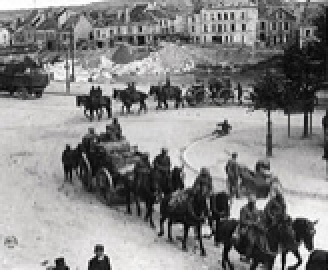
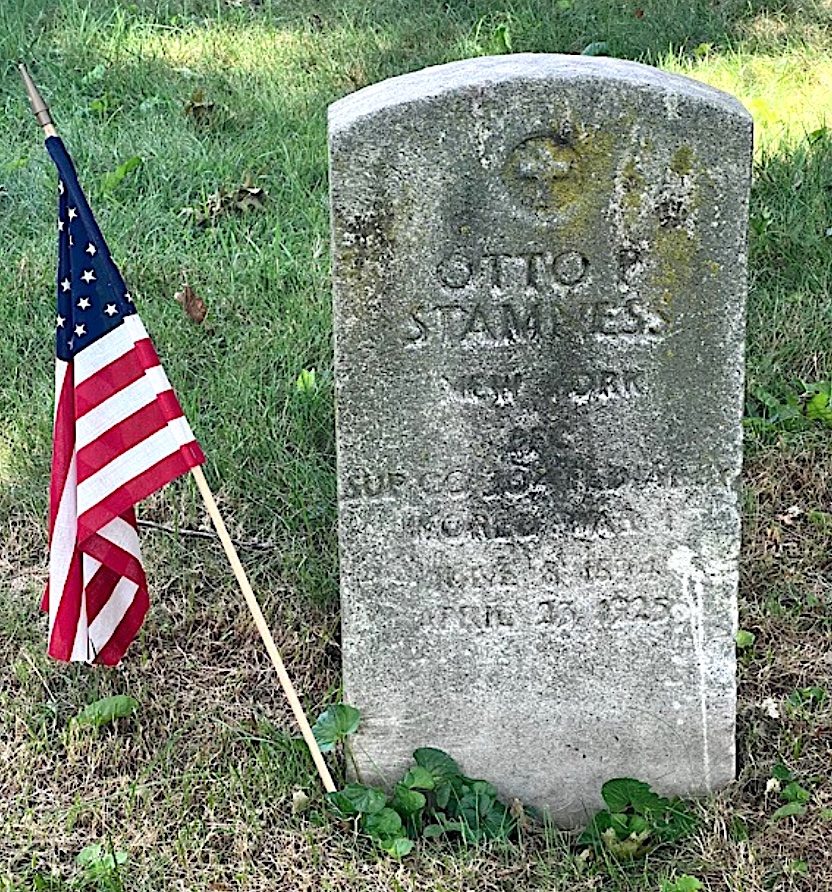
STEEL, LILBURN H. (1882-1940). First lieutenant, 498th Aero Squadron, American Expeditionary Forces, United States Army Air Service. Lilburn H. Steel was born about 1882 in Pennsylvania. He enlisted in the United States Army Air Service, was commissioned on September 27, 1917, and was assigned to the 498th Aero Squadron achieving the rank of first lieutenant. Aero squadrons were the designated U.S. Army aviation units during World War 1. These units consisted of combat flying, training, ground support, construction and other components of the Air Service. The 498th was a construction squadron, building airfields for the First Army and was part of the American Expeditionary Forces serving in Europe from September 25, 1918 to January, 1919. Upon demobilization of his unit, Steel was honorably discharged on January 27, 1919.
The 1930 census reports that Steel was married, was a World War veteran and lived at 940 Pelham Biltmore Apartment Hotel in Pelham Manor, New York, where he paid $90 per month in rent. At that time, he was working as a mortgage salesman. He died in Rutland, Vermont. The cause of his death was tuberculosis. On April 25, 1941, Alice Steel, his widow, applied for a government-issued headstone with a Christian emblem, citing her husband’s World War service. Section 150, lot 15973.
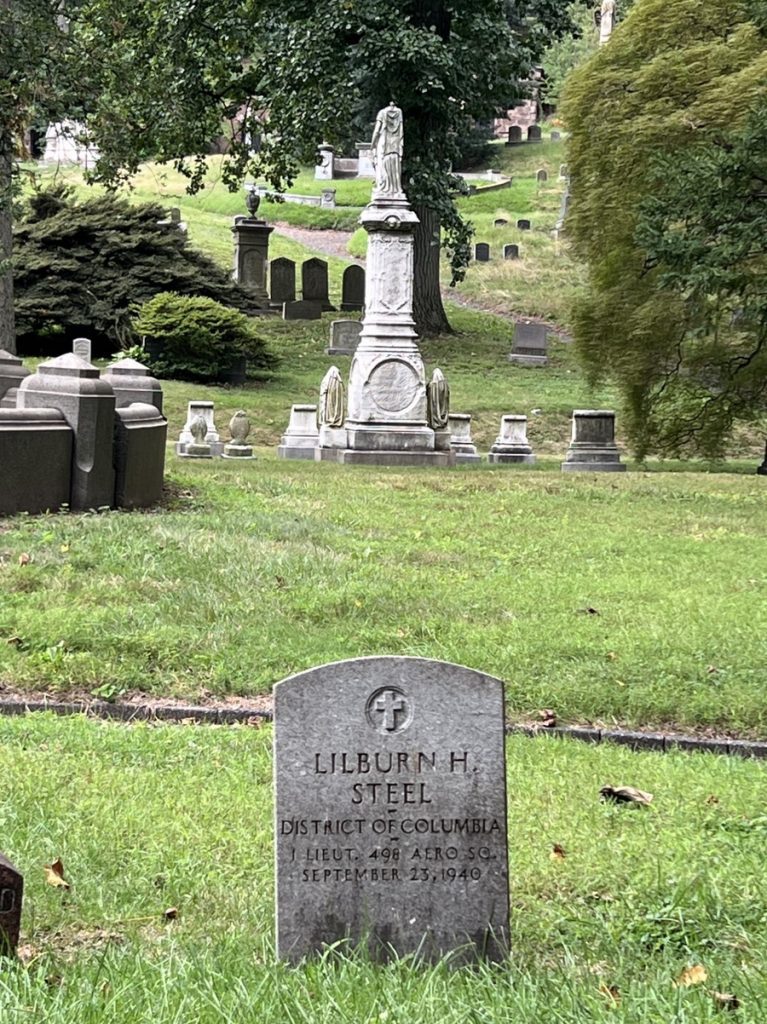
STENECK, HENRY W. (1893-1918). Sergeant, 305th Infantry, Headquarters Company, 77th Division, American Expeditionary Forces, United States Army. A native of Brooklyn, Steneck graduated from Public School 46 and the Heffley Business School. The 1910 census records that he was living in Brooklyn with his parents, a sibling, and a household servant. According to Steneck’s 1917 Draft Registration Card, he was managing his father’s business, was single, tall, of medium build, and had blue eyes and blond hair. He claimed exemption because of rheumatism and foot problems. Despite these ailments, Steneck was inducted into the Army on September 20, 1917, as a private in the Headquarters Company of the 305th Infantry Regiment. The 305th was organized and trained at Camp Upton in Yaphank, Long Island, New York, and assigned to the 77th Division. He was promoted to corporal on November 22, 1917, and to sergeant on February 18, 1918. On April 16, 1918, he shipped out to France.
During the Argonne offensive in late September, Steneck commanded a trench motor section attached to Company M, 3rd Battalion. On October 2, 1918, when his section came under German machine gun fire from an elevated position about 200 yards away, Steneck and three others attacked the machine gun position. Steneck took a bullet in his right shoulder as he was lying in a prone position. Mortally wounded, he died in a military hospital a few hours later. His last residence was 457 Third Avenue in Brooklyn. After his remains were returned home, he was re-interred on July 27, 1921. Section 192, lot 29447, grave 6.
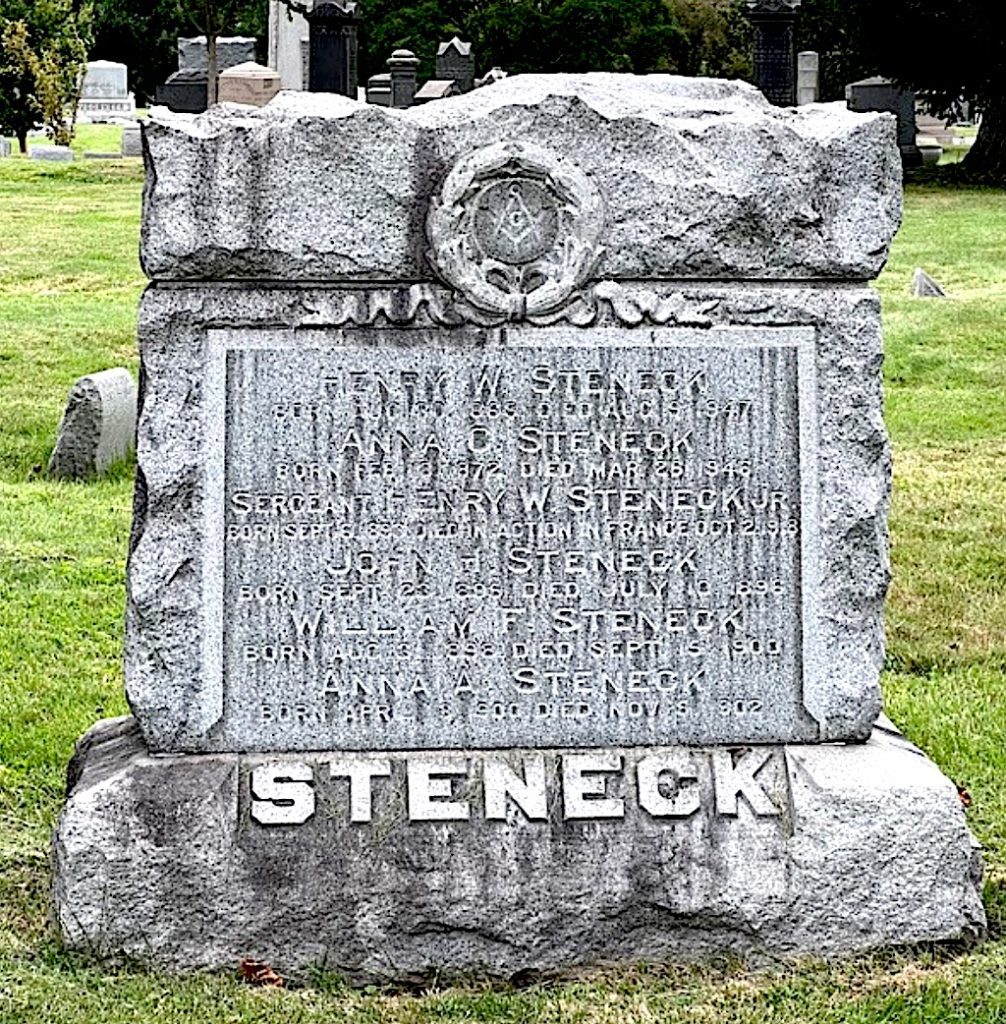
STEVENS, DAVID E. (1883–1923). Unknown soldier history. A Brooklynite, Stevens’s Draft Registration Card shows that he was a marine engineer working at 82 Beaver Street in New York City. The 1920 census lists him as an engineer in the tugboat industry. His last residence was Walcott Street in Brooklyn. Stevens died of tuberculosis at the U.S. Marine Hospital on Staten Island. Section 133, lot 16874, grave 44.
STOWE, CLARENCE MORTIMER (1887-1969). Master engineer, junior grade, 33rd Engineers, American Expeditionary Forces, United States Army. Stowe was born in Ashburnham, Massachusetts. The 1900 census states that he lived with his mother at 90 Chapel Street in Ashburnham. As per his World War I Draft Registration Card, filed June 5, 1917, he lived at 750 Marcy Avenue in Brooklyn, and worked as a structural steel draughtsman for the Stowe Construction Company in Greenpoint, Brooklyn. He was single, short in height, slender with brown eyes, black hair and no disabilities. He enlisted on February 15, 1918. On May 10, 1918, his name appeared on the manifest of the USS Dwinsk departing from Hoboken, New Jersey, her likely destination was Europe. Stowe was listed as a private first class in the 33rd Engineers with a home address of 750 Marcy Avenue in Brooklyn. His next of kin was his mother Jeremie Stone Stowe. On June 10, 1919, he was discharged with the rank of master engineer, junior grade.
In 1919, he married Isabel Raynor in New Jersey. According to the 1920 census, he lived at 396 East 18th Street in Brooklyn with his wife and mother-in-law, worked as a draftsman for a steel company, and was able to read and write. Stowe’s lecture on “Plato and Theosophy” at the Theosophical House at 95 Lafayette Avenue in Brooklyn on January 23, 1921, was announced the previous day in the Brooklyn Daily Eagle. (The theosophy movement aimed at the quest of Hindu spiritual wisdom through Western enlightenment.) On March 10, 1922, the Brooklyn Daily Eagle listed Stowe as one of the directors of New York Bolt & Specialties Company, Inc., with a capital of $43,000. That newspaper reported on April 9, 1923, that Stowe read a paper on Krishna at the Theosophical Society meeting of the Brooklyn Lodge at 95 Lafayette Avenue. As per the 1925 New York State census, he lived in Queens with his wife and three-year-old son who bore his name. As per the 1930 census, he owned his home on 187th Street Queens that was valued at $7,500. At that time, he and his wife had two children. That census lists him as a World War I veteran who was employed as a civil engineer in the contracting industry. On December 18, 1936, the Brooklyn Daily Eagle reported that Mrs. Stowe, the president of the Mothers’ Club at P.S. 35 in Hollis welcomed seven new members.
The 1940 census reports that Stowe still lived at 88-80 187th Street with his wife, children and father-in-law; his home was valued at $6,000. He worked as an estimator, had earned $2,500 in 1939, had completed four years of college, had a social security number and was a World War veteran. His World War II Draft Registration Card, filed in 1942, reports that he had a home phone, lived at 88-30 187th Street in Hollis, Queens, and worked for Johnson, Drake & Piper at 86 Trinity Place in Manhattan. He listed his wife as his next of kin. On May 27, 1970, Marion S. Angelo, his daughter, applied for a Veteran’s Headstone with a flat bronze marker for her father, citing his service in World War I. Section 80, lot 3769.
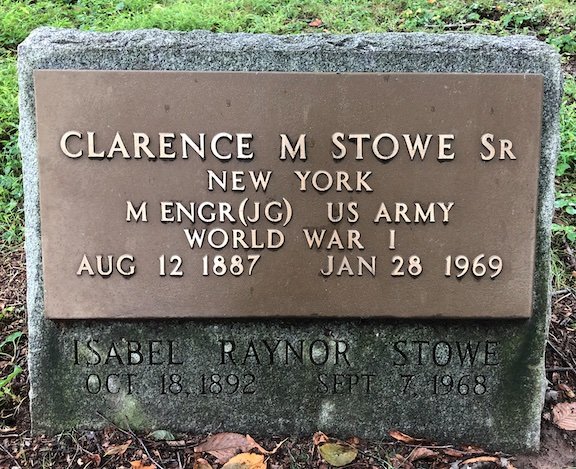
SWANWICK, THOMAS (1897-1918). Rank unknown, Third Training Battalion, 12th Company, 153rdDepot Brigade. Swanwick was born in New York City and raised in Brooklyn. The 1910 United States Census shows him to be living on Prospect Park West with his mother and four older siblings. He had been a student at P.S. 10. Little is known of his service records, other than his death from pneumonia in the fall of 1918. He was interred on October 5, 1918. His last residence was 595 Bergen Lane in West New York, New Jersey. Section 131, lot 33391.
SWEENEY, HENRY CLINTON (1880-1961). Major, Quartermaster Corps, Construction Division, United States Army. Sweeney was born in South River, New Jersey. The 1910 census reports that he lived on President Street in Brooklyn with his wife and young child and worked as a civil engineer in the buildings industry. Sweeney enlisted as a captain on June 19, 1917, and was assigned to the Construction Division of the Quartermaster Corps on July 7. At the time of his enlistment, Sweeney lived at 259 Winthrop Street in Brooklyn. He was promoted to major on October 22, 1918. According to his soldier record, he served at Ayer, Massachusetts; Washington, D.C.; Camp Meade, Maryland; Camp Doniphan, Oklahoma; and Fort Wood, New York; he did not serve overseas or incur any wounds. He was honorably discharged on March 11, 1920.
Sweeney was a passenger on the President Harding, a passenger ship that departed from Southampton, England, and arrived in New York City on October 28, 1927; that ship also stopped in Cherbourg, France. The 1930 census reports that he was a widower who lived at 40 Lincoln Road in Brooklyn, was a World War veteran and worked as a contractor in the building industry. As per his World War II Draft Registration Card, he lived at 25 E Street, N.W. in Washington, D.C. and was a senior engineer with the United States Government’s War Department. On the aforementioned document, he listed William Sweeney (relationship unknown) of 3516 85th Street in Jackson Heights as his next of kin. He died in St. Petersburg, Florida. On January 2, 1962, James Sweeney, his son, applied for a government-issued granite marker with no religious emblem, citing his father’s service in World War I. Section J, lot 36647.
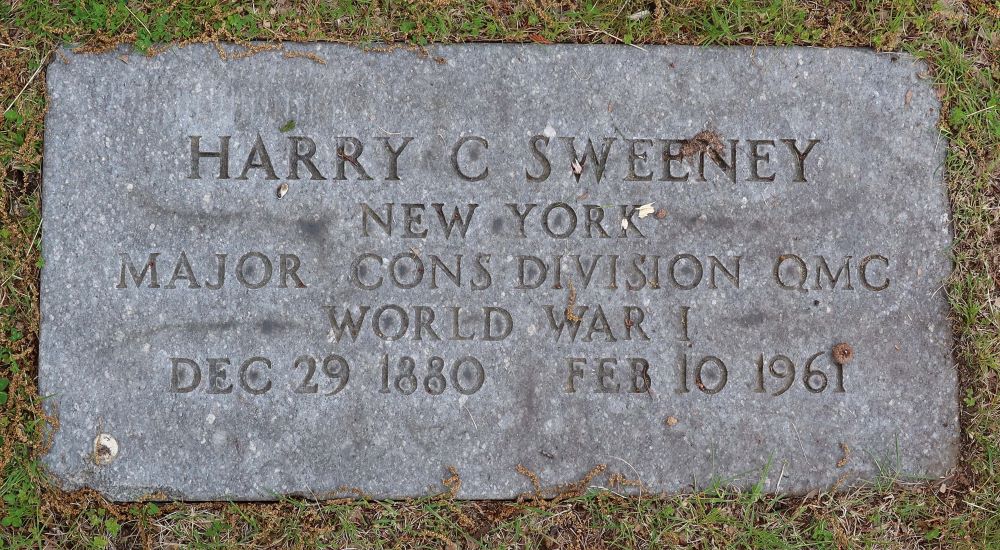
SWEENY (or SWEENEY), WILLIAM S. (or L.) (1898-1979 ). Private first class, Field Signal Battalion, Company C, American Expeditionary Forces, United States Army. Sweeny was born in Brooklyn. According to his New York State Military Abstract for World War I, he enlisted on November 18, 1917, at Fort Slocum, New York, and was assigned to Company C of the 102nd Field Signal Battalion; at the time of his enlistment, he lived at 287 Carlton Avenue in Brooklyn. After a promotion to private first class on March 5, 1918, he was sent overseas on May 17, as part of the American Expeditionary Forces, and was wounded in action on October 16, 1918. He returned from overseas duty on March 15, 1919, and was honorably discharged the next month on April 4.
As per the 1920 census, Sweeny lived on Carlton Avenue in Brooklyn with his father and siblings, was single, and worked as a clerk in a railroad office. The 1930 census reports that he was married, lived at 287 Carlton Avenue with his wife, had no radio set, worked as a wire chef in the telephone industry and was a veteran of the World War. At the time of the 1940 census, Sweeny lived with his wife and two children on East 21st Street in Brooklyn, and was a clerk who had completed eighth grade; he noted that he had not worked at all in 1939 and had been unemployed for 160 weeks but had income from other sources.
Sweeny remained active in the military as noted by his New York State Military Card and the inscription on his gravestone. He served in the New York State National Guard as a private in the 27th Signal Corps as of November 6, 1922; then as a second lieutenant in the 165th Infantry, headquarters company, as of July 12, 1923. He rose to first lieutenant of the Second Battalion on August 2, 1924, transferred to the Third Battalion on January 26, 1931, and became captain of the 165th Infantry three days later. His unit was detailed to active duty for two weeks beginning on July 12, 1936 and again for two weeks as of June 27, 1937. As of the 1940 U.S. Training Act of October 15, 1940, he was listed as a captain attached to the 165th Infantry. His military record notes that Sweeny was a major in the United States Army as of November 1942; a lieutenant colonel as of August 15, 1945, and was released from active duty as of August 15, 1945, but was promoted to colonel in the Officers’ Reserve Corps on February 13, 1946. On March 25, 1946, he was named a colonel in the New York National Guard. His gravestone notes service in the Korean War; his military service card reports that he was released from active duty on August 1, 1952. Section ?, lot ?.

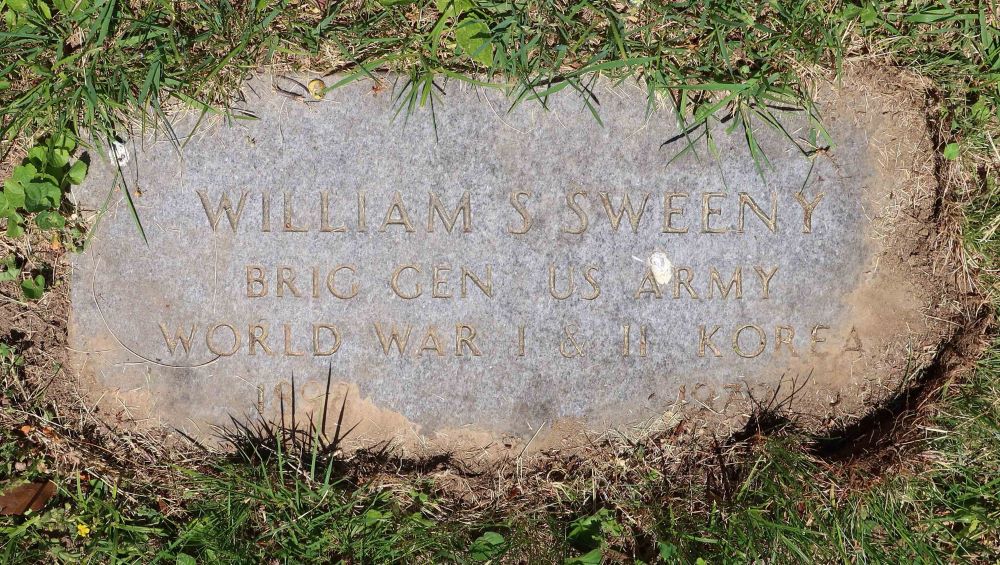
TAFT, JOHN (1889-1968). Private, 347th Infantry, Company L, 87th Division, American Expeditionary Forces, United States Army. Born in Arendal, Norway, Taft immigrated to the United States circa 1906. (There are conflicting dates of his immigration year on census data.) According to the 1910 census, he lived with his parents and two siblings on Homecrest Avenue in Brooklyn, was not a U.S. citizen, and was employed as a carpenter. On his Draft Registration Card of June 5, 1917, he described himself as short, of medium build, with blue eyes and brown hair. At that time, Taft lived at 1819 Ocean Parkway in Brooklyn and worked as a carpenter; he claimed an exemption and indicated that he was the sole support of his mother. However, on June 23, 1918, Taft was inducted into the Army and served as a private in Company L of the 347th Infantry; his regiment was part of the 87th Division. His unit shipped out to France on August 23, 1918, and returned home on December 12, 1918. He received his honorable discharge on January 18, 1919. The 87th Division, known as the “Gold Acorn” Division, was utilized mainly as a labor unit in France. After the 87th returned to Fort Dix, New Jersey, in January 1919, it was deactivated in February.
The 1920 census shows Taft employed as a carpenter in the house building industry, and living with his mother and married sister’s family on Ocean Parkway in Brooklyn; that census notes that he had become a naturalized citizen. By the 1930 census, he was married with a young daughter, employed as a mechanic, and living in a rental at 300 Kermit Place in Brooklyn; that census notes that he owned a radio set and was a World War veteran. The 1940 census notes that he was living with his wife and two children in a rental on Greenwood Avenue in Brooklyn where the rent was $35 per month and that he worked as a watchman; he had completed an eighth grade education and had earned $1,300 the previous year. His headstone proudly notes his World War I service. Section 131, lot 35180.
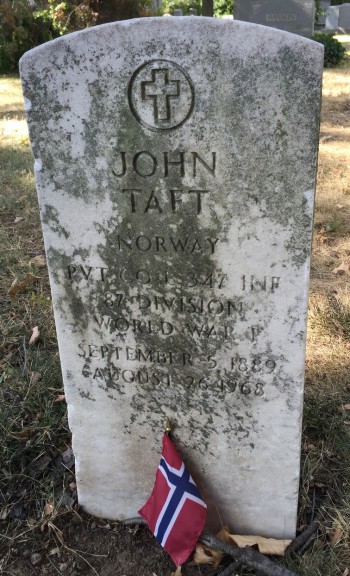
TALLON (or FALLON), ROBERT J. (1897-1970). Mechanic, 32nd Artillery, Battery B, Coast Artillery Corps (CAC), United States Army. Tallon was born in New York City. At the time of the 19oo census, which has his surname misspelled as Fallon, he lived with his parents and sibling at 89 James Street in Manhattan. The 1910 federal census and the New York State census for 1915 report that Tallon lived in Brooklyn with his parents and siblings; in 1915, he worked in the motion picture industry. His Draft Registration Card, filed in August 1918, notes that he lived at 17 East 4th Street in Brooklyn, was of medium height and build, had blue eyes and brown hair, and worked in the ordnance department of an iron works company in Jersey City, New Jersey; he listed his mother as his next of kin. As per his New York State Abstract of World War I Military Service, he was inducted at Brooklyn on October 23, 1918, and assigned as a mechanic to Battery B of the 32nd United States Artillery until his discharge on December 3, 1918; he did not serve overseas. His assignment was to the Coast Artillery Corps (CAC), an administrative corps that operated from 1901 through 1950 and was responsible for the coastal, harbor and anti-aircraft defense of the United States; it also operated heavy and railway artillery during World War I.
As per the 1920 census, he was single, lived on East 4th Street in Brooklyn with his parents and siblings, and worked as an inspector for the United States Army. As per the 1930 and 1940 censuses, he lived at 517 Vanderbilt Street in Brooklyn with his wife, Gilberta, and children, had a radio set, was a veteran of the World War, and worked as a railroad engineer; the 1940 census notes that he had completed an eighth grade education and had earned $2,000 in 1939. Section Yard, lot 39000, grave 1630.
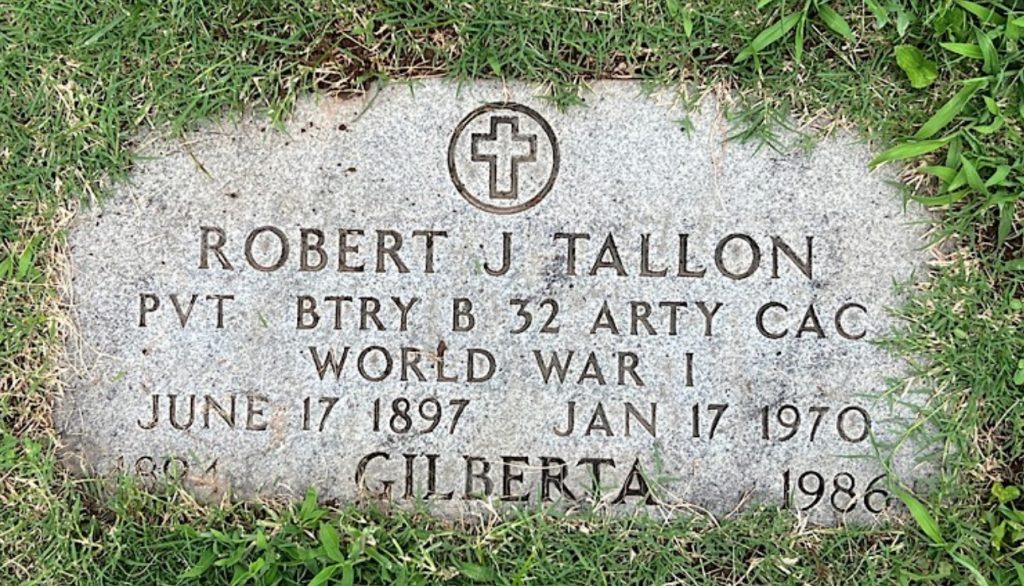
TAYLOR, ERMOND ALBERT (1898-1919). Chief quartermaster, United States Navy Reserve Force. Taylor was born in Philadelphia, Pennsylvania, and studied at the Brunswick School in Greenwich, Connecticut. He entered the Massachusetts Institute in 1916 and studied there for one year. As per the 1918 Massachusetts Institute of Technology (M.I.T.) Yearbook, Technique, he belonged to the Mandolin Club and the Sigma Alpha Epsilon fraternity and lived in Greenwich, Connecticut; he was also in the chorus of the Tech Show. In June 1917, he transferred to Columbia University in New York City where he excelled in athletics and engaged in many student activities.
On June 27, 1918, Taylor enlisted in the Navy Reserve at New York City as chief quartermaster aviation. At that time, he lived at 21 Claremont Avenue in the Bronx. His soldier record indicates that he served in that capacity at M.I.T. from August 9, 1918, through November 11, 1918, and was made cadet commanding officer. As per his biographical sketch, he was transferred to Miami, Florida, where he became commander of the cadet beach squadron. As per his obituary in The New York Times, he died in a seaplane accident on February 19, 1919, as part of the Naval Aviation Corps, in Miami. Nearing the end of his training as a pilot, the engine overheated on the seaplane that he was piloting, and crashed into the bay. His funeral services, with military honors, were held at the Park Congregational Church at Eighth Avenue and 2nd Street in Brooklyn. Boston newspapers were asked to print the notice of his death. In February 1936, E. Taylor of 29 East 80th Street, Manhattan, applied for a government-issued headstone citing Ermond Taylor’s service in the World War. Section 188, lot 20313.
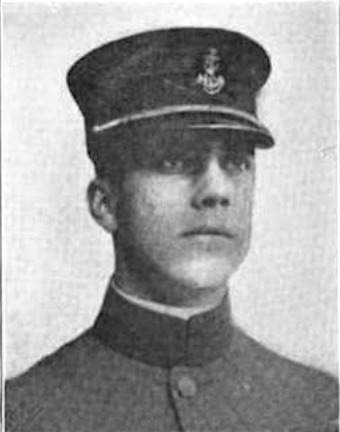
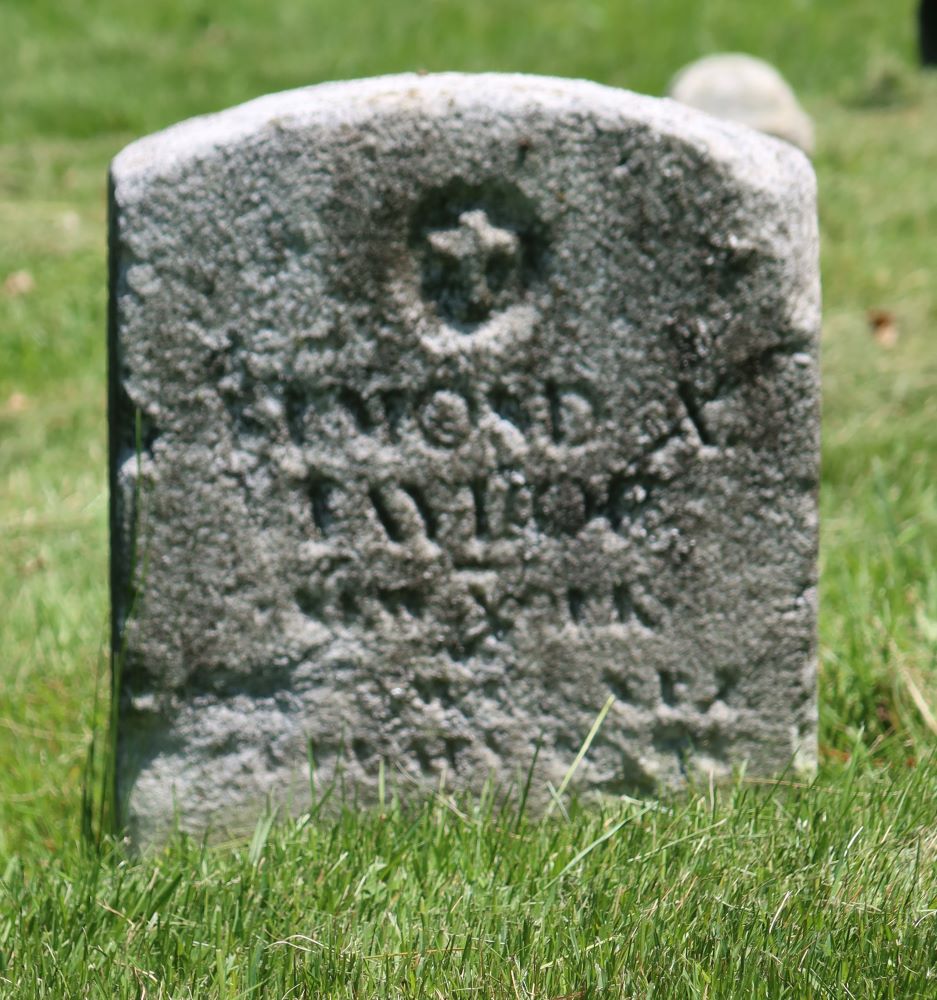
TERHUNE (or TUHUNE), TEN BROECK (or TENBROOK, TOM) MONROE (1879-1957). Captain, Ordnance Corps. Terhune was born in New York City. On January 26, 1909, he applied for membership in the Sons of the American Revolution, stating that he was a direct descendant of Adam Ten Broeck of Claverack, New York, who served as an ensign in 8th Regiment of the New York State Militia, 4th Company, in the 1st Claverack Battalion in 1778; his ancestor was also a standard bearer for that regiment. His application noted that his paternal ancestors were wealthy merchants in Albany and that one of his maternal ancestors, Joseph H. Terry, was an officer in the Navy during the American Revolution. The 1910 census reports that Terhune had been married for four years, rented at 251 West End Avenue in Manhattan with his wife, Florence, and young child, and worked as a solicitor for an insurance company. As per the application for his government-issued headstone, he served as a captain in the Ordnance Department at the Aberdeen Proving Grounds in Aberdeen, Maryland. His soldier record notes that he was called into active service on June 18, 1918, did not serve overseas and was discharged on March 17, 1919. Terhune lived at 470 Park Avenue in Manhattan during his military duty.
According to the 1920 census, Terhune owned an insurance company and lived in a rental on Park Avenue in Manhattan with his wife and children. Terhune applied for a passport in 1922 to visit the British Isles, France and Germany for five weeks; he stated that he was in the insurance and real estate business. At the time of the 1925 New York State census, he lived in Manhattan with his brother and three children and was in the real estate business; his wife was not listed on that census. The 1930 census shows that Terhune owned his home at 510 Park Avenue in Manhattan which was valued at $75,000 (equivalent to $1,100,000 in 2017 money); he was married to Florence and lived there with his three children. That census notes that he had a radio set, and was a World War veteran.
Records from Sing Sing Prison in Ossining, New York, show that Terhune, who appears to have had at least one earlier conviction, was convicted of grand larceny in the first degree and was sentenced on April 13, 1938, because he “stole jewelry under false pretenses”; the jewels were valued at $4,650. He had already been jailed for 42 days and was eligible for parole on March 15, 1939. The paperwork from Sing Sing, which indicates an incorrect birth year of 1884, reports that Terhune was Episcopalian, spoke French, was a high school graduate, and owned a business at 45 East 66th Street in Manhattan. He last lived in Manhattan. On May 15, 1957, Florence Terhune applied for a government-issued headstone with Christian emblem, citing her husband’s World War I service in the Ordnance Corps. Section 34, lot 7378.

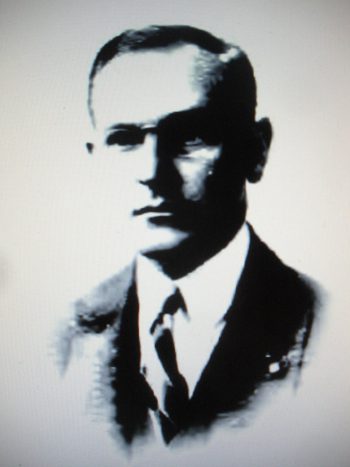
THOMPSON, HUGH (1859-1936). Chief gunner’s mate, United States Navy. As per the 1930 census, Thompson was born in Scotland; his Navy enlistment papers list his birthplace as Liverpool, England. Thompson’s United States Naval Records indicate many enlistments. He first enlisted on January 16, 1882, and his name appeared on the records of the New York Rendezvous on November 20, 1888. At the time of the latter enlistment, he was a mariner who was 5′ 3/8″ tall, 105 pounds with hazel eyes, brown hair, a scar on his left wrist and a shield tattoo on his breast. He was honorably discharged on October 16, 1897. He re-enlisted on December 28, 1897, at New York and was assigned as a first class gunner’s mate to the USS Vermont before he was assigned to the USS New York for service in the Spanish-American War; he later returned to the USS Vermont. On December 27, 1900, he was honorably discharged as a chief boatswain mate at the expiration of his enlistment. He re-enlisted on February 25, 1901, and retired on August 29, 1911. On October 8, 1910, he married Henrietta Elkein at the East Church in Brooklyn.
Thompson was recalled from the Retired List as a chief gunner mate on May 7, 1917, for service during World War I and officially retired on October 31, 1919. As per his obituary in the Brooklyn Daily Eagle, he had served in the Navy for 30 years, and was awarded several service medals and certificates. That obituary notes that Thompson was on the USS New York during the Battle of Santiago in the Spanish-American War; during the World War, he was recalled and was assigned to train recruits and to direct athletic activities among sailors. According to the 1930 census, he lived at 530 2nd Street in Brooklyn, was married, owned a radio set, was a naturalized citizen, worked as a runner for a brokerage and was a veteran of the World War. His funeral took place at the George J. Ayen Memorial Chapel at 55 Seventh Avenue in Brooklyn. He last lived at 530 2nd Street; his obituary notes that he died suddenly. On March 18, 1936, Henrietta Thompson, his widow, applied for a government-issued headstone with Christian emblem, citing her husband’s service in the Navy. Section 129, lot 36459.
THOMPSON, LEROY (or LERAY) HERBERT (1899-1918). Cadet, Royal Air Force of Canada. Leroy was a native of Nyack, New York. At the time of the 1900 census, he was living at 108 High Avenue in Orangetown, New York (Rockland County) with his parents, Leila and William, and a servant. The 1915 New York State census reports that the family, William, Mary (his stepmother), and Leroy, were living in Brookhaven in Suffolk County; Leila divorced William and remarried in 1907.
During World War I, Thompson was a cadet, enlisted in the Royal Air Force of Canada, from May through October 1918. His obituary in Chicago’s National Hotel Reporter states that he entered service as a cadet in Canada’s Royal Air Force because he was too young to join the American service. Prior to his enlistment, Leroy was chief clerk of the Brooklyn Country Club at Bridgeport, Connecticut. He was given a military funeral in Toronto before his remains were taken to Brooklyn for burial at Green-Wood.
As per the inscription on his gravestone at Green-Wood, he died in the base hospital at the age of nineteen in Toronto, Canada, on October 30, 1918. On November 1, 1918, the New York Evening World reported on Leroy’s death from pneumonia. The article indicated that he was a cadet in the Royal Air force and was the only son of Mr. and Mrs. Wm. Thompson of Port Jefferson, New York; William Thompson was the proprietor of the Ardencraig Inn there. Leroy’s gravestone displays these words: “His Life For His Country And His Soul To God.” His name appears on an online list, Commonwealth War Graves, of the final resting places of British Commonwealth veterans. Section 176, lot 18399.
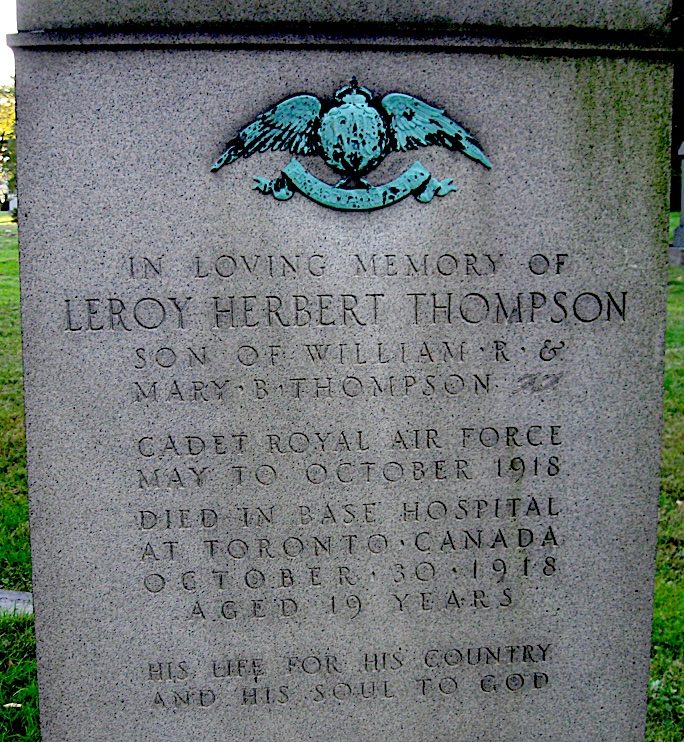
THOMPSON, RALPH SHOTWELL (1895-1918). Private first class, 307th Infantry, Company B; 10th Company, 1st Infantry Training Regiment, Dep. Division, 1st Army Corps, American Expeditionary Forces, United States Army. As per his Draft Registration Card filed in Brooklyn at Manual Training High School (now John Jay High School) on Seventh Avenue in Brooklyn on June 5, 1917, he was single and employed as a clerk. He was inducted at New York City on September 10, 1917, and assigned to Company B of the 307th Infantry. Thompson was promoted to private first class on November 1, 1917. On January 16, 1918, he was sent to Camp Upton #2 (in Yaphank, New York) to the Repl. Dep. Division and was sent overseas on March 12, 1918. On March 26, 1918, he was reassigned to the 10th Company, 1st Infantry Training Regiment, Dep. Division, 1st Army Corps. He died from meningitis in France on April 1, 1918. Lillie Thompson, his mother, was notified of his death. He last lived at 195 Garfield Place in Brooklyn. He was first buried in France. After his body was returned to the United States, he was re-interred on November 5, 1920. Section ?, lot 29725, grave 489.
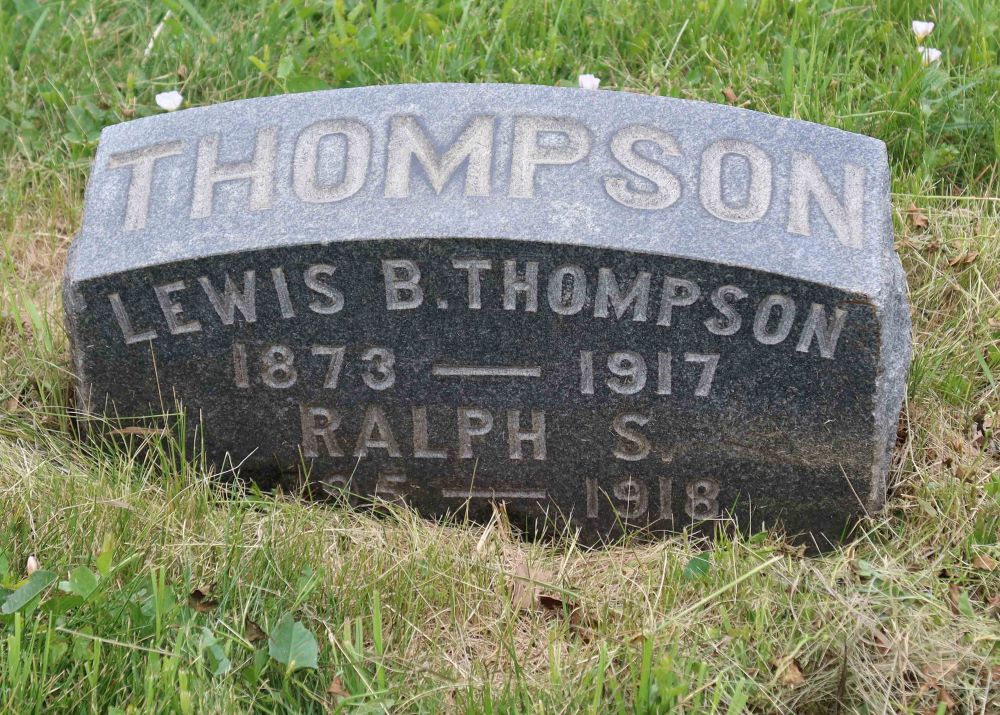
TINKER, ANNIE RENSSELAER (1884-1924). Philanthropist, suffragist, World War I volunteer nurse. Born in New York City, her father, Henry Champlin Tinker, was president of Liberty National Bank and heir to the family fortune. In 1890, he purchased a summer home in the Village of Poquott, located between Setauket Harbor and Port Jefferson Harbor on New York’s Long Island. During her visits there, Tinker would swim, sail, horseback ride, and drive horse carriages and automobiles. Tinker, a self-described “spinster,” believed in equality and independence for women. A portrait of her in her equestrian outfit in 1899 by the artist Louise Lyons Heustis is at the New-York Historical Society. She is depicted in a man’s smoking jacket with exotic accessories flauting the conventional beliefs of how a woman should look and behave. She was one of the first women to ride her horse astride (not side saddle) in Central Park.
Events at her summer home demonstrate her independence, leadership, and willingness to get involved. Having learned how to sail the family yacht, she invited a group of women friends to sail from Long Island to the New York Yacht Club for lunch. Since the club did not serve women, Tinker and her friends were turned away at the club’s dock and had to sail back to Long Island. During a yacht excursion, she realized that her footman had fallen into the water. Although there were men on board, Tinker, fully dressed, jumped into the water in search of the man. Unfortunately, she was unable to find him and his body was later recovered by neighbors. When a forest fire threatened the home of her neighbor, Tinker arrived with a man servant and shovel and joined others in the community to put out the fire.
In her quest for women’s rights, Tinker joined the Women’s Political Union, an organization founded by the daughter of Elizabeth Cady Stanton. She took part in numerous meetings, rallies and marches. In 1911, she formed a women’s cavalry. An excellent equestrian, she gave riding lessons to the cavalry members and the group participated in suffrage marches. She and her cavalry were to lead a massive march of 30,000 participants up Fifth Avenue in Manhattan, but she had to withdraw due to her emergency appendectomy the day before. Tinker scandalized elite society with her belief that women should go to war and fight beside men in the cavalry.
Tinker’s wealth and privileged life did not deter her from taking part in humanitarian causes. With the outbreak of World War I in 1914, she sailed to Europe and volunteered as a nurse for the British Red Cross. She provided aid and comfort to soldiers on the front lines in Belgium, France and Italy. She was the head of the hospital at Ostend, Belgium. In 1921, the French government awarded her a medal for her relief work. That medal, the French Medal of Recognition (Medaille de la Reconnaissance Francaise), was intended to publicly testify gratitude to those who came to the aid of the wounded, sick, disabled, children and families of those killed in the war who did not act out of military obligation or “through a simple donation or an occasional participation to some charity or assistance.”
After the war, Tinker rented a home in France and entertained her friends. Upon the death of her father, she inherited land, property (including the summer home in Long Island), and shares in the family business. Her last wishes were to have a female friend inherit her fortune and to have a charitable foundation set up to support elderly women. Her inheritance went into probate when her mother challenged Tinker’s will. The court split the inheritance among Tinker’s friend, her mother, and her brother. Her friend, following Tinker’s last wishes, established the Annie R. Tinker Memorial Home in 1924. The name was later changed to Annie Tinker Association for Women Incorporated. The organization provided older women, who could no longer work, with monthly stipends so they could remain in their homes. The organization dissolved in 2018. Tinker died due to complications following a tonsillectomy. Her headstone reads: “Rarely such courage in a man and never in a woman.” Section 161, lot 27605.
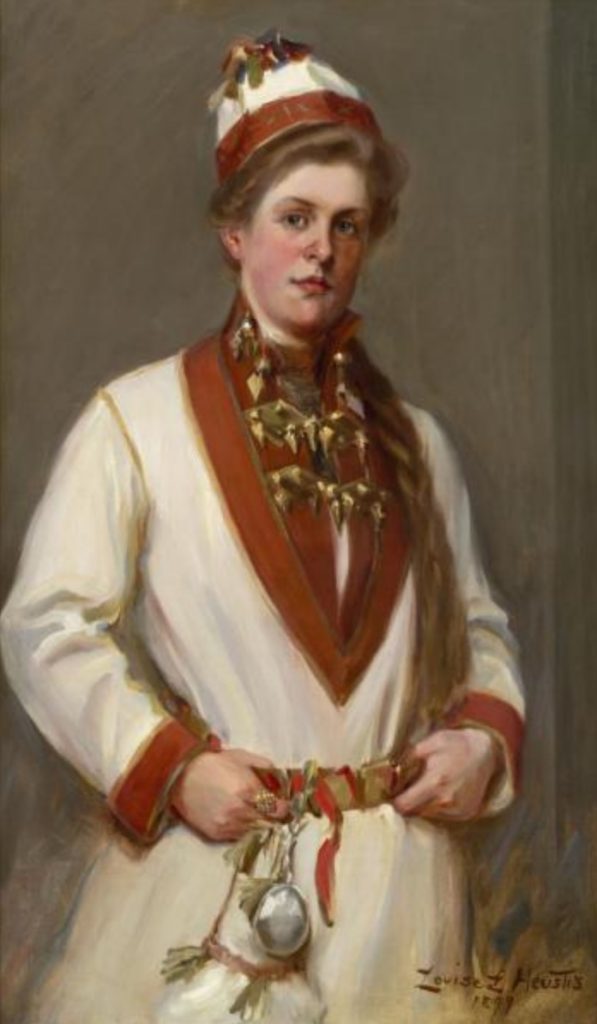


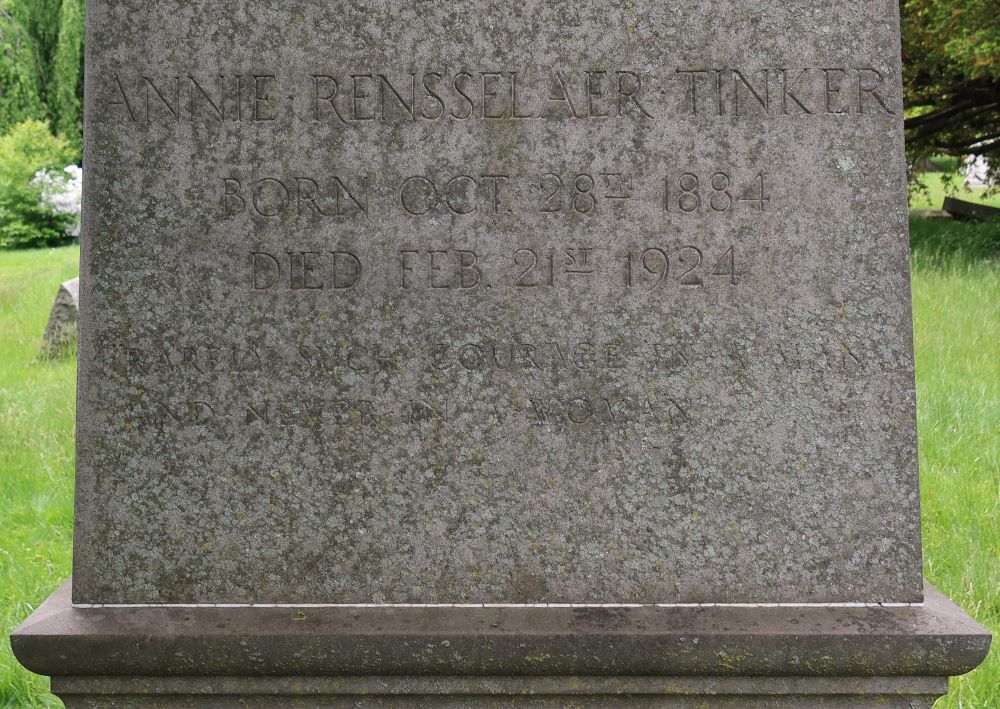
TIPPING, EDWARD A. (1887-1939). Sergeant, 16th Aero Construction Company; 866th Aero Squadron, American Expeditionary Forces, United States Air Service. A New Yorker by birth, Tipping, according to the New York State census of 1905, was living in New York City with his parents and five siblings. The 1906 New York City Directory lists him as a broker at 99 Water Street in New York City. As per his Draft Registration Card of June 5, 1917, he described himself as single, tall and stout, with grey eyes and brown hair; he reported that his eyesight was poor. At that time, he worked as a carpenter in Glen Cove, Long Island, where he lived on School Street. Tipping was inducted into the Army at Glen Cove on May 23, 1918, and was assigned to the 16th Aero Construction Company. Aero Construction Companies were established to build airfields and aerodromes, both in the states and abroad. He was sent overseas on August 8, 1918, promoted to sergeant on October 16, 1918, and returned from abroad on April 14, 1919. On April 22, 1919, he was transferred to the 866th Aero Squadron and was honorably discharged on May 25, 1919. He last lived at 8611 32nd Avenue in Jackson Heights, Queens.
Tipping died at the Veterans Hospital in the Bronx; his death was attributed to myocarditis (inflammation and damage to the heart muscle). Five months after his death, Isabel Nairn applied for a government-issued headstone with a Christian emblem for Tipping, citing his service in the World War. Section 85, lot 32200, grave 11.
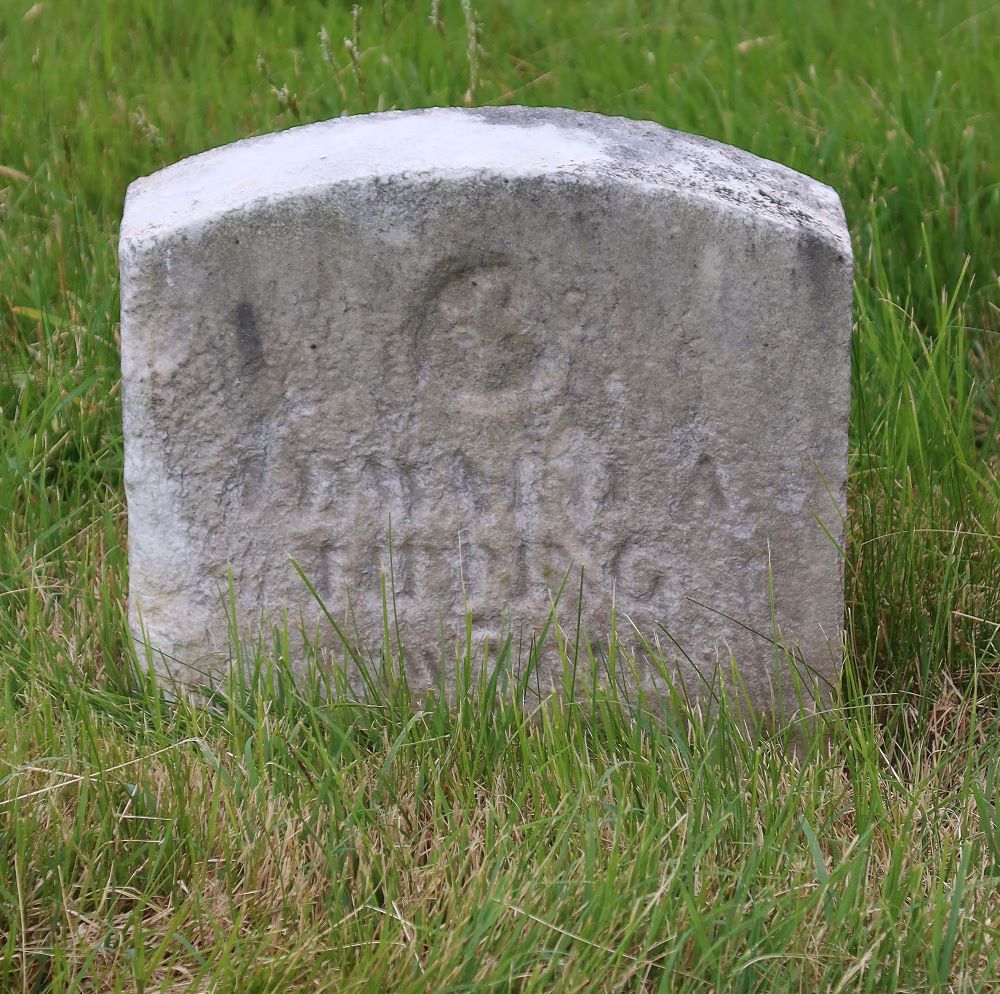
TOTTEN (or TATTEN), ARTHUR (or ANTHONY) CRANSTON (1899-1979). Sergeant, 165th Infantry, Company C, American Expeditionary Forces, United States Army. Totten was born in New York City. As per the 1900 census, which recorded him as Anthony Tatten, he lived in Manhattan with his parents and siblings. The 1910 census notes that Totten lived on West 103rd Street in Manhattan with his parents and older siblings; he attended school at that time.
Totten enlisted as a private at New York City on January 4, 1916, mustered into Company D of the 71st Infantry on June 26, during the Mexican Punitive Campaign, and mustered out with his company at New York City on October 6, 1916. At that time, he was a student who was 6′ ½” tall with light brown hair, blue eyes and a fair complexion. He was promoted to corporal on February 12, 1917, and mustered into Company D, 71st New York State National Guard on March 30, 1917. He was transferred to Company C of the 165th United States Infantry on August 18, 1917, and promoted to sergeant on September 26.
On October 27, 1917, he departed from Montreal, Canada, about the Tunisian; at that time, he listed his mother as next of kin and lived at 206 West 103rd Street in Manhattan. As per his Military Abstract for World War I, Totten was severely wounded on July 30, 1918. He was honorably discharged on March 29, 1920 on a surgeon’s certificate of disability; that document reports that he was 90% disabled.
The 1920 census, which lists him as Arthur Cranston, notes that he was single and lived with his mother and siblings on West 103rd Street in Manhattan; his father had died in 1912. At the time of the 1930 census, he lived with his wife, Adrienne Cheron Totten, and son in Greenburgh, New York. That document notes that he married at age 25, owned his home that was valued at $26,000 (the equivalent of approximately $400,000 in 2020), had a radio set and worked as a dentist in private practice. The 1940 census notes that he was a dentist and teacher in Waynesville, North Carolina, was married and had worked 40 weeks in 1939, earning $2,000 with income from other sources.
As per his World War II Draft Registration Form, filed in February 1942, Totten lived on Summit Avenue in Franklin Lakes, New Jersey, and was self-employed and associated with Columbia University. He described himself as 6′ 2½” tall, 195 pounds with brown hair, blue-gray-hazel eyes, and a light complexion. His wife, Adrienne Totten, was listed as his next of kin. He last live in Barnegat, New Jersey. In 1979, Adrienne C. Totten applied on his behalf for a flat granite Veterans Administration gravestone. Section 113, lot 16875.

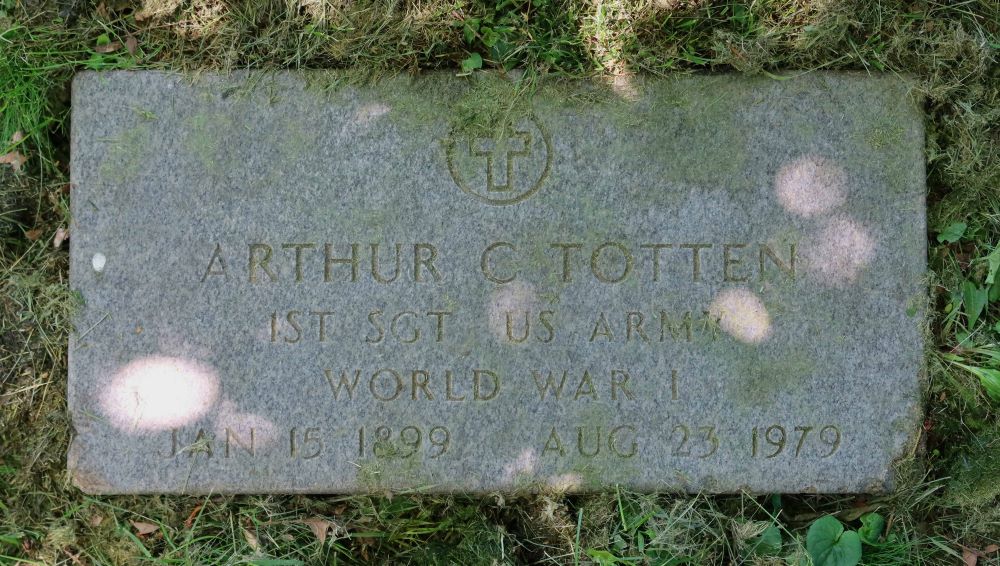
TOWELL (or TOWALL), THOMAS MURRAY (1889-1933). Private first class, 1st Field Artillery, New York State National Guard; 104th Field Artillery, Battery E, American Expeditionary Forces, United States Army. Towell was born in Glasgow, Scotland. As per the 1891 English census, he lived with his parents and siblings in Gloucestershire. Towell, whose military records use the spelling “Towall,” enlisted on July 19, 1917, and first served as a private in the 1st Field Artillery, New York State National Guard, before being promoted to private first class on September 28, 1917. His unit was re-designated as the 104th Field Artillery on October 1, 1917. Towell was reduced in rank to private on March 25, 1918, and re-instated as a private first class on May 1, 1918. Towell went overseas, to France, with Battery E of the 104th Field Artillery on June 30, 1918, was again designated as a private first class on Aug 2, and reduced to private on November 1, 1918. His term overseas ended on March 13, 1919, and he was honorably discharged on April 1, 1919, upon demobilization of his unit. As per his Military Abstract, he was not wounded during his service.
He last lived in Brooklyn; he is interred with his first wife, Barbara. On September 5, 1933, about two weeks after his death, Florence Towell, his widow, who lived at 4122 27th Street in Long Island City, New York, applied for a government-issued headstone, citing her husband’s service in the World War. Section 203, lot 35961, grave 2.
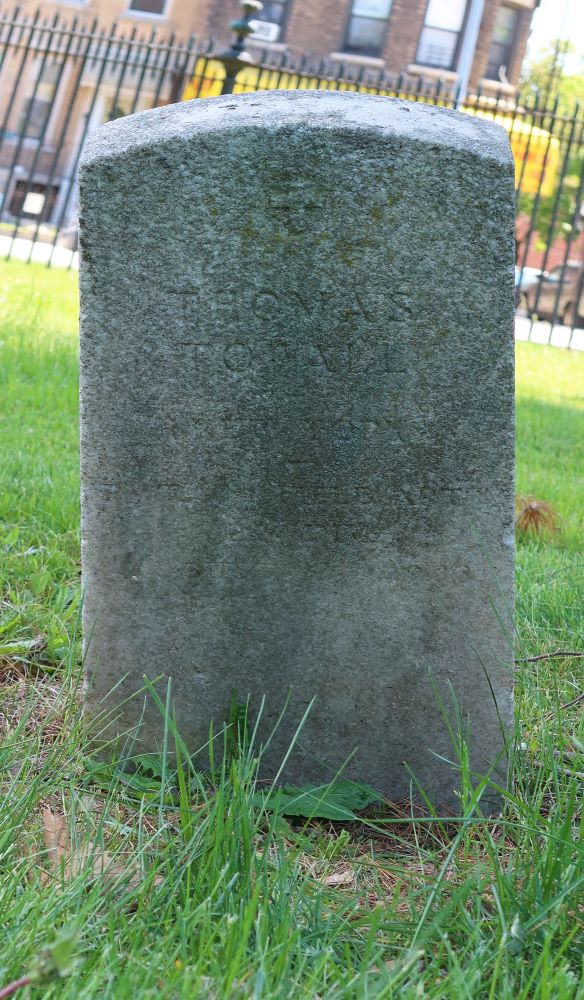
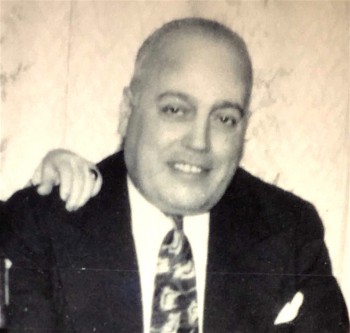
TRIMBOLI, JACK (or GIACOMO) A. (1895-1955). Private, 302nd Trench Mortar Battery; 13th Engineers Corps, Company C, American Expeditionary Forces, United States Army. Born Giacomo in the town of Milazzo, Sicily, Trimboli, his parents and five siblings immigrated to the United States in 1902. The census of 1910 notes that he was working as an apprentice brick layer and living with his family at 1342 59th Street in Brooklyn. As per his Draft Registration Card of June 5, 1917, he was described as medium in both height and build with brown eyes and black hair. On that document, he stated that he was single, lived at the same 59th Street address, and claimed an exemption from the draft because he supported his mother and father.
Nonetheless, Trimboli was inducted into the United States Army on October 10, 1917, was assigned to the 302nd Trench Mortar Battery, and went to Europe with his unit on March 5, 1918. The unit was part of the 152nd Artillery Brigade, 77th Infantry Division. On April 11, 1918, he transferred to Company C of the 13th Engineers Corps. The 77th Division participated in the Meuse-Argonne operations until the end of the war in November 1918. He remained with his unit in France until April 28, 1919, and was honorably discharged on May 14.
According to the 1920 census, Trimboli was single, living with his sister Frances and her husband at 70 Fish Street in Brooklyn and working as a mason; he was listed as a naturalized citizen whose native language was Italian. In the New York State census of 1925, he was living with his father at 582 18th Street, Brooklyn. His World War II Registration Card notes that he was a mason construction worker for the George Fuller Company located at 57th Street and Madison Avenue and still lived at the 18th Street address. He last lived with his brother, Dominick, at 14 Prospect Park, Southwest, Brooklyn, but died at Pilgrim State Hospital in Brentwood, New York. On March 25, 1955, three months after his death, Dominick Trimboli applied for a government-issued headstone with a Christian emblem, citing Jack’s service in the Engineer Corps in World War I. Section 121, lot 35077, grave 3.
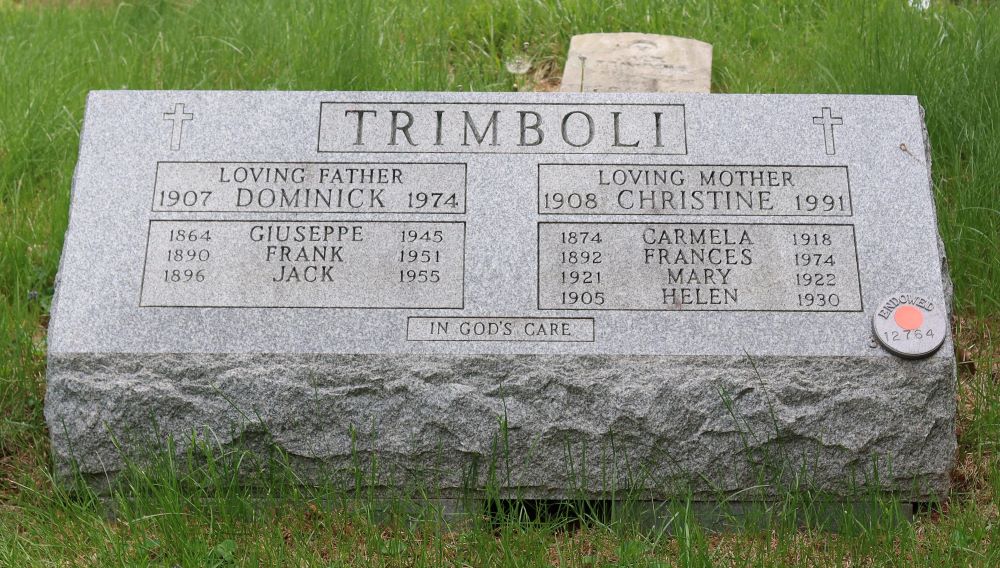
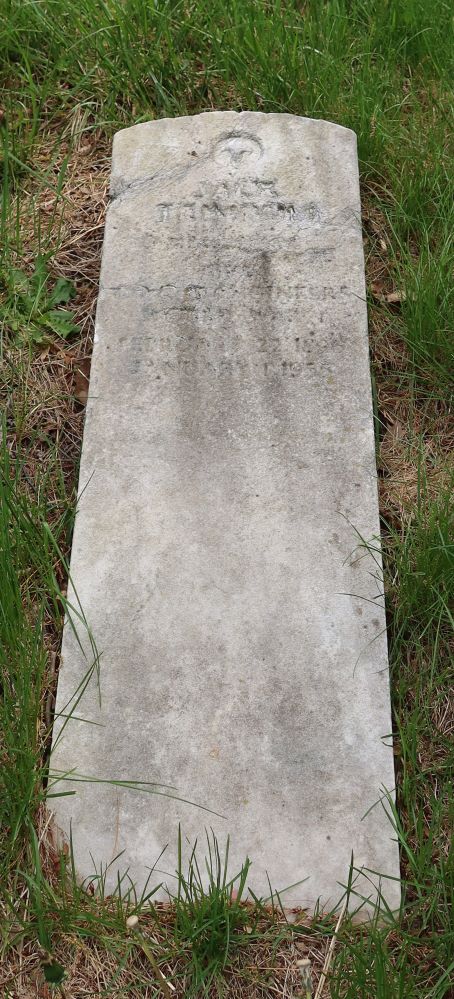
TUFT (or IRISH), ELIZABETH FREDA (1897-1932). Yeoman first class, United States Naval Reserve Force. A native of New York City, she is known on many records by her maiden name, Elizabeth Tuft. She joined the war effort by enlisting in the United States Navy Reserve Force on January 2, 1918, as a yeoman second class. She was assigned to the Provision and Clothing Depot at the New York Navy Yard. There were two provision and supply depots in New York: the larger one, located in Sunset Park, Brooklyn, along Third Avenue, was built in 1918 and closed in 1922; the smaller depot was located in New York City between 43rd and 44th Streets and First and Second Avenues. The depots were used to supply the Third Fleet which was stationed in New York. Tuft was promoted to yeoman first class on Armistice Day, November 11, 1918, and received her honorable discharge on November 6, 1920.
According to the 1920 census, Tuft returned home to live with her parents at 49 Parcell Street in Elmhurst, Queens, and worked as a secretary in the auto industry. She married in March 1929, and, as per the 1940 census, was a homemaker who lived at 4312 25th Avenue in Queens with her husband and their four children; that census indicates that she had completed the eighth grade. Although the family name on the 1940 census was listed as Tuft, her married name was Irish, according to Green-Wood’s records. She last lived on Walter Avenue in Hicksville, New York; she died at Nassau Hospital in Mineola, Long Island. Her death was attributed to cancer. On December 4, 1936, J. Albert Johnson, Chairman of the Graves Committee, Elmhurst Post #298 of the American Legion, applied to the War Department for a government-issued headstone, citing Tuft’s service in World War I. Section 75, lot 10099.
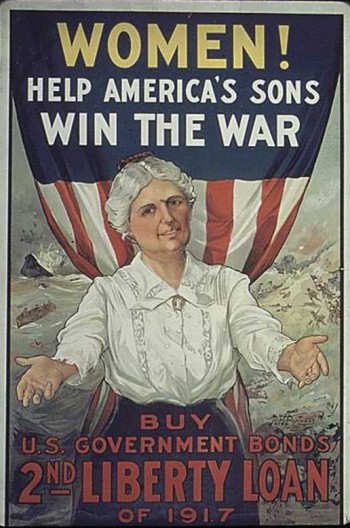
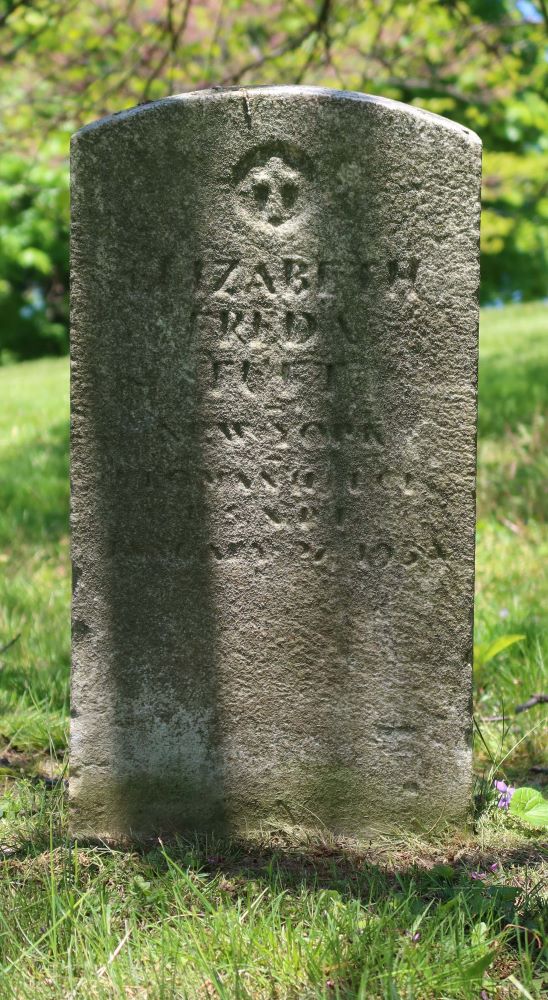
TYLER, JOHN COWPERTHWAITE. (1893-1918). First lieutenant, 166th Aero Squadron; 11th Aero Squadron, American Expeditionary Forces, United States Army Air Service. Tyler was born in Brooklyn. In 1911, while attending Brooklyn Polytechnic Preparatory School, he was a member of the school’s rifle team. He then entered Williams College in Williamstown, Massachusetts, where he was a member of the Psi Upsilon fraternity. On June 17, 1915, after his graduation from Williams College, he applied for a passport to travel on a pleasure trip to Canada for three months. Returning to school, Tyler earned a Bachelor of Science degree from the Department of Mechanical Engineering at the Massachusetts Institute of Technology in June 1917, carrying with it a degree from Harvard University. A month before his degree was granted, on May 25, 1917, he registered for the draft in Quincy, Massachusetts. As per his Draft Registration Card, he was working as a rivet tester at the Fore River Shipbuilding Corporation in Quincy and was described as tall, of medium build, with blue eyes and brown hair. Tyler indicated that he had served one month of military duty at Plattsburgh, New York (no further information). He listed his home address as 80 Pierrepont Street in Brooklyn.
On June 13, 1917, Tyler enlisted at Cambridge, Massachusetts, and trained at the Military Aero School at the Massachusetts Institute of Technology. After training, he was promoted to private first class on July 5 of that year. Tyler went overseas as one of ten honor students on August 25, 1917, received his pilot’s license in December 1917, and was commissioned lieutenant on January 24, 1918, serving with the 166th Aero Squadron. In July 1918, he was sent to the front as a member of the French Escadrille Br. 129 and went through two offensives with them, receiving a citation for the Croix de Guerre on July 15 – his first day over the enemy lines. On August 30, 1918, he transferred to the 11th Aero Squadron for the remainder of his service. According to one squadron head, “he was officially reported to be the best American bombing pilot on the western front.” Another comrade said, “He was one of the first three to be picked as deserving a command.” The squadron was part of the 1st Day Bombardment Group organized along with the 96th, 20th and 166th Aero Squadrons and attached to the St. Mihiel offensive under the leadership of General John Pershing. It was during this offensive that Tyler was killed in action on September 18, 1918. He last lived at 80 Pierrepont Street in Brooklyn. His mother, with whom he lived, was notified of his death. One friend later wrote to Tyler’s mother:
What actually happened as near as I can find was this. It was at the time of the St. Mihiel attack and German aviation was at the height of its last desperate effort to stop American bombardment. John’s squadron had been working incessantly in spite of furious attacks by overwhelming numbers of German planes – twenty or thirty in one formation. John was in a formation of six or eight planes coming back from bombing a railroad center when they were attacked by a swarm of enemy planes. The leader was shot down and among them John and his observer. That was all that the ones that did get back could report. Later a list was dropped by a German aviator containing the names of several that were in the group, giving the names of those killed, wounded and prisoners, but did not mention John, but mentioned his observer as killed.
His body, first reported as missing, was identified and was temporarily buried in a military cemetery in Lorraine, France. A memorial service was held at the Church of the Pilgrims on the corner of Remsen and Henry Streets. A scholarship was established at Williams College by his mother in Tyler’s memory to be awarded once a year in the amount of $600. After his remains were returned to the United States, Tyler was re-interred June 11, 1921. Section 141, lot 32718.

UPDIKE, FRANKLIN PETTIT (1898-1918). Private first class, 104th Machine Gun Battalion, Company A, American Expeditionary Forces, United States Army; private, 1st Cavalry, New York State National Guard, Troop C. Updike was born in Manhattan. The New York State census of 1915 listed the family, which included six children, as living in Brooklyn’s Assembly District 1. Updike enlisted in the New York State National Guard on May 14, 1917, and was assigned to Troop C, 1st Cavalry. He joined the 104th Machine Gun Battalion on October 17, 1917, and was subsequently promoted to private first class on December 25, 1917. On May 17, 1918, he went overseas with the 104th Machine Gun Battalion. He was killed from wounds suffered in action on August 15, 1918, while fighting in Belgium. His brother Edwin was notified of his death. His last residence was 48 Willow Street, Brooklyn. After his remains were returned to the United States, he was re-interred on April 10, 1921. A tombstone was provided by the U.S. government. Section 175, lot 27260.
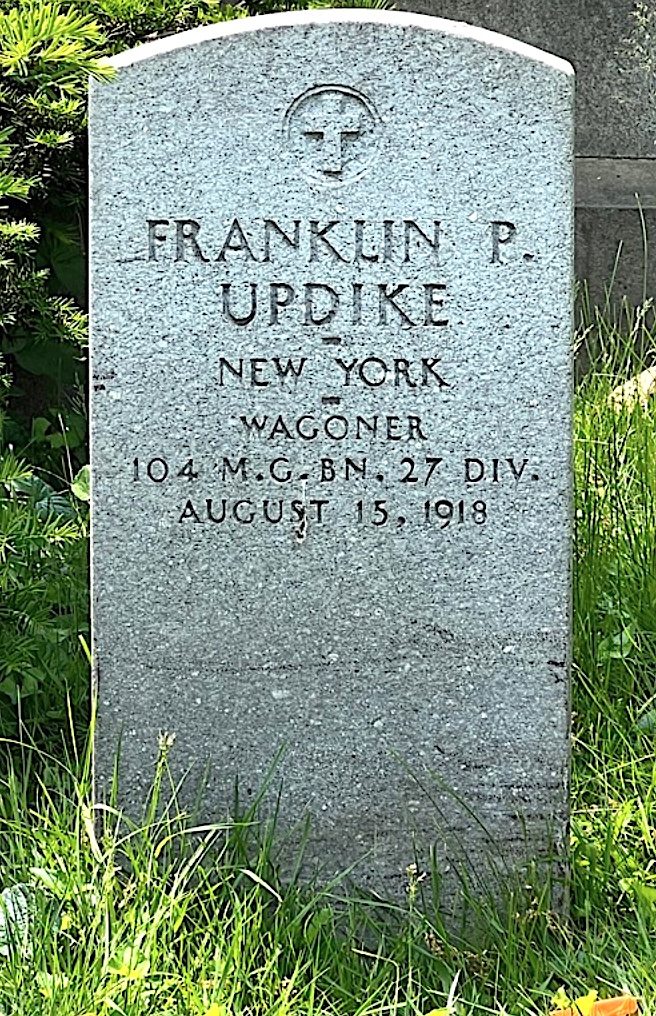
VAN RIPER (or VANRIPER, VANRIPES), EDWARD ADAM (1883-1968). Private, 20th Provisional Ordnance Deport Company, American Expeditionary Forces, United States Army. Van Riper was born in Arlington, New Jersey. The 1900 census reports that he lived with his parents and three siblings at 99 Clifton Place in Jersey City, attended school and could read and write. A marriage certificate was issued to Edward Vanripes and Mary Ramsey in Jersey City in 1908. The 1910 census shows that Van Riper and his wife and cousin lived in a rental in Jersey City. He was working as a tobacco salesman at that time.
As per his wife’s application for a veteran’s headstone, he enlisted in the United States Army on December 13, 1917. Van Riper is listed as a private in the 20th Provisional Ordnance Depot Company, departing from New York City on May 27, 1918, aboard the USS Cedric. He listed his spouse as Mary Van Riper and his address as 491 Communipaw Avenue in Jersey City. He was discharged on June 3, 1919.
At the time of the 1920 census, Van Riper lived at 20 Walthery Avenue in Ridgewood, New Jersey, with his wife Mary (Nellie), his parents, and an eight-year-old daughter, Fannie. Van Riper worked as a carpenter. The 1928 Ridgewood Directory also lists him as a carpenter. As per the 1930 census, he was married and lived at 642 East Glen Avenue in Ridgewood, New Jersey. He lived with his parents, wife Nellie, and two young children. That census notes that he was a World War veteran and had married for the first time at the age of 25. According to the 1940 census, Van Riper lived with his brother-in-law, wife and two children in Ridgewood, New Jersey. He had only worked four weeks in 1939, earning $25, had completed eighth grade, and worked odd jobs. His World War II Draft Registration Card, filed in 1942, notes he lived at 26 Walthery Avenue in Ridgewood, worked for Troy Hills, Inc., in Morris County, and had no home phone. His wife, Mary, was listed as his contact person. On February 28, 1868, two days after his death, Mary Van Riper of 121 Colona Street in Wycoff, New Jersey, applied for a flat granite marker with Latin cross, citing her husband’s service in World War I. Section 117, lot 4365.

VAN VALKENBURG, RALPH (1898–1918). Private, 2nd Field Artillery, New York State National Guard, Battery B, 27th Division, American Expeditionary Forces, United States Army. A Brooklynite, the 1910 census shows him to be living at home with his parents and his older sister. On April 4, 1917, Van Valkenburg enlisted as a private in the New York State National Guard and was assigned to Battery B, 2nd Field Artillery. On July 20, the New York State National Guard was federalized and became the 27th Division. Van Valkenburg shipped out to France on June 30, 1918, and died on September 27, 1918, of wounds he received in battle; he was buried with honors in France. His last residence was 34 Rutland Road in Brooklyn. After his remains were returned to the states, he was interred on July 17, 1921. Section 193, lot 26588, grave 3.

VECCHIONE, LEONARDO (or LEONARD) A. (1896-1918). Private, 152nd Depot Brigade, Company 33; 315th Infantry, Company D, American Expeditionary Forces, United States Army. Vecchione was born in Sarno in Salerno, Italy. As per the passenger manifest of the Spartan Prince, he departed from Naples, Italy, as a three-year-old and arrived in New York City on February 2, 1899. Apparently, he returned to Naples at some point and was listed as arriving by ship in New York City on June 24, 1913.
During World War I, he was inducted at Brooklyn on May 25, 1918, and first assigned as a private to the 33rd Company of the 152nd Depot Brigade until June 22, 1918, when he was assigned to Company D of the 315th Infantry. On July 9, 1918, he departed from Hoboken, New Jersey, for Europe on the America; at that time, he lived at 1736 70th Street in Brooklyn and listed his uncle, Elia Vecchione, as his next of kin. Vecchione died in France from tetanus on October 4, 1918. When his body was disinterred for return to the United States, his remains left Antwerp, Belgium, on April 26, 1921, aboard the Wheaton and arrived soon thereafter in Hoboken, New Jersey. He was interred at Green-Wood on June 9, 1921. Vault #15, catacomb 4.
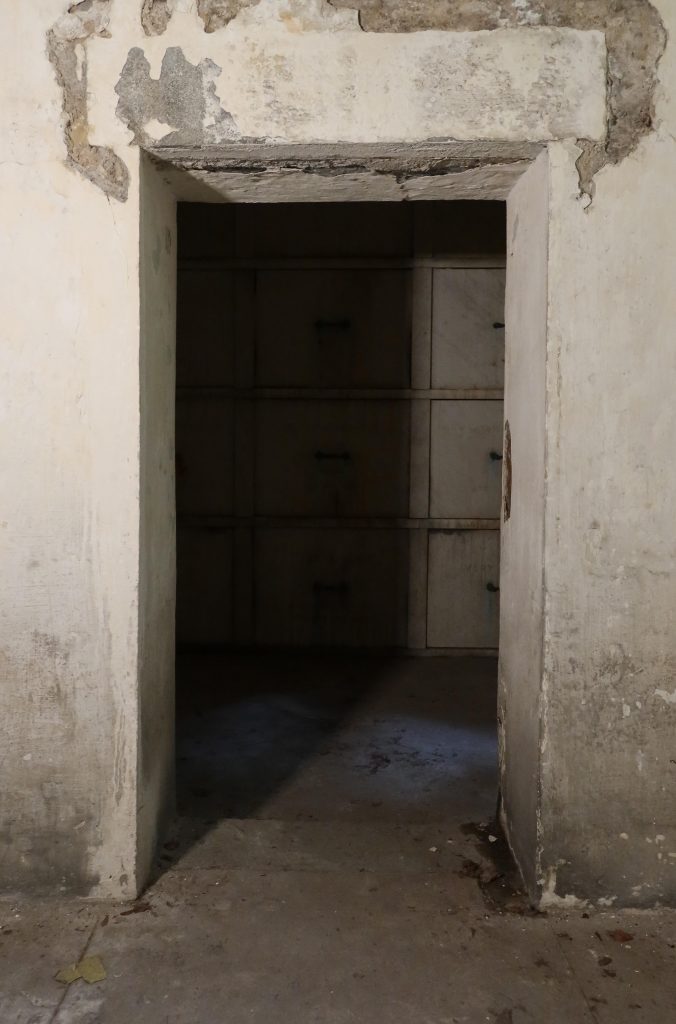
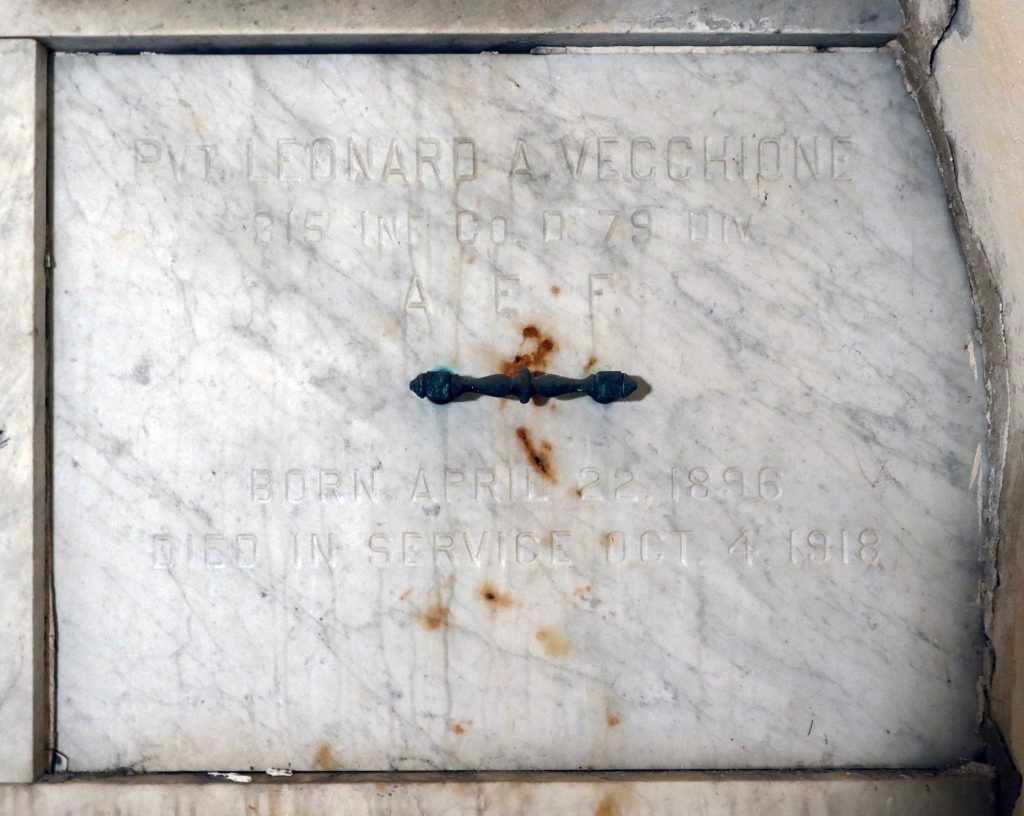
VINER, JOHN WINFIELD (1879-1918). Lieutenant, United States Naval Reserve. As per his online family history, he was born in Kings, Nova Scotia, Canada, in 1879 to Charles and Lavinia Garby Viner. His Military Abstracts incorrectly state that John was born in Worchester, Massachusetts in 1881. According to the Canadian census of 1881, John was a member of the Methodist Church of Canada and was living in Nova Scotia with his parents, paternal grandmother, and three-year-old sibling, Everette. At the time of the 1891 Canada census, John was living with his parents and five siblings in Kingsport in Kings, Nova Scotia; the family’s religion was Congregationalist and they were identified as not French-Canadian.
The online report notes that he lived in Boston, Massachusetts in October 1898, and returned to Nova Scotia that same month. His name appeared on the Boston Passenger and Crew Lists as arriving in Boston on the Yarmouth from Yarmouth, Nova Scotia, on October 9, 1898, and residing in Berkshire, Massachusetts. His online history relates that he lived in Boston during August 1902 and then resided in Brooklyn in 1910. Viner’s name was on the manifest of the ship Port Arthur arriving in Boston from Nova Scotia on August 31, 1902.
Soon thereafter, he moved to Brooklyn. On September 3, 1905, he married Margaret Howard at the Church of St. John the Evangelist at 250 21st Street in Brooklyn. The 1906 Brooklyn Directory identifies Viner as an engineer living at 52 15th Street. The 1910 census shows that Viner was living in Brooklyn with his wife, Margaret, and her father, brother, age 23, and sister, age 27. He was then working as an engineer at sea. The 1913 Directory for 1913 lists him as an engineer at the same 15th Street address. He is listed as being initiated into the Freemasons in Rutland, Massachusetts, on November 15, 1913, and being a marine engineer; although that document lists a birth in Nova Scotia, the birth year is listed as 1881.
As per his Abstract of World War I Military Service, Viner was appointed as a provisional lieutenant, j.g, (E) from New York on June 1, 1917. That same date is confirmed by the Select Military Registers of the Naval Auxiliary Reserve. On November 28, 1917, he applied for a Seaman’s Certificate of American Citizenship to the Collector of Customs for the Port of New York. That document, states that he was born on November 16, 1881 in Wooster (sic), Massachusetts, was an engineer, and had been employed for 18 years, most recently aboard the Antilla sailing from New York to Cuba. Intriguingly, the paragraph about being a naturalized citizen was crossed out. Viner’s physical description on the application for a Seaman’s Certificate shows that he was 5′ 7″ tall, 155 pounds, with brown eyes, black hair and a dark complexion. He reported that he had a tattoo of clasped hands of a sailor’s bust on his right arm, the initials JV on his right arm, and a tattoo of a tombstone on his left arm. His home address was listed as 52 15th Street in Brooklyn.
His World War I Abstract indicates that as of June 15, 1918, he was promoted to provisional lieutenant (E) and was commissioned aboard the Antilla. He died on November 4, 1918 at Base Hospital #34 in Nantes, France. The Naval report of his death lists the cause of his death as double lobar pneumonia and the branch of service as the Naval Reserves. His wife, Margaret Viner, his next of kin, was named on the document at the home address of 52 15th Street in Brooklyn. He was originally buried on November 5, 1918 at American Cemetery #88 in France.
An article in the New York Tribune on August 20, 1920 reports that Viner was among five New Yorkers among the seventy-five sailors and marines who were brought back to the United States to New York Harbor onboard the Hancock, an Army transport ship that towed four German enemy ships with the help of Navy tug boats, into the 35th Street pier; the German ships, which bore American flags and were to be destroyed within a year of their arrival. He was interred at Green-Wood on August 20, 1920. Section 64. lot 4071.
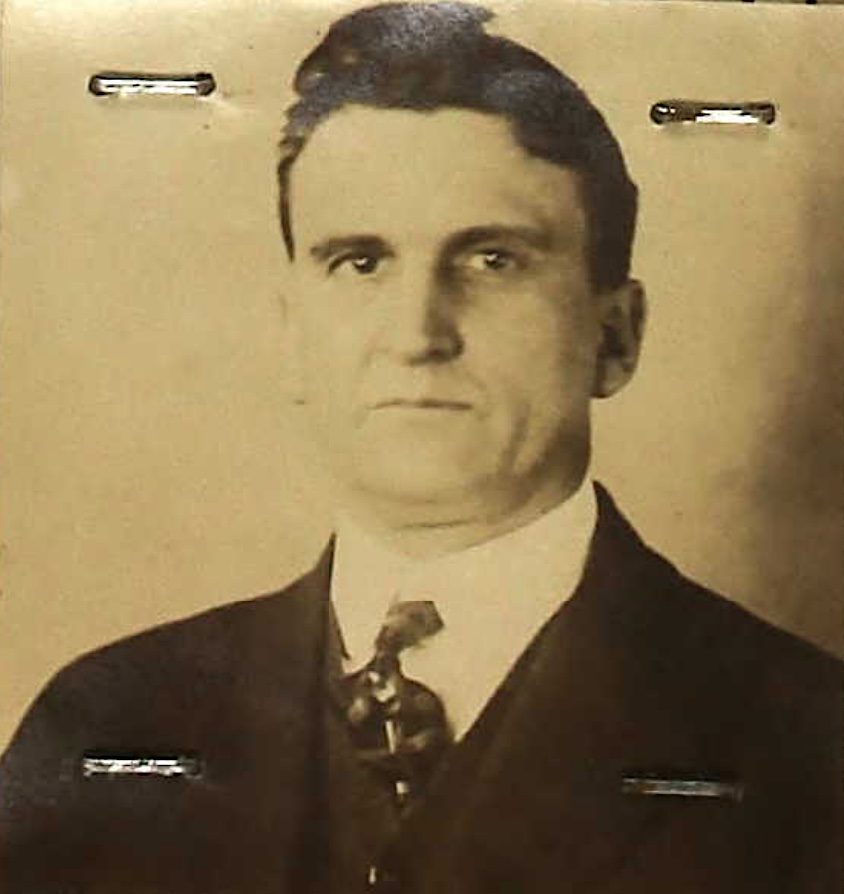
WAGSTAFF, ARNOLD ALOYSIUS (1898-1949). Quartermaster third class, United States Navy. As per his Navy records, Wagstaff enlisted as an apprentice seaman at Brooklyn on November 2, 1914; at that time, he lived at 176 Prospect Street. He was assigned to the USS Brooklyn from April 6, 1917, through August 22, 1918, when he was re-assigned to California. He was at the receiving ship in San Francisco from August 22, 1918, until October 4 of that year as a third class quartermaster, Aviation. He then was sent to the receiving ship at Mare Island, California until November 1, 1918. Wagstaff was honorably discharged from the receiving ship at New York City on February 26, 1919.
The 1924 New York Voter List indicates that Wagstaff lived at 174 Veronica Place in Brooklyn. As per the 1925 census, he lived in Brooklyn with his mother and sibling; his mother was separated from her husband who, in 1921, had identified a legless body as that of his wife, an incident that Wagstaff’s mother considered spiteful. The 1930 census indicates that Wagstaff lived with his wife, Edith, and three young children at 2127 Kimball Street in Brooklyn, a home that he owned which was valued at $7,500. At that time, he had a radio set, was listed as a World War veteran and worked as a New York City policeman. The 1940 census reports that he was married with six children, lived in a rental at 1267 Bergen Street in Brooklyn for at least five years, worked as a patrolman, had completed two years of high school, and had earned $2,500 in 1939. As per his obituary in the Brooklyn Daily Eagle; which confirms his World War I service in the Navy, Wagstaff had retired as a patrolman in 1944 and had moved to Fultonville, New York. At the time of his retirement, he was with the 94th Precinct in Greenpoint having previously been with the Brooklyn Avenue Station.
Wagstaff was a member of the Patrolmen’s Benevolent Association and the St. George Society, an English fraternal organization. His funeral took place at the James C. Nugent Funeral Home at Avenue D and East 28th Street in Brooklyn; a police chaplain officiated at the committal rites, the final “good-bye,” at Green-Wood. Wagstaff was survived by eight children and his widow. On February 22, 1949, about a month after his death, Edith Wagstaff, his widow, applied for a government-issued headstone with Christian emblem, citing her husband’s service in the United States Navy. Section B, lot 8575.
WARNKE, HAROLD C. (1897-1936). Private, Medical Department, United States Army. A Brooklyn native, the 1910 census reports that Warnke lived there with his parents and sibling and attended school. A resident of 4713 Third Avenue in Brooklyn, he enlisted as a private on May 5, 1918, at Fort Slocum, New York. According to the application for his government-issued headstone, Warnke was assigned to the Medical Department at Fort Totten, New York; his soldier record indicates that he was associated with the Coast Defense of Eastern New York and did not serve overseas. He was honorably discharged on May 28, 1919.
According to the 1920 census, Warnke lived with his brother-in-law on Third Avenue in Brooklyn and worked as a laborer in the longshoreman industry. The 1930 census states that he was single, lived at 716 58th Street in Brooklyn with his brother-in-law, worked as a clerk at Bush Terminal, and was a World War veteran. He last lived in Altamont, New York. On July 12, 1936, Edward Warnke of 5619 Fifth Avenue in Brooklyn, applied for a government-issued headstone with Christian emblem, citing Harold Warnke’s service in the World War. Section 16, lot 14888, grave 830.
WASSON (or WESSON), SAM (1898-1924). Private first class, 106th Infantry, Machine Gun Company, American Expeditionary Forces, United States Army; private, 14th Infantry, New York State National Guard, Machine Gun Company. A native of Moneymore in Derry County, Northern Ireland, he departed from Glasgow, Scotland, on the Furnessia on May 20, 1911, and arrived at Ellis Island on May 31, 1911. The 1915 New York State census reports that Wasson worked as an errand boy and was living in Brooklyn with his parents and siblings; that census also notes that he had been in the United States for ten years, information contradicted by data showing his arrival in New York City in 1911.
After enlisting at Brooklyn in the New York State National Guard on June 13, 1917, Wasson mustered into the Machine Gun Company of the 14th Infantry on October 17, 1917; that regiment was later designated as the 106th Infantry, Machine Gun Company, and was part of the 27th Division, American Expeditionary Forces. Wasson shipped out to Europe on the President Lincoln on May 10, 1918, leaving from Hoboken, New Jersey; he listed his residence as 381 12th Street in Brooklyn and listed Margret Wasson, his mother, as his next of kin. He was promoted to private first class on June 15, 1918. On February 26, 1919, he left Brest, France, onboard the Leviathan arriving in Hoboken, New Jersey, on March 6. He was honorably discharged on April 2, 1919; his soldier records indicate he suffered no injuries or disability during his service.
As per the 1920 census, Wasson was single, lived in Brooklyn with his parents and siblings, and worked as a laborer on the docks; that census indicates that he was not a naturalized citizen. On July 3, 1921, he married Sarah Wardell in Brooklyn. As per his death certificate, he was married and was a clerk in the men’s furnishings business. His obituary notes that he was survived by his widow, one son, and his parents. He last lived at 434A 13th Street Brooklyn. His death was attributed to broncho-pneumonia. On November 20, 1957, Sarah E. Wasson Liefert of Lakewood, New Jersey, applied for a granite marker with Christian emblem, citing Samuel Wasson’s service in the Machine Gun Company of the 106th Infantry. Section 186, lot 18777.

WATT, WILLIAM (1896-1977). Private, United States Army. Watt was born in Belfast, Ireland. He served in World War I as a private as per his headstone. No further details about his service are known. As per the census of 1940, he had been married four years, had completed eighth grade, worked 28 weeks in the preceding year as a machine operator earning $600, and lived at 35 North Oxford Street in Brooklyn. In 1942, his Draft Registration Card noted that he had no home telephone, was employed, and lived at the same address on North Oxford Street. Section 6, lot 39340, grave 529.
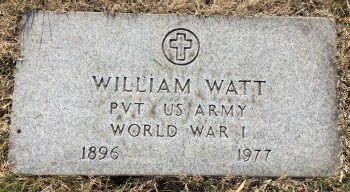
WATTS, JAMES WILLIAM (1890-1924). Boatswain’s mate, United States Navy. A native Brooklynite, Watts joined the Navy on October 6, 1915. He served as a painter first class at Naval bases in New York and Philadelphia from April 6, 1917-November 3, 1917. On November 3, he shipped out to the Naval Air Station in Dunkirk, France. Watts was assigned to the Naval Base Hospital #5 on November 21, and subsequently to Naval Aviation Forces in Paris from December 5, 1917 until April 8, 1918. His last residence was Vanderbilt Street in Brooklyn. Watts died from tuberculosis at the U.S. Naval Hospital in New York City. Section 130, lot 35565, grave 2.
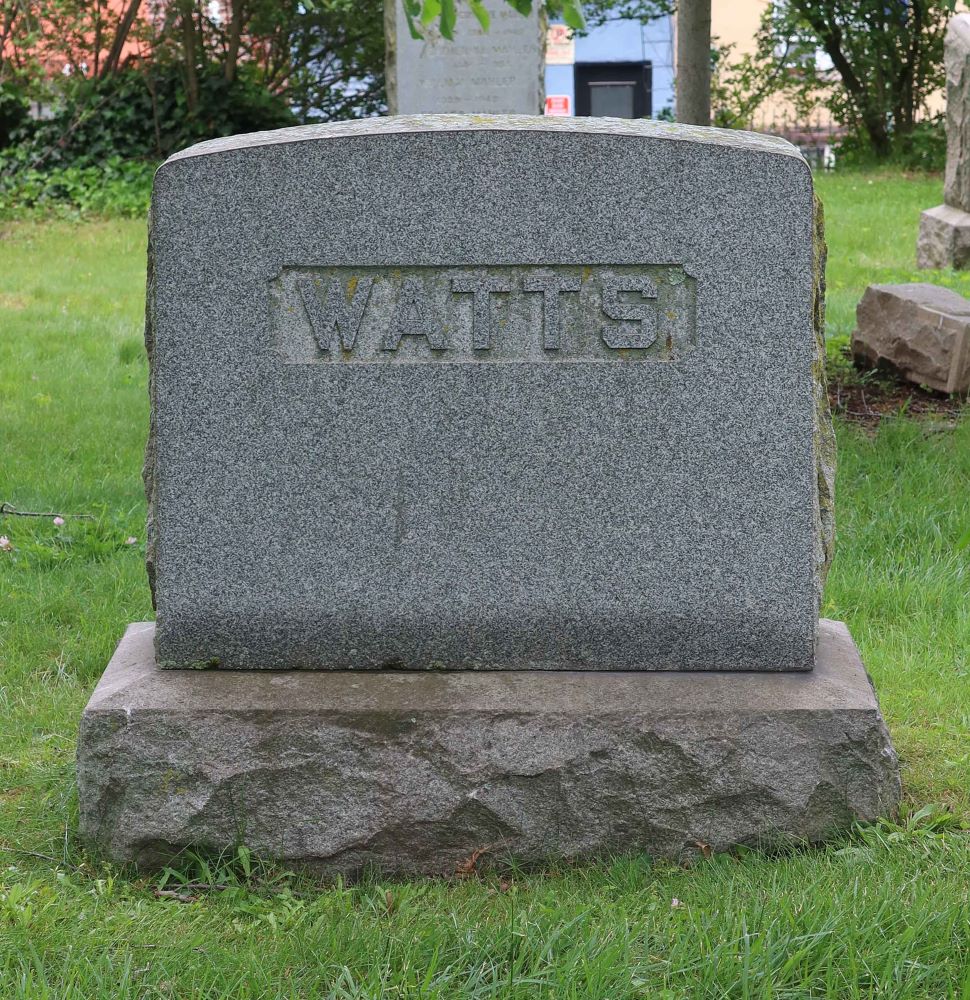
WEAVER, COURTNEY MAUJER (1879-1960). Private, 5th Regiment, 16th Company, Marine Corps. Courtney was born in Brooklyn to Albert and Harriet née Thomas Weaver. As per the School Catalog from Alpha Delta Phi, 1899, he was the secretary and treasurer of Adelphi Coffee Mills since 1898, and was a private in Troop C of the New York State Volunteer Cavalry in 1898. The address listed for him in that document is 134 Pearl Street in Manhattan. The 1900 census shows that he lived at 205 Jefferson Avenue in Brooklyn with his parents, was married to his first wife, Madeline J., and was a coffee merchant. Courtney and his wife were living with his mother in New Rochelle, New York, at the time of the 1905 New York State census. He was living on Center (also spelled as Centre) Avenue in New Rochelle at the time of the 1910 census which notes that he had been married for ten years, and was an independent stock broker; he is identified as “son” on that document but his wife is not listed as a household member. Two servants are living in the house that the family owns.
Ancestry’s family tree reports that he married his second wife, Maud Josephine Wright, on February 5, 1914, in Manhattan. Maud was born in New Brunswick, Canada. The couple had two sons, Albert Wright Weaver, born in 1915, and Courtney Jr., born in 1916.
As per the Marine Corps Muster Rolls, he enlisted as a private on February 14, 1917, and mustered into the 16th Company of the 5th Regiment in October of that year. There is no other information about his service during World War I. During World War I, Marine detachments served on battleships and cruisers in the European theater.
As per the 1920 census, he was still living with his widowed mother, wife and two young sons on Center Avenue in New Rochelle. At that time, Weaver was a broker with his own account. His name, misspelled as Gourtney, is listed in the 1921 alumni records of Wesleyan University. The New York State census of 1925 shows him, his wife, two sons and mother as living in New Rochelle. The 1925 New Rochelle Directory identifies him in the insurance business at 208 Centre Avenue. In 1930, the census reports that he was living in a house he owned in New Rochelle; that census identifies him as the head of the household; his mother is still living with the family. He continued to live with his wife in New Rochelle at the time of the censuses in 1935 and 1940. As per the 1940 census, the couple and their two adult sons rented a house at 60 Treno Street in New Rochelle; he had worked in all of 1939 and had completed four years of college; that census lists him as a tailor; the sons were in the restaurant business; Courtney and his wife managed their sons’ restaurant when they fought in World War II. He filed a World War II Draft Registration Card in 1942, indicating that he was self-employed, had a home telephone, lived at the Treno Street address, and named his wife as his next of kin. On that report, he was reported as 5′ 9″ tall, 170 pounds with blue eyes, gray hair and a light complexion. He noted that he wore glasses and had a mole on his left cheek. He died in New Rochelle, New York. Both of the Weaver sons fought in World War II; Courtney Jr. was killed in action. Section 184, lot 23544.
WEBB, WALTER J. (1892-1931). Fireman first class, United States Navy. Webb, a New York City native, was baptized there at age five on October 17, 1897. The 1910 census reports that he lived with his father and siblings on St. Ann’s Avenue in the Bronx and worked as a packer for a lithographer. As per his Abstract of World War I Military Service, Webb enlisted at the New York City Recruiting Station as a fireman third class on April 24, 1917, and was assigned to the USS New Jersey three days later as a fireman second class; he then lived at 633 St. Ann’s Avenue in the Bronx. At the time of the armistice on November 11, 1918, he was a fireman first class. The article about his death in the Brooklyn Daily Eagle, notes that he was a seaman aboard the USS Rhode Island during the World War.
As per his application for a Seaman’s Certificate of American Citizenship, filed on October 24, 1919, Webb was discharged as a fireman first class on a receiving ship in New York City on June 28, 1919. He had last served on the USS New Jersey which arrived in Boston on June 1, 1919, and was preparing to serve aboard an oiler. That document notes that Webb was 5′ 6¾” tall with blue eyes, brown hair and a ruddy complexion; he had a scar on the small finger of his left hand.
The 1920 census shows that Webb was single, still lived with his father on St. Ann’s Avenue and was a clerk for the railroad. On October 18, 1923, he married Ethel Astorita in Manhattan. At the time of the 1930 census, he had been married seven years, lived in a rental at 1140 Grant Avenue in the Bronx, owned a radio set, was a World War veteran and worked as a patrolman for the New York City Police Department.
Webb’s life ended tragically on August 21, 1931, when he was killed in the line of duty by a gagster’s bullet that pierced his badge in a street battle. Robertson was the first to die in the incident which ultimately saw six killed and twelve wounded. As per an article about the shooting in The New York Times, the 12 mile chase began after bandits attempted to escape with a payroll of $4,619 belonging to the Mendoza Fur and Dyeing Works at 712 East 133rd Street in the Bronx. Webb and the manager of the plant were carrying the payroll into the factory when Webb was shot as he reached into the manager’s car for his revolver; the bullet went through his heart. The bandits then seized the car and the money but later abandoned that car for a taxi, driven by an accomplice; a motorcycle cop who later fired at the speeding cab was killed by the thugs. Dozens of police were engaged in the battle in which hundreds of rounds were fired; ultimately, when the chase ended at Dykeman Street in the Bronx, two of the robbers killed, another fatally wounded and the stolen money recovered. A four-year-old girl, a bystander, was also killed; three patrolmen and other bystanders were among the twelve wounded. A biography of Webb by the Police Department, which confirms his World war service, indicates that he served with the force for ten years and was survived by his wife. Section 28, lot 9816.
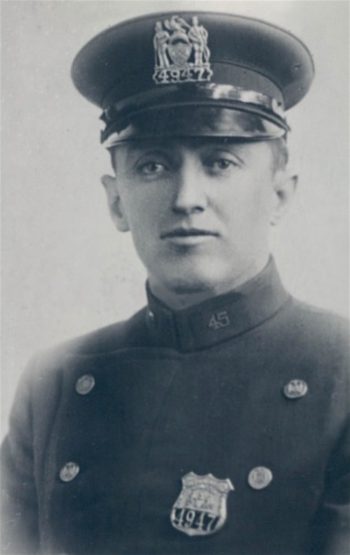
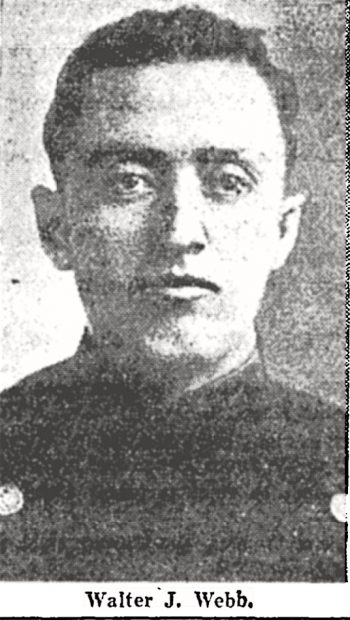
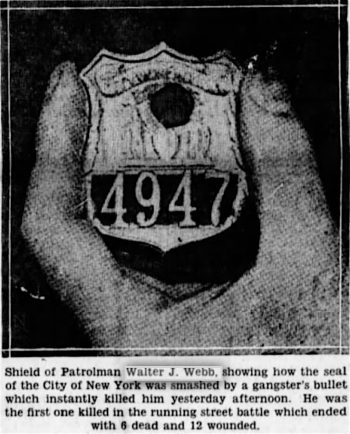
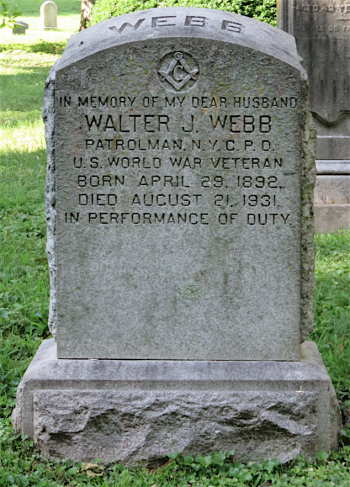
WENGENROTH, EDGAR ROY (1894-1953). Master signal electrician, 318th Field Signal Battalion, Company C, American Expeditionary Forces, United States Army. A native of Hoboken, New Jersey, Wegenroth enlisted as a private first class at New York City on July 18, 1917, and was assigned to the 318th Field Signal Battalion. He rose to corporal on December 1, 1917, and to master signal electrician on July 10, 1918, shortly before he was shipped overseas on July 18. Wegenroth’s duty overseas ended on March 22, 1919, and he was honorably discharged on March 31, 1919; he was not wounded during his service.
As per his World War II Draft Registration Card, filed in 1942, Wengenroth was working for Linde Air Products Company in Kittanning, Pennsylvania; his home address was 1372 River Road in Teaneck, New Jersey. His World War II paperwork indicates that he was 5′ 6″ tall, 190 pounds, with blue eyes, brown hair and a dark complexion. On October 6, 1953, Grace Wengenroth of 60 Pine Street in Bogota, New Jersey, applied for a government-issued headstone with Christian emblem for her husband, citing his World War I service. Section 199, lot 30999.
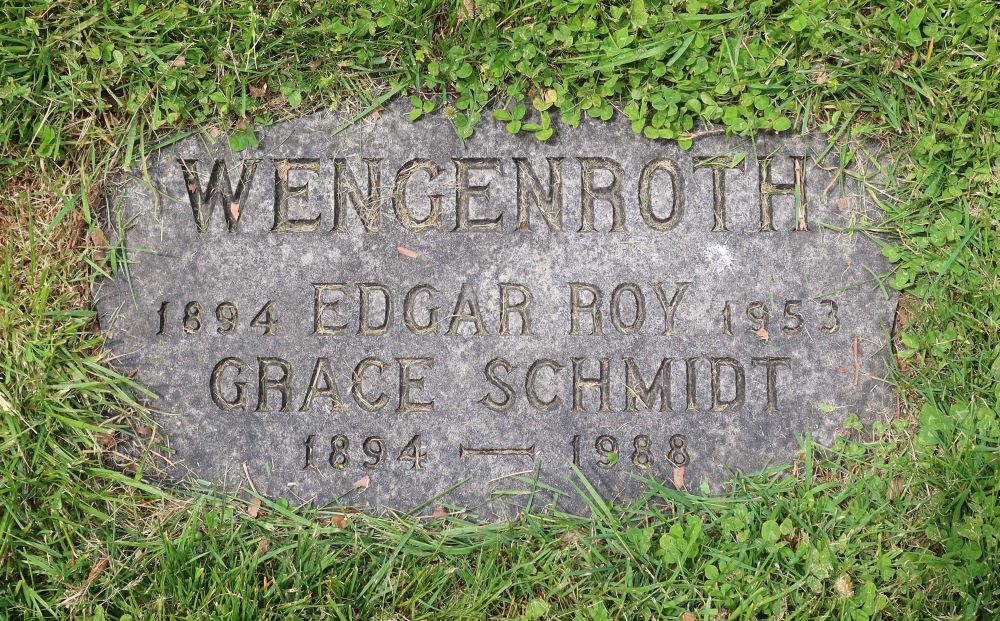
WHEELER, KARL HAROLD (1894-1918). Second lieutenant, 168th Infantry, Company M; sergeant, 106th Infantry, Company A, American Expeditionary Forces, United States Army; sergeant, 23rd Regiment, New York State National Guard, Company A. Wheeler was born and raised in Brooklyn. When he enlisted in the New York State National Guard on October 19, 1914 at the 23rd Regiment Armory, he was a salesman, described as 5′ 4 ½” tall with a light complexion, blue eyes and brown hair. During the Mexican Punitive Campaign, Wheeler mustered in on July 1, 1916, as a private, served as a cook with the regiment, and mustered out with his company as a private first class on January 17, 1917. He was promoted to corporal on May 10, 1917, and to sergeant on August 25 of the same year.
On May 10, 1918, Wheeler went overseas with the 106th Infantry, a unit that had its roots in the 23rd Regiment. On July 16, he accepted a commission as second lieutenant in Company M of the 168th Infantry. His unit saw action at St. Mihiel, a town in the Meuse Department of northeastern France. The battle was led by General John Pershing in an attempt to break through the German lines and capture the city of Metz. The breakthrough failed and Wheeler was killed in action on September 12, 1918, although the cemetery lists his date of death as September 20. His mother, who lived with him at 672 10th Street in Brooklyn, was notified of his death. After his remains were returned to the United States, he was re-interred on June 18, 1921. Section 142, lot 28442.
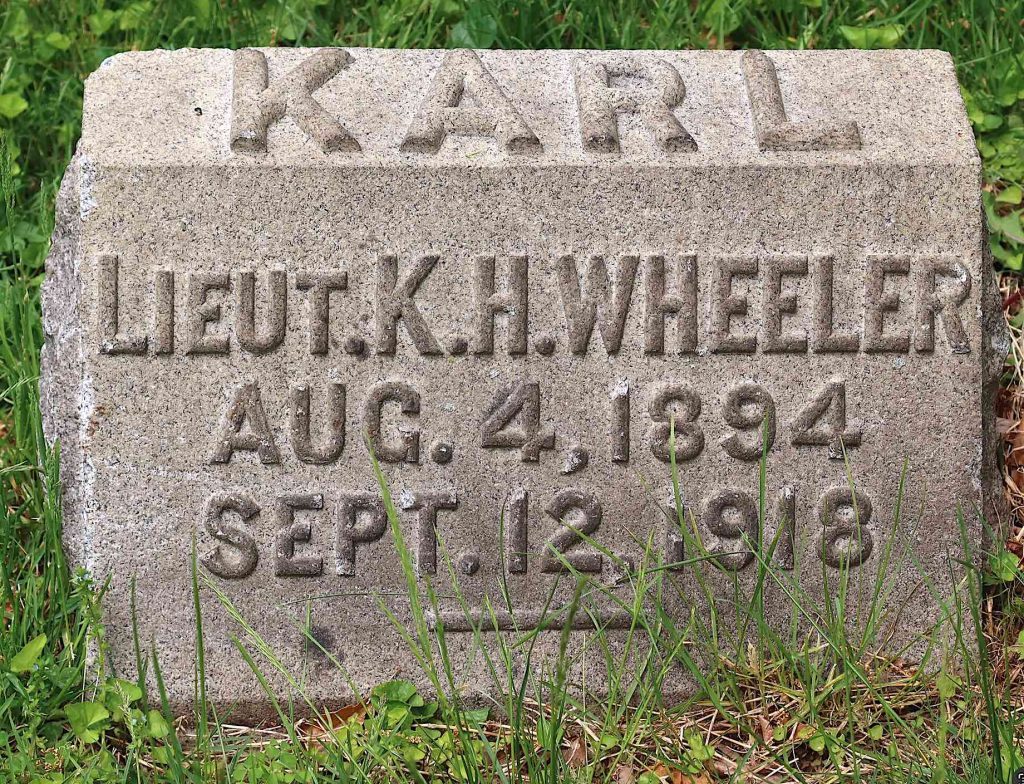
WHITMYER, ROBERT MAW (1894-1918). Seaman, United States Navy. A native of Manhattan, the 1910 census reported that the family lived in Manhattan’s 22nd Ward and included three boys: John, Jr., Robert and Franklin. Whitmyer received a passport, issued on April 4, 1917; he stated that the purpose of his trip was “banking business.” He arrived in London, England, on April 16 to work for the Guaranty Trust Company of New York. As per his New York State Military Abstract, he enlisted as a seaman at the Navy Recruiting Station of New York on July 8, 1918. Whitmyer was sent to the Naval Training Camp at Pelham Bay Park, New York on July 16. On October 4, 1918, he was admitted to the Naval Hospital there; he died of bronchial pneumonia on October 13. He last resided at 173 West 78th Street, Manhattan. Section 62, lot 3153.
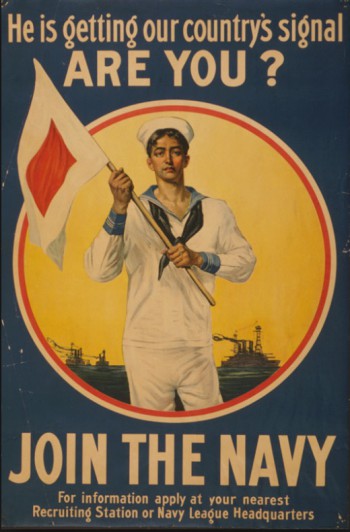
WICHUM, GEORGE HERMAN (1889-1953). Private first class, Base Hospital 37, Medical Department, American Expeditionary Forces, United States Army. A Manhattan native, the 1910 census reports that Wichum was living with his mother on Bleecker Street in Brooklyn, and worked as a cashier at a chandelier house. On August 22, 1917, he married Florence Baumgartner in Brooklyn. Wichum enlisted as a private at Brooklyn on January 29, 1918, and was assigned to Base Hospital 37 of the Medical Department, United States Army; at that time, he lived at 394 Bleecker Street in Brooklyn. He served overseas, detached to the Medical Department, as of May 19, 1918, traveling to Europe aboard the Lapland. He was promoted to private first class on November 9, 1918, and ended his overseas duty on March 30, 1919, when he arrived in New York after sailing on the Aquitania from Liverpool, England. On April 5, 1919, Wichum was honorably discharged; his soldier record indicates that he was not injured or disabled during his service. Shortly after his death, Florence Wichum of 1424A Liberty Avenue in Hillside, New Jersey, applied for a government-issued headstone with Christian emblem on January 13, 1953, citing her husband’s service in the Medical Department during World War I. Section L, lot 18212.
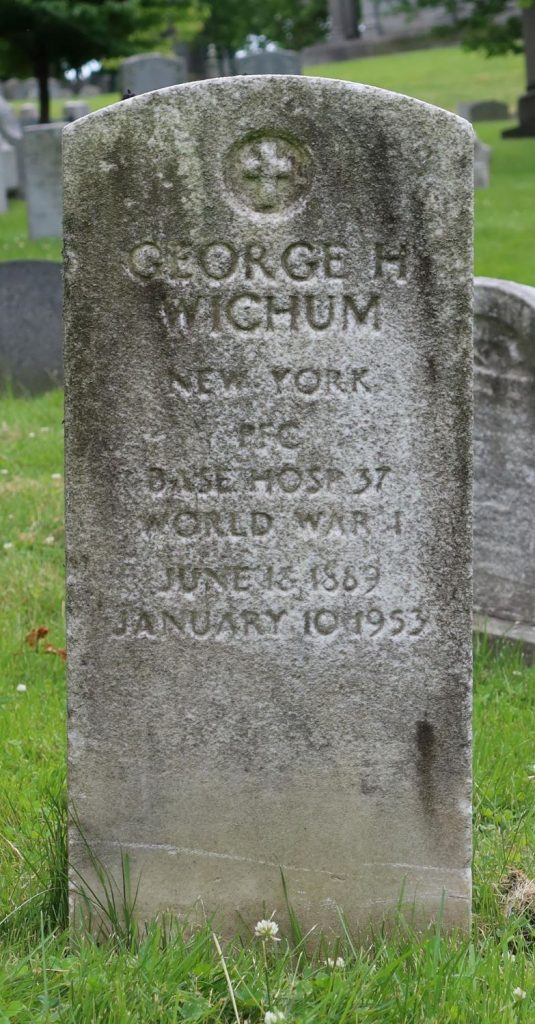
WIEPERT (or WILPETT), FRANK (or FRANCES) WILLIAM (1894-1937). Corporal, 104th Machine Gun Battalion, 27th Division, American Expeditionary Forces, United States Army; private, 1st Cavalry, New York State National Guard, Company C. A Brooklyn native, the 1915 New York State census reports that Wiepert lived there with his parents and sibling. He enlisted as a private in the New York State National Guard on May 24, 1917, was first assigned to the 1st Cavalry and was transferred to the 104th Machine Gun Battalion on October 17, 1917. On December 25, 1917, he was promoted to private first class. On May 17, 1918, Wiepert was shipped overseas on the Calamares from Newport News, Virginia, with Company A of the 104th Machine Gun Battalion; he listed his mother, Beatrice Wiepert, as his next of kin. The 104th was part of the 27th Division, American Expeditionary Forces. On September 15, 1918, he was promoted to corporal. On March 6, 1919, he left Brest, France, on the Seattle, to return to the United States, and was honorably discharged on April 3, 1919; his service records indicate that he was not wounded during his service.
At the time of the 1920 census, Wiepert lived with his mother and others at 290 Greene Avenue in Brooklyn; he was single and employed as a furrier. The 1925 New York State census indicates that he lived with his brother’s family in Queens, was unmarried, and worked as a furrier. He last lived in Hempstead, New York. On April 1, 1942, Howard O. Scarborough (relationship unknown), who lived at 2795 Bedford Avenue in Brooklyn, applied for a government-issued granite headstone, citing Wiepert’s service in the 104th Machine Gun Battalion. Section 191, lot 27833.

WILLIS, ROSS (1888-1934). Chief yeoman, United States Navy. Ross Willis was born in Plainfield, New , on April 29, 1888, to William H. Willis and Lucrecia Willis. According to the 1900 federal census, both parents had been born in New Jersey; the family was living at 71 Shark River Road in Neptune, New Jersey, when the census was recorded. Ross was in school and was able to read, write, and speak English. In addition to his parents, others in the household included Mary A. Willis, presumably William Willis’s mother, age 76, along with many younger Willises. These were Lilly C., 29; Grace, 26; Royall H., 24; Lucretia, 22; Charles G., 20; and William H. (see), 17; in addition to 12-year-old Ross.
By the 1910 federal census, Ross Willis was living in a rented house on 52nd Street in Brooklyn and was listed as head of the household. At 21 years of age, he had been married to Ella Marie Willis, 23, born Ella Marie Bruce, for two years and was a wage earner, working as a clerk in the spring water industry. His father’s birthplace was listed on this census as New York, rather than New Jersey. Delia F. Bruce, age 43, presumably Ella Willis’s mother, was also listed as part of the household. The Albany, New York, City Directory, 1916, also lists Ella M. Willis as Ross Willis’s spouse. On July 28, 1916, a border crossing record shows that Ross Willis, age 29, arrived in Niagara Falls, Canada, on July 28, 1916.
He enlisted in the United States Navy Reserve Force on June 4, 1917. His New York State Military Abstract notes that he lived in Manhattan at 875 West 185th Street when he was assigned as a yeoman first class to the Navy Yard at Boston, Massachusetts. Subsequently, Willis was assigned to the Receiving Barracks at New London, Connecticut, on March 31, 1918 until November 11, 1918, during which time he was promoted to chief yeoman. He was placed on inactive duty as a chief yeoman at New London on February 20, 1919, and was honorably discharged on June 3, 1921.
Ross died on April 15, 1934, and was interred in Green-Wood on April 21, 1934. On June 14, 1948, Ross’s brother William H. Willis applied for a United States government-issued headstone with a Christian marker. William H. Willis was also a World War I veteran, having served in the United States Army, and the two brothers are interred in the same lot. Ross’s wife, Ella Marie Willis, died in 1981, but she was not interred in Green-Wood. Section 22, lot 5428.
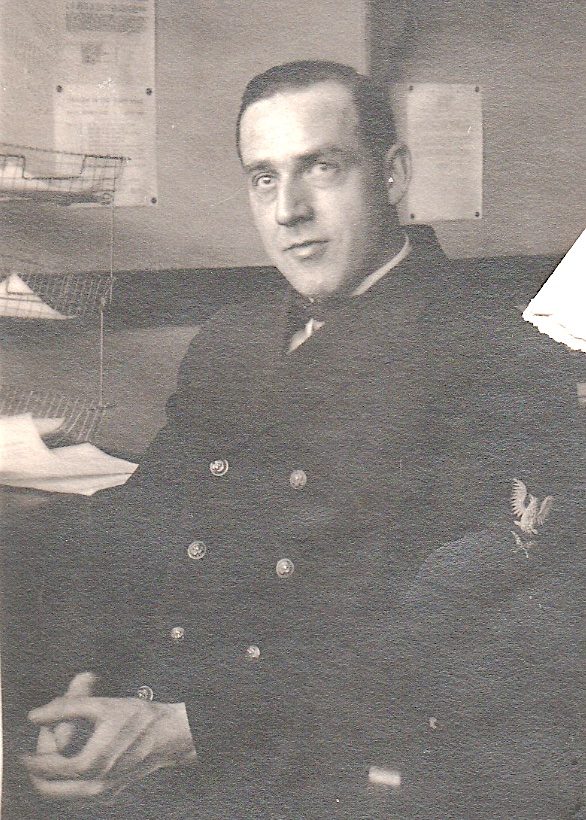
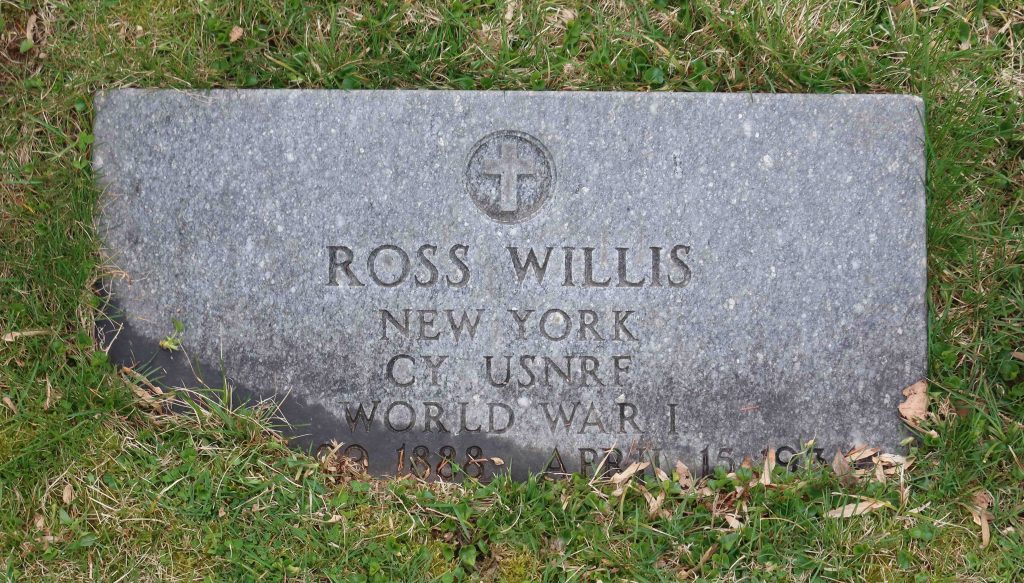
WILLIS, JR., WILLIAM HENRY (1882-1975). Sergeant, New York National Guard. Willis was a native of New Jersey. According to the 1900 federal census, William H. Willis was 17 years old. His parents, William Willis, age 55, and Lucrecia Willis, 50, were also born in New Jersey and the family lived at 71 Shark River Road in Neptune, New Jersey. William H. Willis was working as a clerk and was able to speak, read, and understand English. Others in the household included Mary A. Willis, presumably William Willis’s mother, age 76, along with many younger Willises. These were Lilly C., 29; Grace, 26; Royall H., 24; Lucretia, 22; Charles G., 20; and Ross (see), 12; in addition to 17-year-old William Henry.
By the time of the 1910 federal census, William was living on St. John’s Place in Brooklyn. He was unmarried, a wage earner, employed as a searcher for a title company. English was his native language. Also living in the same household were his parents, William Willis, 65, and Lucrecia H. Willis, 61, as well as his brother Royal H. Willis, age 34. There was also a 21-year-old servant, whose name appears to be Mary A. Lonenbran.
With the entrance of the United States into the First World War in April 1917, the New York National Guard’s 104th Field Artillery battalion was mustered into federal service. Per an abstract of his World War I Military Service record, William H. Willis was born in Plainfield, New Jersey, and was living in Jersey City when he enlisted in the 104th Field Artillery, on May 29, 1917. He then served in the Gas Defense Service from May 1918 until his discharge and was promoted to private first class on August 20, 1918, to corporal on September 5, 1918, and to sergeant on November 1, 1918. There was no record of his having served overseas and he was not injured in action. William’s record of National Guard Service in World War I shows that he was honorably discharged on January 4, 1919.
By the time the 1920 federal census was recorded, William was 37 years old, head of household, and married to Eleanor Willis, 35. They lived on West 173rd Street in Manhattan. William worked as a cashier in the motion picture industry. Also living with the couple were William’s brother-in-law Erwan (?) L. Watson, and his sister-in-law Jennie Watson, both age 29. The 1930 federal census shows 47-year-old William married to Lillian M. Willis, age 45. (Eleanor Willis from the 1920 federal census and Lillian M. Willis are probably the same woman.) The couple lived in the Bronx, at 782 Pelham Parkway South, in a rented apartment. William worked as a floorman in a bank.
William’s World War II Draft Registration Card lists his full name as William Henry Willis and his date of birth as June 9, 1882. He was living at 354 Mosholu Parkway South, Bronx, New York, and his contact was Mrs. Lillian Willis, at the same address. His employer was Chemical Bank & Trust Company at 377 Madison Avenue, Manhattan, but he worked at 165 Broadway in Manhattan.
On June 23, 1948, William applied for a United States government veteran’s headstone to mark his brother Ross Willis’s to mark his grave in Green-Wood Cemetery. He was still living at 354 Mosholu Pkwy South, Bronx. Lillian Mary Willis, who was born on February 20, 1884, died on March 12, 1949, and was interred in Green-Wood. William was living alone at the same address on Mosholu Parkway South in the Bronx when the 1950 federal census was recorded. He was 67 years old and no longer working. According to the Find a Grave website, William was 93 years old when he died on February 1, 1975. William was interred in the same lot as his wife, Lillian, and his brother Ross. Section 22, lot 5428.
WOHLTMANN (or WOHLTMAN), HARRY PEREGO (1887-1939). Sergeant, Engineers Camp, Headquarters Detachment, United States Army. Born in New York, Wohltmann’s Draft Registration Card, filed in Bayonne, New Jersey, on June 15, 1917, notes that he had one year of prior service in Company I of an unspecified New Jersey regiment. At that time, he was an assistant purchasing agent for a Bayonne Insurance Company and lived at 89 West 30th Street in Bayonne. He described himself as single, tall, of slender build with brown eyes, black hair and partially bald. The Jersey City Directory for 1918 lists him as a clerk. According to the application for a government-issued headstone, he enlisted on July 5, 1918, and served as a sergeant in the Engineers Camp, Headquarters Detachment. He was discharged on January 30, 1919. There is a hand-written notation on the application form that Wohltmann also served in Company A of the 5th Engineers Regiment; no further details are given for that service.
As per the 1920 census, Wohltmann was single and lived with his parents at the same West 30th Street address in Bayonne, could read and write and worked as a clerk for a wire company. On August 24, 1939, a bank officer from the Hudson County National Bank of Jersey City, acting as executor of Wohltmann’s estate, filed an application for a government-issued headstone, citing the deceased’s military service. Section 142, lot 24824.
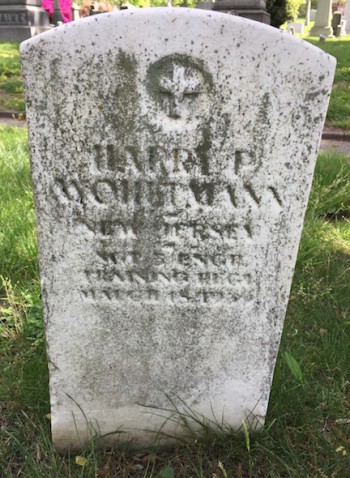
WOLF, ALFRED (1897–1918). Corporal, 310th Infantry, Company H, American Expeditionary Forces, United States Army; private, 153rd Depot Brigade, 1st Provisional Company. Born in Brooklyn, Wolf was inducted into the Army on April 1, 1918, and was posted to the 1st Provisional Company, 153rd Depot Brigade. Depot brigades were organized to filter recruits into permanent units. On April 16, he was assigned to Company H, 310th Infantry, achieved the rank of private first class on July 3, and was promoted to corporal on August 18. Subsequently, the 310th was attached to the 78th Infantry Division which consisted of the 309th, 310th, 311th and 312th Regiments and three artillery regiments – the 307th, 308th and 309th. On May 10, 1918, Wolf went overseas with his division and arrived in France on May 20. He fought in the Bois de la Montagne and the Champigneulles engagements, which were part of the bloody Meuse-Argonne offensive of September – November 1918 at St. Mihiel and Lorraine. Wolf died on October 19, 1918, of wounds he received in these campaigns. Margaret Wolf, his mother, who lived with him at 139 Coffey Street in Brooklyn, was notified of his death. His body was shipped back from France and re-interred on October 16, 1921. Section 130, lot 35241, grave N3.
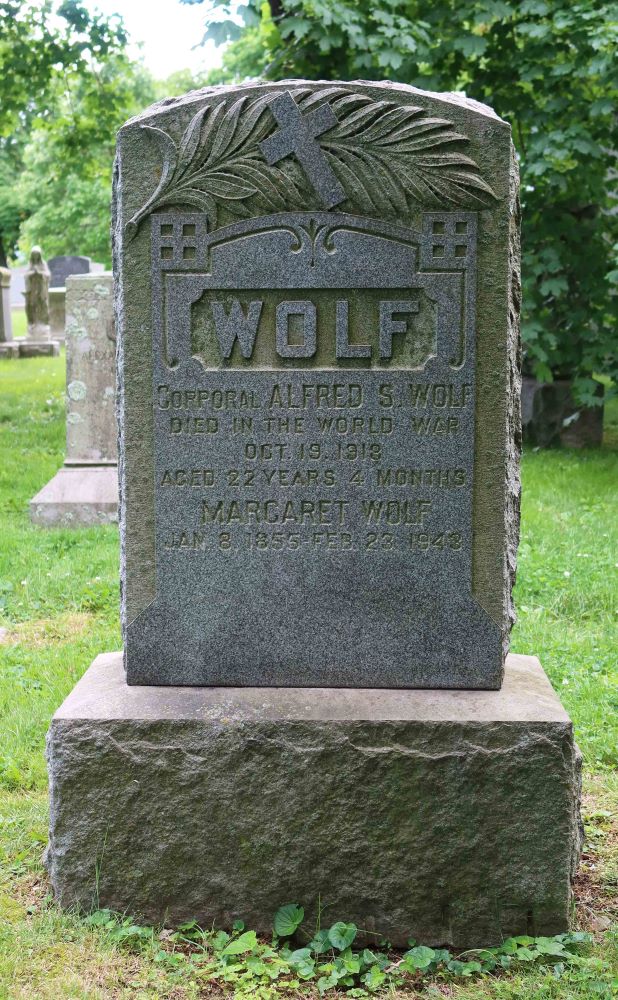
WOLFF, RAYMOND BROUGHTON (1896-1937). Private, 151st Depot Brigade, Company H, 2nd Development Battalion, United States Army. A Brooklyn native, Wolff was living at 23 Center Street in Saratoga Springs, New York, and was working as a bellman at the Adelphi Hotel when he registered for the draft on June 5, 1917. According to his Draft Registration Card, his race was listed as Negro and he was described as single, medium in height and build, with grey eyes and brown hair. He was inducted into the United States Army at Local Board 1 in Saratoga County, New York, on April 29, 1918. Wolff was sent to Camp Devens, Massachusetts, where he served in Company H of the 151st Depot Brigade, 2nd Development Battalion. Camp Devens was established in 1917 as the primary National Army training center for the Northeast Military Department. He served there for the duration of his tour of duty and was honorably discharged on December 18, 1918.
Wolff applied for a U.S. passport to work at a hotel in Havana, Cuba, sailing out of New York on board the Monterey on December 4, 1919. He last lived at 10 Center Street in Saratoga Springs but died at Summit, New York. The cause of his death was an abscess. Shortly after his death, Mrs. Marie L. Wolff of 1121 North Broadway in Yonkers, New York, applied for a government-issued headstone, citing Raymond Wolff’s World War service with the 151st Deport Brigade. Section 60, lot 1499.
WORTHEN, CHARLES BERTRAND (1889-1955). Second lieutenant, Signal Reserve Corps, Aviation Section. Worthen was born in New York. According to the 1910 census, he was single and lived on North 21st Street in East Orange, New Jersey, with his parents and sibling. Worthen’s name appears in the Polliwog, the 1912 yearbook of the Polytechnic Institute of Brooklyn, which he attended. On April 9, 1912, he was married in Westchester. His application for membership in the Sons of the American Revolution was accepted on August 10, 1916; he stated that he was the great-great-grandson of Samuel Worthen, who was born in Hempstead, New York, and then lived in Wears, New Hampshire. Samuel Worthen was a minuteman, soldier at Lexington, Massachusetts, in April 1775, a participant who marched across the Green Mountains during the invasion of Canada in July 1775, and a member of the Committee of Safety in Wears in 1776.
During World War I, Worthen enlisted as a second lieutenant on June 10, 1918, and was assigned to the Aviation Section of the Signal Reserve Corps. On April 8, 1919, he was honorably discharged. As per the 1920 census, he lived with his wife, Helen, and child at 33 Evergreen Avenue in Bloomfield, New Jersey, and worked as a purchasing agent for a manufacturing company. The 1940 census indicates that he was married to Adele and lived at 300 Montgomery Street in Bloomfield, New Jersey; that document states that Worthen was a college graduate and worked as an automotive engineer. On June 30, 1955, Adele B. Worthen, his widow who lived on Britten Road in Green Village, New Jersey, applied for a government-issued flat bronze marker with a Christian emblem, citing her husband’s service in World War I. Section 199, lot 31924.
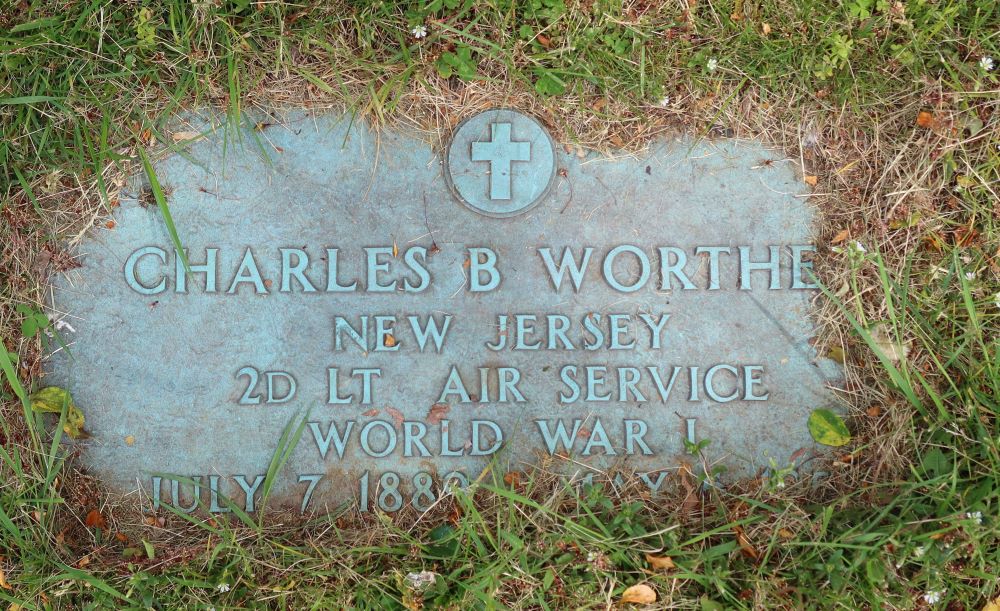
WORTHINGTON, LESLIE (1900-1918). Private, Australian Imperial Forces. As per Green-Wood archives, Worthington was born in Syria. He died at Pier 58, North River, in Manhattan on June 12, 1918, and was buried at Green-Wood eight days later. His death by drowning was reported in several newspapers, with slight variations. As per the New York Tribune on June 13, 40 men on an Australian transport ship that had carried 600 Australian soldiers into New York Harbor, then docked, got tired of waiting for orders to go ashore. Eager to get off the boat they had been on for weeks, and to see the sights of New York City, they jumped off the side of the ship. One, Leslie Worthington, fell into the water as he leapt for the dock, and drowned. An alarm was sent for the missing men later in the evening along with a report of the possible drowning. By midnight, 25 of the men had returned to the ship, including 10 who were lost and sought help from the police. The waters around the pier were dragged for Worthington’s body; it was recovered.
The Miami [Oklahoma] Daily-Record Herald noted that Worthington had the first ANZAC (Australia and New Zealand Army Corps) funeral in New York; photos of the funeral pictured the full military honors. The accompanying article detailed why the funeral attracted much attention. Worthington died while en route to service in France as a private in the Australian imperial forces. An orphan, Worthington, who was 18½ years-old, had a sister who lived in Victoria, Australia. When his ship arrived in New York Harbor on June 12, the men were in a rush to see New York City on shore leave. Sadly, Worthington fractured his skull and died in the river. An investigation determined that he might have slid off the gangplank. The British provost marshal handled all funeral costs, sparing no expense and tending to every detail. The six pallbearers were young officers in the British-Canadian Army, who had returned from the front and were in the United States instructing American recruits in military camps stateside.
As per the July 6, 1918 edition of the Sault Star, a newspaper from Sault Ste. Marie, Ontario, Canada, Private Worthington, of the Australian contingent, accidentally drowned and was given a military funeral in New York. He last lived in Australia. His name appears on an online list, Commonwealth War Graves, of the final resting places of British Commonwealth veterans. Section 14, lot 7677, grave 90.
WRIGHT, RAYMOND HARRISON (1889-1941). Private first class, 307th Infantry, Headquarters Company, American Expeditionary Forces, United States Army. Wright was born in Salisbury Mills, New York. The New York State census of 1915 notes that Wright was single and lived in Monroe, New York, with his siblings; he is identified as a “son” on that document but only his siblings are listed. According to his Draft Registration Card, filed in Orange County, New York, on June 5, 1917, he lived on Spring Street in Monroe, New York, and was a self-employed butcher. On that document, he described himself as of medium height and build with brown eyes and brown hair. On February 25, 1918, Wright was inducted as a private at Tuxedo Park, New York, and was assigned to the Headquarters Company of the 307th Infantry. Wright served overseas from April 6, 1918 until April 28, 1919. After returning to the United States, he was honorably discharged as a private first class on May 9, 1919; his soldier record states that he was not injured during his service.
As per the 1930 census, Wright had been married for three years, lived at 215 North Main Street in Monroe, New York, and owned a radio set; he was employed as a butcher and was listed as a veteran of the World War. He still lived with his wife in Monroe at the time of the 1940 census; he was a butcher and had completed eighth grade. He died in the Bronx. On February 3, 1942, Ethel Wright, his widow who lived at 340 Main Street in Monroe, New York, applied for a government-issued granite marker with a Christian emblem, citing her husband’s service in the World War. In 1948, his family removed the government-issued gravestone and replaced it with a gray granite marker. Section 132, lot 34366.
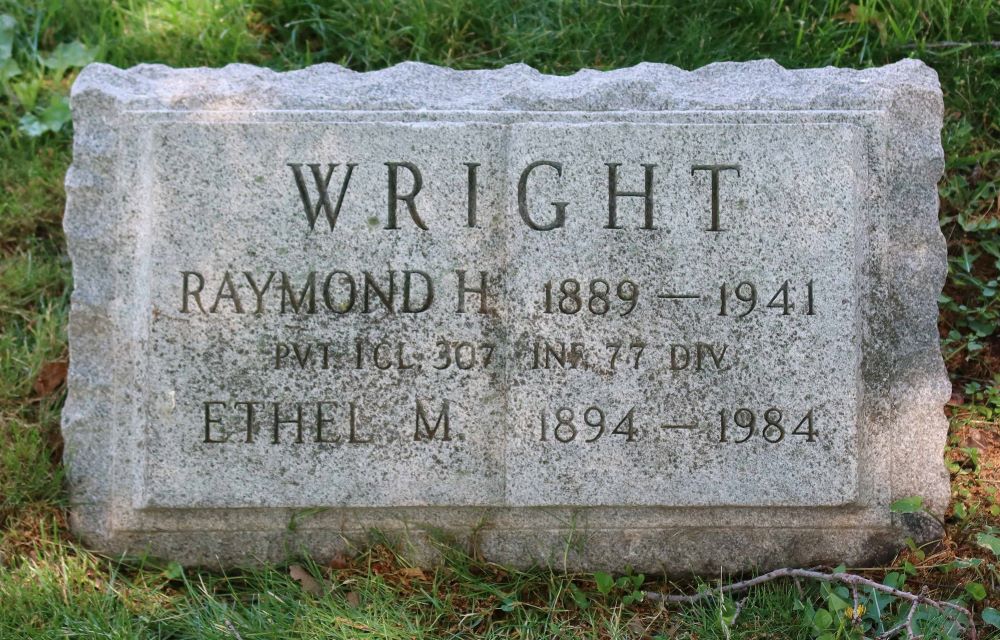
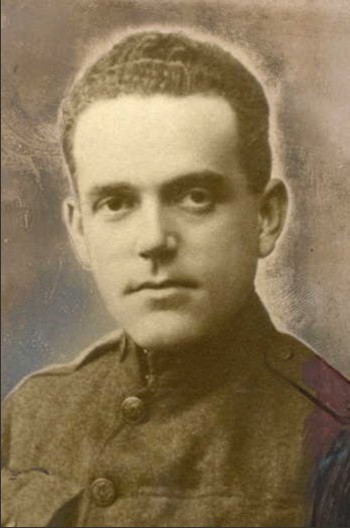
WUPPERMANN (or WUPPERMAN), CARLOS DOMASO SIEGERT (1887-1919). Sergeant, Consolidated Intelligence Program (C.I.P.), American Expeditionary Forces, United States Army; Base Hospital Service. A New York City native, his family’s wealth came from distributing Angostura bitters, a key ingredient in many cocktails. His mother, Josephine Wright Hancox, was a Mayflower descendant and his father was of Hispanic, Latino and German heritage. Carlos Wuppermann attended Trinity School from 1896 to 1903, then went on to Columbia University. He spent a year in Germany attending lectures in Leipzig before attaining a Bachelor of Arts in 1907. At Columbia, Wuppermann was a member of Phi Gamma Delta fraternity, Freshman Chess Team, Debating Society and the Peithologian Literary Society. A sportsman, he was subsequently a member of the Tower Ridge Yacht Club and the Hastings Tennis Team. He was an actor, poet and playwright by profession working under the name Carlyle Morgan. In physical appearance, he was described as 5′ 8″ tall with a straight Grecian nose, brown eyes, dark brown hair and “fair ruddy” complexion. After college, he authored The Deeper Faith, an essay collection, Quiet Places (1912), and the play, Laughing Harry (1917), that was given at the Actors Fund Benefits in Chicago and Boston.
On June 19, 1917, Wuppermann enlisted in Base Hospital #1, Bellevue Unit, for overseas service. In February 1918, he was assigned to hospital service in France where he was noticed for his accomplishments as a linguist who was fluent in four languages. The American Expeditionary Forces needed his talents and he was then attached to the Consolidated Intelligence Program (C.I.P.), an intelligence unit. First assigned to duties in Paris, St. Nazaire and Clermont in the French territory, he was ultimately assigned with the Army of Occupation in Trier, Germany. The circumstances of his death are marked by controversy. According to one abstract of his military service, he died in Trier of a self-inflicted gunshot wound on April 15, 1919. Because of the mysterious nature of his death, his mother sent private investigators to Germany and learned that he was shot by an intelligence service officer partner. Another abstract of military service states that Wuppermann died in the line of duty. An officer wrote of him:
“Carlos was likable, well educated, cultured and studious; his personality was preeminent in an organization largely composed of college men. We are proud that Sergeant Wupperman went to France as a member of our organization. We were proud of him when he accepted the call of greater service in the dangerous work of the Intelligence Department, and we were proud of him in his death.”
Coincidentally, his death occurred the same day as the death of Jane Delano, Director of Nursing for the American Red Cross who was on a mission in France to attend a conference of Red Cross workers and health experts, and who was later buried with military honors at Arlington National Cemetery. He last lived at 310 West 79th Street in Manhattan. A memorial service was held for Wuppermann at the Grace Church in Hastings-on-Hudson, New York. Wuppermann was buried at Green-Wood on October 13, 1920. He is buried in a family plot with among others, his two brothers, the actors Frank Morgan (born Francis Phillip Wuppermann), who played the title character in The Wizard of Oz and Ralph Morgan (born Raphael Kuhner Wuppermann), a co-founder of the Screen Actors Guild. Section 168, lot 14447.
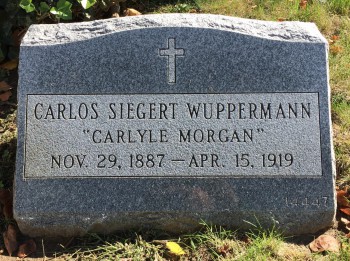

YAKEL (or YOKEL), HARRY L. (1895-1951). Quartermaster sergeant, senior grade, Quartermaster Corps, Ship Repair Shop Unit #301, United States Army. Yakel was born in Brooklyn. As per his World War I Draft Registration Card, filed on June 5, 1917, he lived with his widowed mother and claimed exemption from service because he was supporting her. Yakel also noted that he was an architectural draftsman at Koch & Wagner at 26 Court Street in Brooklyn. At that time, he described himself as single, with blue eyes, dark brown hair, of medium height, slender build and no disabilities. He was inducted as a private at Local Board #37 at Brooklyn on April 10, 1918, and was assigned to the Quartermaster Corps. On May 7, 1918, he was detached to the Ship Repair Unit #301, where he remained throughout his service. Yakel was promoted to sergeant on June 17, 1918, and to quartermaster sergeant on November 9, 1918. Upon demobilization of his unit, he was discharged on January 9, 1919, with the rank of quartermaster sergeant, senior grade; he did not serve overseas or suffer any injuries while in service.
As per the 1920 census, Yakel lived with his mother at 210 18th Street in Brooklyn; he worked as a draftsman in the art industry. On June 20, 1921, he was married in Brooklyn. The 1925 New York State census indicates that he was living in Brooklyn with his wife and worked as an architect. At the time of the 1930 census, he lived with his wife and infant son at 1754 Albany Avenue in Brooklyn, a house that he owned and was valued at $9,000; he was still employed as an architect. The 1940 census reports that he lived with his wife and son at the same house, now valued at $7,000, and was a high school graduate; he had earned $2,500 as an architect in 1939. According to his World War II Draft Registration Card, filed in 1942, he still lived with his wife on Albany Avenue, had a home telephone, and was still working for Koch & Wagner, now at 32 Court Street in Brooklyn.
On June 16, 1951, Yakel ended his life after slashing his wrists and jumping out the 9th floor window of his office at 32 Court Street in Brooklyn. The Brooklyn Daily Eagle reported that he left no note but was despondent over the dissolution of Koch & Wagner, the architectural firm that employed him. That article noted that Yakel, at one time, had been vice president of the Brooklyn chapter of the American Institute of Architects. On September 8, 1951, Gertrude Yakel, his widow, applied for a government-issued granite marker with Christian emblem, citing her husband’s service in the Quartermaster Corps. Section 131, lot 35147.
ZARICK, EDWARD (1896-1959). Cook, 330th Infantry, Company F, 83rd Division, American Expeditionary Forces, United States Army. Zarick’s birthplace is listed as the Syrian Arab Republic (Syria) on the 1930 and 1940 censuses; however, the Green-Wood database lists his birthplace as Turkey. Zarick enlisted in the United States Army and served as a cook in Company F of the 330th Infantry, 83rd Division. The 83rd Division, activated in September 1917, was a depot division that supplied about 195,000 replacement troops for service in France. The Adjutant General Military Record for Zarick shows that he served overseas in the American Expeditionary Forces from February 1918 until March 1919. He received his honorary discharge on April 11, 1919.
The 1930 census lists Zarick as living in Brooklyn at 4803 Sixth Avenue where he paid $65 per month in rent; he was married with five children, and worked as a salesman. That census also indicates that he owned a radio set, was a naturalized citizen and a veteran of the World War. As per the census of 1940, Zarick lived at 602 44th Street in Brooklyn where the rent was $47 per month, and that he had completed 8th grade and was a salesman who had worked only 16 weeks in 1939 earning $25. His World War II Draft Registration Card of 1942, which cites a birthplace of Syria, notes that Zarick was employed at a negligee company on Fourth Avenue in Brooklyn. He last lived at 431 85th Street in Brooklyn. On June 13, 1960, Katy Zarick, his widow, applied for a government-issued headstone with a Christian emblem for her husband, citing his service as a cook in the 330th Infantry. Section 39, lot 38325, grave 709.
